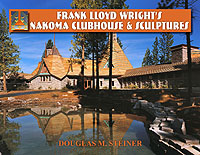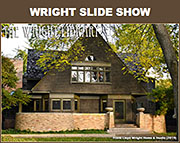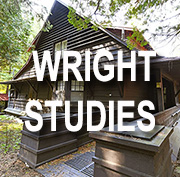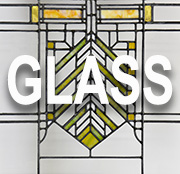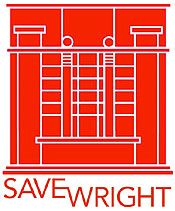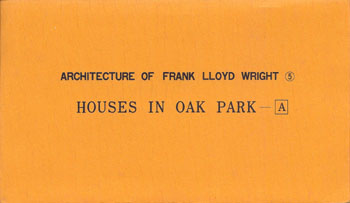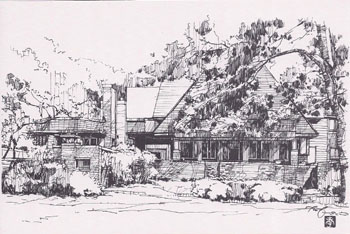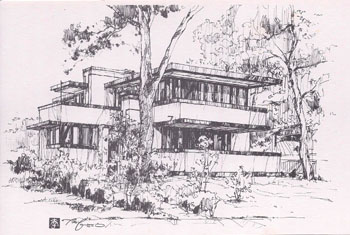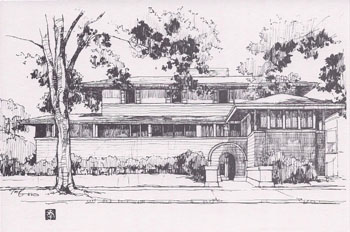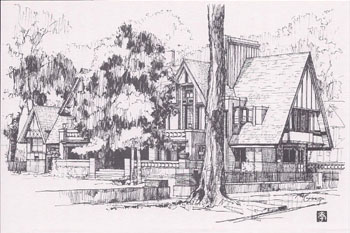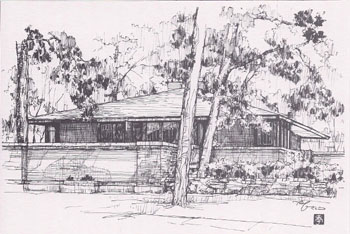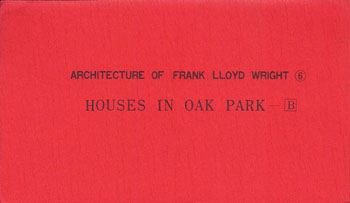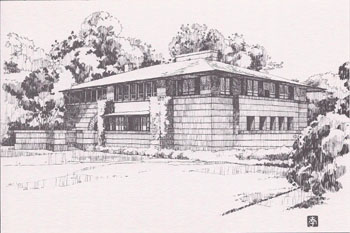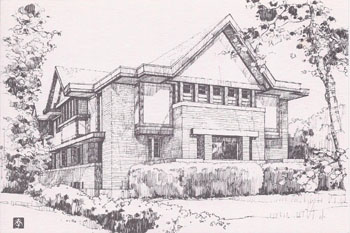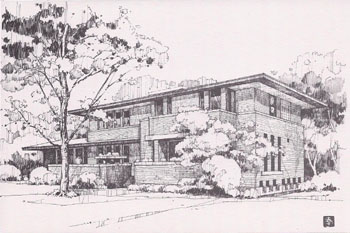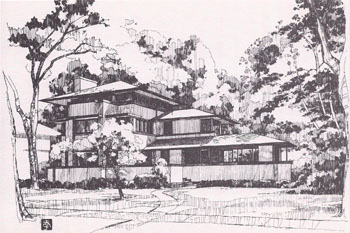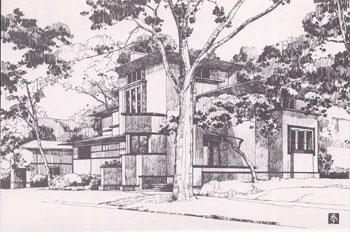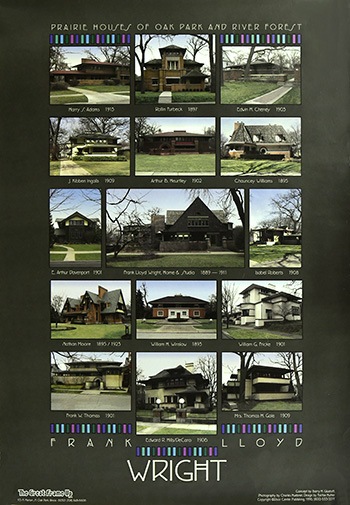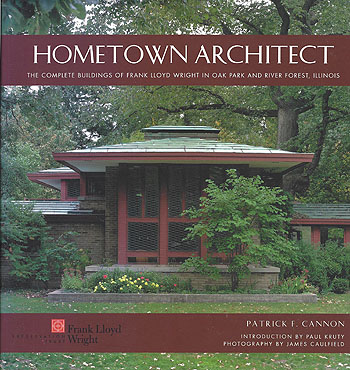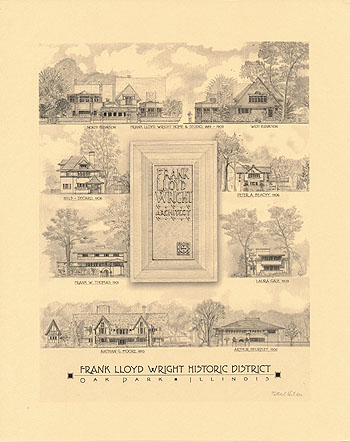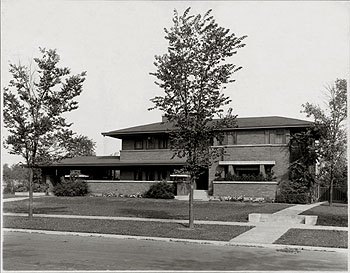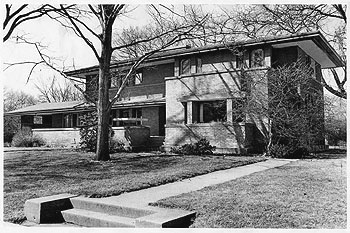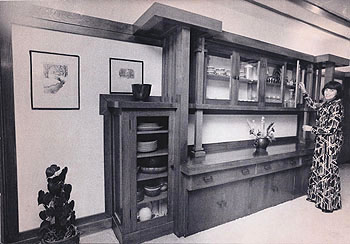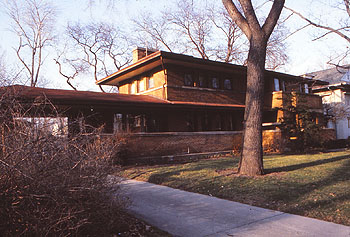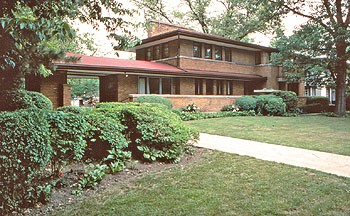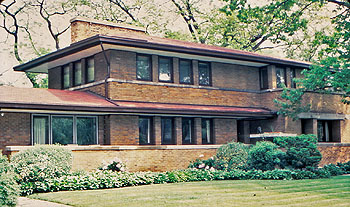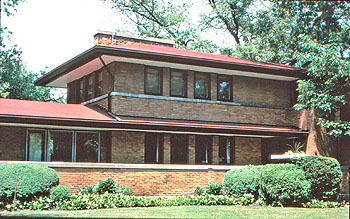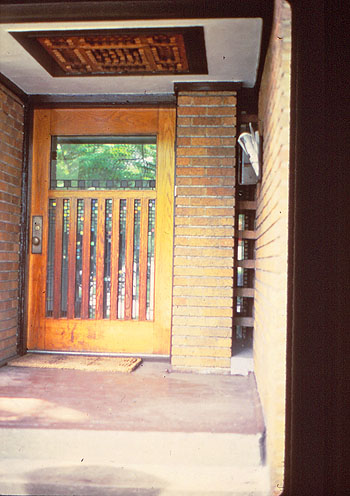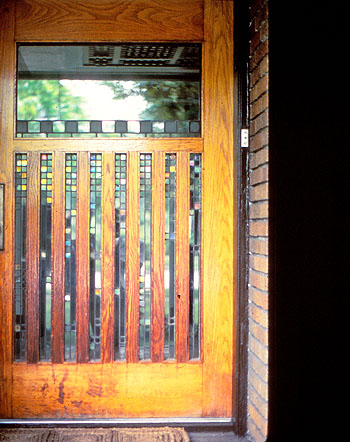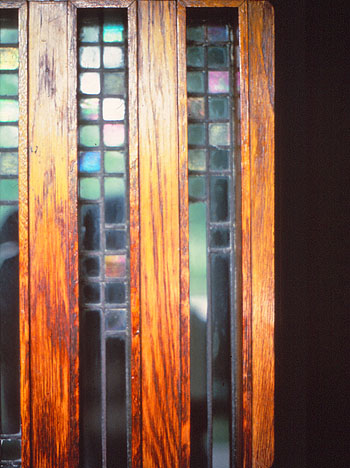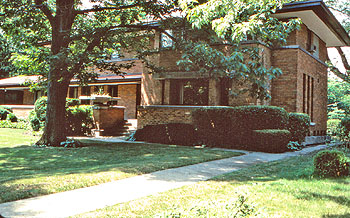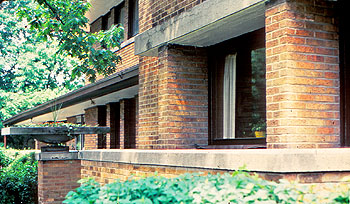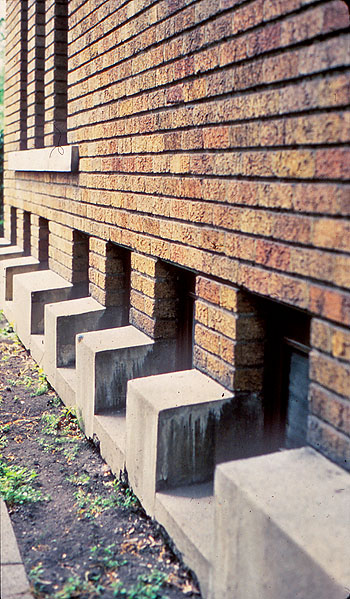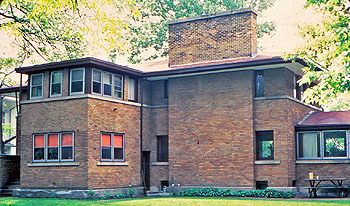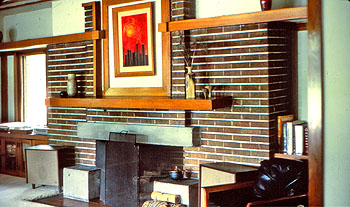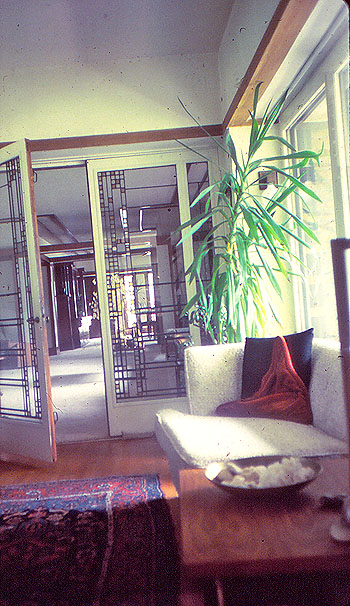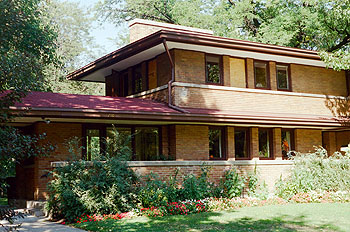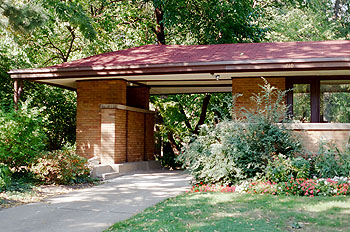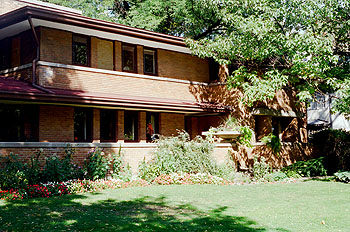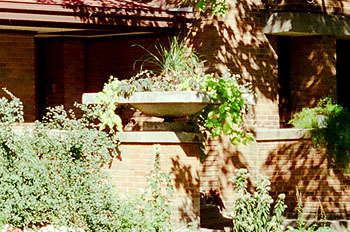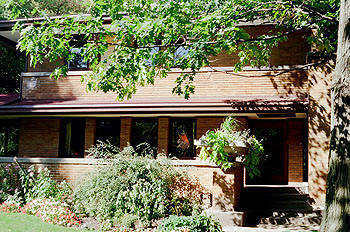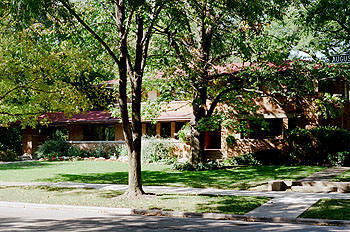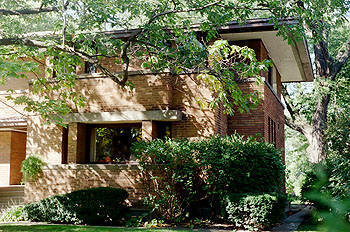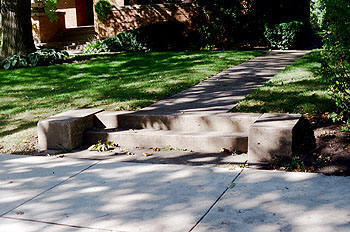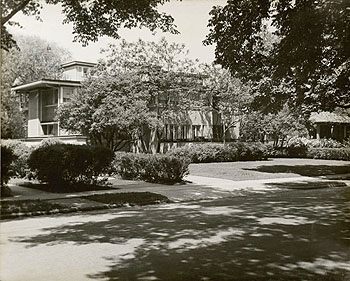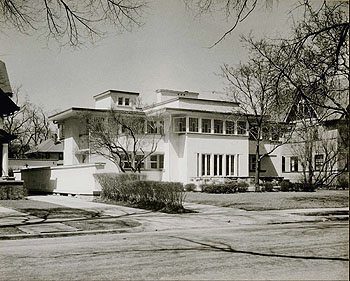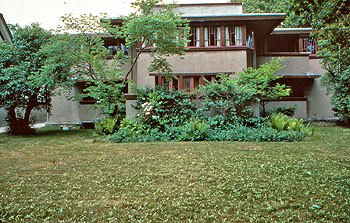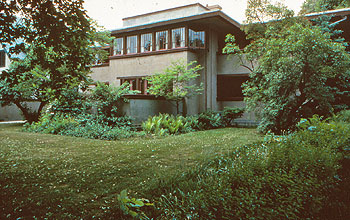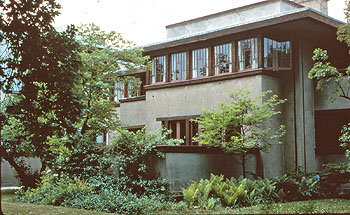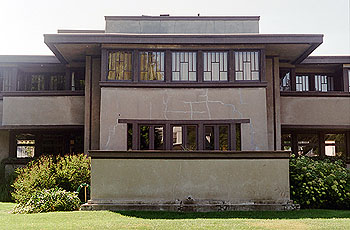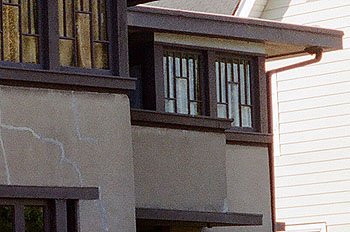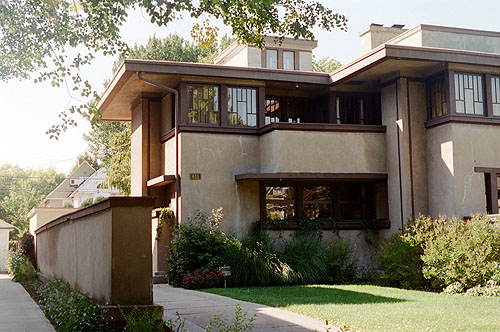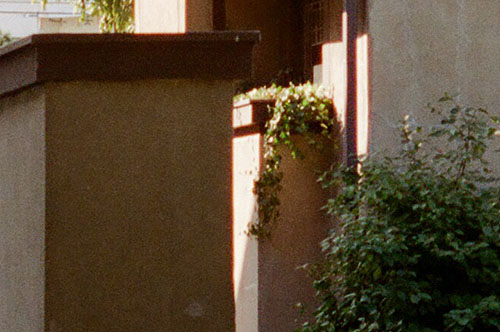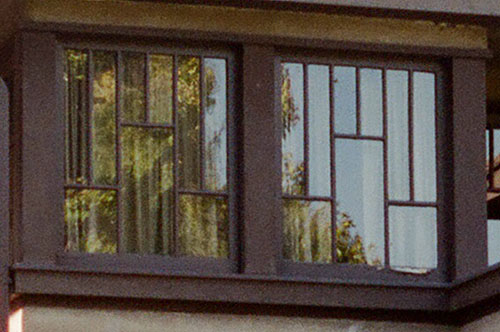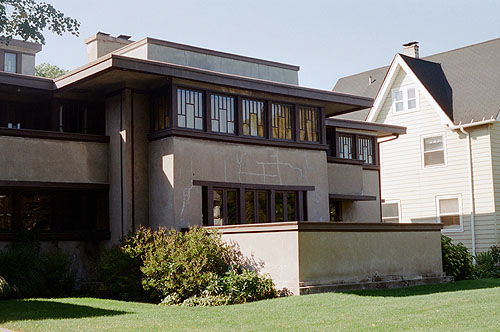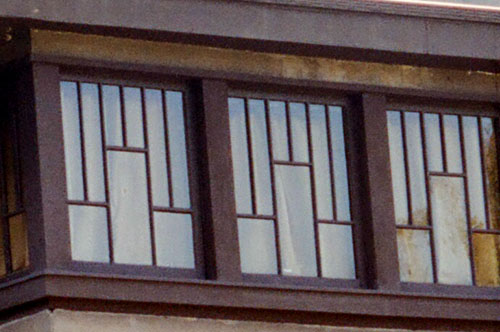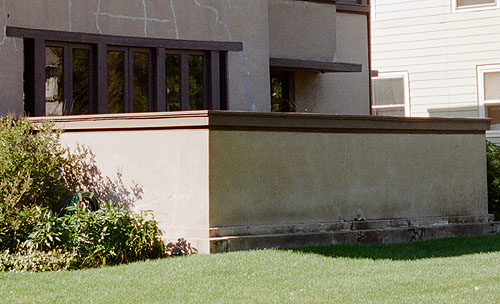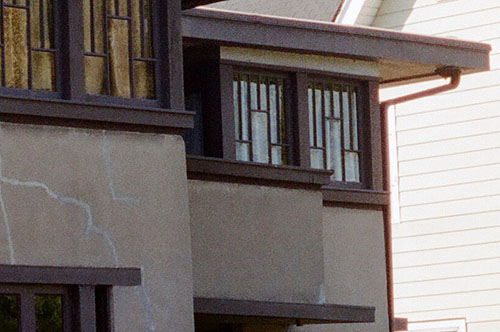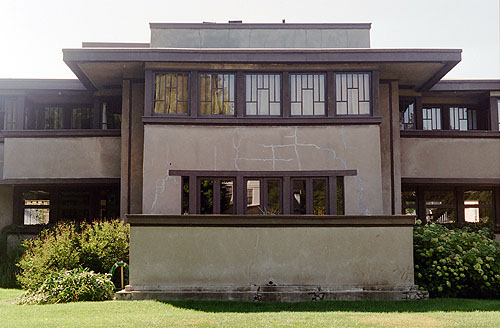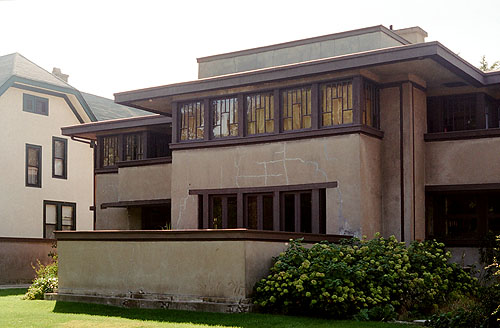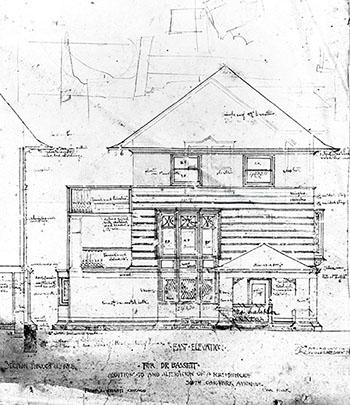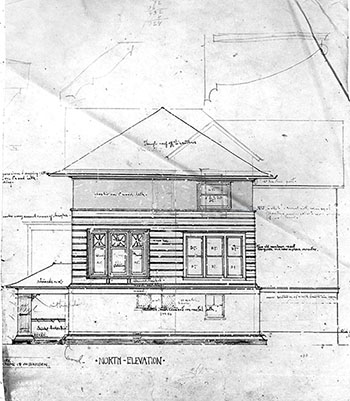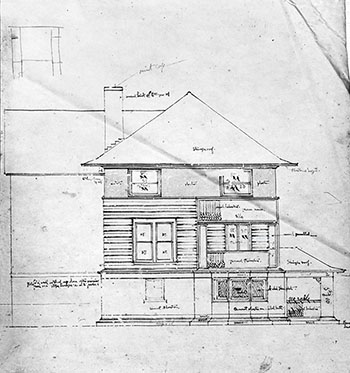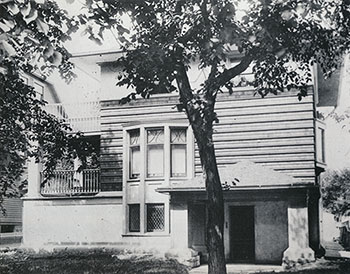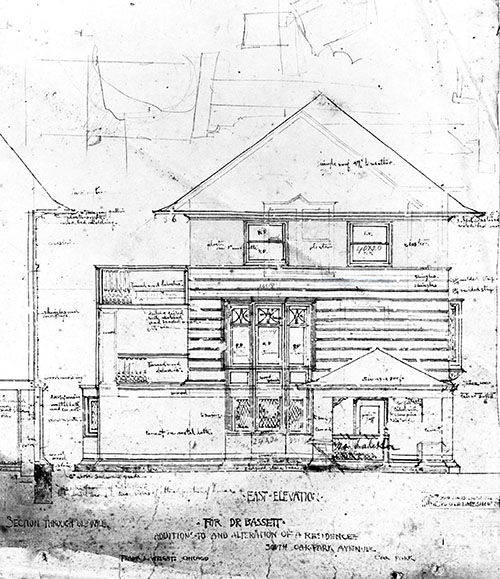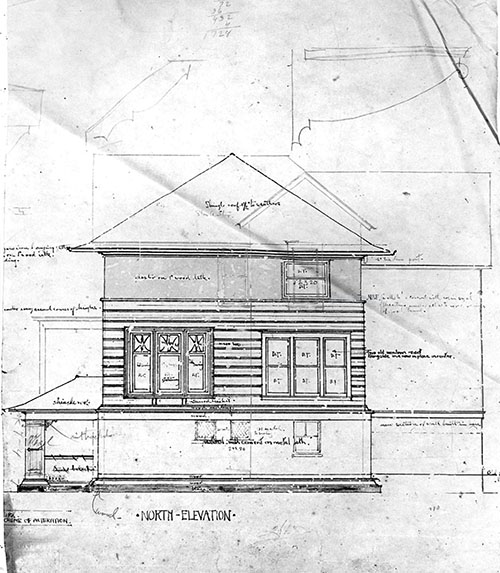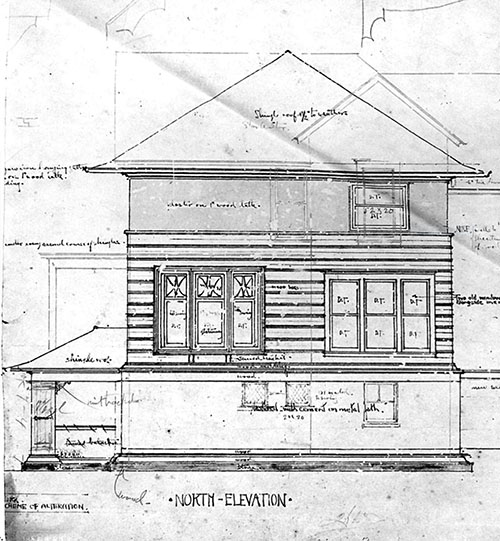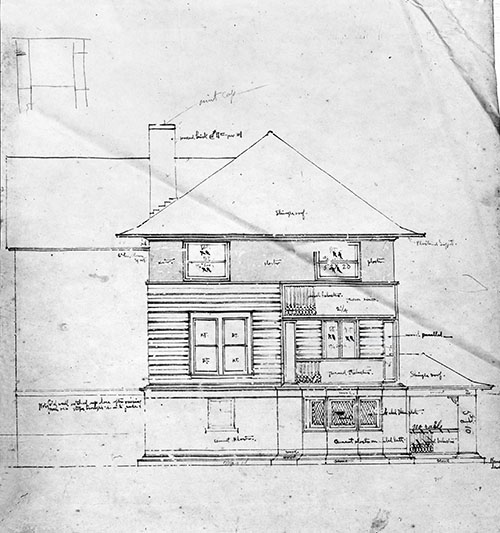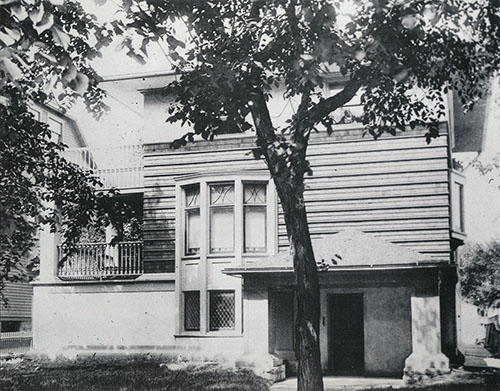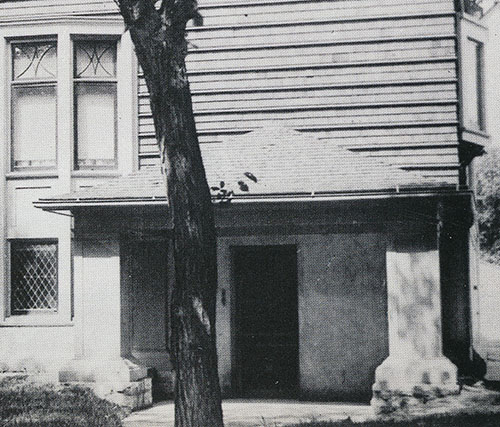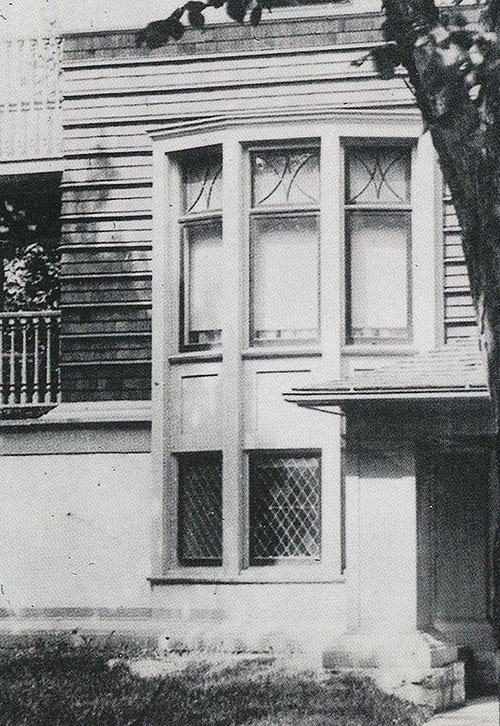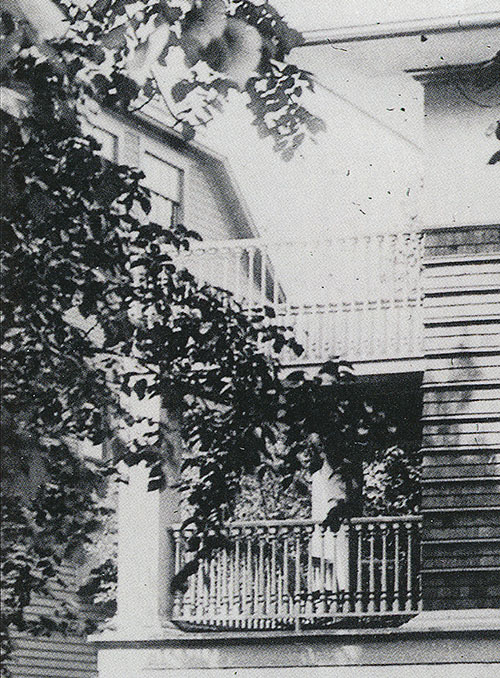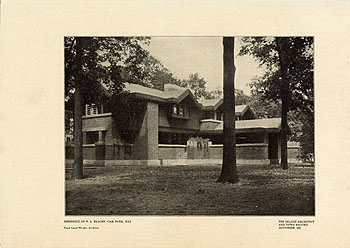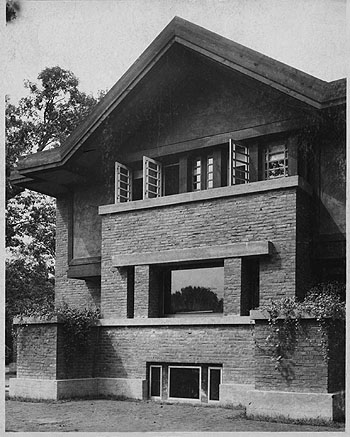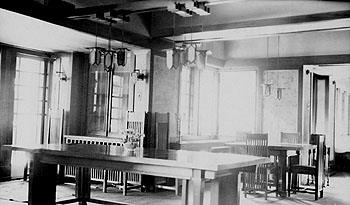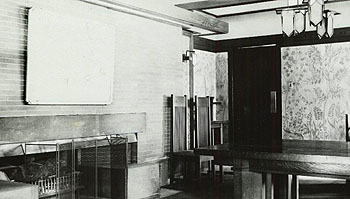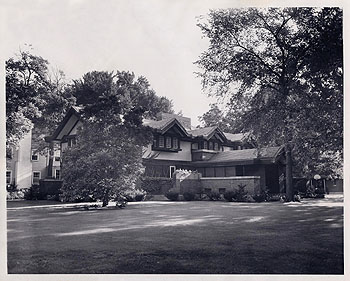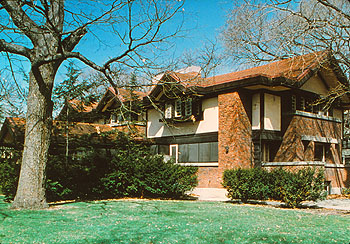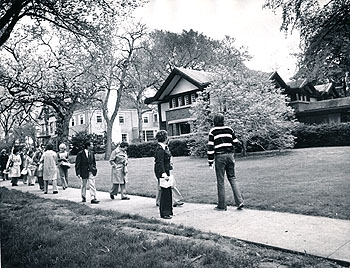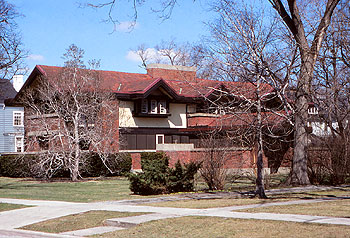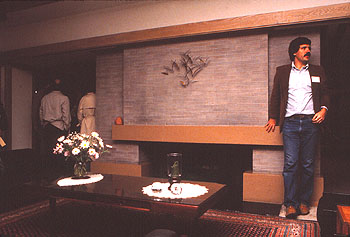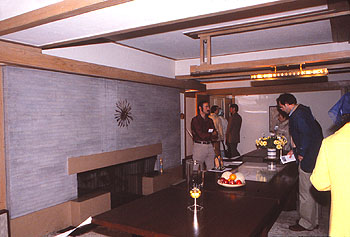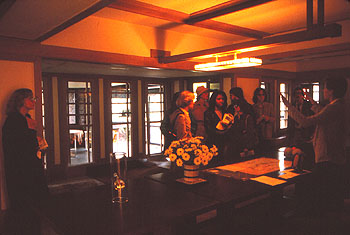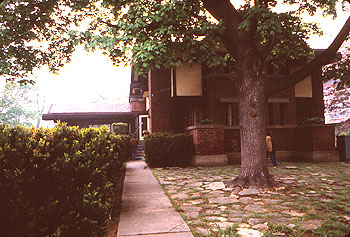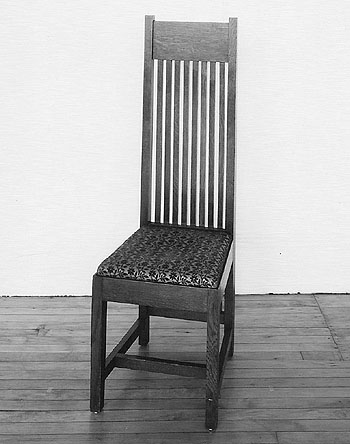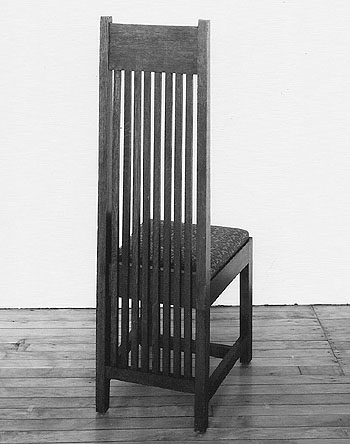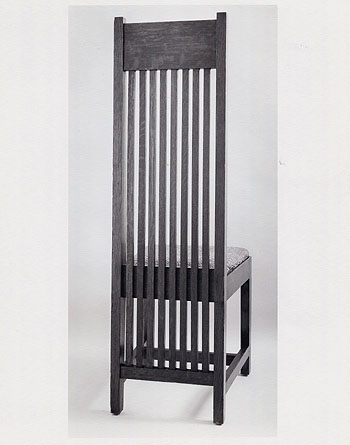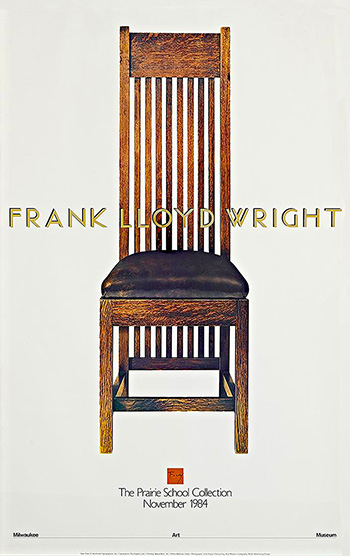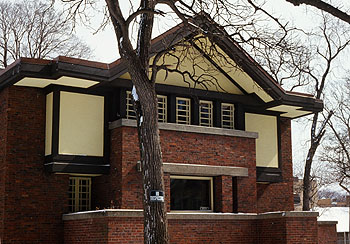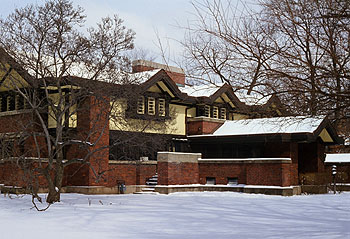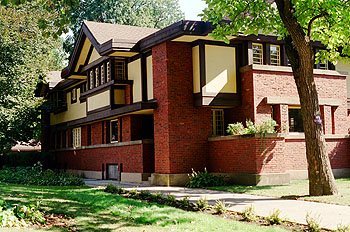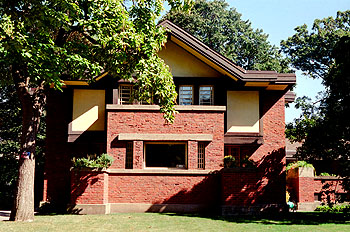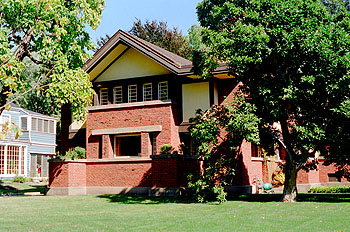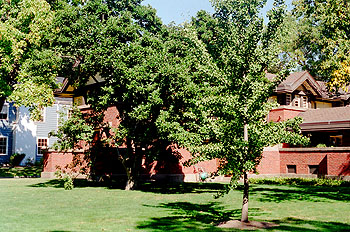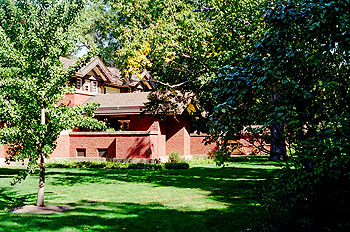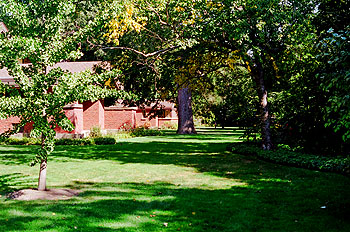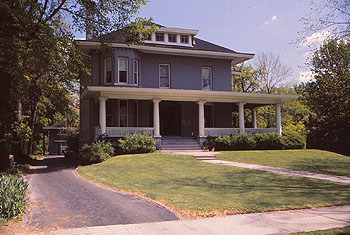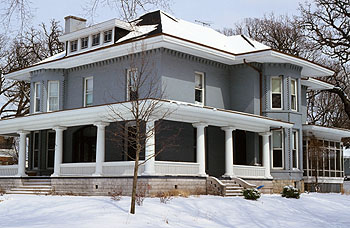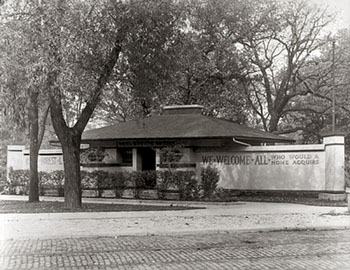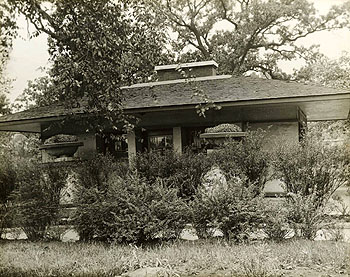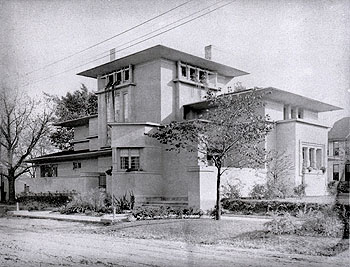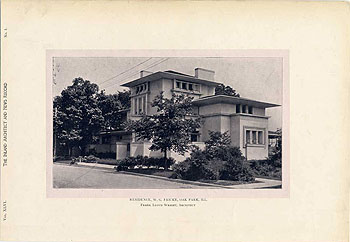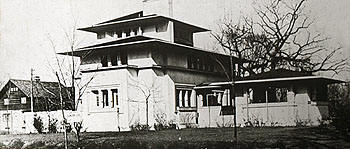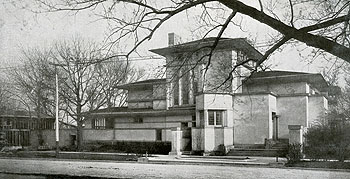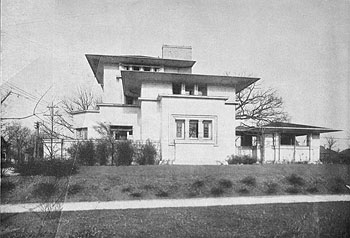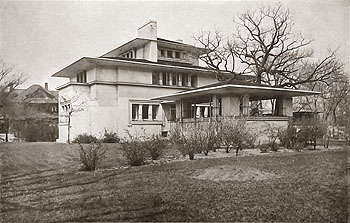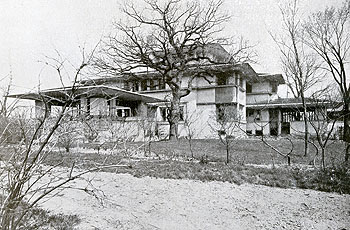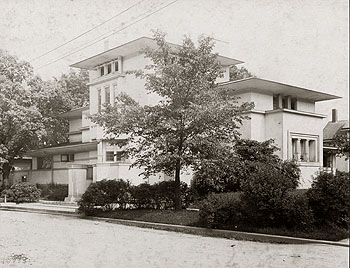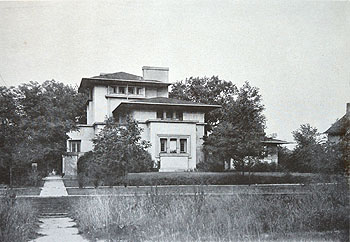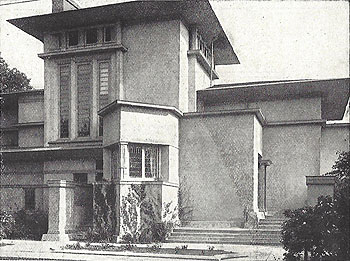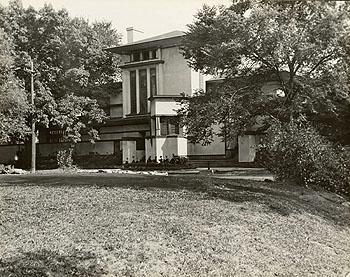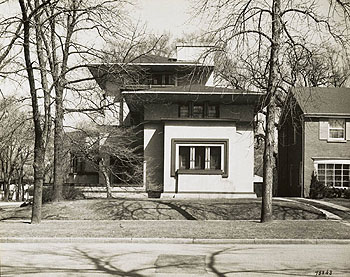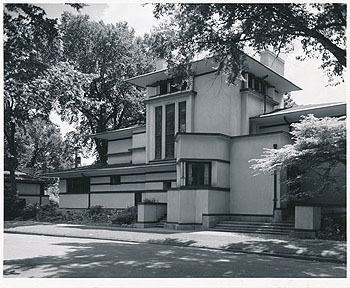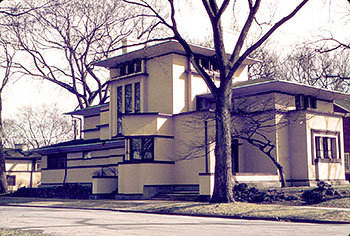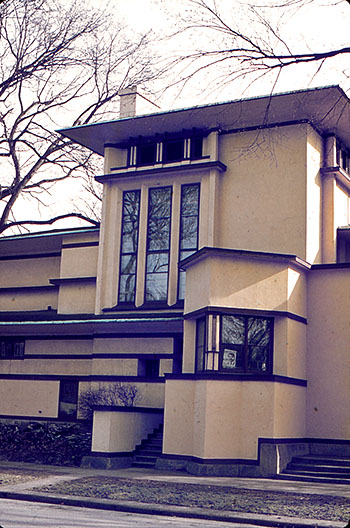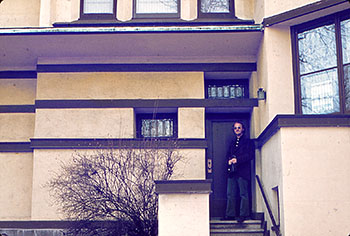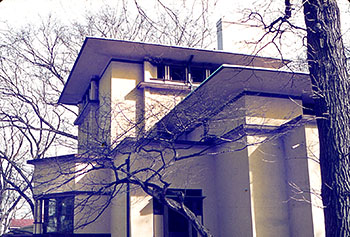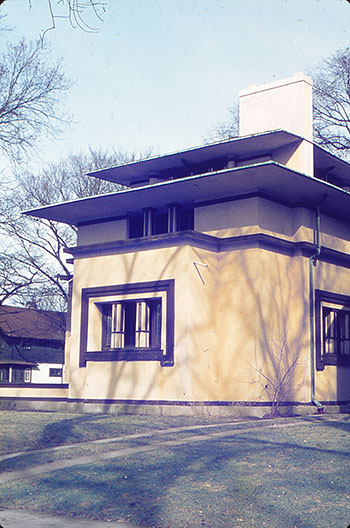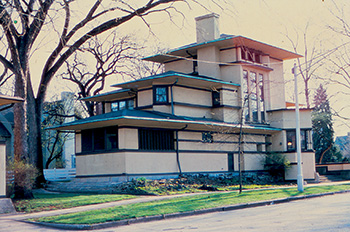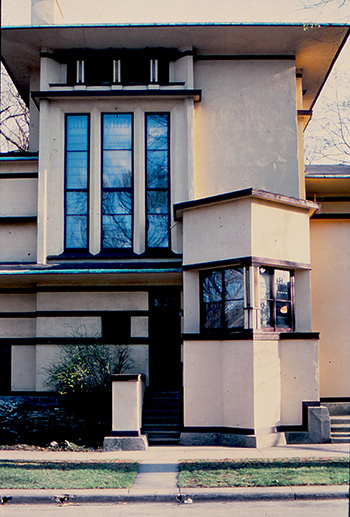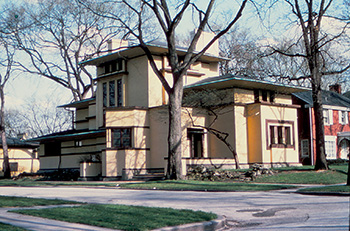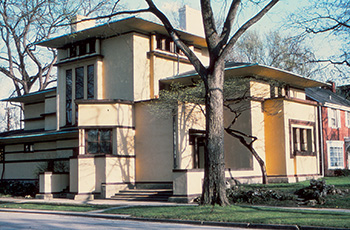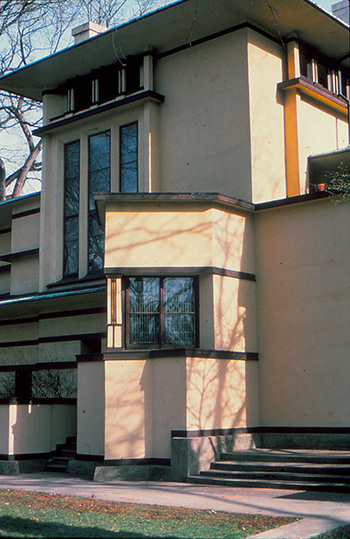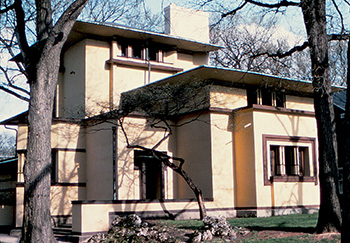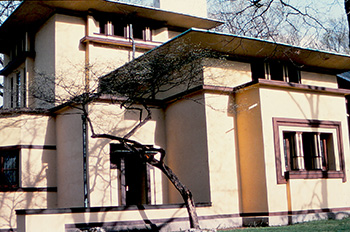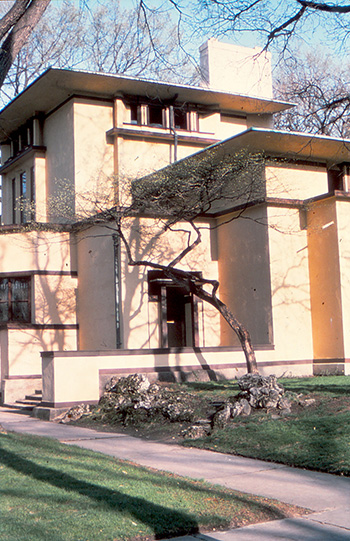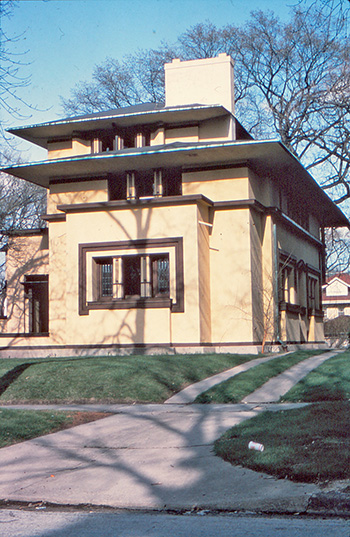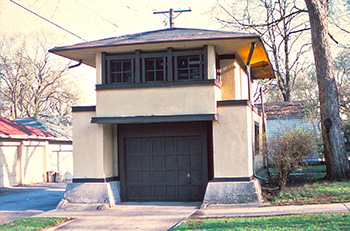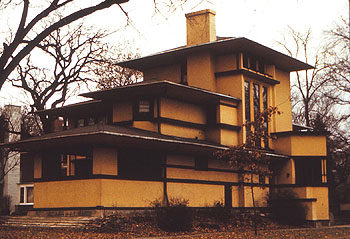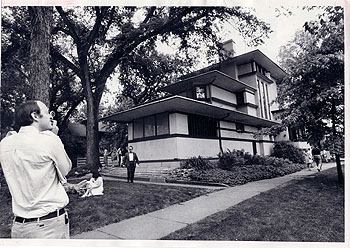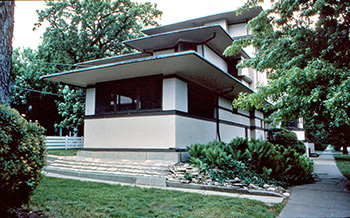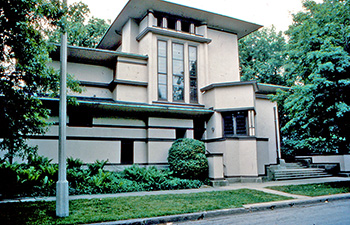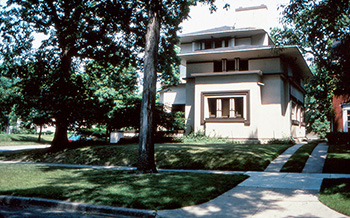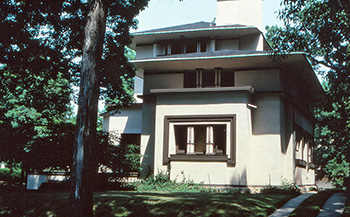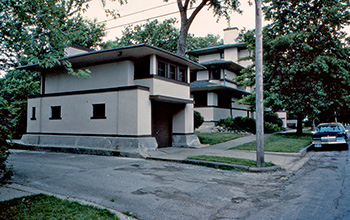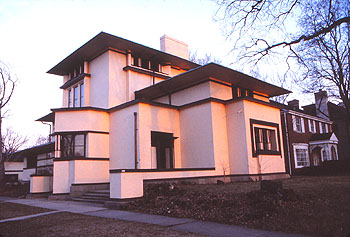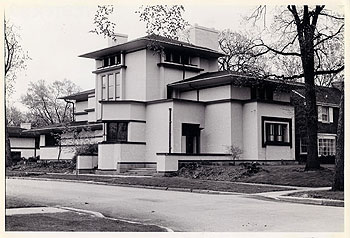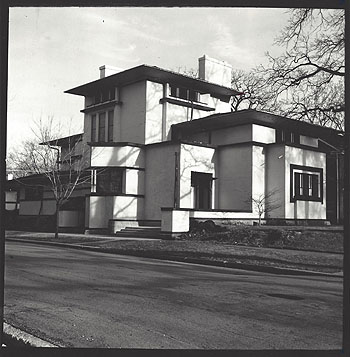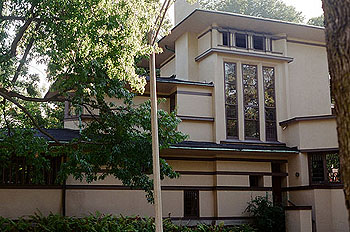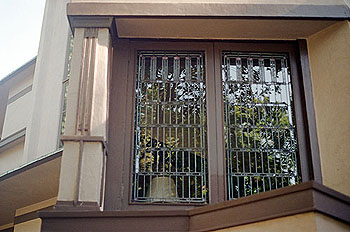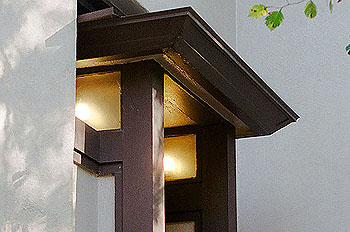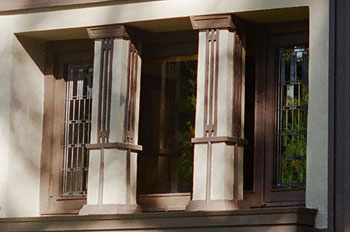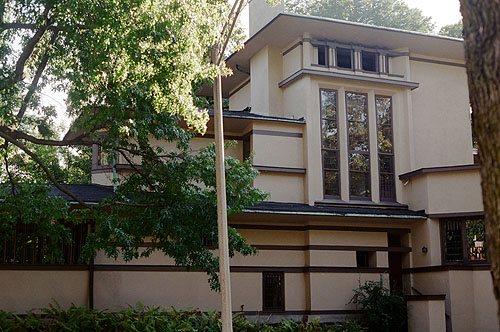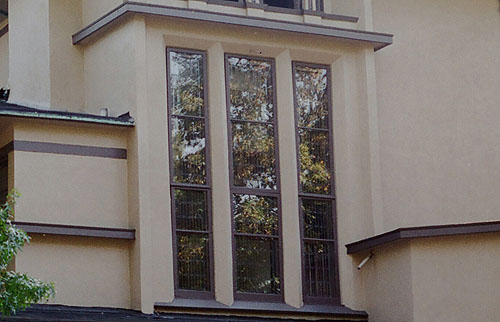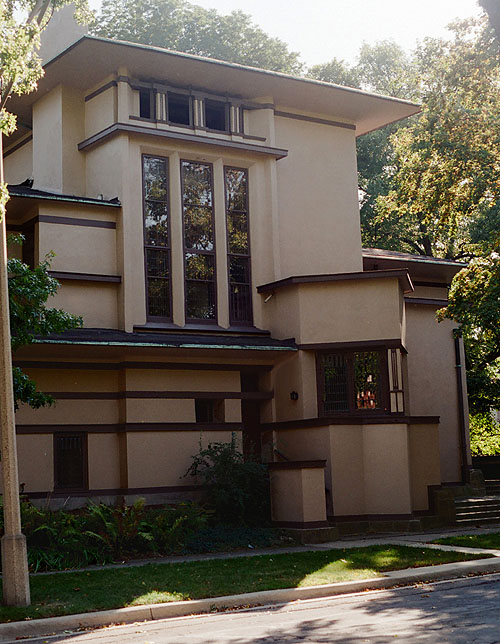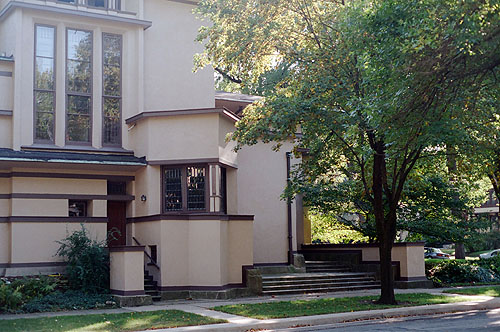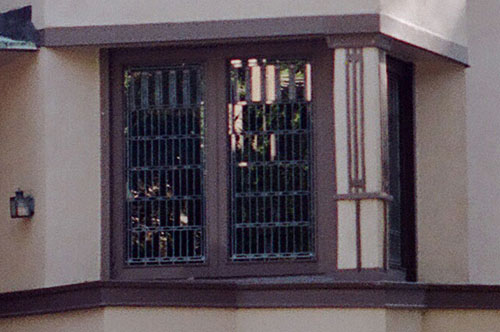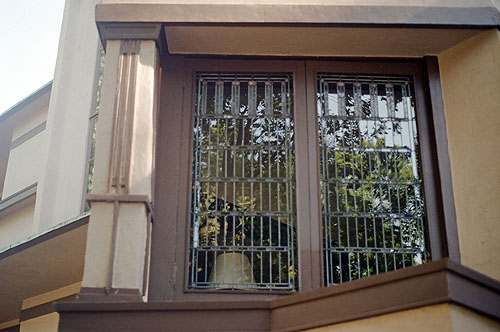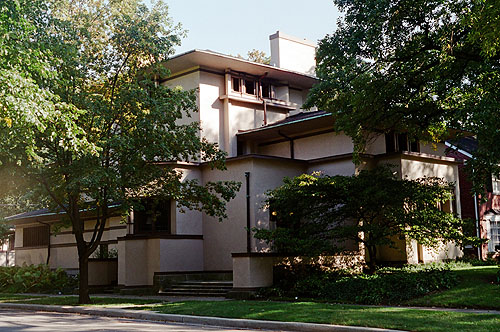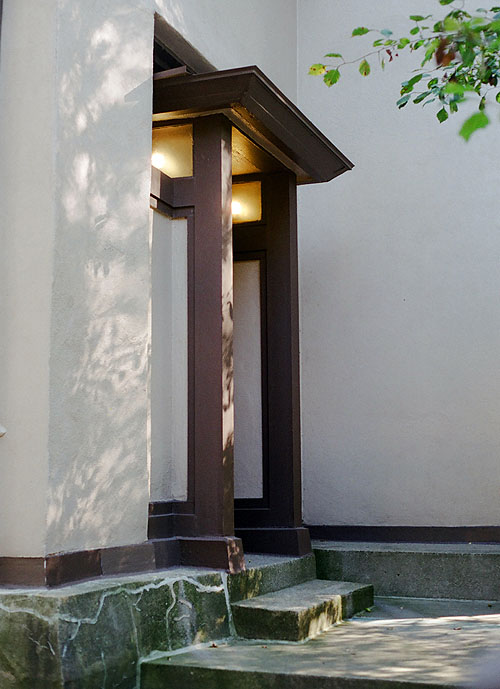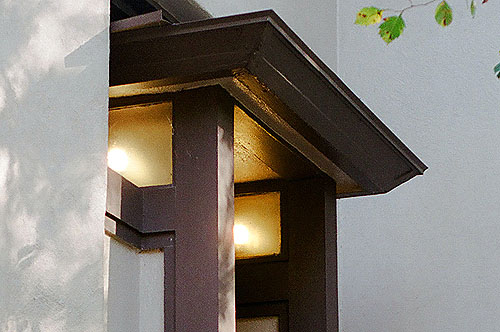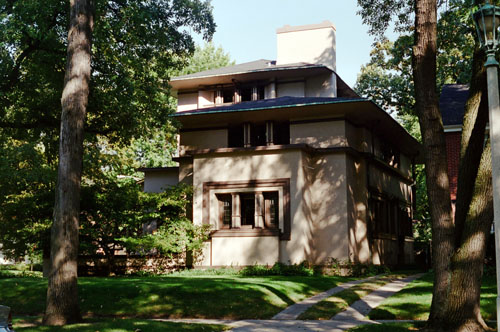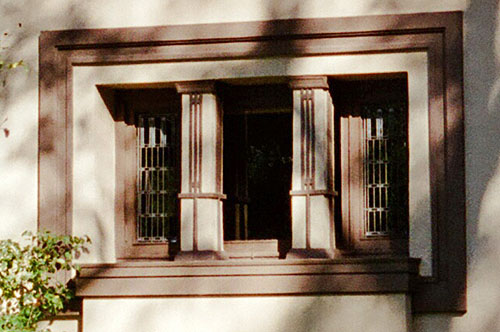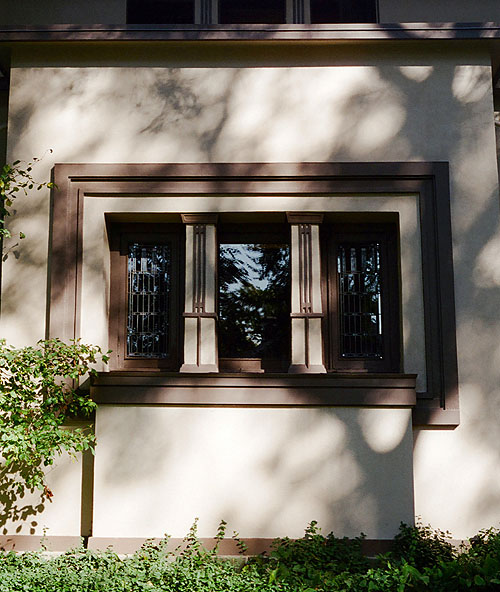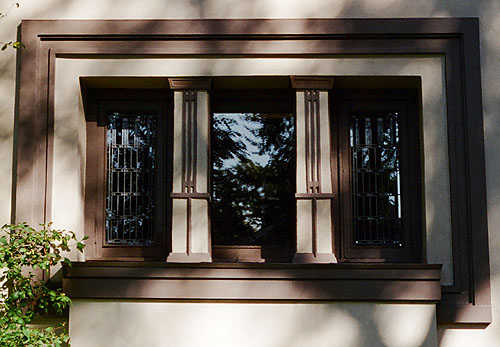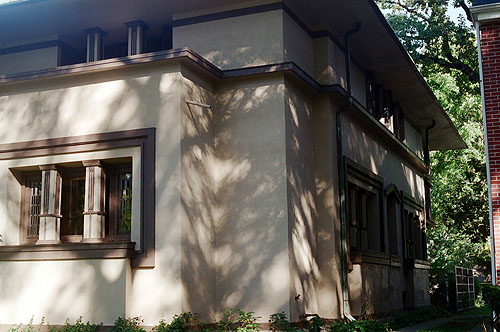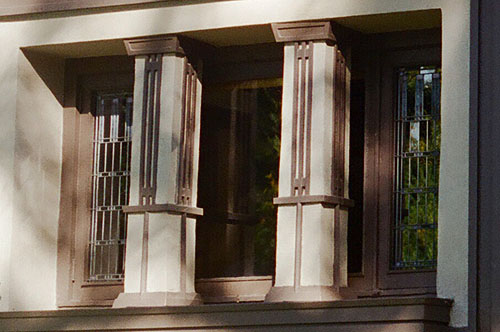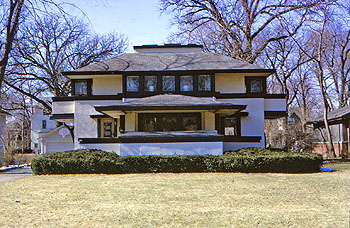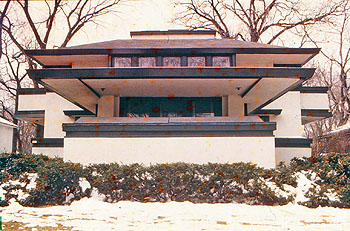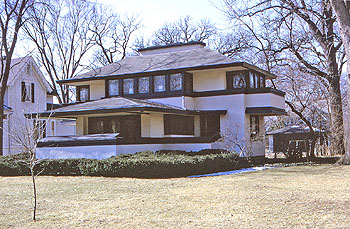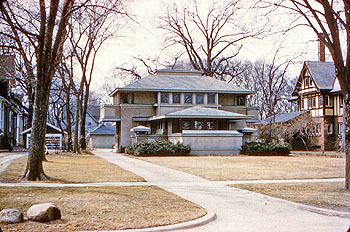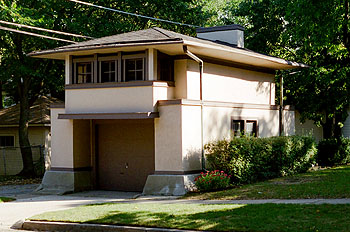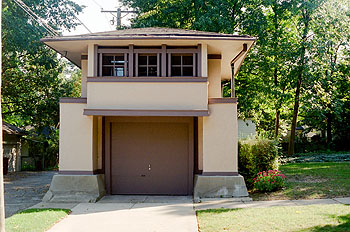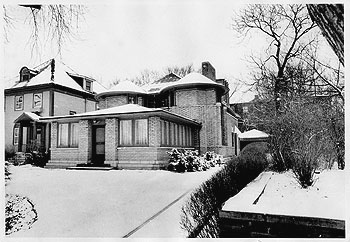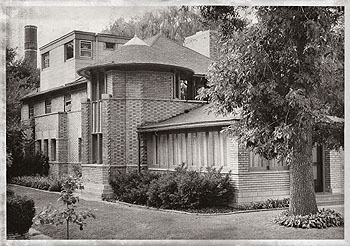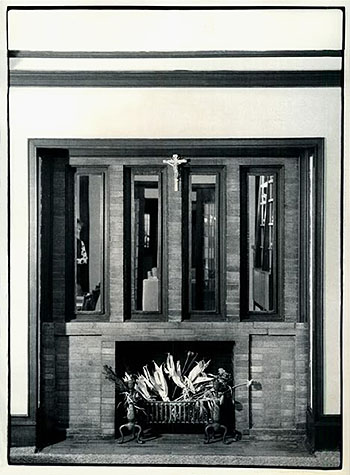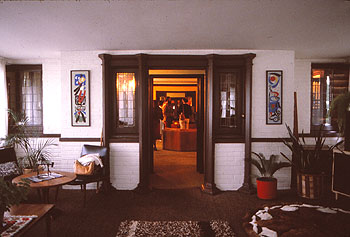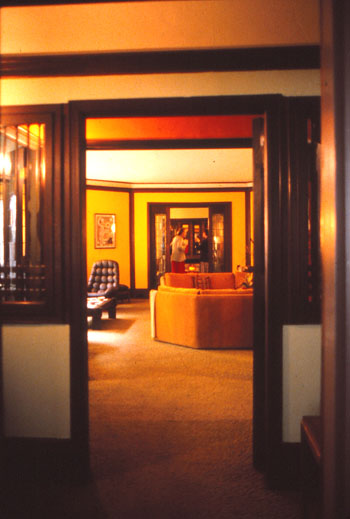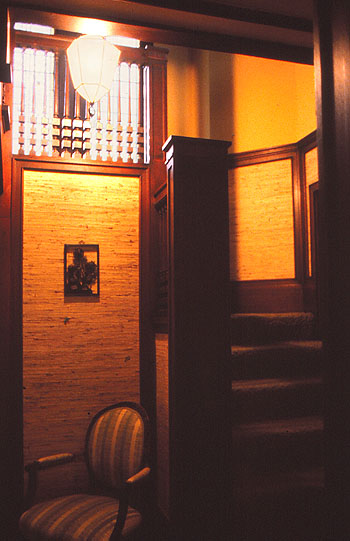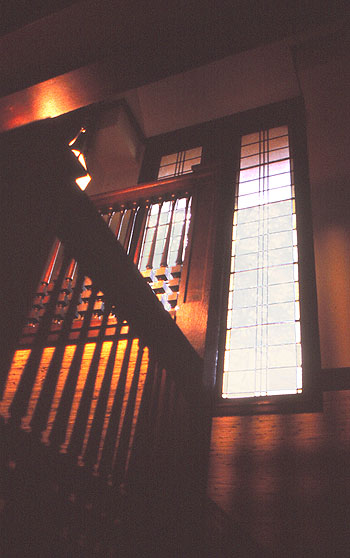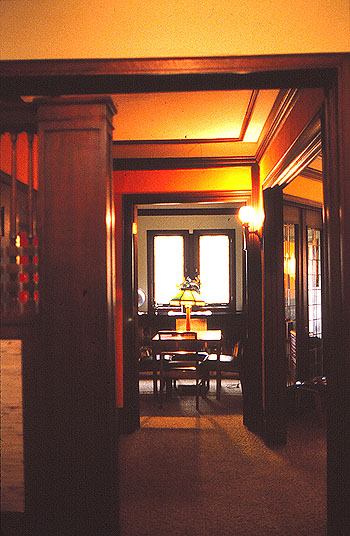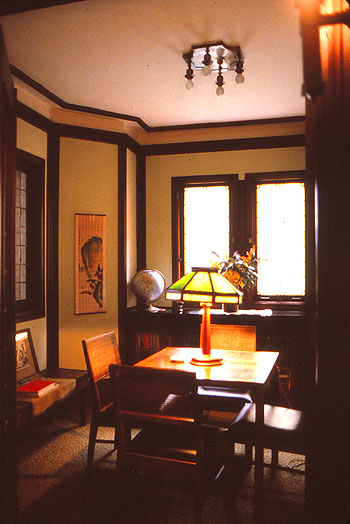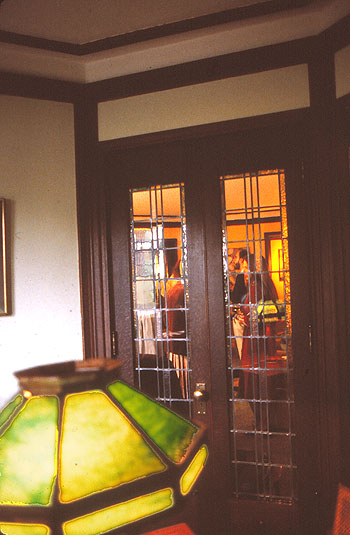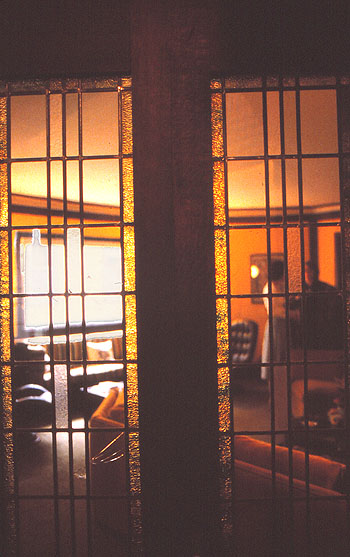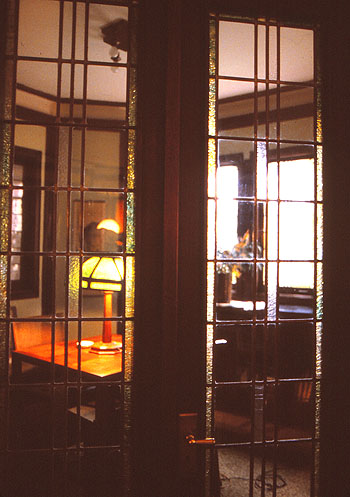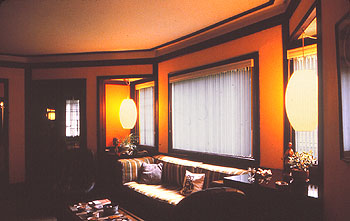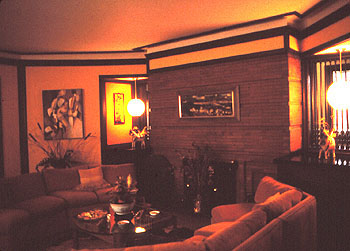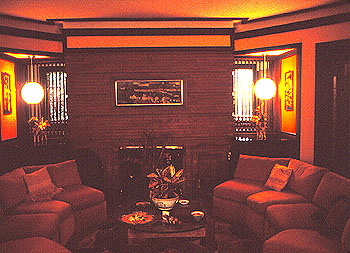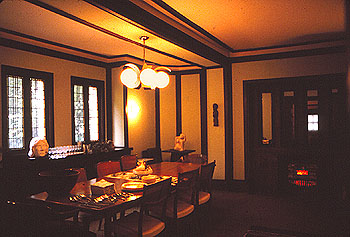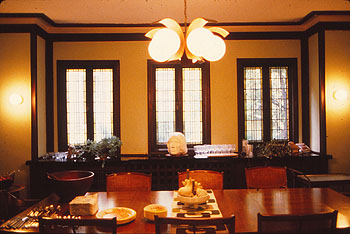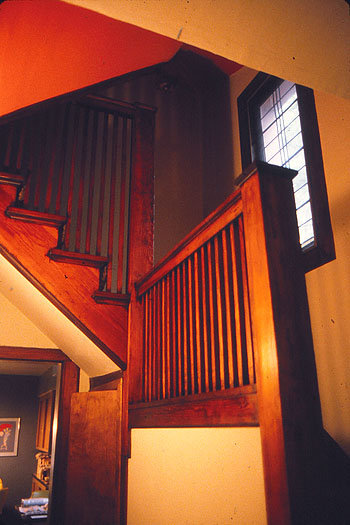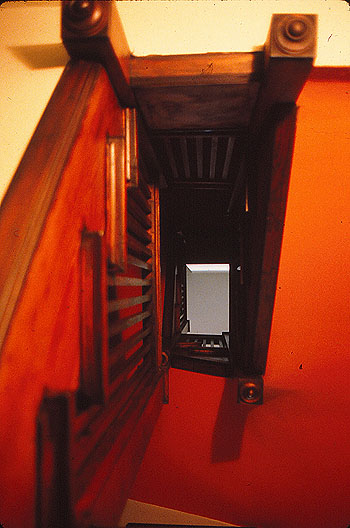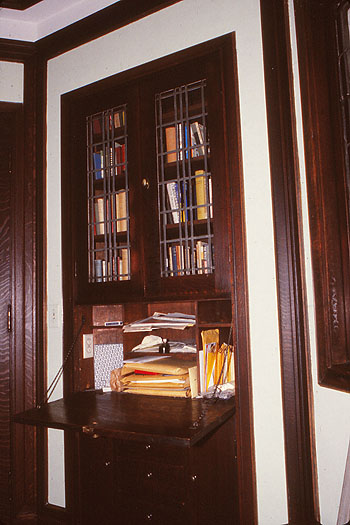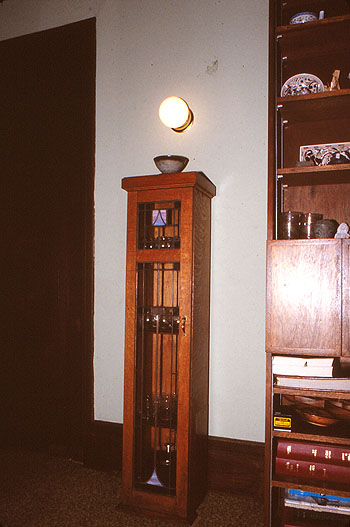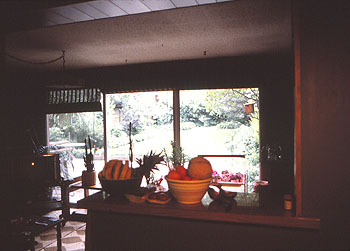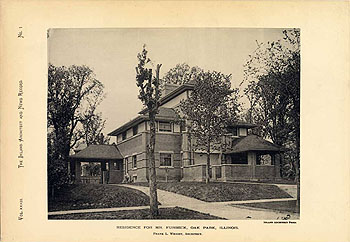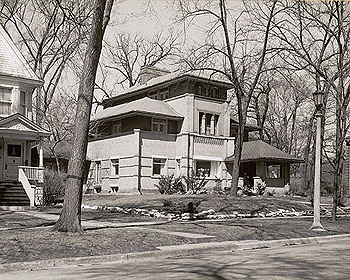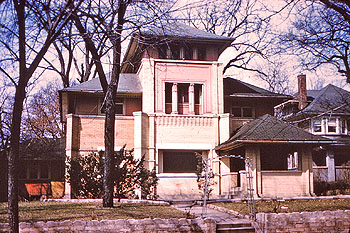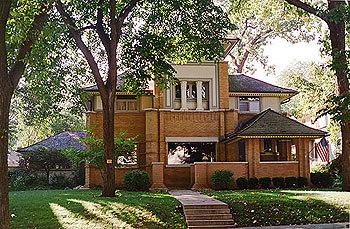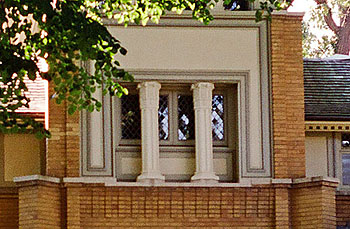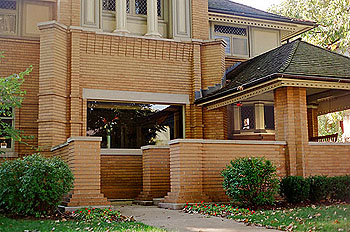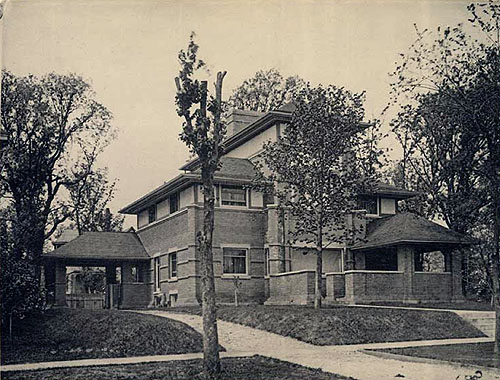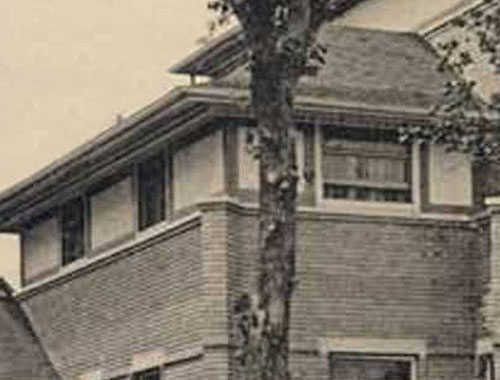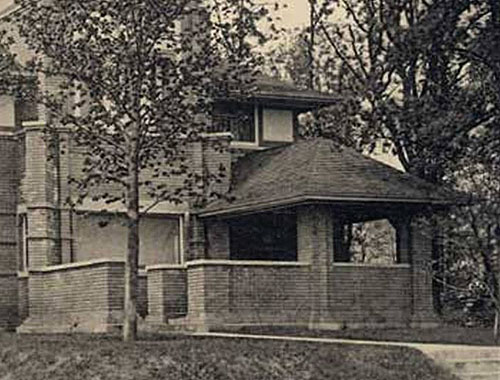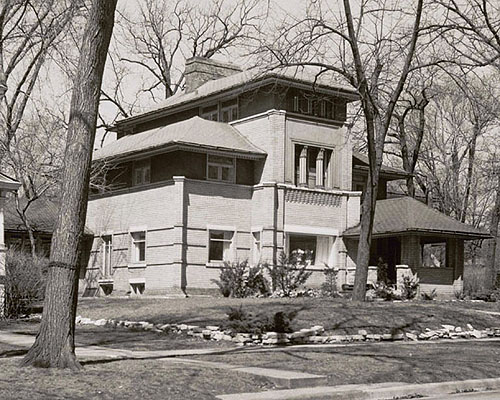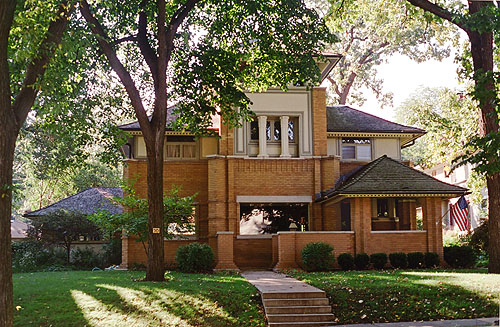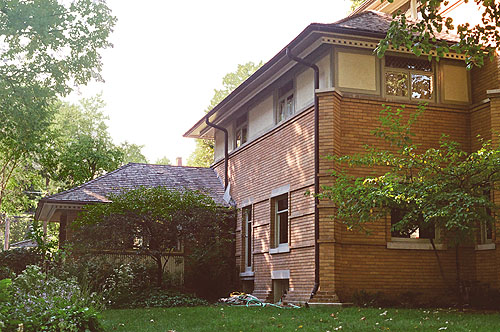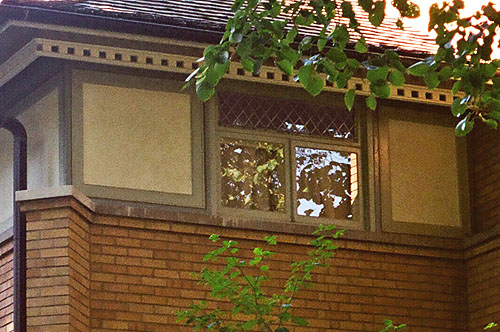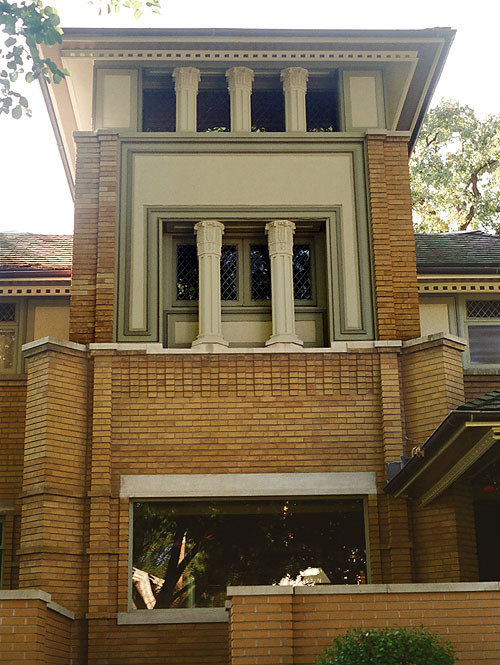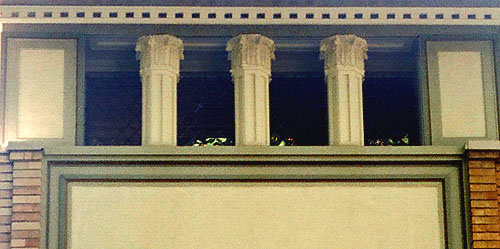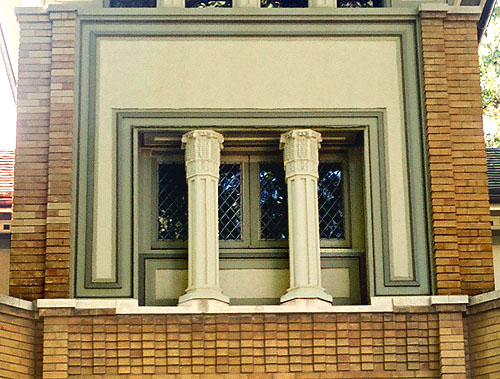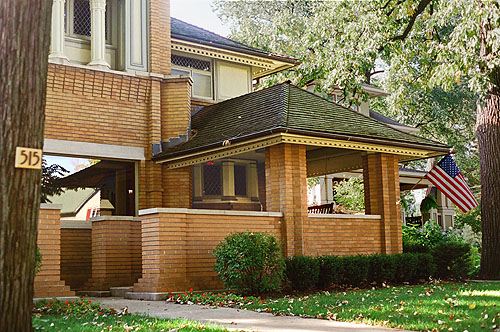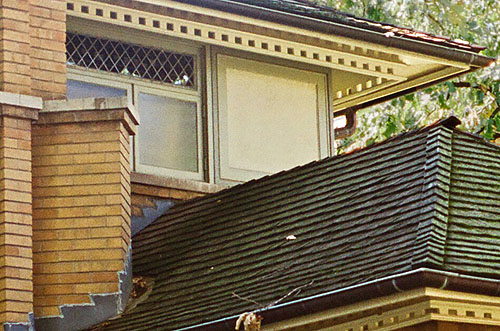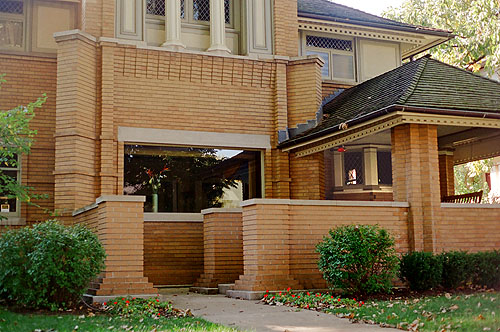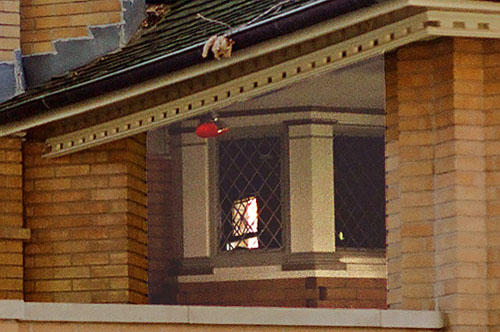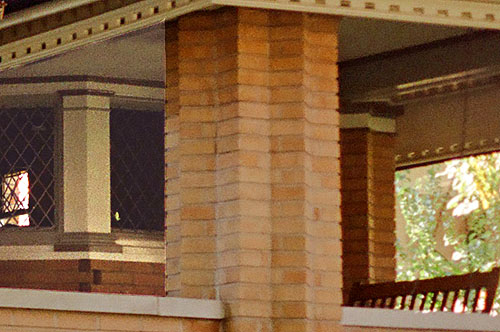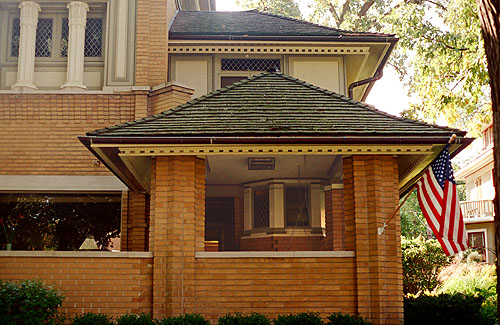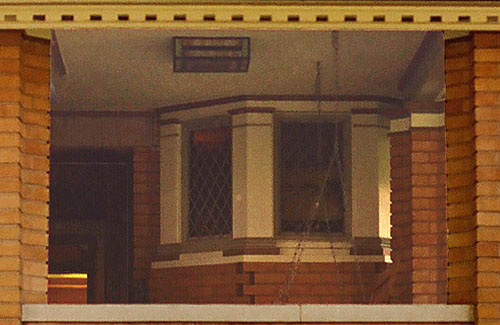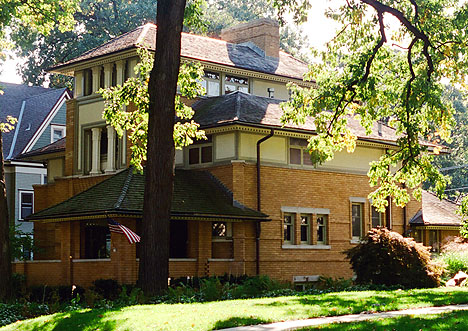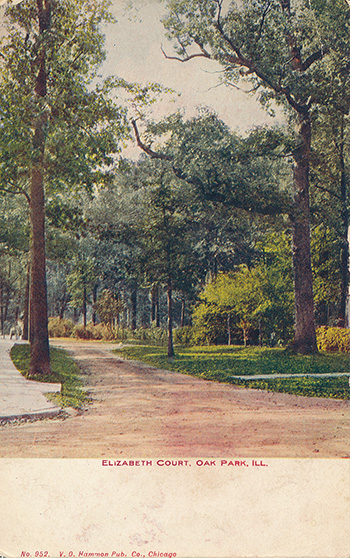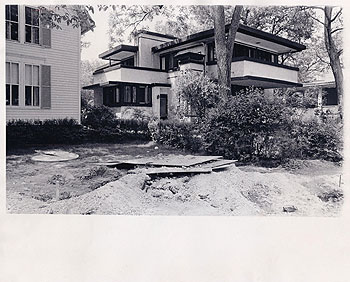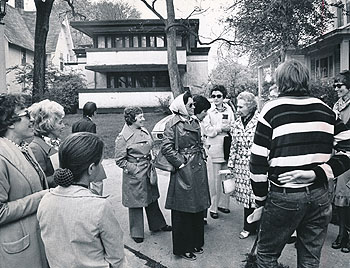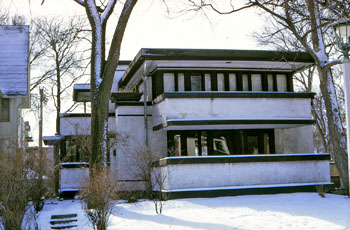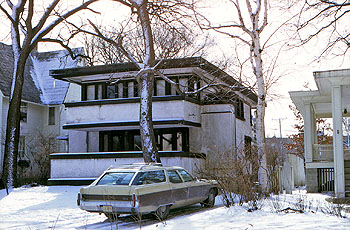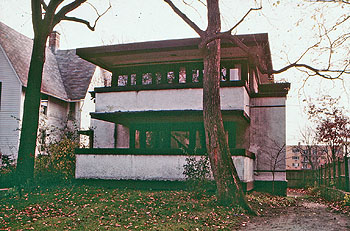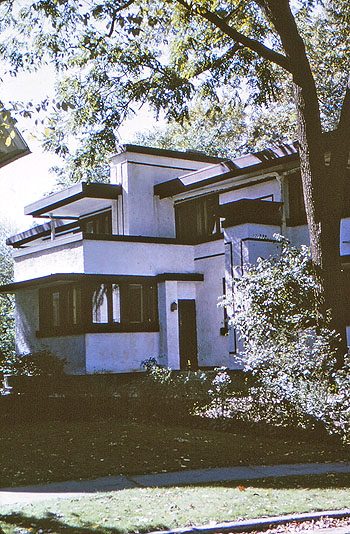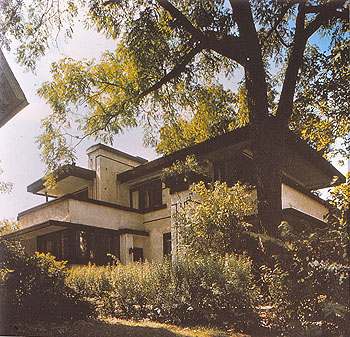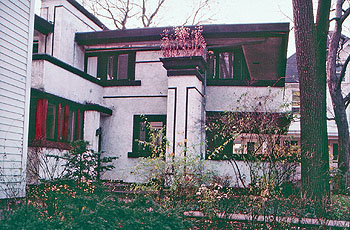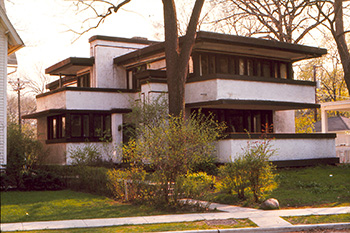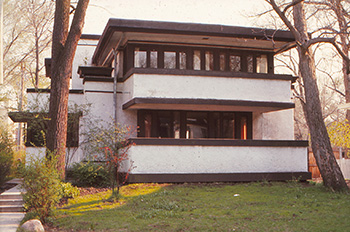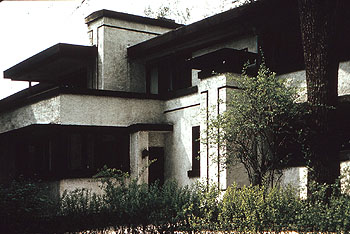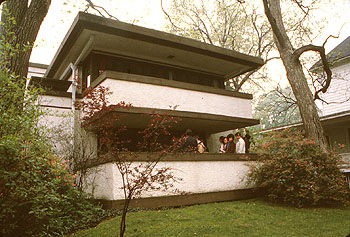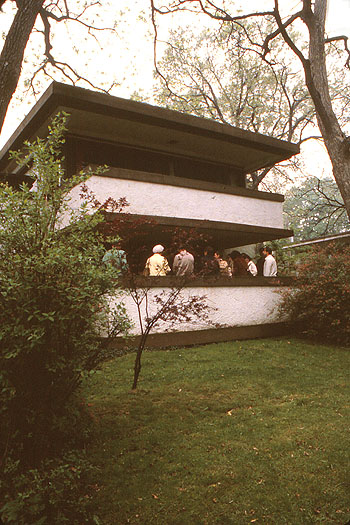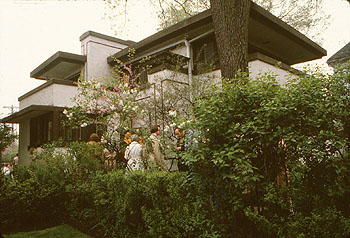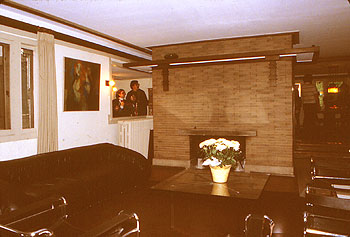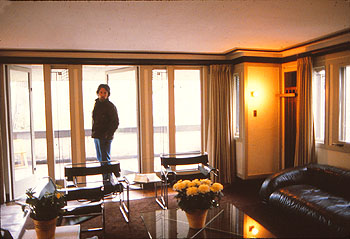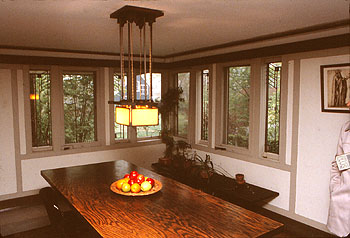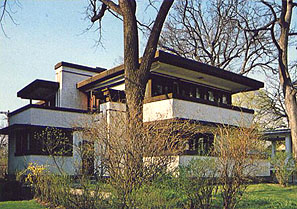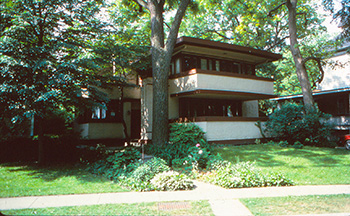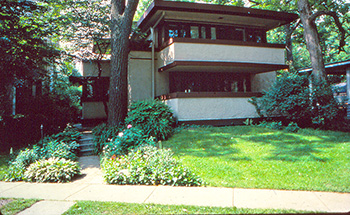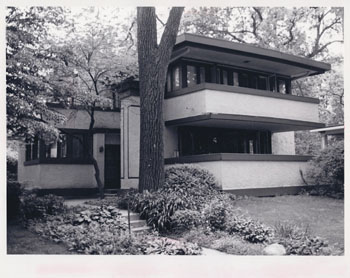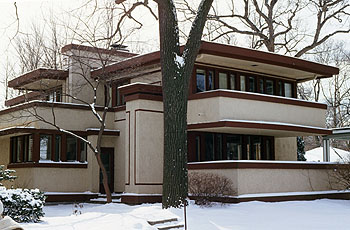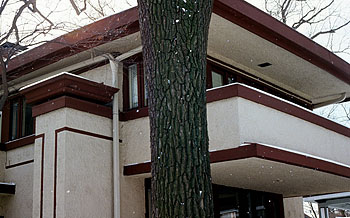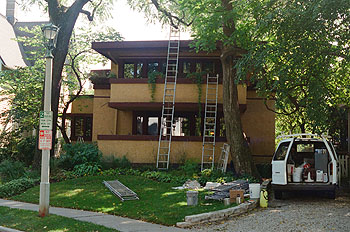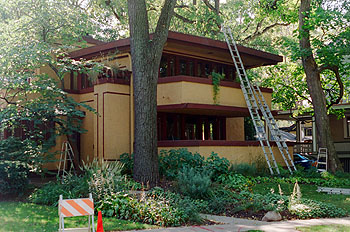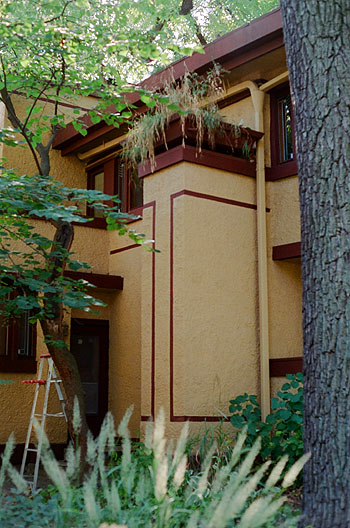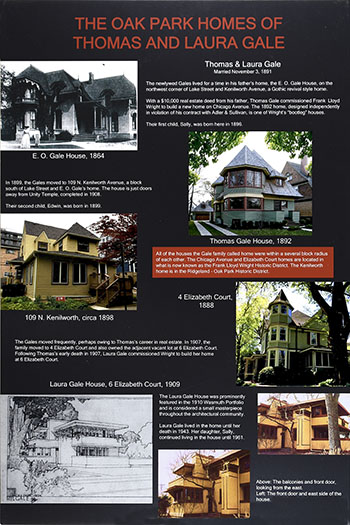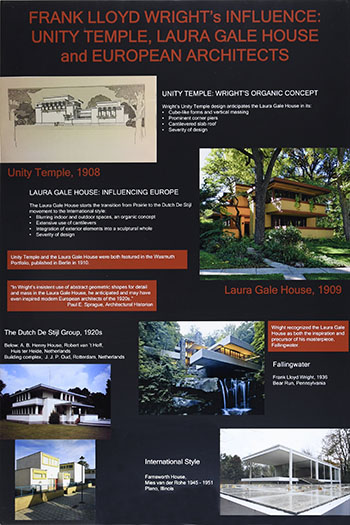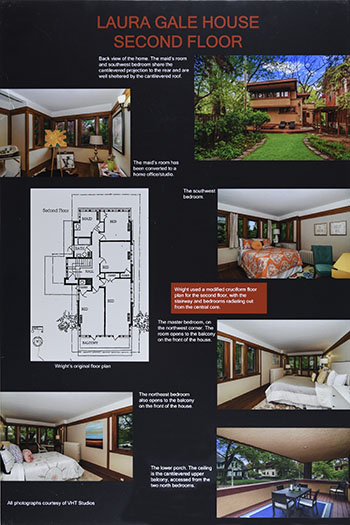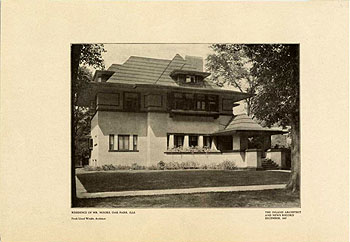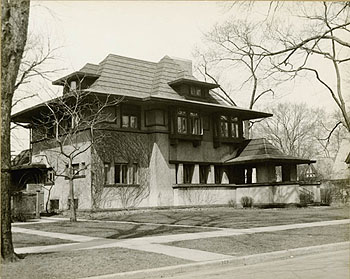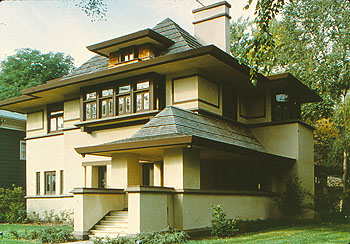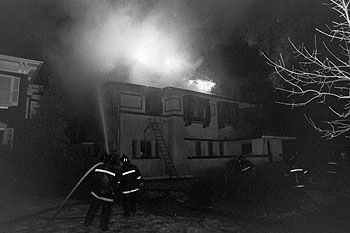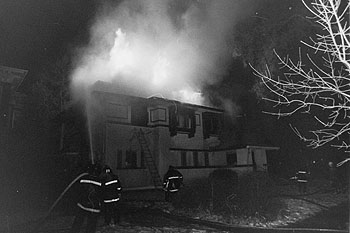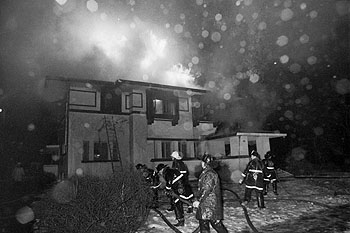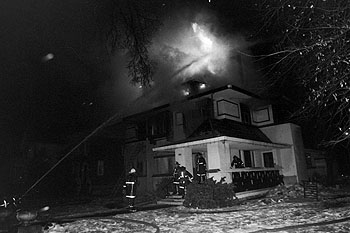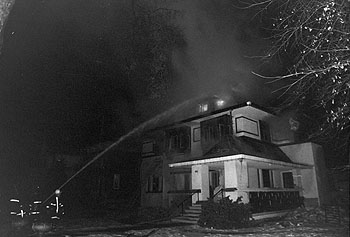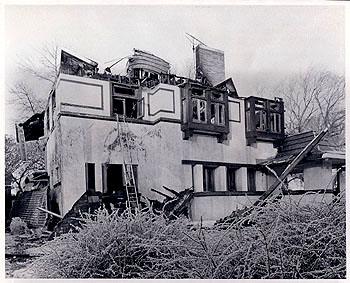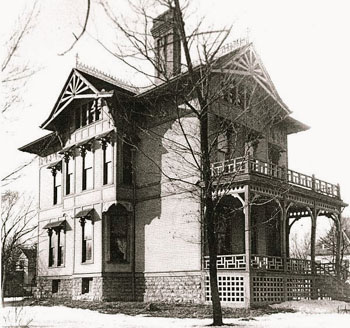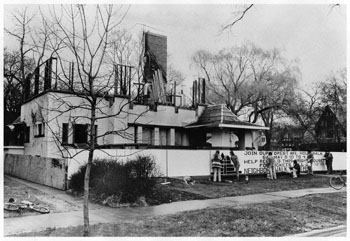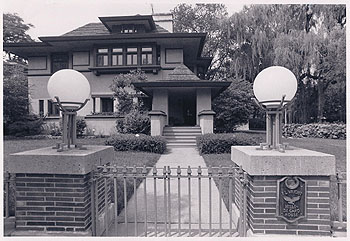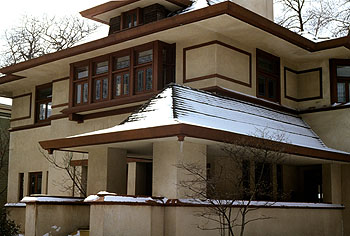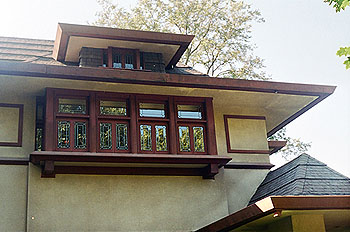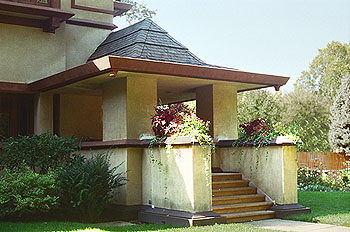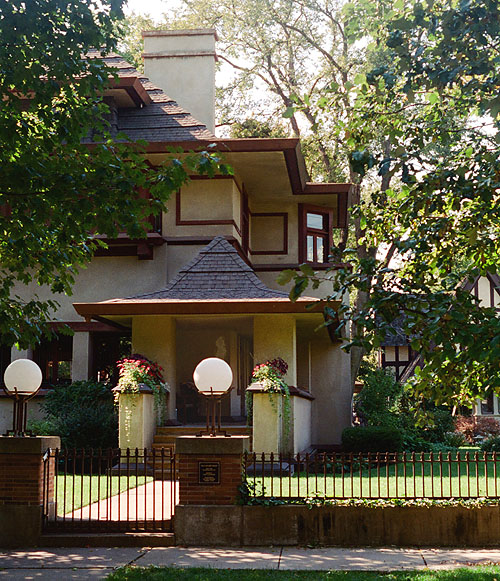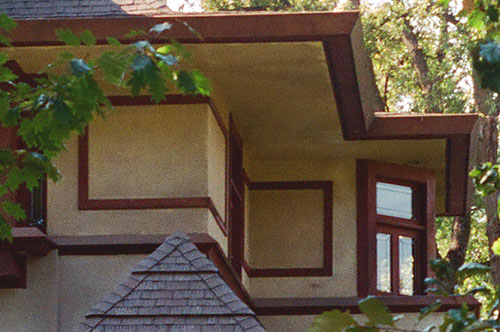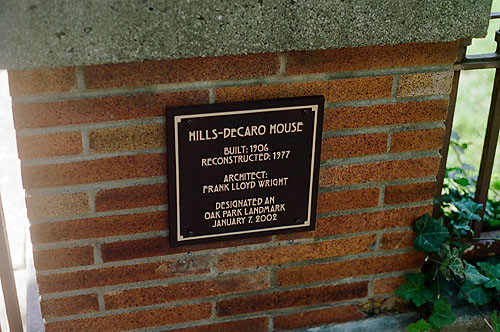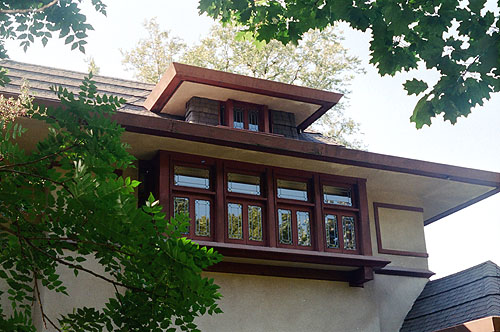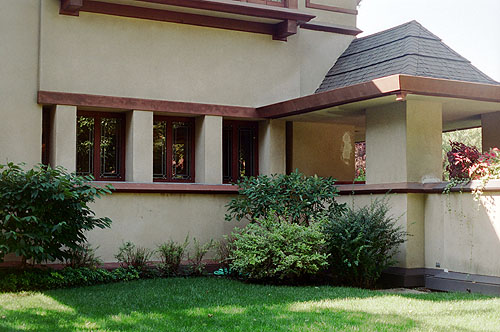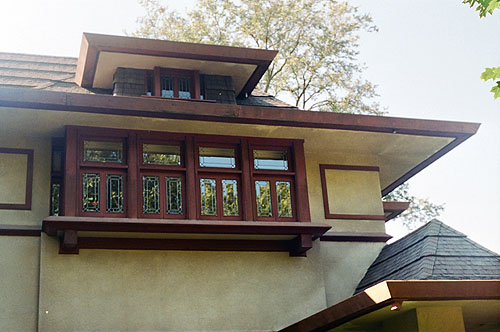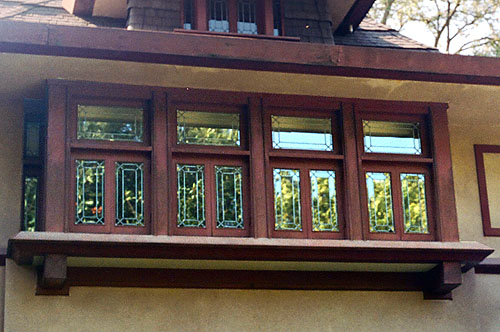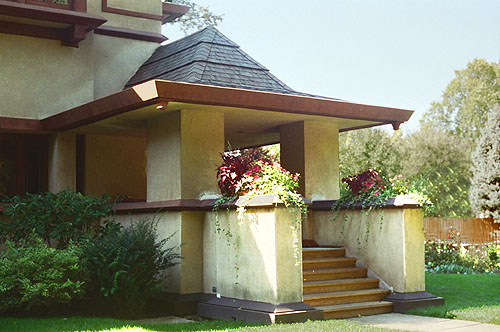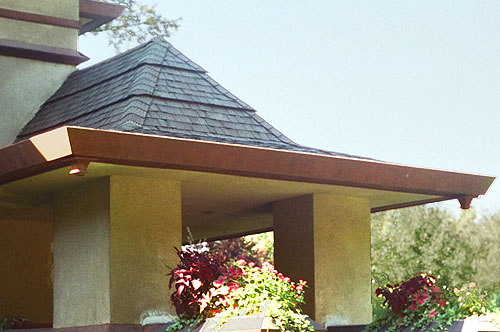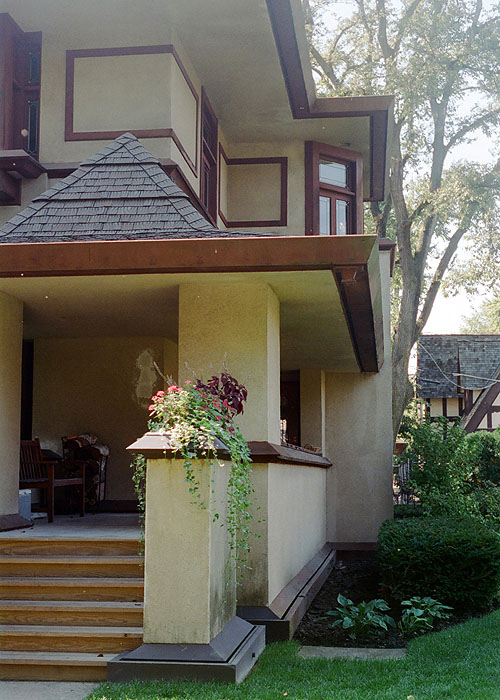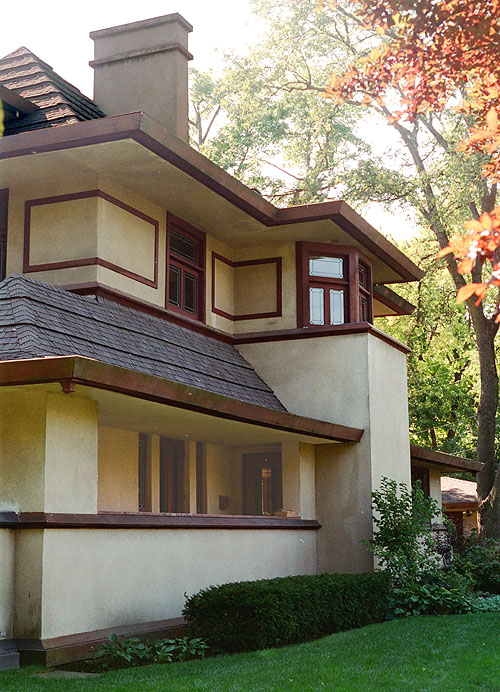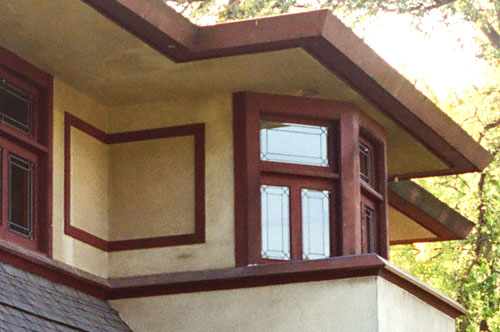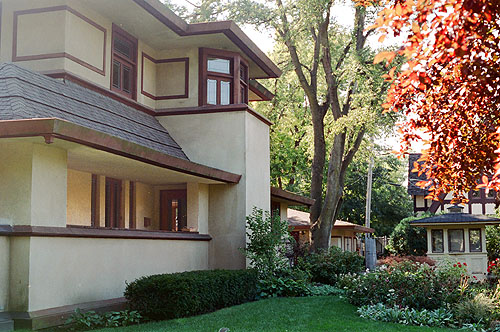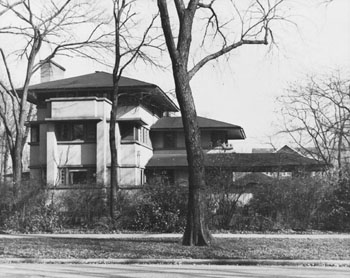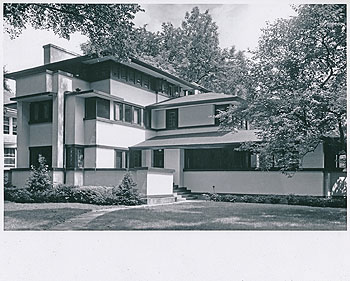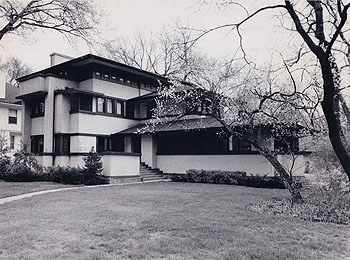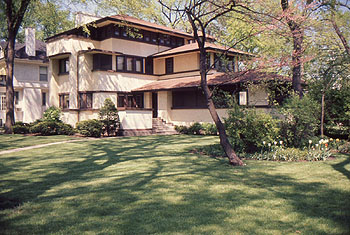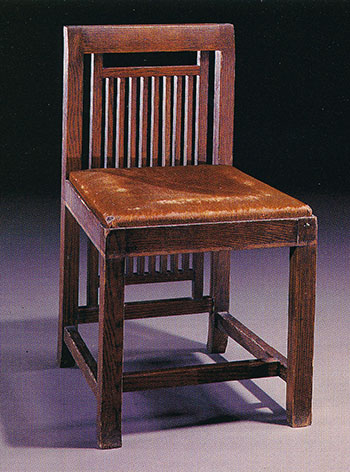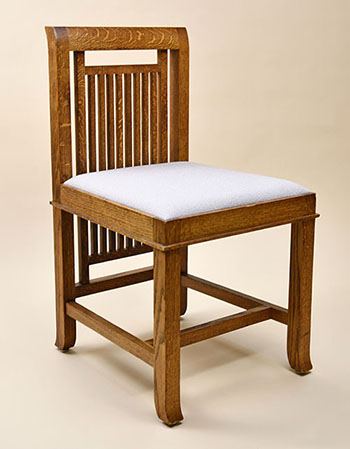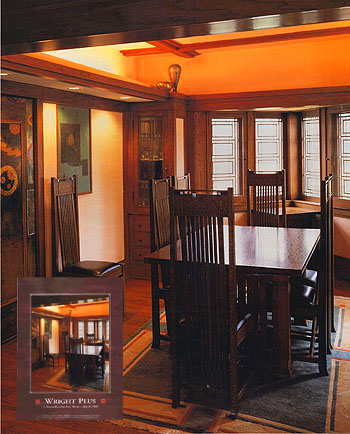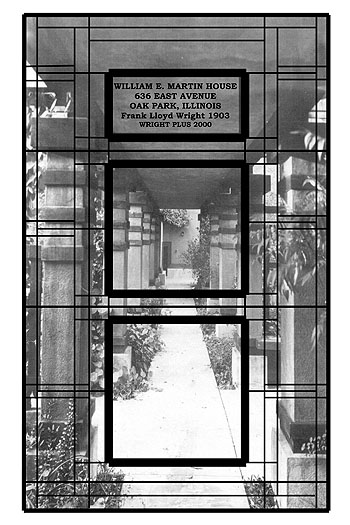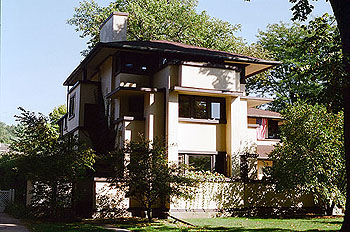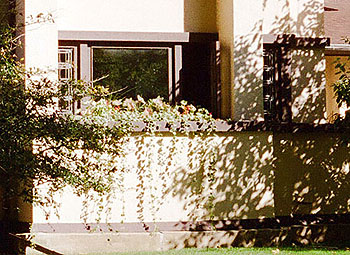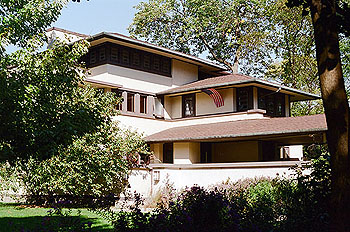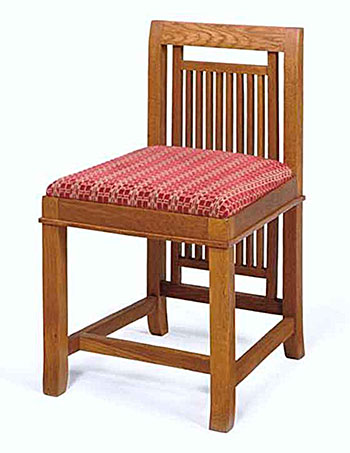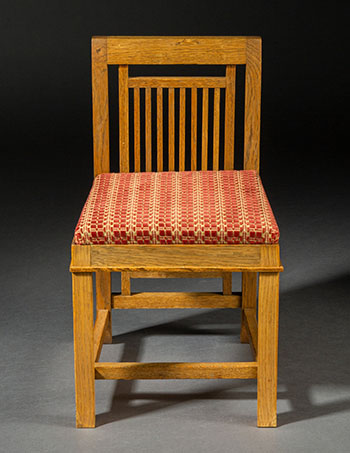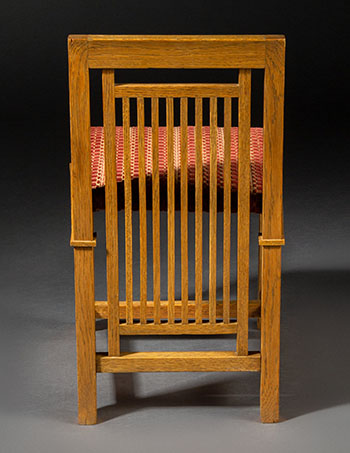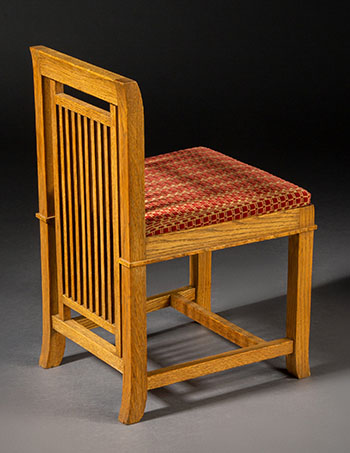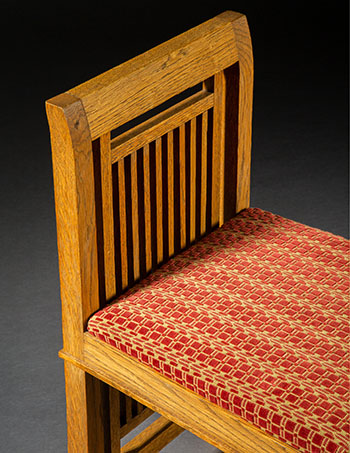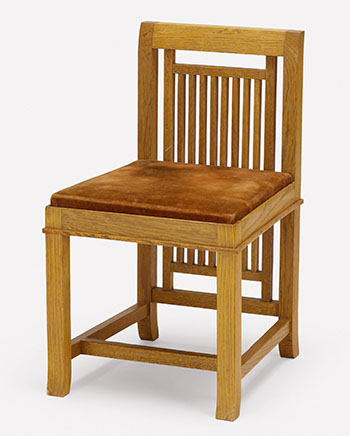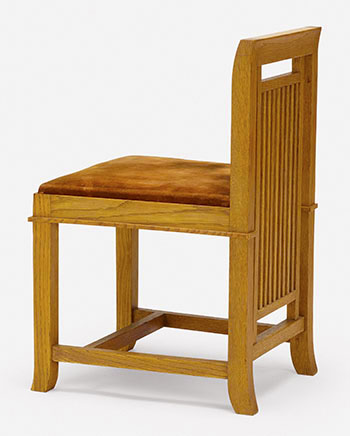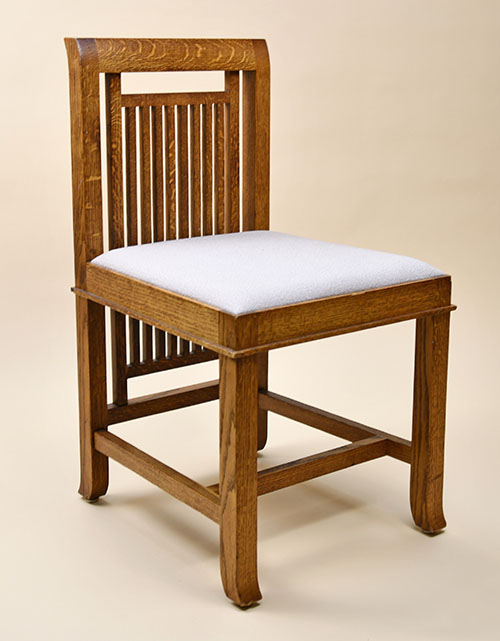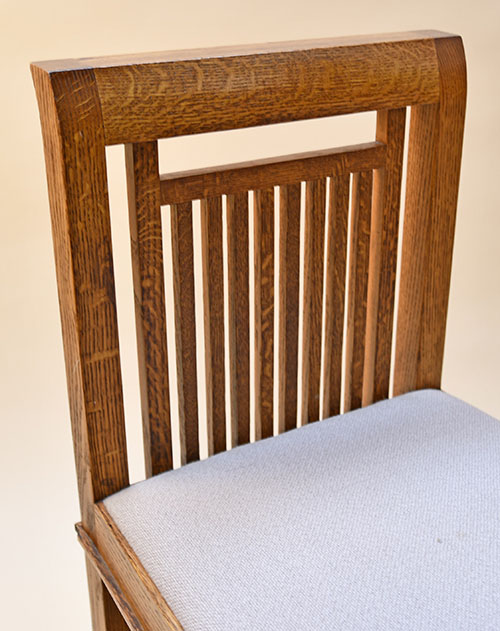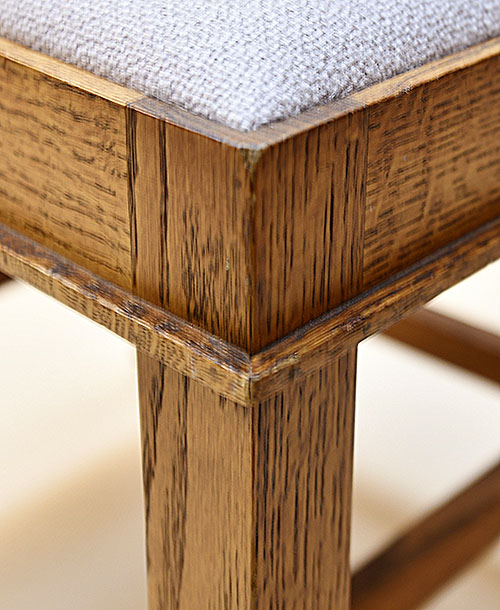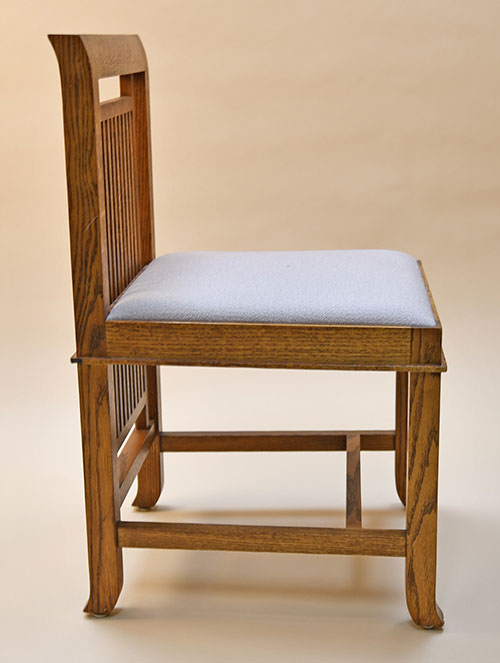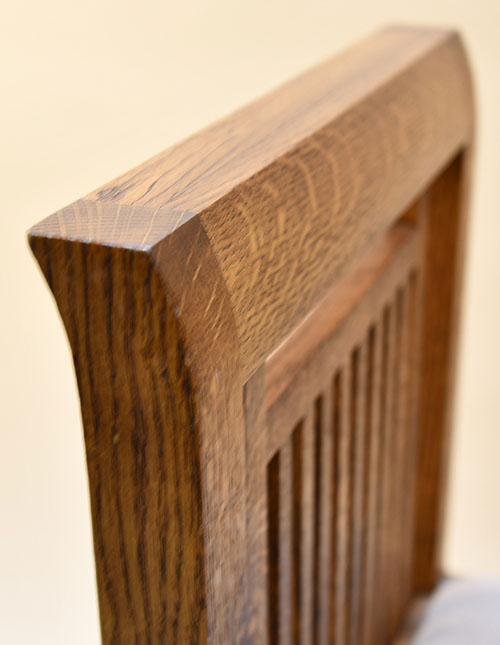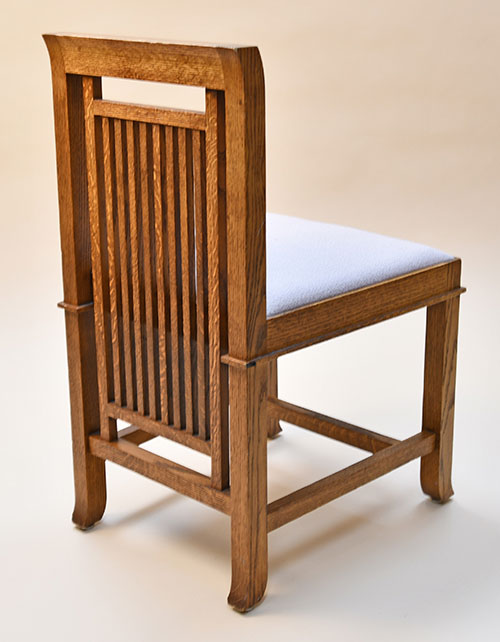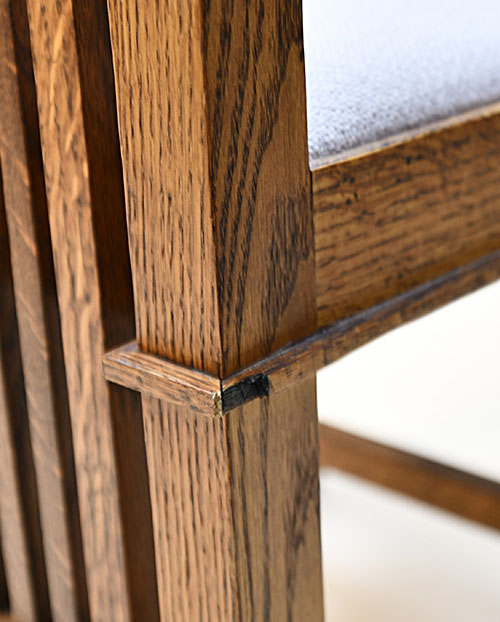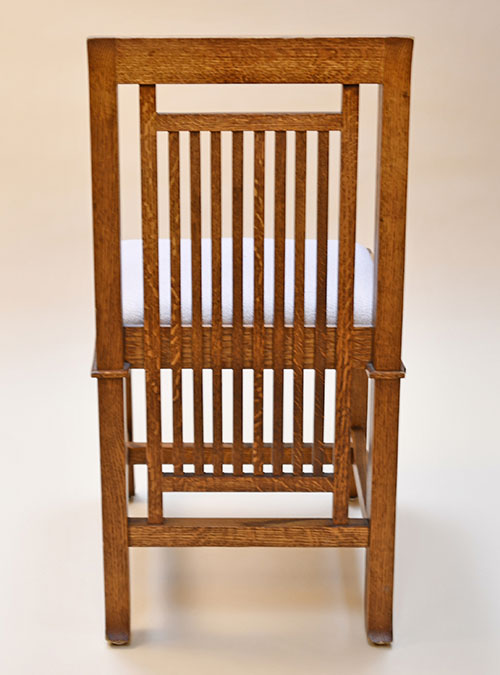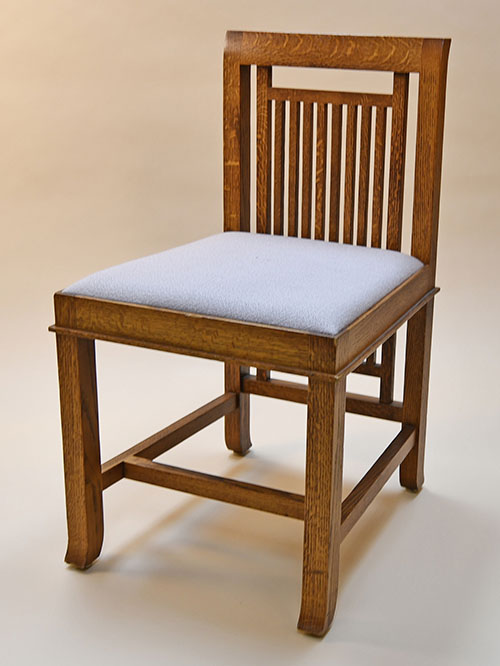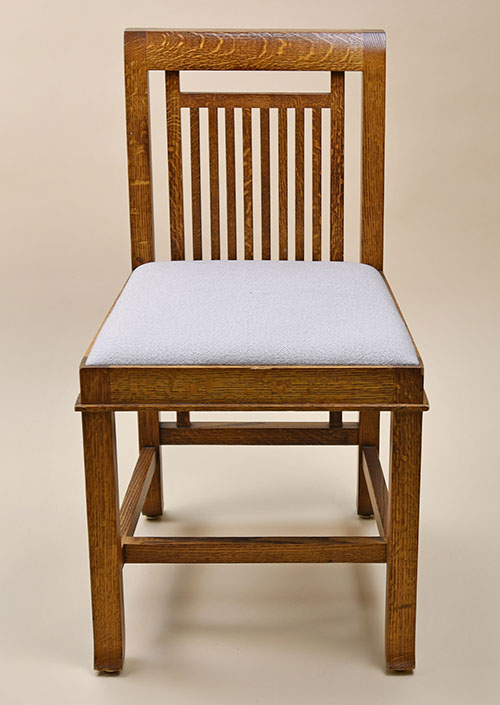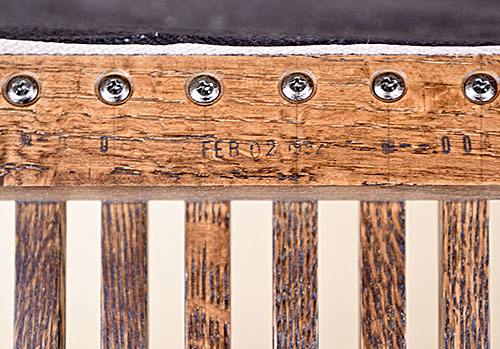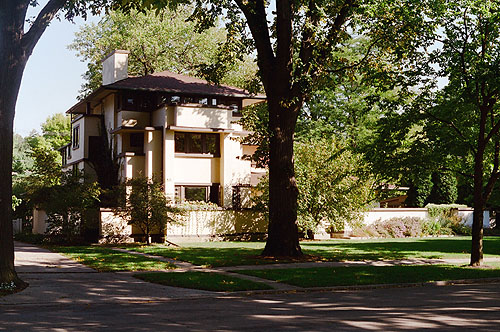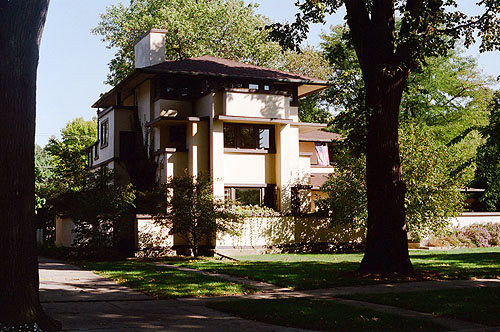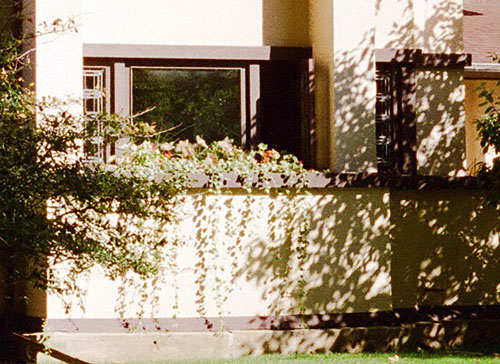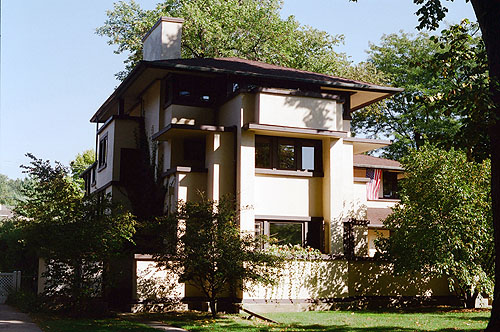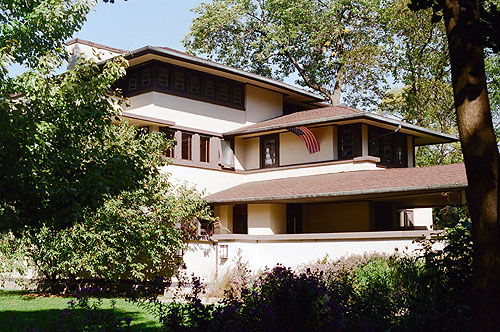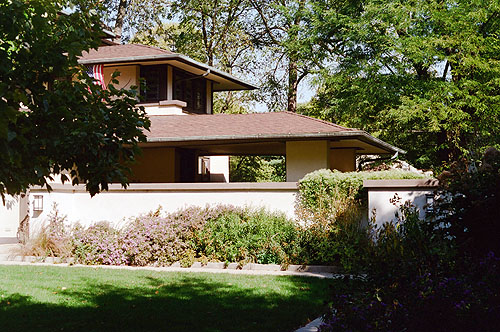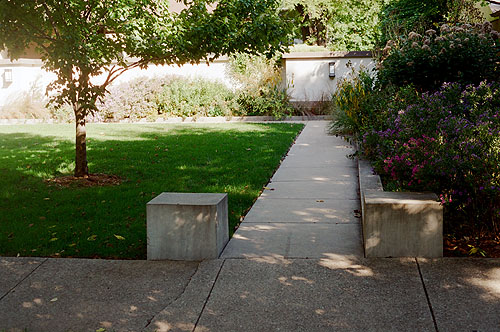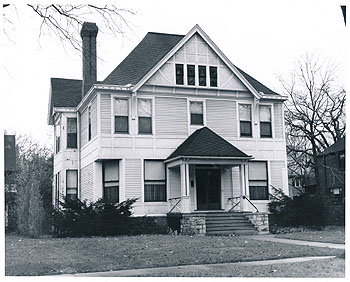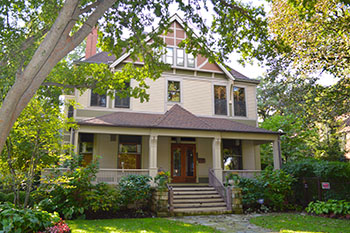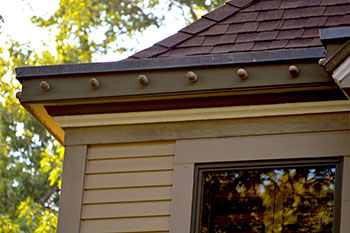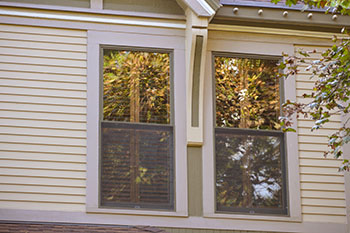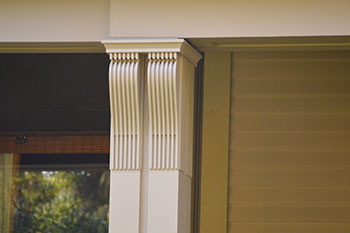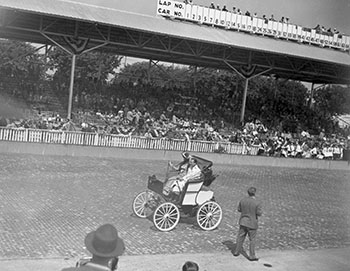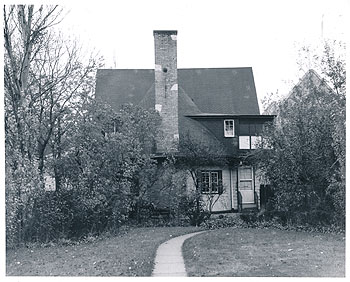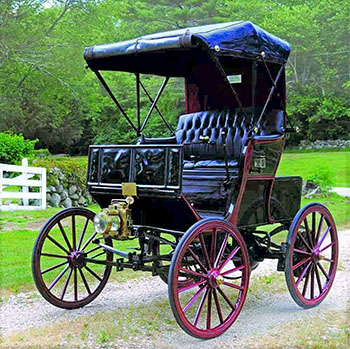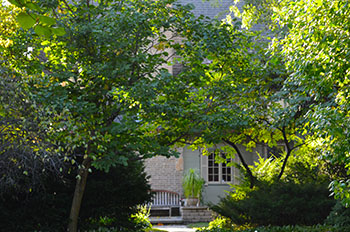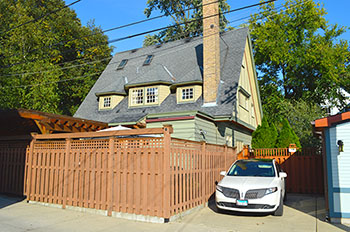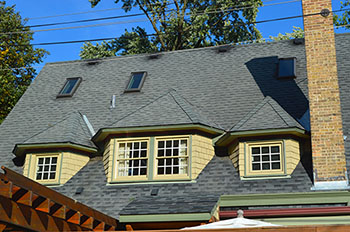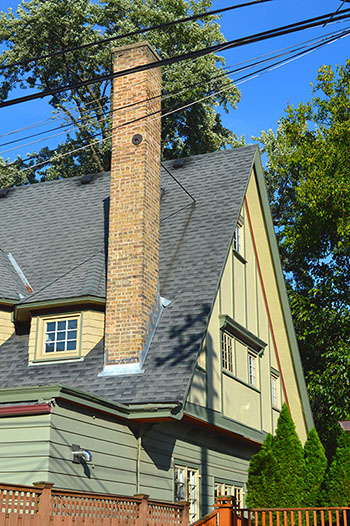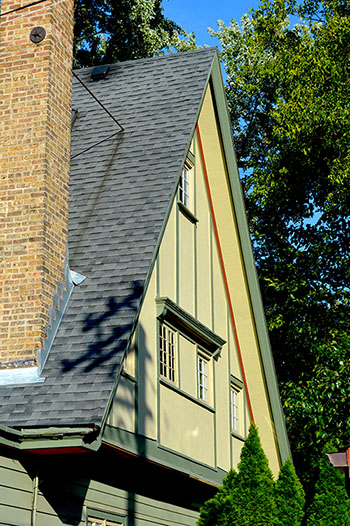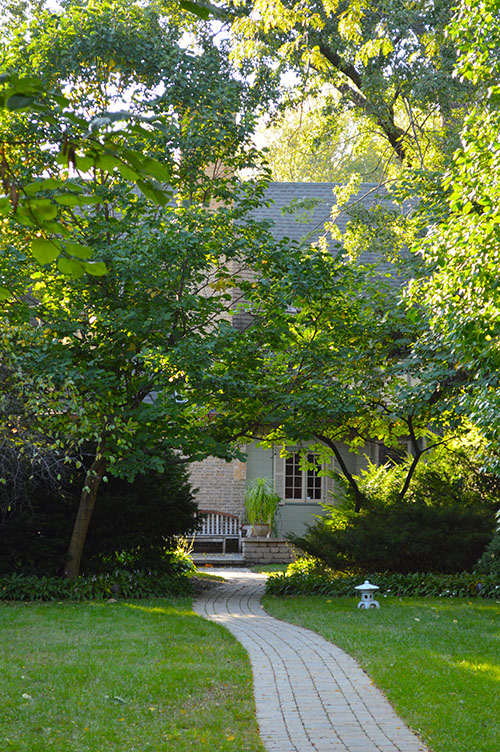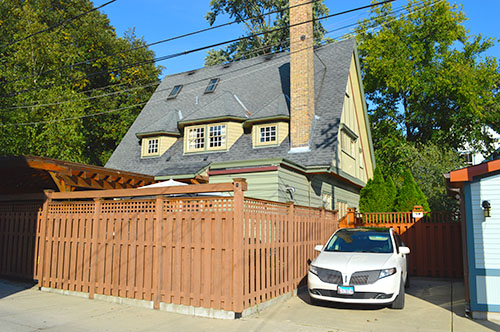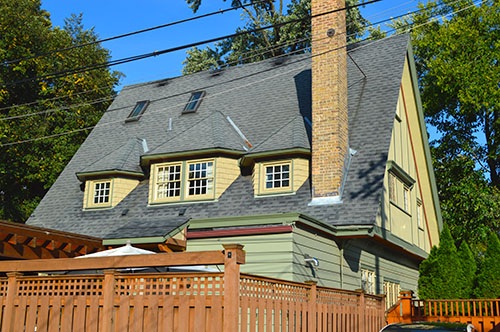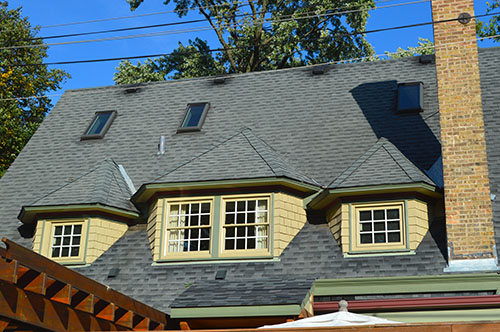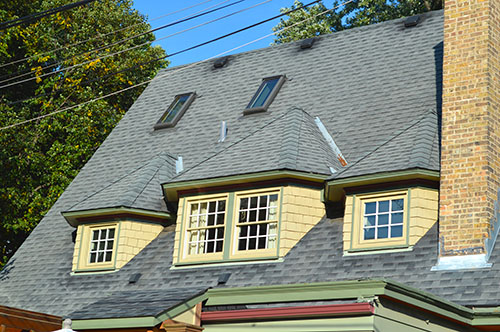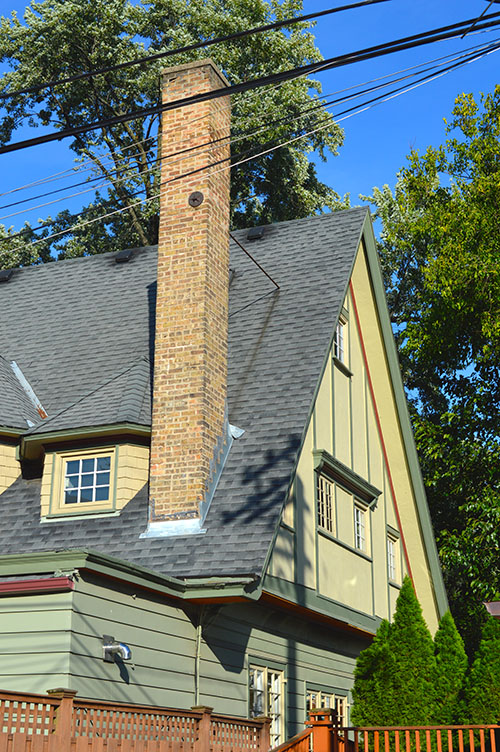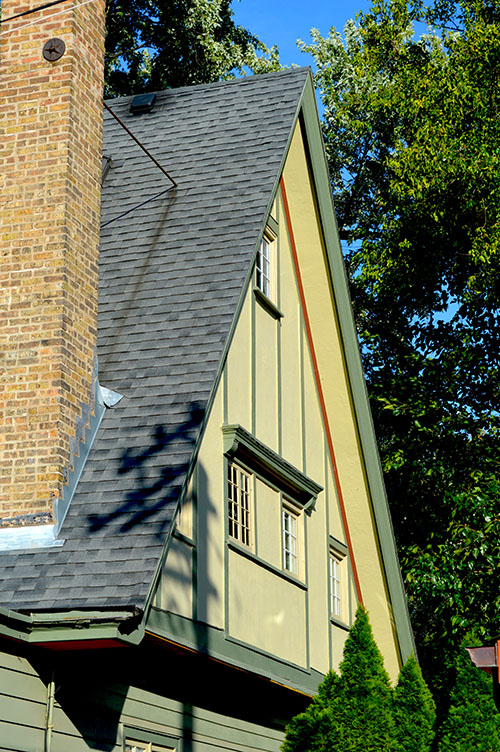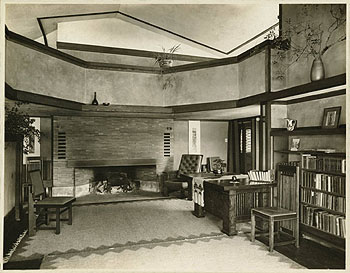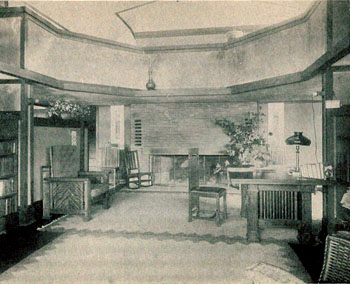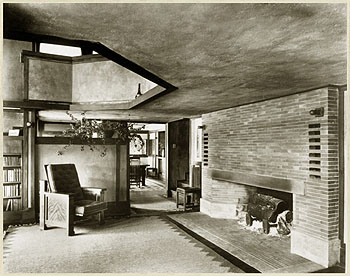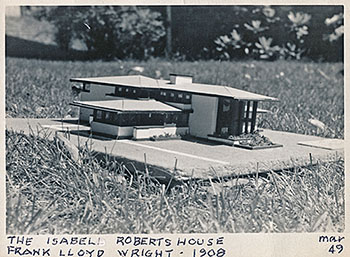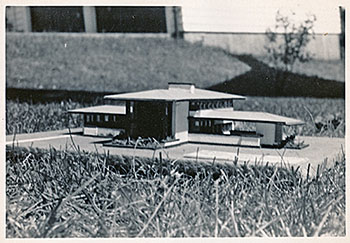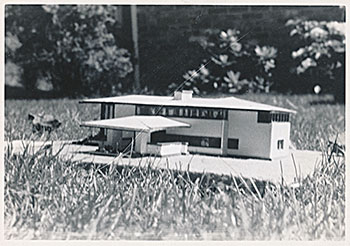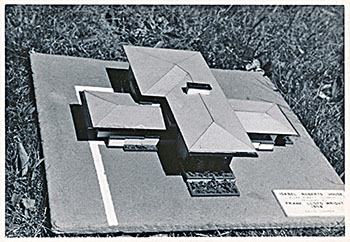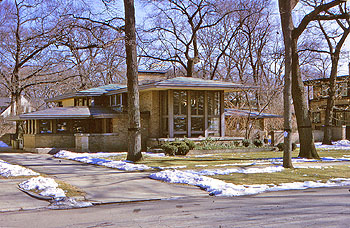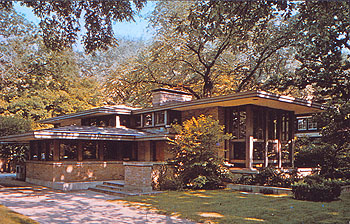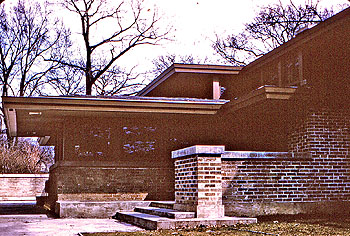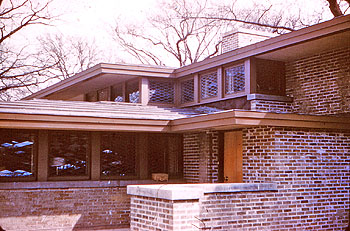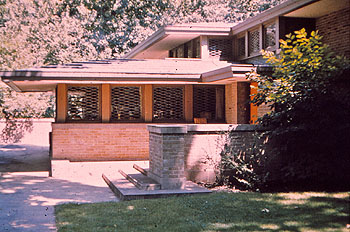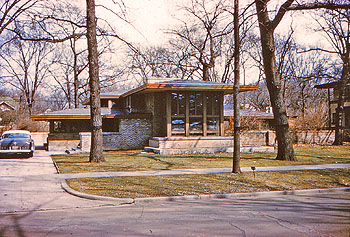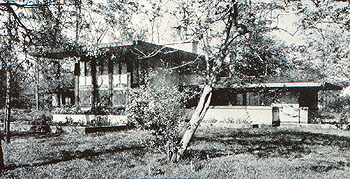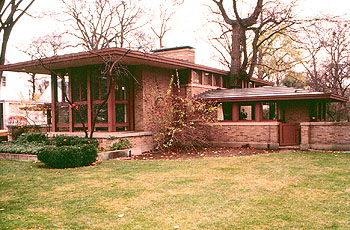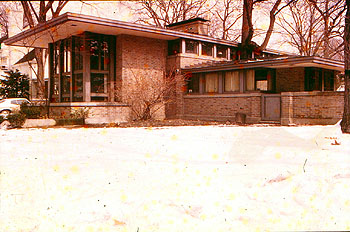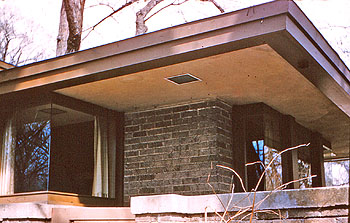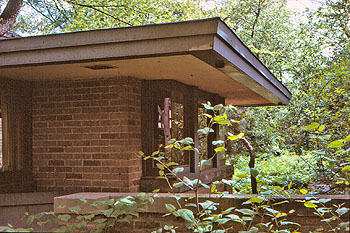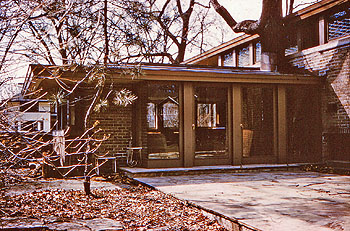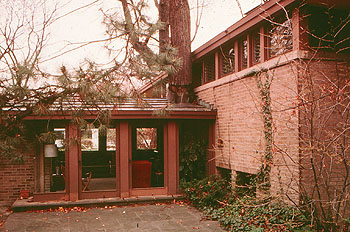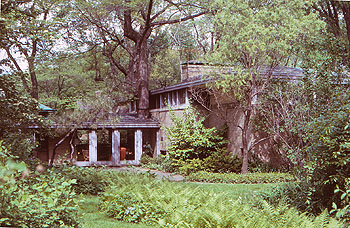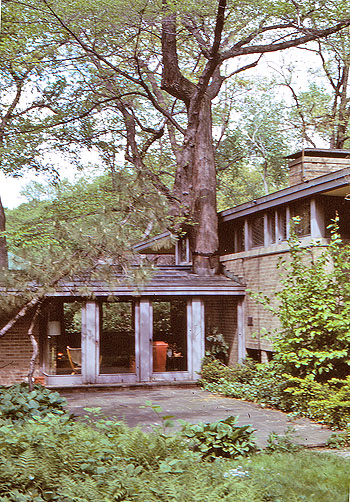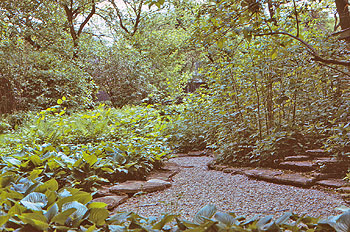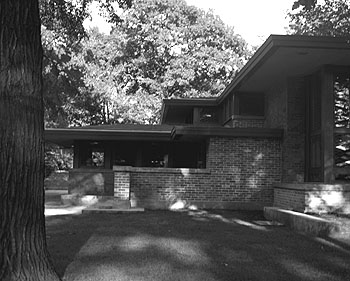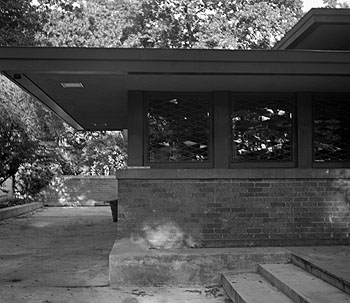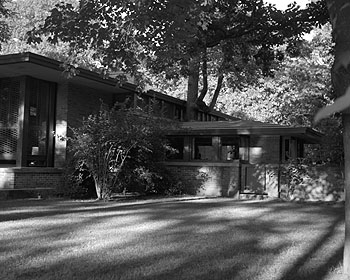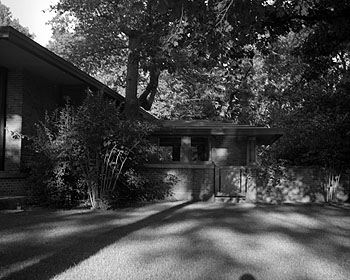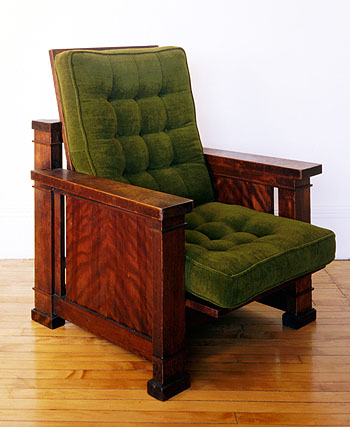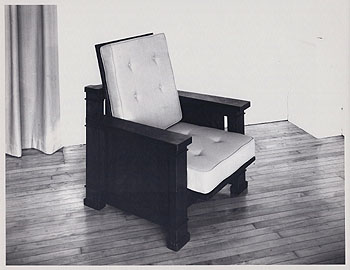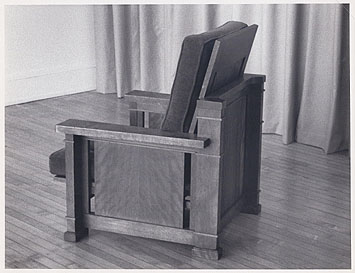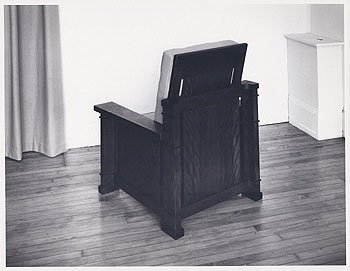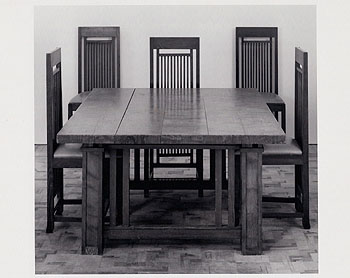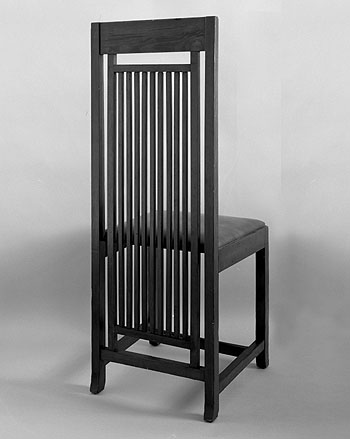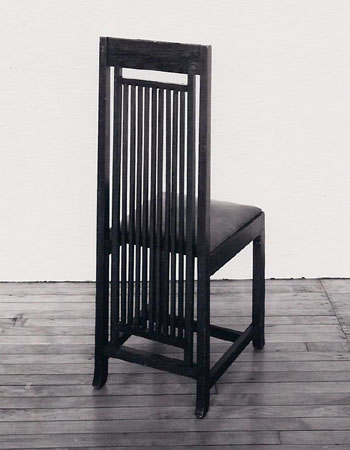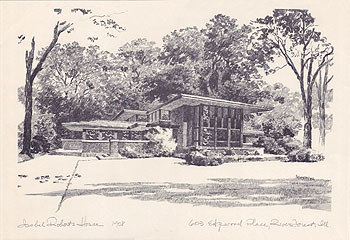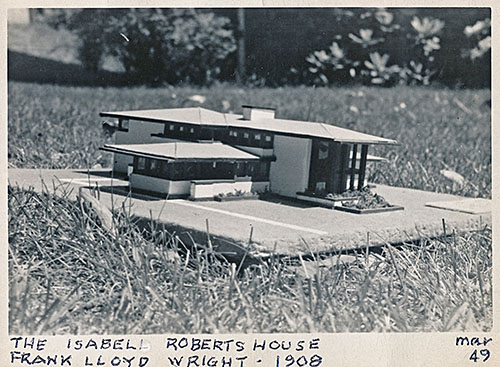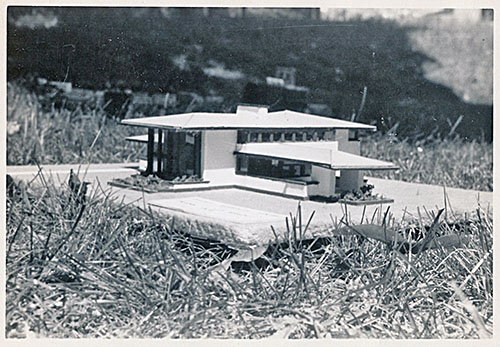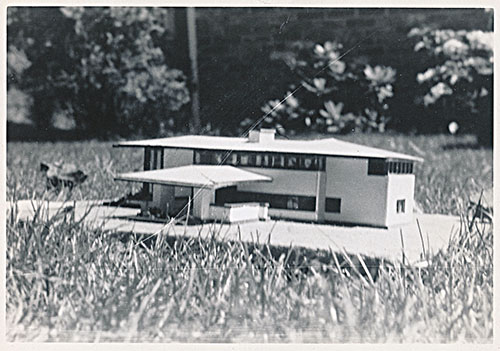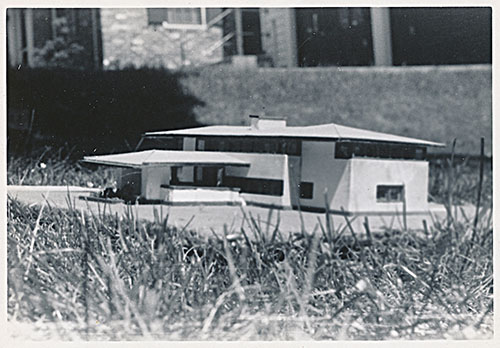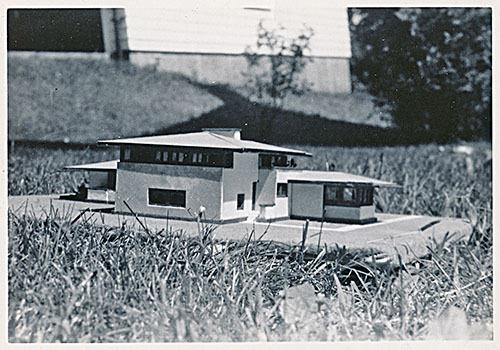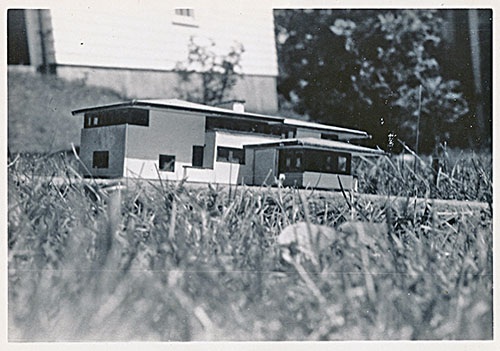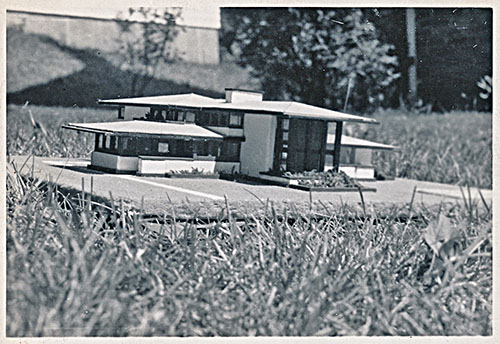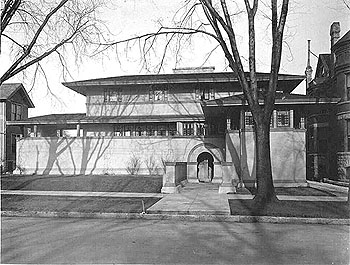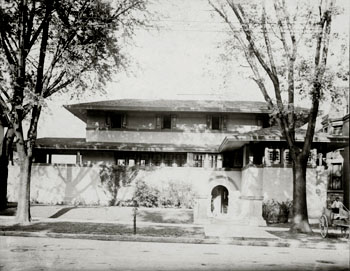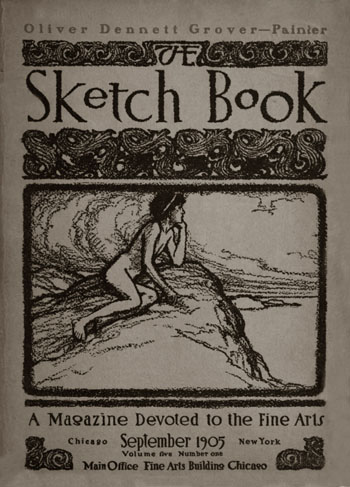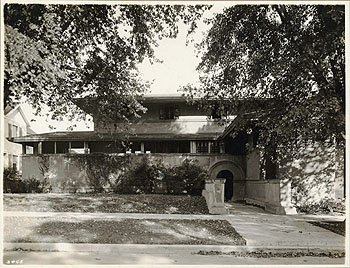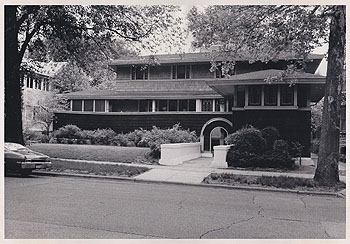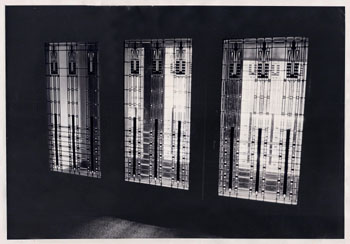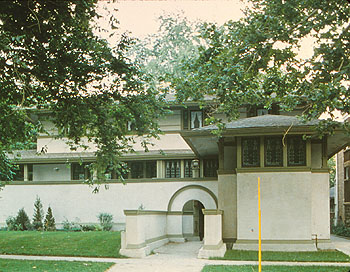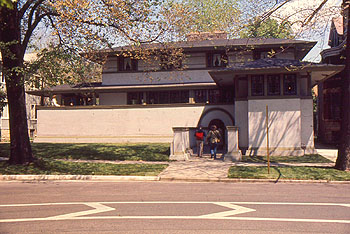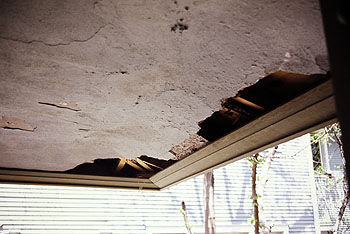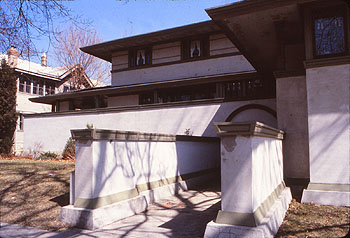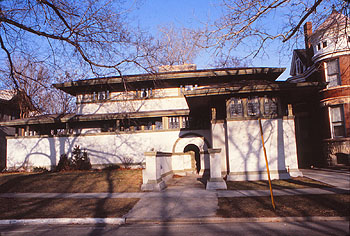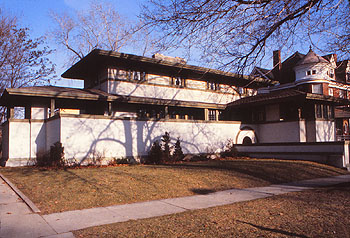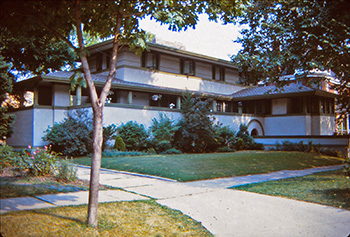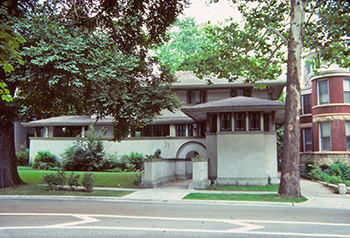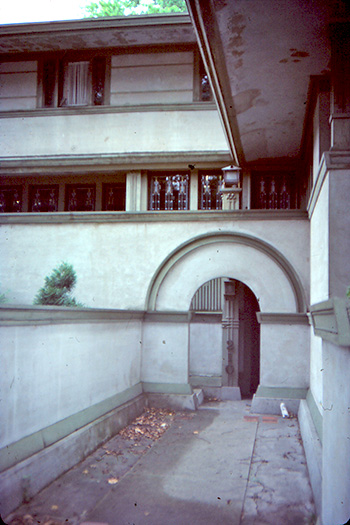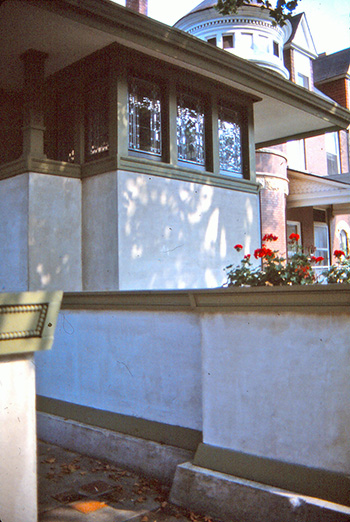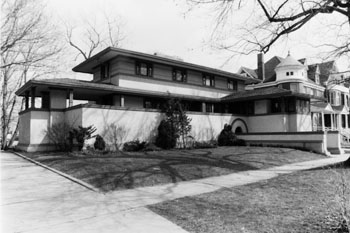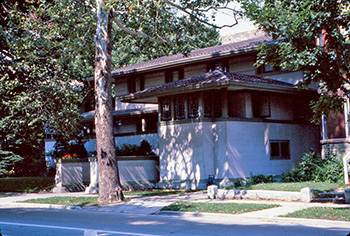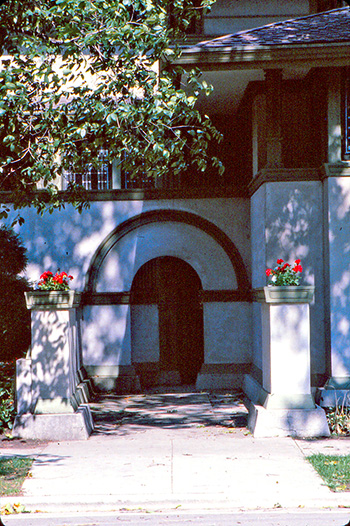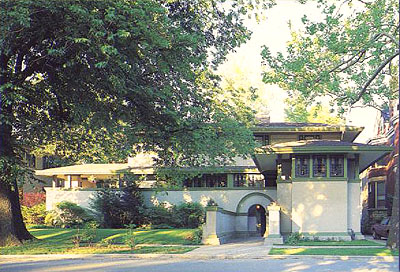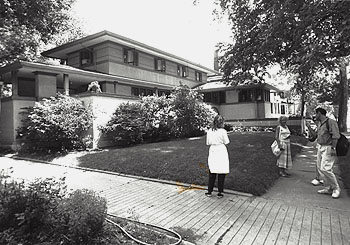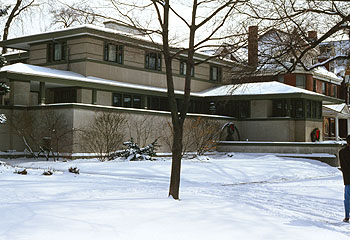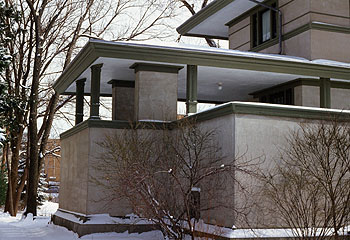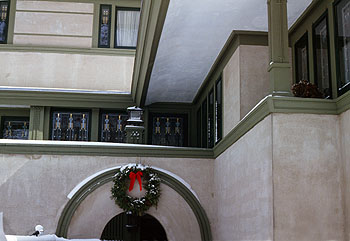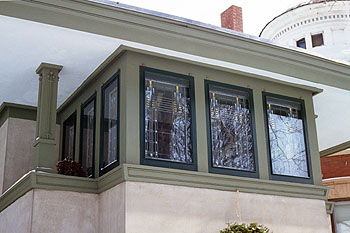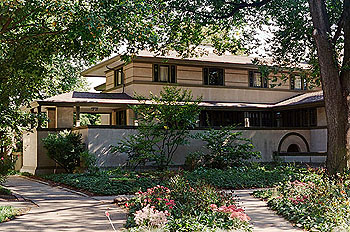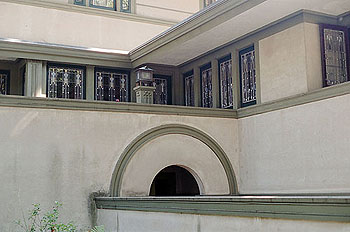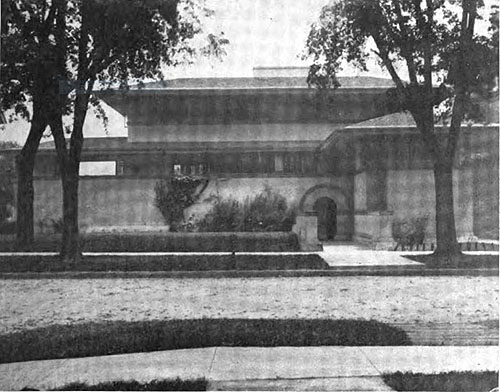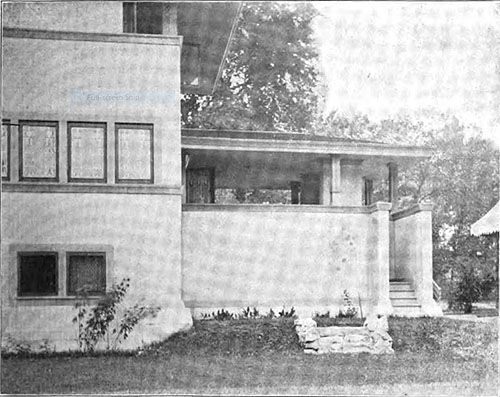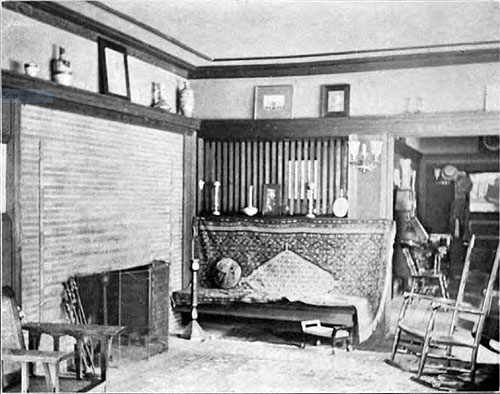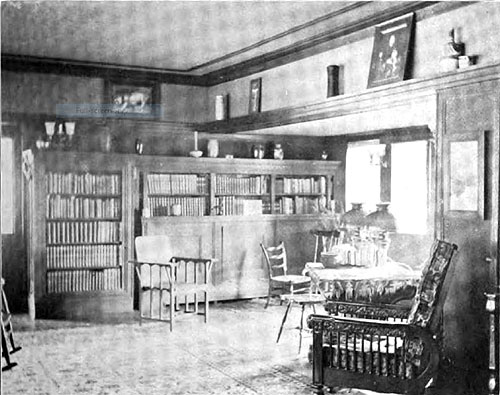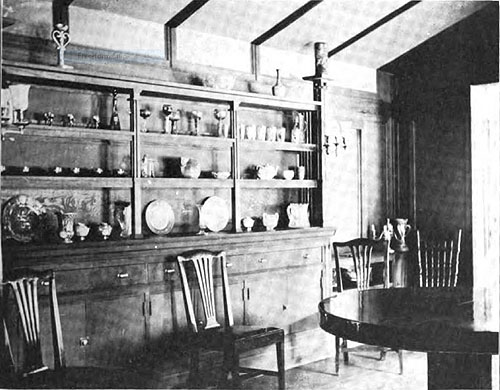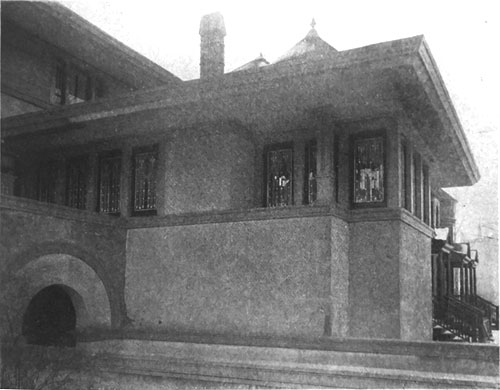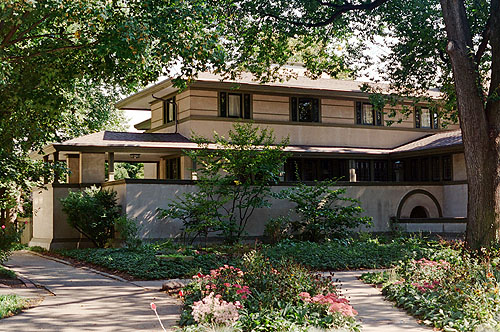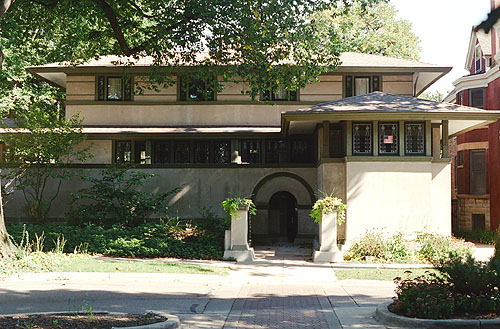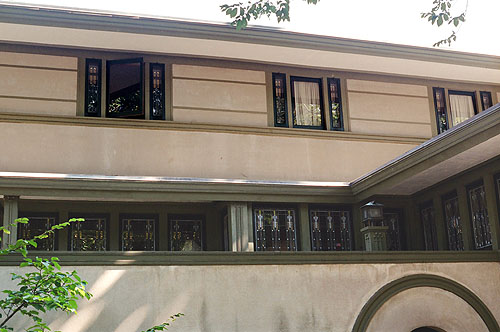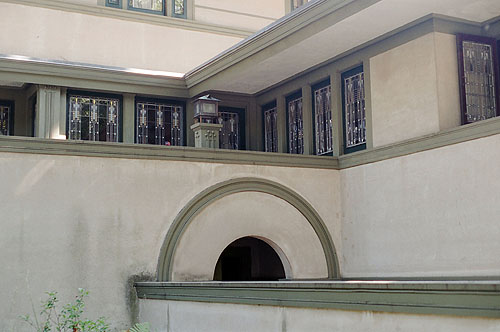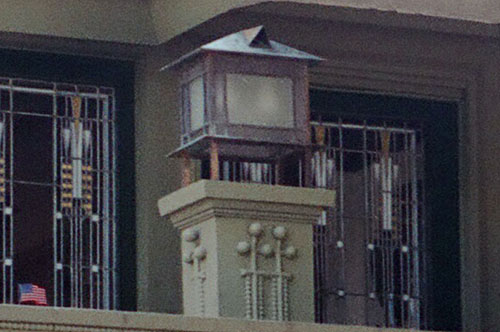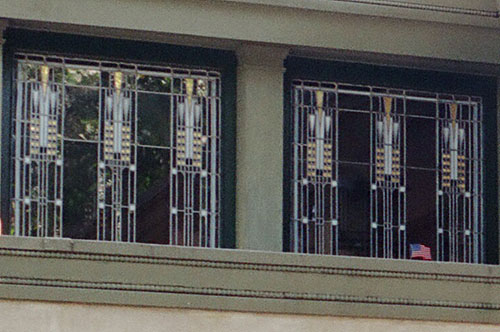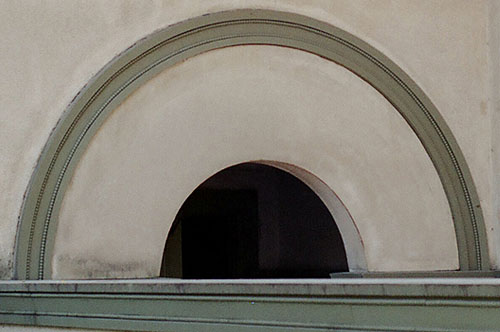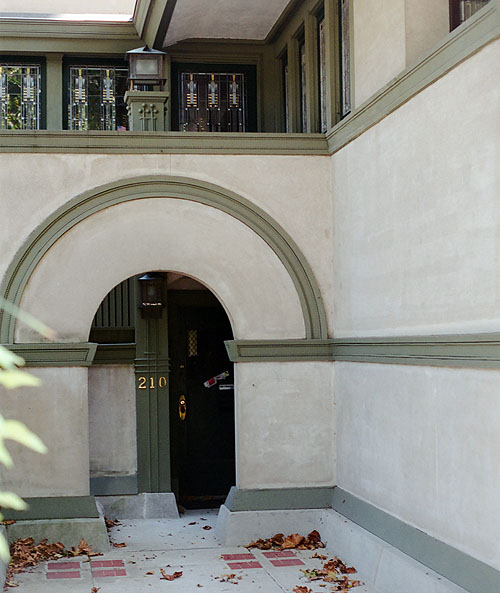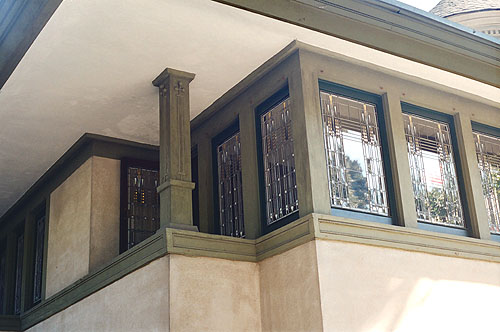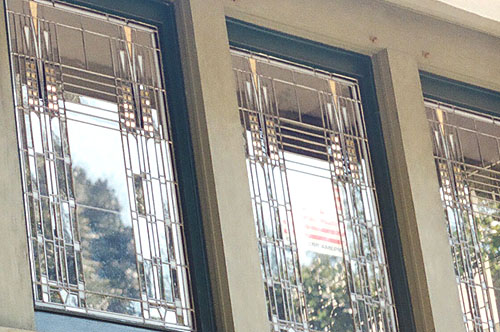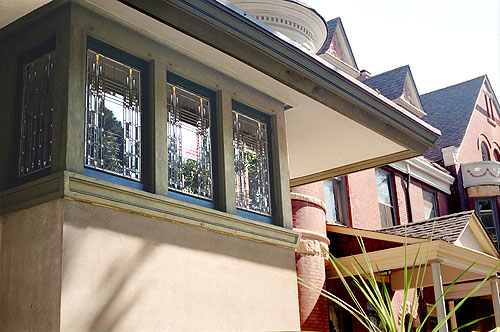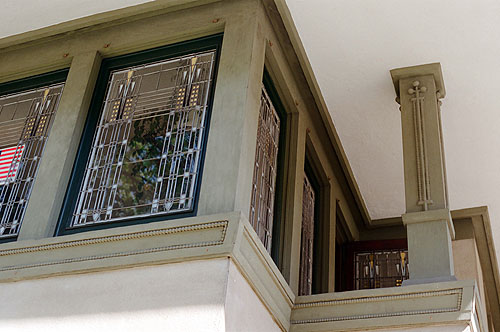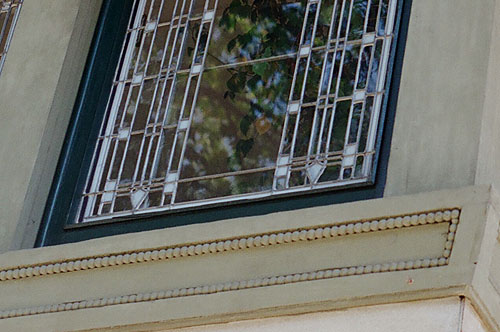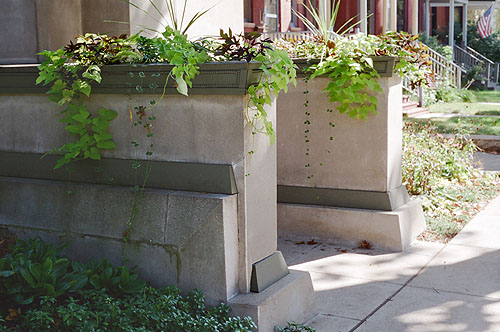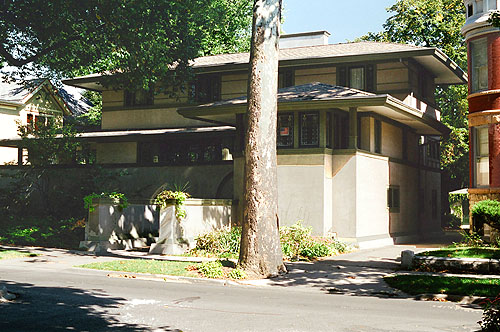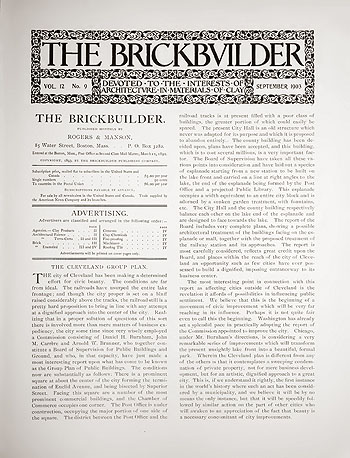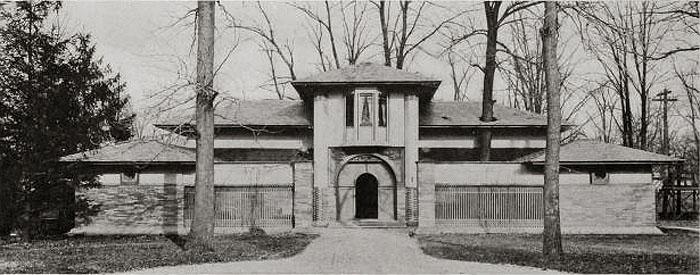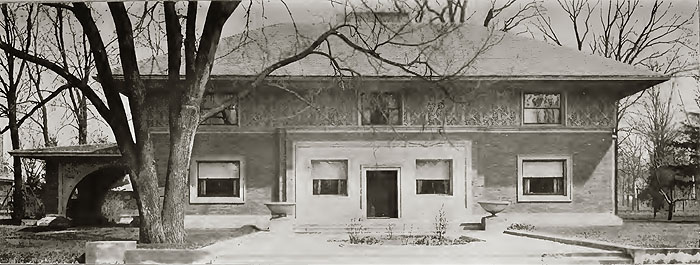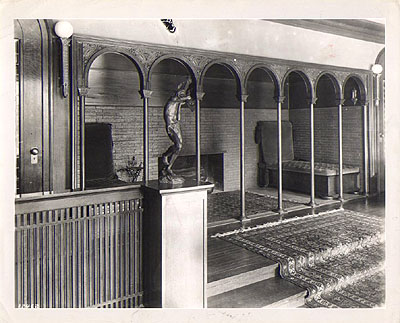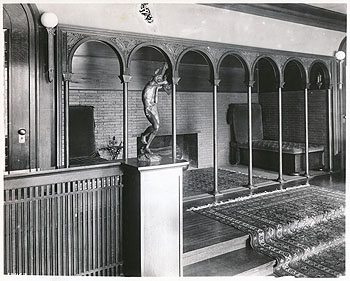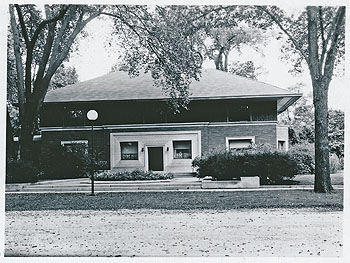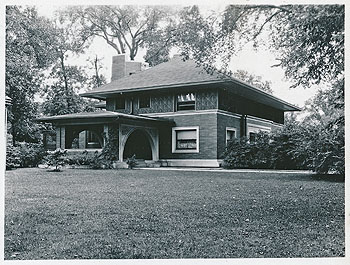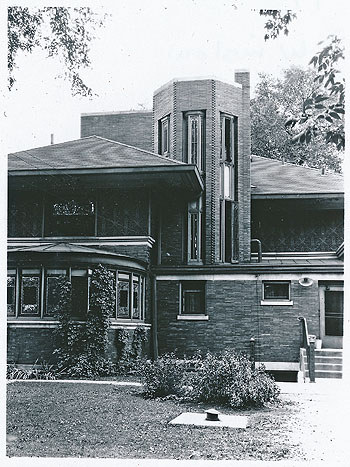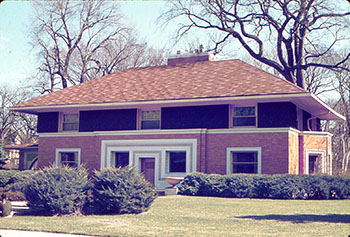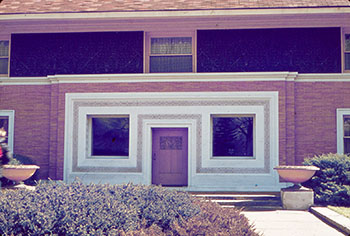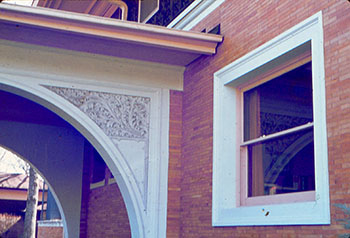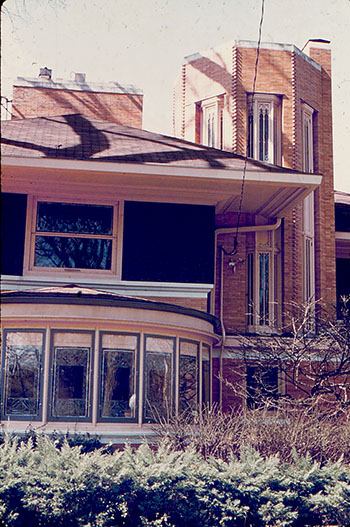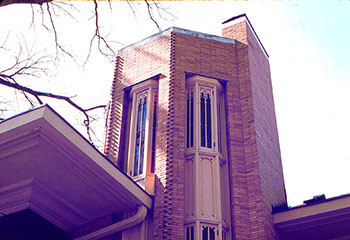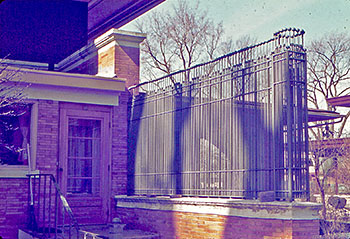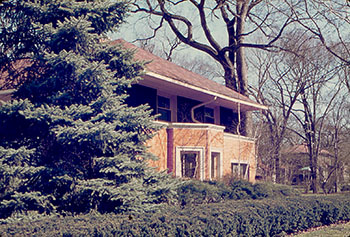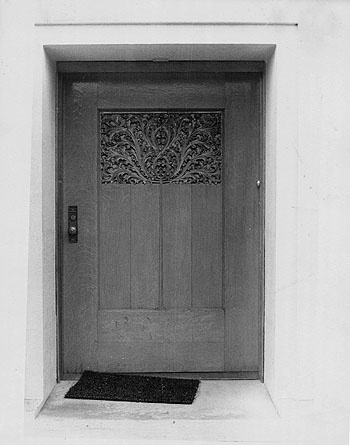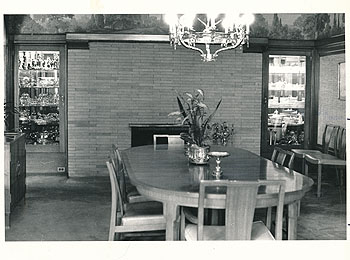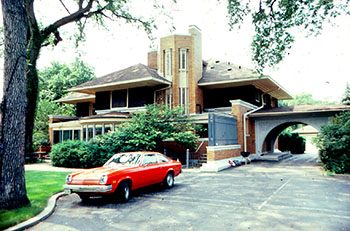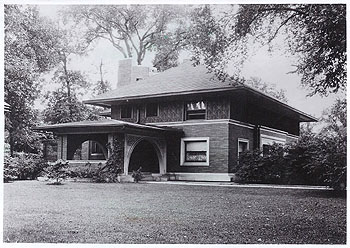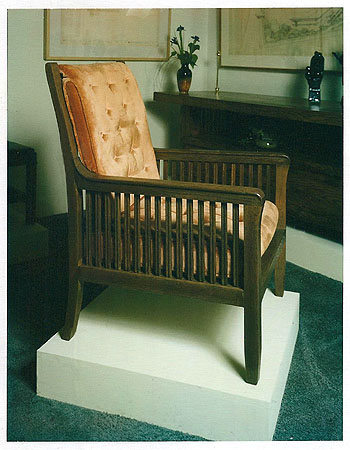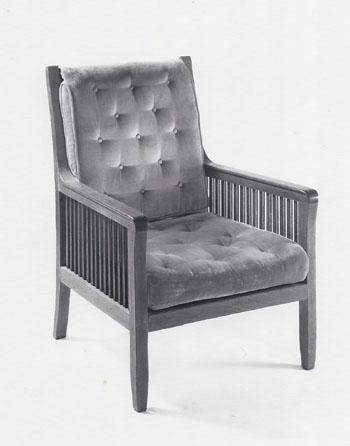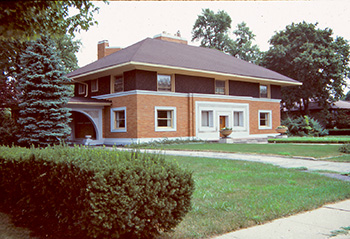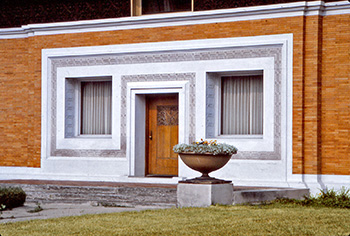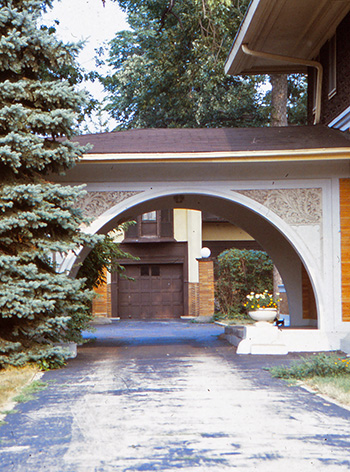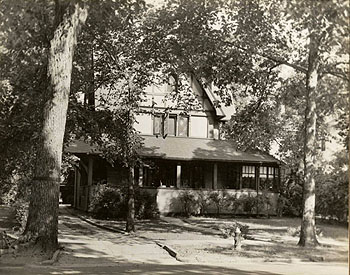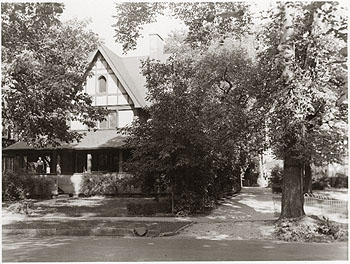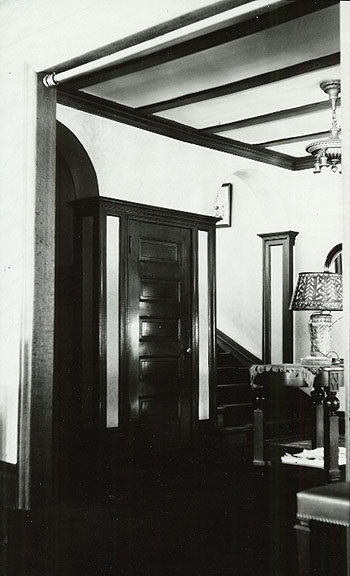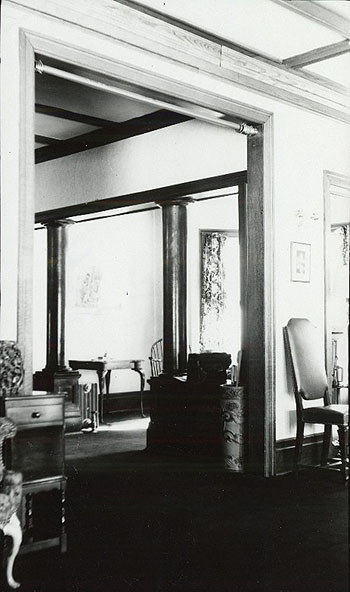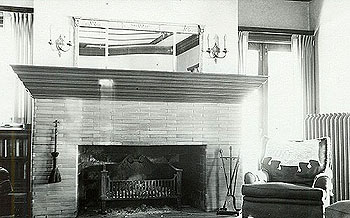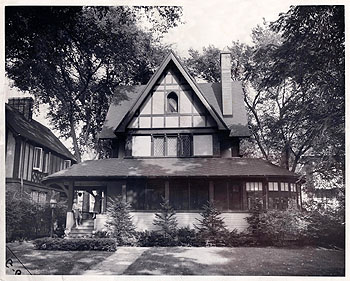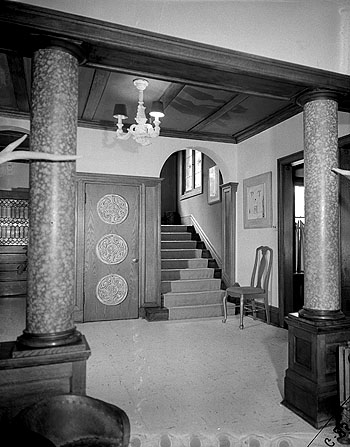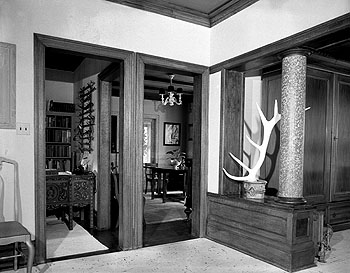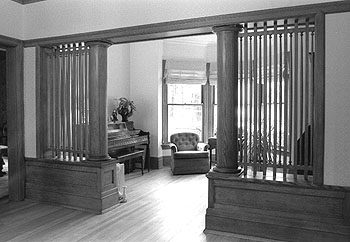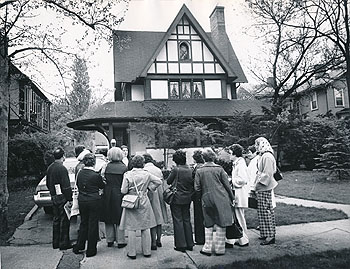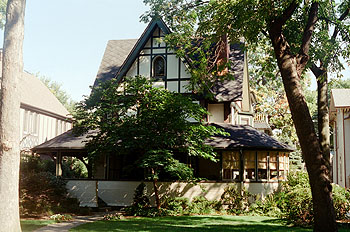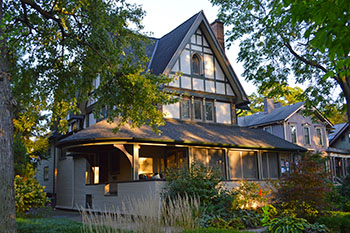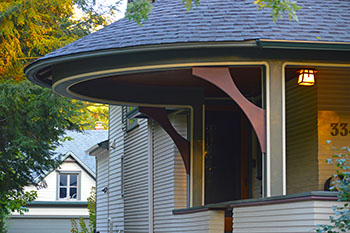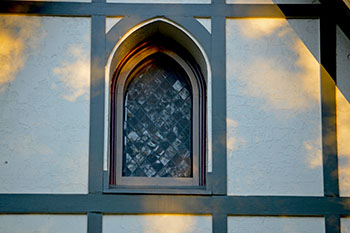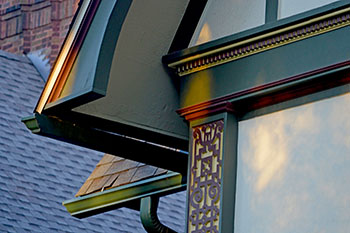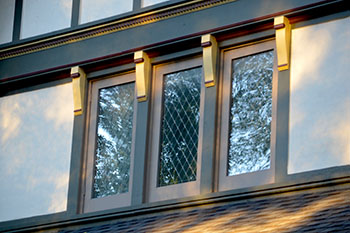
SUPPORT THE
WRIGHT LIBRARY
PROCEEDS FROM EVERY SALE GOES TO SUPPORT THE WRIGHT LIBRARY.
CLICK TO ORDER.
WE PROUDLY SUPPORT THE FRANK LLOYD WRIGHT FOUNDATION

WE PROUDLY SUPPORT THE FRANK LLOYD WRIGHT BUILDING CONSERVANCY
WE PROUDLY SUPPORT FALLINGWATER
AND THE WESTERN PENNSYLVANIA CONSERVANCY

OTHER WRIGHT HOMES & BUILDINGS Date: Circa 1990 Title: Packet of five postcards, Wright designed homes in Oak Park Circa 1990.
Description: Envelope is a yellow handmade Japanese paper (washi). Front of envelope: "Architecture of Frank Lloyd Wright (5). Houses in Oak Park - [A]." Inside: "Architectural renderings by Takashi Satoh. Frank Lloyd Wright Association (Japan). Seta 4-7-11-107, Setagaya, Tokyo 158 (phone 709-1305)." Five postcards with pen and ink hand drawn renderings of: A) Frank Lloyd Wright House & Studio (#3) B) Mrs. Thomas Gale House (#6) C) Frank Thomas House (#9) D) Nathan G. Moore House (#11) E) Edwin H. Cheney House (#20). Back: Map and list of 25 homes and buildings in Oak Park designed by Wright. Produced by the Frank Lloyd Wright Association, Japan. Note: This packet was given to Kathryn Smith by Masami Tanigawa in the early 1990s. Acquired from Kathryn Smith.
Size: Postcards 5.9 x 3.9. Packet 7.4 x 4.4
ST#: 1990.102.1113
A) Frank Lloyd Wright House & Studio (#3) B) Mrs. Thomas Gale House (#6) C) Frank Thomas House (#9) D) Nathan G. Moore House (#11) E) Edwin H. Cheney House (#20) Date: Circa 1990 Title: Packet of five postcards, Wright designed homes in Oak Park Circa 1990.
Description: Envelope is a red handmade Japanese paper (washi). Front of envelope: "Architecture of Frank Lloyd Wright (6). Houses in Oak Park - [B]." Inside: "Architectural renderings by Takashi Satoh. Frank Lloyd Wright Association (Japan). Seta 4-7-11-107, Setagaya, Tokyo 158 (phone 709-1305)." Five postcards with pen and ink hand drawn renderings of: A) Heurtley House (#5) B) Beachy House (#8) C) H. Adams House (#17) D) W. Martin House (#18) E) Fricke House (#22). Back: Map and list of 25 homes and buildings in Oak Park designed by Wright. Produced by the Frank Lloyd Wright Association, Japan. Note: This packet was given to Kathryn Smith by Masami Tanigawa in the early 1990s. Acquired from Kathryn Smith.
Size: Postcards 5.9 x 3.9. Packet 7.4 x 4.4.
ST#: 1990.103.1113
A) Heurtley House (#5) B) Beachy House (#8) C) H. Adams House (#17) D) W. Martin House (#18) E) Fricke House (#22) Date: 1996
Title: Prairie Houses Of Oak Park And River Forest (Published by The Great Frame Up , Oak Park.)
Description: Prairie Houses Of Oak Park And River Forest. Homes include: Harry S. Adams 1913. Roland Furbeck 1897. Edwin H. Cheney 1903. J. Kibben Ingalls 1909. Arthur B. Heurtley 1902. Chauncey Williams 1895. E. Arthur Davenport 1901. Frank Lloyd Wright, Home and Studio 1889 - 1911. Isabel Roberts 1908. Nathan Moore 1895/1923. William H. Winslow 1893. William G. Frick 1901. Frank W. Thomas 1901. Edward R. Hills / DeCaro 1906. Mrs. Thomas H. Gail, 1909. Frank Lloyd Wright.
Text bottom right: Concept by Barry H. Glustoff, Photography by Charles Huebner, Design by Fairfax Hutter Copyright Door Center Publishing, 1996.
Size: 22 x 32
ST#: 1996.105.1225Date: 2006
Title: Hometown Architect. The Complete Buildings of Frank Lloyd Wright' in Oak Park and River Forest, Illinois (Hard Cover DJ) (Published by Pomegranite Communications, Inc., Petaluma, CA. Published in cooperation with the Frank Lloyd Wright Preservation Trust, )
Author: Cannon, Patrick F.
Description: "Hometown Architect presents twenty-seven Wright homes, and Unity Temple, documenting one of the architects most influential periods of his career. The last chapter surveys eight lost, altered, and possibly Wright homes. More than ninety photographs of the buildings exteriors and interiors are accompanied by descriptive captions, while introductory text to each chapter details the story behind each commission, addressing Wrights relationships with his clients, the importance of each building in Wrights oeuvre, and the characteristics that make each house unique. The endpapers of this book feature a map locating all the sites discussed." (From dust jacket.) Original list price $35.00. (First Edition)
Size: 9 x 9
Pages: Pp 144
ST#: 2006.56.0317Date: 2007
Title: Oak Park illustration by Patrick E. Hilton. Circa 2007.
Description: Frank Lloyd Wright Historic District, Oak Park, Illinois. Compilation of nine illustrations of Frank Lloyd Wright designed homes in Oak Park. Illustrations include: Home & Studio (3), Hills, Beachy, Thomas, Gale, Moore and Heurtley. Signed in pencil by Patrick E. Hilton. Original list price $26.00.
Size: 8 x 10 B&W illustration.
ST#: 2007.90.1018
HARRY S. ADAMS RESIDENCE (1913 - S.179) Date: Circa 1914 Title: Harry S. Adams Residence (1913 - S.179)
Description: Wright's first proposal was more extensive than the finished project, and was dated September 4, 1912. Wright's second proposal was dated May 31, 1913. Both were rejected as too elaborate, and the third scaled down proposal was one of Wright's last prairie homes to be completed. 710 Augusta Blvd., Oak Park. Viewed from across the street. Photographed by Henry Fuermann.
Size: Original 10 x 6.75 B&W photograph.
S#: 0124.16.0112
Date: 1972
Title: Harry S. Adams Residence, 1972 (1913 - S.179).
Description: Viewed from the Southeast. The Adams House exemplifies Wright's Prairie styled design. Constructed of brick, it includes broad overhanging eves, horizontal rows of windows, and a dominate horizontal line that incorporates the second story window sills and completely encircles the house. The Porte Cochere is on the far left. Just to the right, the Veranda appears to be enclosed. The Living Room is just to the left of the Entrance, the Dining Room is on the right. Bedrooms are on the upper level. Stamped on verso: "Jan 7 1972. W. Loewe." Label pasted to verso: "Oak Park Village board adopted a resolution calling for an historic district to preserve examples of the so-called Prairie school of Architecture developed by Frank Lloyd Wright. 710 Augusta Blvd, Oak Park." Photographed in the winter by W. Loewe.
Size: Original 9.5 x 7.25 B&W photograph.
S#: 1909.50.1116Date: 1975 Title: Harry S. Adams Residence (1913 - S.179)
Description: Wright's first proposal was more extensive than the finished project, and was dated September 4, 1912. Wright's second proposal was dated May 31, 1913. Both were rejected as too elaborate, and the third scaled down proposal was one of Wright's last prairie homes to be completed. Stamped on verso: "Apr 14, 1975. Chicago Tribune. Photo by Hardy Wieting." Clipping pasted to verso: "Distinctive Frank Lloyd Wright homes in Oak Park slated for restoration include the Gale house and Adams house. Tribune Photos by Hardy Wieting." Acquired from the archives of the Chicago Tribune.
Size: Original 10 x 6.75 B&W photograph.
S#: 1996.12.0112
Date: 1975 Title: Harry S. Adams Residence (1913 - S.179) 1975.
Description: Wright's first proposal was more extensive than the finished project, and was dated September 4, 1912. Wright's second proposal was dated May 31, 1913. Both were rejected as too elaborate, and the third scaled down proposal was one of Wright's last prairie homes to be completed. Stamped on verso: "Daily News. Sep 13, 1975." Clipping pasted to verso: "Mrs. Harold Blumenthal stands in front of the original buffet designed by Frank Lloyd Wright for her home, the Adams House, 710 Augusta, Oak Park. Daily News Photo / Donald Bierman." Photographed by Donald Bierman. Acquired from the archives of the Chicago Daily News.
Size: Original 9.2 x 6.4 B&W photograph.
S#: 1996.16.0312
C) H. Adams House (#17) Date: 1980
Title: Harry S. Adams Residence, Oak Park 1980 (1913 - S.179).
Description: View of the Adams Residence from the Southwest.
Size: Frank Lloyd Wright designed the Adams Residence in 1913. Text stamped on sleeve: "21. Apr 80 C14." Original 35mm Ektachrome slide transparency and high res 5" x 8" digital color image.
ST#: 1980.46.0419Date: Circa 1994
Title: 1) Harry S. Adams Residence, Oak Park, Illinois, Circa 1994 (1913 - S.179).
Description: Set of 12 - 35mm slides. Not Dated. View of the Front facade from the Southeast. Designed by Frank Lloyd Wright in 1913. Text on sleeve: "Mod: Arch: Am: Wright, F. L.: Oak Park, IL: Harry S. Adams Hou. Ext: From Southeast: 1913. Holy Cross. Radford 92US.586/96. 073316." Acquired from the archives of the University of Virginia.
Size: 35mm Color slide, sandwiched between glass, plastic mount.
ST#: 1994.126.0720Date: Circa 1994
Title: 2) Harry S. Adams Residence, Oak Park, Illinois, Circa 1994 (1913 - S.179).
Description: Set of 12 - 35mm slides. Not Dated. View of the Front facade from the Southwest. Designed by Frank Lloyd Wright in 1913. Text on sleeve: "Mod: Arch: Am: Wright, F. L.: Oak Park, IL: Res: Adams House . Ext: Gen. View: 1913. Creative Con. 10/94. 066283." Acquired from the archives of the University of Virginia.
Size: 35mm Color slide, sandwiched between glass, plastic mount.
ST#: 1994.123.0720Date: Circa 1994
Title: 3) Harry S. Adams Residence, Oak Park, Illinois, Circa 1994 (1913 - S.179).
Description: Set of 12 - 35mm slides. Not Dated. View of the Front facade from the Southwest. Designed by Frank Lloyd Wright in 1913. Text on sleeve: "Mod: Arch: Am: Wright, F. L.: Oak Park, IL: Harry S. Adams H. Ext: From South: 1913. Holy Cross. Radford 92US.590/96. 073314." Acquired from the archives of the University of Virginia.
Size: 35mm Color slide, sandwiched between glass, plastic mount.
ST#: 1994.124.0720Date: Circa 1994
Title: 4) Harry S. Adams Residence, Oak Park, Illinois, Circa 1994 (1913 - S.179).
Description: Set of 12 - 35mm slides. Not Dated. View of the entrance. Designed by Frank Lloyd Wright in 1913. Text on sleeve: "Mod: Arch: Am: Wright, F. L.: Oak Park, IL: Res: Adams House . Ext: Det. Front: 1913. Creative Con. 7/94. 066280." Acquired from the archives of the University of Virginia.
Size: 35mm Color slide, sandwiched between glass, plastic mount.
ST#: 1994.120.0720Date: Circa 1994
Title: 5) Harry S. Adams Residence, Oak Park, Illinois, Circa 1994 (1913 - S.179).
Description: Set of 12 - 35mm slides. Not Dated. View of the Front Door. Designed by Frank Lloyd Wright in 1913. Text on sleeve: "Mod: Arch: Am: Wright, F. L.: Oak Park, IL: Res: Adams House . Ext: Det. Front Door: 1913. Creative Con. 8/94. 066281." Acquired from the archives of the University of Virginia.
Size: 35mm Color slide, sandwiched between glass, plastic mount.
ST#: 1994.121.0720Date: Circa 1994
Title: 6) Harry S. Adams Residence, Oak Park, Illinois, Circa 1994 (1913 - S.179).
Description: Set of 12 - 35mm slides. Not Dated. Detail view of the Front Door. Designed by Frank Lloyd Wright in 1913. Text on sleeve: "Mod: Arch: Am: Wright, F. L.: Oak Park, IL: Res: Adams House . Ext: Det. Leaded Wind: 1913. Creative Con. 9/94. 066282." Acquired from the archives of the University of Virginia.
Size: 35mm Color slide, sandwiched between glass, plastic mount.
ST#: 1994.122.0720Date: Circa 1994
Title: 7) Harry S. Adams Residence, Oak Park, Illinois, Circa 1994 (1913 - S.179).
Description: Set of 12 - 35mm slides. Not Dated. View of the Front facade from the Southwest. Designed by Frank Lloyd Wright in 1913. Text on sleeve: "Mod: Arch: Am: Wright, F. L.: Oak Park, IL: Harry S. Adams H. Ext: From Southwest: 1913. Holy Cross. Radford 92US.589/96. 073315." Acquired from the archives of the University of Virginia.
Size: 35mm Color slide, sandwiched between glass, plastic mount.
ST#: 1994.125.0720Date: Circa 1994
Title: 8) Harry S. Adams Residence, Oak Park, Illinois, Circa 1994 (1913 - S.179).
Description: Set of 12 - 35mm slides. Not Dated. View of the front facade from the Southeast. Designed by Frank Lloyd Wright in 1913. Text on sleeve: "Mod: Arch: Am: Wright, F. L.: Oak Park, IL: Res: Adams House . Ext: Det. Windows: 1913. Creative Con. 5/94. 066278." Acquired from the archives of the University of Virginia.
Size: 35mm Color slide, sandwiched between glass, plastic mount.
ST#: 1994.118.0720Date: Circa 1994
Title: 9) Harry S. Adams Residence, Oak Park, Illinois, Circa 1994 (1913 - S.179).
Description: Set of 12 - 35mm slides. Not Dated. Detail view of the cellar windows. Designed by Frank Lloyd Wright in 1913. Text on sleeve: "Mod: Arch: Am: Wright, F. L.: Oak Park, IL: Res: Adams House . Ext: Det. Cellar Wind: 1913. Creative Con. 6/94. 066279." Acquired from the archives of the University of Virginia.
Size: 35mm Color slide, sandwiched between glass, plastic mount.
ST#: 1994.119.0720Date: Circa 1994
Title: 10) Harry S. Adams Residence, Oak Park, Illinois, Circa 1994 (1913 - S.179).
Description: Set of 12 - 35mm slides. Not Dated. View of the rear of the house from the Northwest. Designed by Frank Lloyd Wright in 1913. Text on sleeve: "Mod: Arch: Am: Wright, F. L.: Oak Park, IL: Res: Adams House . Ext: Det. Rear/Chimney: 1913. Creative Con. 2/94. 066275." Acquired from the archives of the University of Virginia.
Size: 35mm Color slide, sandwiched between glass, plastic mount.
ST#: 1994.115.0720Date: Circa 1994
Title: 11) Harry S. Adams Residence, Oak Park, Illinois, Circa 1994 (1913 - S.179).
Description: Set of 12 - 35mm slides. Not Dated. View of the Living Room Fireplace. Designed by Frank Lloyd Wright in 1913. Text on sleeve: "Mod: Arch: Am: Wright, F. L.: Oak Park, IL: Res: Adams House . Int: Det. Fireplace: 1913. Creative Con. 3/94. 066276." Acquired from the archives of the University of Virginia.
Size: 35mm Color slide, sandwiched between glass, plastic mount.
ST#: 1994.116.0720Date: Circa 1994
Title: 12) Harry S. Adams Residence, Oak Park, Illinois, Circa 1994 (1913 - S.179).
Description: Set of 12 - 35mm slides. Not Dated. View from the enclosed veranda, dining room sideboard can be seen in the background. Designed by Frank Lloyd Wright in 1913. Text on sleeve: "Mod: Arch: Am: Wright, F. L.: Oak Park, IL: Res: Adams House . Int: Det: 1913. Creative Con. 4/94. 066277." Acquired from the archives of the University of Virginia.
Size: 35mm Color slide, sandwiched between glass, plastic mount.
ST#: 1994.117.0720Date: 2002
Title: Harry S. Adams Residence, 2002 (1913 - S.179).
Description: 1) Harry S. Adams was the Chicago manager of Eaton, Crane and Pike, manufacturers of fine writing paper. Frank Lloyd Wright's first design dated September 4, 1912, was rejected, as was Wright's second proposal dated May 31, 1913. Both were rejected as too elaborate. The third was scaled down and accepted by Adams. The Porte Cochere is on the far left. Just to the right, the Veranda appears to be enclosed. The Living Room is just to the left of the Entrance, the Dining Room is on the right. Bedrooms are on the upper level. This was the final home Wright would design for Oak Park. Set of eight Photographed by Douglas M. Steiner in September 2002.
Size: 35mm slides and 14" x 9" high res digital image
ST#: 2002.119.1216-1Date: 2002
Title: Harry S. Adams Residence, 2002 (1913 - S.179).
Description: 2) Frank Lloyd Wright's first design dated September 4, 1912, was rejected, as was Wright's second proposal dated May 31, 1913. Both were rejected as too elaborate. The third was scaled down and accepted by Adams. Covering the width of almost three Chicago city lots, the Adams House exemplifies Wright's Prairie styled design. Constructed of brick, it includes broad overhanging eves, horizontal rows of windows, and a dominate horizontal line that incorporates the second story window sills and completely encircles the house. The Porte Cochere is on the far left. Set of eight Photographed by Douglas M. Steiner in September 2002.
Size: 35mm slides and 14" x 9" high res digital image
ST#: 2002.119.1216-2Date: 2002
Title: Harry S. Adams Residence, 2002 (1913 - S.179).
Description: 3) Frank Lloyd Wright's first design dated September 4, 1912, was rejected, as was Wright's second proposal dated May 31, 1913. Both were rejected as too elaborate. The third was scaled down and accepted by Adams. Constructed of brick, it includes broad overhanging eves, horizontal rows of windows, and a dominate horizontal line that incorporates the second story window sills and completely encircles the house. The Living Room is just to the left of the Entrance, the Dining Room is on the right. Bedrooms are on the upper level. Set of eight Photographed by Douglas M. Steiner in September 2002.
Size: 35mm slides and 14" x 9" high res digital image
ST#: 2002.119.1216-3Date: 2002
Title: Harry S. Adams Residence, 2002 (1913 - S.179).
Description: 4) The Entrance is graced with a short horizontal Prairie styled vase, very similar in style to the Robie House vase. Originally there was a matching vase just to the right of the Porte Cochere. Set of eight Photographed by Douglas M. Steiner in September 2002.
Size: 35mm slides and 14" x 9" high res digital image
ST#: 2002.119.1216-4Date: 2002
Title: Harry S. Adams Residence, 2002 (1913 - S.179).
Description: 5) Covering the width of almost three Chicago city lots, the Adams House exemplifies Wright's Prairie styled design. Constructed of brick, it includes broad overhanging eves, horizontal rows of windows, and a dominate horizontal line that incorporates the second story window sills and completely encircles the house. The Living Room is just to the left of the Entrance, the Dining Room is on the right. Bedrooms are on the upper level. This was the final home Wright would design for Oak Park. Set of eight Photographed by Douglas M. Steiner in September 2002.
Size: 35mm slides and 14" x 9" high res digital image
ST#: 2002.119.1216-5Date: 2002
Title: Harry S. Adams Residence, 2002 (1913 - S.179).
Description: 6) Mature landscaping obscures many of the details that exemplify Frank Lloyd Wright's Prairie styled design. Set of eight Photographed by Douglas M. Steiner in September 2002.
Size: 35mm slides and 14" x 9" high res digital image
ST#: 2002.119.1216-6Date: 2002
Title: Harry S. Adams Residence, 2002 (1913 - S.179).
Description: 7) Constructed of brick, it includes broad overhanging eves, horizontal rows of windows, and a dominate horizontal line that incorporates the second story window sills and completely encircles the house. The Dining Room is on the right. Bedrooms are on the upper level. This was the final home Wright would design for Oak Park. Set of eight Photographed by Douglas M. Steiner in September 2002.
Size: 35mm slides and 14" x 9" high res digital image
ST#: 2002.119.1216-7Date: 2002
Title: Harry S. Adams Residence, 2002 (1913 - S.179).
Description: 8) Two geometric blocks anchors the sidewalk to the landscape and define the entrance to the property. Set of eight Photographed by Douglas M. Steiner in September 2002.
Size: 35mm slides and 14" x 9" high res digital image
ST#: 2002.119.1216-8OSCAR B. BALCH RESIDENCE (1911 - S.168) Date: Circa 1940
Title: Oscar B. Balch Residence Circa 1940 (1911 - S.168).
Description: Oscar B. Balch moved to Oak Park in 1890, where he joined the firm of A. W. and S. E. Pebbles. Balch became a partner, and the name was changed to Pebbles and Balch. In 1907, Wright remodel their shop. The partnership did not last long. In 1908, a year after the shop was remodeled, Balch left to form the Balch-Linder Shop with Augustinus Linder, coincidentally just across the street. Shortly after Wright's return from Europe, Balch called on Wright to design his home. Symmetrical in design, the Library in on the left, Living Room and Terrace in the center, Dining Room on the right. The entrance to the home is behind the Library on the left. Five bedrooms are upstairs. Photographed by Gilman Lane. Courtesy of the Art Institute of Chicago.
Size: 10 x 8 B&W photographs.
S#: 0531.62.1016Date: Circa 1949
Title: Oscar B. Balch Residence Circa 1949 (1911 - S.168).
Description: Oscar B. Balch moved to Oak Park in 1890, where he joined the firm of A. W. and S. E. Pebbles. Balch became a partner, and the name was changed to Pebbles and Balch. In 1907, Wright remodel their shop. The partnership did not last long. In 1908, a year after the shop was remodeled, Balch left to form the Balch-Linder Shop with Augustinus Linder, coincidentally just across the street. Shortly after Wright's return from Europe, Balch called on Wright to design his home. Symmetrical in design, the Library in on the left, Living Room and Terrace in the center, Dining Room on the right. The entrance to the home is behind the Library on the left. Five bedrooms are upstairs. Photographed during the winter by John Gordon Replinger, most likely before he published his book on the Prairie School in 1951. Courtesy of the Art Institute of Chicago.
Size: 10 x 8 B&W photographs.
S#: 0798.26.1016Date: Circa 1992
Title: 1) Oscar B. Balch Residence, Oak Park, Illinois, Circa 1992 (1911 - S.168).
Description: Set of 3 - 35mm slides. Not Dated. View of the Front facade from the East. Designed by Frank Lloyd Wright in 1911. Text on sleeve: "Mod: Arch: Am: Wright, F. L.: Res: Oak Park, IL: Oscar B. Balch Residence. Ext: From East: 1911. Holy Cross. Radford 92US.592/96. 073313." Acquired from the archives of the University of Virginia.
Size: 35mm Color slide, sandwiched between glass, plastic mount.
ST#: 1992.130.0720Date: Circa 1992
Title: 2) Oscar B. Balch Residence, Oak Park, Illinois, Circa 1992 (1911 - S.168).
Description: Set of 3 - 35mm slides. Not Dated. View of the Front facade from the Northeast. Designed by Frank Lloyd Wright in 1911. Text on sleeve: "Mod: Arch: Am: Wright, F. L.: Res: Oak Park, IL: Oscar B. Balch Residence. Ext: From Northeast: 1911. Holy Cross. Radford 92US.593/93. 073323." Acquired from the archives of the University of Virginia.
Size: 35mm Color slide, sandwiched between glass, plastic mount.
ST#: 1992.131.0720Date: Circa 1992
Title: 3) Oscar B. Balch Residence, Oak Park, Illinois, Circa 1992 (1911 - S.168).
Description: Set of 3 - 35mm slides. Not Dated. View of the Front facade from the Northeast. Designed by Frank Lloyd Wright in 1911. Text on sleeve: "Mod: Arch: Am: Wright, F. L.: Res: Oak Park, IL: Oscar B. Balch Residence. Ext: From Northeast: 1911. Holy Cross. Radford 92US.596/96. 073683." Acquired from the archives of the University of Virginia.
Size: 35mm Color slide, sandwiched between glass, plastic mount.
ST#: 1992.132.0720Date: 2002
Title: Oscar B. Balch Residence 2002 (1911 - S.168).
Description: The Balch Residence was one of Wright's first commission upon his return from Europe. The home is very symmetrical in design, and like the Mrs. Thomas Gale home, it was designed with a flat roof. There are built-in planters and a walled Terrace in front. Just below the soffit are horizontal bans of windows that dominate the front and back of the home. Frank Lloyd Wright used wood sash bars to create a design within the windows. The entrance is at the rear of the home. There are two upper balconies in front, and originally two in back that were enclosed long ago. Photographed by Douglas M. Steiner in September 2002.
Size: Set of five 35mm slides and 14" x 9" high res digital images.
ST#: 2002.113.1016 (1-5)
See additional photographs.
OSCAR B. BALCH RESIDENCE 2002 The Balch Residence was one of Wright's first commission upon his return from Europe. The home is very symmetrical in design, and like the Mrs. Thomas Gale home, it was designed with a flat roof. There are built-in planters and a walled Terrace in front. Just below the soffit are horizontal bans of windows that dominate the front and back of the home. Frank Lloyd Wright used wood sash bars to create a design within the windows. The entrance is at the rear of the home. There are two upper balconies in front, and originally two in back that were enclosed long ago. Photographed by Douglas M. Steiner in September 2002. 1) The Balch Residence viewed from the Southeast. The Balch Residence was one of Wright's first commission upon his return from Europe. The entrance is at the rear of the home. 35mm slide and 14" x 9" high res digital image. (ST#2002.113-1) 1A) The Balch Residence, detail of one of the many built-in planters. 1B) The Balch Residence window detail. Frank Lloyd Wright used wood sash bars to create a design within the windows. 2) The Balch Residence viewed from the Southeast. Like the Mrs. Thomas Gale home, it was designed with a flat roof. Just below the soffit are horizontal bans of windows that dominate the front and back of the home. 35mm slide and 14" x 9" high res digital image. (ST#2002.113-2) 2B) The Balch Residence window detail. Just below the soffit are horizontal bans of windows that dominate the front and back of the home. Frank Lloyd Wright used wood sash bars to create a design within the windows. 3) The Balch Residence viewed from the Southeast. There are built-in planters and a walled Terrace in front. There are two upper balconies in front, and originally two in back that were enclosed long ago. 35mm slide and 14" x 9" high res digital image. (ST#2002.113-3) 3A) Detail of the Balch Residence front walled Terrace. 3B) Detail of the front upper balcony. 4) The Balch Residence viewed from the East. The Balch Residence is very symmetrical in design. Just below the soffit are horizontal bans of windows that dominate the front and back of the home. 35mm slide and 14" x 9" high res digital image. (ST#2002.113-4) 5) The Balch Residence viewed from the Northeast. There are built-in planters and a walled Terrace in front. Just below the soffit are horizontal bans of windows that dominate the front and back of the home. Frank Lloyd Wright used wood sash bars to create a design within the windows. There are two upper balconies in front, and originally two in back that were enclosed long ago. 35mm slide and 14" x 9" high res digital image. (ST#2002.113-5) DR. HOWARD W. BASSETT RESIDENCE REMODEL (1894 - S.027) Date: 1894
Title: 1) Dr. Howard W. Bassett Residence Remodel, Oak Park, Illinois, East Elevation 1894 (1894 - S.027).
Description: East elevation for the Dr. Howard W. Bassett Residence Remodel. Designed in 1894 by Frank Lloyd Wright. He made "Additions To And Alterations of A Residence, South Oak Park Avenue," turning the house into a office and residence. Dr. Howard W. Bassett, was born Sacramento, California on November 27, 1861. He received a medical degree at Chicago Homoeopathic Medical College in 1889 and interned at the Cook County Hospital. He practiced in Oak Park from 1891 - 1900.
The ground level was converted to an office which included a covered entrance, vestibule, waiting room, operating room, and an entry to the private residence above. A large room at the back remained unchanged. Stairs lead to the first floor which had a large entry hall with built in seating, parlor, living room with a fireplace, dining room and kitchen. The covered porch was reached from the parlor. The second floor had three bedrooms with a porch off the larger of the three bedrooms.
Additions to the ground floor included a covered entrance and exterior surfaces covered in cement plaster. The diamond-pane windows were similar to the windows in Wright's own house. The first floor, up to the second floor sills were covered in shingles-and-batten. Two rows of singles between each batten. Very similar to the Goan Residence (1893 - S.029.) The remainder of the second floor exterior was covered with cement plaster. The first floor windows are similar in design to the Albert Sullivan House (1892 - S.019). The porch spindles were the same pattern used for the playroom balcony in Wright's own home.
Other early Wright remodel designs included: Kenwood Dining Room (1903), Bassett (1894), Young (1895), Roberts (1896), Waller (1899), Hills (1900), Hebert (1902) and the Rookery (1905), to name a few.
Text: "East Elevation. For Dr. Bassett. Additions To And Alterations of A Residence, South Oak Park Avenue, Oak Park. Frank L. Wright, Chicago." Text lower left: "9402.01." Courtesy of The Frank Lloyd Wright Foundation Archives, Avery Architectural Library, Columbia University. See additional details...
Size: 8 x 9.5 B&W photograph.
S#: 0016.05.0823Date: 1894
Title: 2) Dr. Howard W. Bassett Residence Remodel, Oak Park, Illinois, North Elevation 1894 (1894 - S.027).
Description: North elevation for the Dr. Howard W. Bassett Residence Remodel. Designed in 1894 by Frank Lloyd Wright. He made "Additions To And Alterations of A Residence, South Oak Park Avenue," turning the house into a office and residence. Dr. Howard W. Bassett, was born Sacramento, California on November 27, 1861. He received a medical degree at Chicago Homoeopathic Medical College in 1889 and interned at the Cook County Hospital. He practiced in Oak Park from 1891 - 1900.
The ground level was converted to an office which included a covered entrance, vestibule, waiting room, operating room, and an entry to the private residence above. A large room at the back remained unchanged. Stairs lead to the first floor which had a large entry hall with built in seating, parlor, living room with a fireplace, dining room and kitchen. The covered porch was reached from the parlor. The second floor had three bedrooms with a porch off the larger of the three bedrooms.
Additions to the ground floor included a covered entrance and exterior surfaces covered in cement plaster. The diamond-pane windows were similar to the windows in Wright's own house. The first floor, up to the second floor sills were covered in shingles-and-batten. Two rows of singles between each batten. Very similar to the Goan Residence (1893 - S.029.) The remainder of the second floor exterior was covered with cement plaster. The first floor windows are similar in design to the Albert Sullivan House (1892 - S.019). The porch spindles were the same pattern used for the playroom balcony in Wright's own home.
Other early Wright remodel designs included: Kenwood Dining Room (1903), Bassett (1894), Young (1895), Roberts (1896), Waller (1899), Hills (1900), Hebert (1902) and the Rookery (1905), to name a few.
Text: "North Elevation." Text lower left: "9402.02." Courtesy of The Frank Lloyd Wright Foundation Archives, Avery Architectural Library, Columbia University. See additional details...
Size: 8 x 9.5 B&W photograph.
S#: 0016.06.0823Date: 1894
Title: 3) Dr. Howard W. Bassett Residence Remodel, Oak Park, Illinois, South Elevation 1894 (1894 - S.027).
Description: South elevation for the Dr. Howard W. Bassett Residence Remodel. Designed in 1894 by Frank Lloyd Wright. He made "Additions To And Alterations of A Residence, South Oak Park Avenue," turning the house into a office and residence. Dr. Howard W. Bassett, was born Sacramento, California on November 27, 1861. He received a medical degree at Chicago Homoeopathic Medical College in 1889 and interned at the Cook County Hospital. He practiced in Oak Park from 1891 - 1900.
The ground level was converted to an office which included a covered entrance, vestibule, waiting room, operating room, and an entry to the private residence above. A large room at the back remained unchanged. Stairs lead to the first floor which had a large entry hall with built in seating, parlor, living room with a fireplace, dining room and kitchen. The covered porch was reached from the parlor. The second floor had three bedrooms with a porch off the larger of the three bedrooms.
Additions to the ground floor included a covered entrance and exterior surfaces covered in cement plaster. The diamond-pane windows were similar to the windows in Wright's own house. The first floor, up to the second floor sills were covered in shingles-and-batten. Two rows of singles between each batten. Very similar to the Goan Residence (1893 - S.029.) The remainder of the second floor exterior was covered with cement plaster. The first floor windows are similar in design to the Albert Sullivan House (1892 - S.019). The porch spindles were the same pattern used for the playroom balcony in Wright's own home.
Other early Wright remodel designs included: Kenwood Dining Room (1903), Bassett (1894), Young (1895), Roberts (1896), Waller (1899), Hills (1900), Hebert (1902) and the Rookery (1905), to name a few.
Text lower left: "9402.03." Courtesy of The Frank Lloyd Wright Foundation Archives, Avery Architectural Library, Columbia University. See additional details...
Size: 8 x 8.5 B&W photograph.
S#: 0016.07.0823Date: Circa 1900 (Not Dated)
Title: Dr. Howard W. Bassett Residence Remodel, Oak Park, Illinois, Circa 1900 (Not Dated) (1894 - S.027).
Description: The Bassett Residence was demolished in 1922 to make room for an expanding downtown, located just a few steps from the Oak Park Elevated Station and .3 miles from Unity Temple. A perfect spot for a doctor's office/home. According to Thomas Heinz, "Previously the house was the boyhood home of Walter Burley Griffin, from at least 1885 when the city directories began; Griffin, who was apprenticed to Wright... His father, George Walter Griffin, sold the house to Bassett." Field Guide, 2005.
Dr. Howard W. Bassett, was born Sacramento, California on November 27, 1861. He graduated from Sacramento High School in 1877, and a medical degree at Chicago Homoeopathic Medical College in 1889 and interned at the Cook County Hospital. He practiced in Oak Park from 1891 - 1900. He took a post graduate course at the Chicago Polyclinic in 1892. He was a member of the staff at St. Anthony's Hospital in Chicago and a clinical assistant chair of neurology.. Continue...
Size: 10 x 8 B&W photograph
S#: 0041.63.0823BASSETT ELEVATIONS 1894 BASSETT RESIDENCE CIRCA 1900
Dr. Howard W. Bassett Residence Remodel, Oak Park, Illinois, Circa 1900 (Not Dated) (1894 - S.027). The Bassett Residence was demolished in 1922 to make room for an expanding downtown, located just a few steps from the Oak Park Elevated Station and .3 miles from Unity Temple. A perfect spot for a doctor's office/home. According to Thomas Heinz, "Previously the house was the boyhood home of Walter Burley Griffin, from at least 1885 when the city directories began; Griffin, who was apprenticed to Wright... His father, George Walter Griffin, sold the house to Bassett." Field Guide, 2005.
Dr. Howard W. Bassett, was born Sacramento, California on November 27, 1861. He graduated from Sacramento High School in 1877, and a medical degree at Chicago Homoeopathic Medical College in 1889 and interned at the Cook County Hospital. He practiced in Oak Park from 1891 - 1900. He took a post graduate course at the Chicago Polyclinic in 1892. He was a member of the staff at St. Anthony's Hospital in Chicago and a clinical assistant chair of neurology at Chicago Homeopathic Medical College. In 1900 he moved to Richmond, Virginia. In 1906 he completed a post graduate course at the Medical College of Virginia continuing his practice during his studies. He was among the early users of automobiles in this city and was one of the men instrumental in starting the automobile association in Richmond. His widow and a daughter survived him. (Note: Biographical information gathered from: Medical Century, August 1, 1900, p.253; History of Homeopathy, 1905, p.328; Virginia Medical semi-Monthly, July 27, 1917, P.208; Medical News, October 6, 1917, p.1190.) It is most likely that in 1900 he sold the house when he moved to Richmond. According to Carla Lind, Leslie Beebe, anotherphysician occupied the space until 1921, Lost Wright, 1996.
Designed by Frank Lloyd Wright in 1894. He made "Additions To And Alterations of A Residence," turning the ground floor into an office and remodeling the upper floors. The ground level was converted to an office which included a covered entrance, vestibule, waiting room, operating room, and an entry to the private residence above. A large room at the back remained unchanged. Stairs lead to the first floor which had a large entry hall with built in seating, parlor, living room with a fireplace, dining room and kitchen. The covered porch was reached from the parlor. The second floor had three bedrooms with a porch off the larger of the three bedrooms.
Additions to the ground floor included a covered entrance and exterior surfaces covered in cement plaster. The diamond-pane windows were similar to the windows in Wright's own house. The first floor, up to the second floor sills were covered in shingles-and-batten. Two rows of singles between each batten. Very similar to the Goan Residence (1893 - S.029.) The remainder of the second floor exterior was covered with cement plaster. The porch spindles were the same pattern used for the playroom balcony in Wright's own home.
Other early Wright remodel designs included: Kenwood Dining Room (1903), Bassett (1894), Young (1895), Roberts (1896), Waller (1899), Hills (1900), Hebert (1902) and the Rookery (1905), to name a few.
This may be the only photograph of the Bassett Residence to survive. Courtesy of the Oak Park Public Library. 10 x 8 B&W photograph,
1) Dr. Howard W. Bassett Residence Remodel, Oak Park, Illinois, Circa 1900 (Not Dated) (1894 - S.027). Additions to the ground floor included a covered entrance and exterior surfaces covered in cement plaster. The diamond-pane windows were similar to the windows in Wright's own house. The first floor, up to the second floor sills were covered in shingles-and-batten. Two rows of singles between each batten. Very similar to the Goan Residence (1893 - S.029.) The remainder of the second floor exterior was covered with cement plaster. The first floor windows are similar in design to the Albert Sullivan House (1892 - S.019). The porch spindles were the same pattern used for the playroom balcony in Wright's own home. 2) Details of the Dr. Howard W. Bassett Residence Remodel, Oak Park, Illinois, Circa 1900 (Not Dated) (1894 - S.027). 3) Details of the Dr. Howard W. Bassett Residence Remodel, Oak Park, Illinois, Circa 1900 (Not Dated) (1894 - S.027). 4) Details of the Dr. Howard W. Bassett Residence Remodel, Oak Park, Illinois, Circa 1900 (Not Dated) (1894 - S.027).
PETER A. BEACHY RESIDENCE (1906 - S.117) Date: 1907 Title: Inland Architect & News Record - Volume L (50), November 1907 (Published by The Inland Architect & News Record)
Author: Anonymous
Description: "Residence of P. A. Beachy, Oak Park, Ill. Frank Lloyd Wright, Architect." Photogravure only, no text, Hors-texte Plate, printed single side only. Courtesy of The Art Institute of Chicago, Ryerson & Burnham Archives. (Sweeney 78)
Size: 7 x 10 (Copy).
Pages: Pp 1
S#: 0078.00.0613
Date: Circa 1910 Title: Peter A. Beachy Residence, Oak Park (1906 - S.117) Circa 1910.
Description: View of the exterior front looking East. Frank Lloyd Wright remodeled the James Fargo House to create the Prairie styled Beachy Residence. Little remains of the original structure. The Entrance is on the left side of the home. The Living Room is in the foreground on the first level. The master Bedroom is directly above the Living Room. Built-in planters are to the left and right of the front. Photographed between 1906 and 1916 by J. W. Taylor. Acquired from The Art Institute of Chicago, Ryerson & Burnham Archives.
Size: Original 10 x 8 B&W Photograph.
S#: 0094.29.0613
Date: Circa 1940 Title: Peter A. Beachy Residence Dining Room, Oak Park (1906 - S.117) Circa 1940.
Description: View of the Dining Room from the Northeast. The doors on the left lead to the Veranda. The opening on the far right leads to the Living Room. The Dining Room included one long rectangular table with eight tall slat-backed chairs. On either side of the larger table were two smaller square tables, each with four shorter slat-backed chairs. Three tall and four short chairs can be seen in this photograph. In 1946 the home was converted to two-family residence, then turned back to a single family residence in 1977. Photographed by Grant Manson . See "Frank Lloyd Wright: 1885-1916, Pfeiffer, 2011 for additional images of the Beachy Residence. Acquired from the Oak Park Public Library.
Size: Original 5.75 x 10 B&W photograph.
S#: 0531.39.0613
Date: Circa 1940 Title: Peter A. Beachy Residence Dining Room, Oak Park (1906 - S.117) Circa 1940.
Description: View of the Dining Room from the Southwest. The Dining Room Fireplace is on the far left. The Living Room also features a similarly designed Fireplace. The door on the right lead through the Pantry Hallway to the Kitchen. The Dining Room included one long rectangular table with eight tall slat-backed chairs. On either side of the larger table (not seen) were two smaller square tables, each with four shorter slat-backed chairs. Two tall chairs can be seen in this photograph. In 1946 the home was converted to two-family residence, then turned back to a single family residence in 1977. Photographed by Grant Manson . See "Frank Lloyd Wright: 1885-1916, Pfeiffer, 2011 for additional images of the Beachy Residence. Acquired from the Oak Park Public Library.
Size: Original 5.75 x 10 B&W photograph.
S#: 0531.40.0613
Date: 1959 Title: Peter A. Beachy Residence Remodel, Oak park (1906 - S.117) 1959
Description: Label on verso: "Date: 12 Aug '59. Photographer: Gekler. Title: Wright Homes. Location: Oak Park. Caption: Home at 238 Forest Ave, Oak Park." Clipping on verso: "Oak Park home built early in the century has gabled roofs instead of the flat overhanging roofs which later characterized Wright's prairie houses. It is now the home of Mr. And Mrs. Wallace W. Tudor. (Stamped) Aug 23 1959." Also stamped on verso: "Daily News, Jun 6 1964". Acquired from the archives of the Chicago Daily News.
Size: Original 10 x 8 B&W Print
S#: 1377.39.0310
Date: Circa 1974
Title: Peter A. Beachy Residence Remodel, Oak Park Circa 1974-1978 (1906 - S.117).
Description: View of the Beachy Residence from the Southeast. Frank Lloyd Wright designed the house in 1906. Not dated, but with a group of slides dated circa 1974-1978. Text printed on sleeve: "Peter Beachy Residence, Forest Ave., Oak Park, IL. Frank Lloyd Wright Archt. 1906. 11HS-4." Text printed on verso: "Quality Slides by Curt Teich & Co."
Size: Original color transparency slide 38mm x 28mm, 1.5" x 1.09".
S#: 1963.31.0219Date: 1974
Title: Peter A. Beachy Residence Remodel, Oak Park 1974 (1906 - S.117).
Description: Viewed from the Southwest. A large group of Wright enthusiasts in the foreground. Possibly one of the early "Wright Plus" tours. The house consists of seven large gables. On the first level, the Living Room is on the left. The Dining room leads out to the large covered Veranda on the right. The home is constructed of brick, wood, stucco, and concrete, with strong horizontal lines. Stamped on verso: "74 May 15." Hand written on verso: "(Frank Lloyd Wright, Oak Park, Ill. - Homes designed by.)"
Size: Original 9 x 7 B&W photograph.
S#: 1963.34.0519Date: 1980
Title: Peter A. Beachy Residence, Oak Park 1980 (1902 - S.098).
Description: 1) View of the Beachy Residence from the street, from the Southwest. Frank Lloyd Wright designed the Beachy Residence in 1906. Photographed during the Wright Plus Tour, May 17, 1980. Text stamped on sleeve: "3. May 80 C15." Set of five slides.
Size: Original 35mm Kodachrome slide transparency and high res 5" x 8" digital color image.
ST#: 1980.44.0419-1Date: 1980
Title: Peter A. Beachy Residence, Oak Park 1980 (1902 - S.098).
Description: 2) View of the Beachy Residence Living Room fireplace. The Entrance Hall is to the left, the Dining Room is to the right. Photographed during the Wright Plus Tour, May 17, 1980. Text stamped on sleeve: "31. May 80 C16." Set of five slides.
Size: Original 35mm Kodachrome slide transparency and high res 5" x 8" digital color image.
ST#: 1980.44.0419-2Date: 1980
Title: Peter A. Beachy Residence, Oak Park 1980 (1902 - S.098).
Description: 3) View of the Beachy Residence Dining Room and fireplace from the Southwest. The Veranda is to the right. Photographed during the Wright Plus Tour, May 17, 1980. Text stamped on sleeve: "32. May 80 C16." Set of five slides.
Size: Original 35mm Kodachrome slide transparency and high res 5" x 8" digital color image.
ST#: 1980.44.0419-3Date: 1980
Title: Peter A. Beachy Residence, Oak Park 1980 (1902 - S.098).
Description: 4) View of the Beachy Residence Dining Room from the Northeast. The Veranda is reached through the doors. Photographed during the Wright Plus Tour, May 17, 1980. Text stamped on sleeve: "33. May 80 C16." Set of five slides.
Size: Original 35mm Kodachrome slide transparency and high res 5" x 8" digital color image.
ST#: 1980.44.0419-4Date: 1980
Title: Peter A. Beachy Residence, Oak Park 1980 (1902 - S.098).
Description: 5) View of the Beachy Residence from the East. The Veranda is on the left, the Kitchen is to the right in the foreground. Photographed during the Wright Plus Tour, May 17, 1980. Text stamped on sleeve: "34. May 80 C16." Set of five slides.
Size: Original 35mm Kodachrome slide transparency and high res 5" x 8" digital color image.
ST#: 1980.44.0419-5Date: 1981 Title: Peter A. Beachy Residence Dining Room Chair, Oak Park (1906 - S.117) 1981.
Description: Three-quarter front view. Oak, fabric upholstered seat. 46 (H) x 15.5 (W) x 18 (D). Like the Hills Residence (1900/06 - S.051), Frank Lloyd Wright remodeled the James Fargo House to create the Prairie styled Beachy Residence. This chair was designed and created in 1906. In the early Grant Manson photographs of the Beachy Dining Room, two sizes are visible. This is the taller version of the two. The upholstery in this photograph appears to match the upholstery in the early Manson photographs. Photographed by Thomas Heinz. Acquired from Kelmscott Galleries. See Wright Designed Chairs.
Size: Original 8 x 10 and two 4 x 5 B&W photographs.
ST#: 1981.64.0413
Date: 1981 Title: Peter A. Beachy Residence Dining Room Chair, Oak Park (1906 - S.117) 1981.
Description: Three-quarter back view. Oak, fabric upholstered seat. 46 (H) x 15.5 (W) x 18 (D). Like the Hills Residence (1900/06 - S.051), Frank Lloyd Wright remodeled the James Fargo House to create the Prairie styled Beachy Residence. This chair was designed and created in 1906. In the early Grant Manson photographs of the Beachy Dining Room, two sizes are visible. This is the taller version of the two. The upholstery in this photograph appears to match the upholstery in the early Manson photographs. Photographed by Thomas Heinz. Acquired from Kelmscott Galleries. See Wright Designed Chairs.
Size: Original 8 x 10 and two 4 x 5 B&W photographs.
ST#: 1981.65.0413
Date: 1981 Title: Peter A. Beachy Residence Dining Room Chair, Oak Park (1906 - S.117) 1981.
Description: Three-quarter back view. Oak, fabric upholstered seat. 46 (H) x 15.5 (W) x 18 (D). Like the Hills Residence (1900/06 - S.051), Frank Lloyd Wright remodeled the James Fargo House to create the Prairie styled Beachy Residence. This chair was designed and created in 1906. In the early Grant Manson photographs of the Beachy Dining Room, two sizes are visible. This is the taller version of the two. The upholstery in this photograph appears to match the upholstery in the early Manson photographs. This photograph was published in "Frank Lloyd Wright", Kelmscott Galleries, 1981, page 27. Photographed by Quiriconi-Tropea Photographers. Acquired from Kelmscott Galleries. See Wright Designed Chairs.
Size: Original 8 x 10 B&W photograph and one 4 x 5 B&W negative.
ST#: 1981.66.0413
B) Beachy House (#8) Date: 1984
Title: Frank Lloyd Wright. The Prairie School Collection (Published by the Milwaukee Art Museum)
Description: Frank Lloyd Wright (Gold metallic ink with a black drop shadow.) Chair: Peter Beachy Side Chair. Frank Lloyd Wright designed the Beachy House and the furniture in 1906. Very similar to the Willits Side chair, but the Willits has eleven spindles.
FLLW within a red square.
The Prairie School Collection, November 1984.
Milwaukee Art Museum.
Type: Peter A. Allenhoten Typographers, Inc. Separations: Pro Graphics, Ink. Printing: Wetzel Bros., Inc. Photo Materials: Pallas. Photography: John Payne. Retouching: Kent Mueller. Calligraphy: McDill Advertising/Design.
Size: 22 x 35
ST#: 1984.67.0625Date: 1992 Title: Peter A. Beachy Residence, Oak Park (1906 - S.117) 1992.
Description: Set of 3 images from a trip to Oak Park in March, 1992. Frank Lloyd Wright remodeled the James Fargo House to create the Prairie styled Beachy Residence. Little remains of the original structure. The Entrance is on the left just behind the two-story brick wall, but concealed behind it. The Living Room is on the right on the first level. The master Bedroom is directly above the Living Room. Built-in planters are to the left and right of the front. The home is constructed of brick, wood, stucco, and concrete, with strong horizontal lines. Viewed from the Northwest. Photographed by Douglas M. Steiner.
Size: 35mm color slide and 12 x 8" high res color digital image.
ST#: 1992.99.1015-1
Date: 1992 Title: Peter A. Beachy Residence, Oak Park (1906 - S.117) 1992.
Description: Set of 3 images from a trip to Oak Park in March, 1992. Frank Lloyd Wright remodeled the James Fargo House to create the Prairie styled Beachy Residence. Little remains of the original structure. Viewed from the Northwest, detail of the West elevation. The Living Room is on the first level. The master Bedroom is directly above the Living Room. Built-in planters are to the left and right of the front. The home is constructed of brick, wood, stucco, and concrete, with strong horizontal lines. Photographed by Douglas M. Steiner.
Size: 35mm color slide and 12 x 8" high res color digital image.
ST#: 1992.99.1015-2
Date: 1992 Title: Peter A. Beachy Residence, Oak Park (1906 - S.117) 1992.
Description: Set of 3 images from a trip to Oak Park in March, 1992. Frank Lloyd Wright remodeled the James Fargo House to create the Prairie styled Beachy Residence. Little remains of the original structure. Viewed from the Southwest of the South elevation. The house consists of seven large gables. On the first level, the Living Room is on the left. The Dining room leads out to the large covered Veranda. The home is constructed of brick, wood, stucco, and concrete, with strong horizontal lines. Photographed by Douglas M. Steiner.
Size: 35mm color slide and 12 x 8" high res color digital image.
ST#: 1992.99.1015-3
Date: 2002
Title: Peter A. Beachy Residence, Oak Park 2002 (1906 - S.117).
Description: 1) Set of 6 images from a trip to Oak Park in September, 2002. View of the Beachy Residence from the Northwest. Wright designed his home in 1906. Photographed by Douglas M. Steiner in 2002.
Size: Original 35mm negative and 4 x 6 color print, 9 x 14 high res digital image.
ST#: 2002.137.0519-1Date: 2002
Title: Peter A. Beachy Residence, Oak Park 2002 (1906 - S.117).
Description: 2) Set of 6 images from a trip to Oak Park in September, 2002. View of the Beachy Residence from the West. Frank Lloyd Wright designed his home in 1906. Photographed by Douglas M. Steiner in 2002.
Size: Original 35mm negative and 4 x 6 color print, 9 x 14 high res digital image.
ST#: 2002.137.0519-2Date: 2002
Title: Peter A. Beachy Residence, Oak Park 2002 (1906 - S.117).
Description: 3) Set of 6 images from a trip to Oak Park in September, 2002. View of the Beachy Residence from the Southwest. Frank Lloyd Wright designed his home in 1906. Photographed by Douglas M. Steiner in 2002
Size: Original 35mm negative and 4 x 6 color print, 9 x 14 high res digital image.
ST#: 2002.137.0519-3Date: 2002
Title: Peter A. Beachy Residence, Oak Park 2002 (1906 - S.117).
Description: 4) Set of 6 images from a trip to Oak Park in September, 2002. View of the Beachy Residence from the Southwest. Frank Lloyd Wright designed his home in 1906. Photographed by Douglas M. Steiner in 2002
Size: Original 35mm negative and 4 x 6 color print, 9 x 14 high res digital image.
ST#: 2002.137.0519-4Date: 2002
Title: Peter A. Beachy Residence, Oak Park 2002 (1906 - S.117).
Description: 5) Set of 6 images from a trip to Oak Park in September, 2002. View of the Beachy Residence from the Southwest. Frank Lloyd Wright designed his home in 1906. Photographed by Douglas M. Steiner in 2002
Size: Original 35mm negative and 4 x 6 color print, 9 x 14 high res digital image.
ST#: 2002.137.0519-5Date: 2002
Title: Peter A. Beachy Residence, Oak Park 2002 (1906 - S.117).
Description: 6) Set of 6 images from a trip to Oak Park in September, 2002. View of the Beachy Residence from the Southwest. Frank Lloyd Wright designed his home in 1906. Photographed by Douglas M. Steiner in 2002
Size: Original 35mm negative and 4 x 6 color print, 9 x 14 high res digital image.
ST#: 2002.137.0519-6
WILLIAM COPELAND RESIDENCE (1909 - S.159) Date: 1976
Title: William Copeland Residence Alterations 1976 (1909 - S.159).
Description: Viewed from the west. Hand written on slide: "Wright, F. L., W. H. Copeland House Rem., 1909. Oak Park." Stamped on slide: "May 76." Acquired from the estate of Elizabeth H. Dull, PhD.
Size: 35mm slide and 11.5 x 8 high res color digital photograph.
S#: 2020.30.0617Date: 1992 Title: William Copeland Residence Alterations (1909 - S.159) 1992.
Description: Although Frank Lloyd Wright recommended many exterior alterations to create a more prairie styled appearance, few exterior changes were made and it retained it much of its original style. Many of the interior changes were made and it does have the styled details. Changes were made to the garage, and it does have a prairie styled appearance. Viewed from the Southwest. Photographed by Douglas M. Steiner on a trip to Oak Park in March, 1992.
Size: 35mm color slide and 12 x 8" high res color digital image.
ST#: 1992.100.1015
E. A. CUMMINGS REAL ESTATE OFFICE (1905 - S.112) Date: C 1907 Title: E. A. Cummings Real Estate Office, circa 1907 (1905 - S.112).
Description: Designed by Frank Lloyd Wright in 1905, little is know about the building, and few photographs exist. Broad overhanging eaves surrounds the building. Two pedestals on either side of the entrance hold large prairie styled concrete vases that appear to be round at the top, with four square legs setting on a square base. Two high walls float out from the front corners with the ends attached to pedestal setting on a large base. A decorative pole rests on top of the pedestal. Text on the left wall: "River Forest Land..." Right: "We Welcome all who would a home acquire." Edmund Augustus Cummings was born in Lowell, Mass on Nov. 29, 1842. When he was a boy, his family moved to Elgin, Ill. He enlisted as a soldier in the war in 1860 at 18 years of age and served with General Grant. After the war, he moved to Chicago in 1864, working in the insurance and real estate business. He married Ellen M. Merrill in Chicago on Sept. 11 1867. In 1869 he formed the firm of E.A. Cummings & Co. He was very successful in the real estate business, considered one of the most successful at the time, creating as many as 250 subdivisions. He was one of the organizers of the Chicago Real Estate Board and was for a time president of the board. He was a founder and director of the Chicago Title and Trust, and vice president of the Avenue Trust and Savings Bank. He retired after being a realtor for 53 years, and left his grandson, John Cummings Lindop in charge of the River Forest office of EA Cummings & Co. He past away on August 23, 1922. At the time of his death he left a fortune of about $1,500.000. (From the Economist, August 26, 1922.) The September 28, 1922 "Forest Leaves" reported his net worth at $2,230,000. The Wright designed office building was located on the Northwest corner of Lake and Harlem in River Forest, and on the Southeast corner of what today is called Cummings Square. According to the River Forest Architectural and Historical Survey, in 1921, Cummings sold the block of land bounded by Harlem Avenue, Bonnie Brae Place, Quick Avenue and Lake Street to the Cook County Forest Preserve District for use as open space, which was subsequently named Cummings Square for $95,000. Two years after his death (1924), a concrete band shell designed by White and Weber was built in Cummings Square as a memorial to E. A. Cummings, using $25,000 in funds that he left in his will. The Oak Park Tennis Club was organized in 1924 and built a club house the following year near the northeast corner of Cummings Square, on the site formerly occupied by the River Forest Tennis Club. In 1936, a small Tudor Revival style shelter house featuring two waiting rooms was built at the southeast corner of Cummings Square, at the corner of Harlem Avenue and Lake Street, replacing a Frank Lloyd Wright-designed real-estate office. "New Shelter House Opened," Oak Leaves, Dec. 31, 1936. Today, two prairie styled concrete vases adorn the corner where the Office once stood. Photograph attributed to William G. Purcell.
Size: 10 x 8 B&W photograph.
S#: 0080.26.0215
Cummings Square Today, Courtesy of Google Earth.Date: Circa 1930 Title: E. A. Cummings Real Estate Office, circa 1930 (late 1920s - early 1930s) (1905 - S.112).
Description: Designed by Frank Lloyd Wright in 1905, little is know about the building, and few photographs exist. Broad overhanging eaves surrounds the building. Two pedestals on either side of the entrance hold large prairie styled concrete vases that appear to be round at the top, with four square legs setting on a square base. The two high walls that floated out from the front corners with ends attached to pedestal have been removed. Edmund Augustus Cummings was born in Lowell, Mass on Nov. 29, 1842. When he was a boy, his family moved to Elgin, Ill. He enlisted as a soldier in the war in 1860 at 18 years of age and served with General Grant. After the war, he moved to Chicago in 1864, working in the insurance and real estate business. He married Ellen M. Merrill in Chicago on Sept. 11 1867. In 1869 he formed the firm of E.A. Cummings & Co. He was very successful in the real estate business, considered one of the most successful at the time, creating as many as 250 subdivisions. He was one of the organizers of the Chicago Real Estate Board and was for a time president of the board. He was a founder and director of the Chicago Title and Trust, and vice president of the Avenue Trust and Savings Bank. He retired after being a realtor for 53 years, and left his grandson, John Cummings Lindop in charge of the River Forest office of EA Cummings & Co. He past away on August 23, 1922. At the time of his death he left a fortune of about $1,500.000. (From the Economist, August 26, 1922.) The September 28, 1922 "Forest Leaves" reported his net worth at $2,230,000. The Wright designed office building was located on the Northwest corner of Lake and Harlem in River Forest, and on the Southeast corner of what today is called Cummings Square. According to the River Forest Architectural and Historical Survey, in 1921, Cummings sold the block of land bounded by Harlem Avenue, Bonnie Brae Place, Quick Avenue and Lake Street to the Cook County Forest Preserve District for use as open space, which was subsequently named Cummings Square for $95,000. Two years after his death (1924), a concrete band shell designed by White and Weber was built in Cummings Square as a memorial to E. A. Cummings, using $25,000 in funds that he left in his will. The Oak Park Tennis Club was organized in 1924 and built a club house the following year near the northeast corner of Cummings Square, on the site formerly occupied by the River Forest Tennis Club. In 1936, a small Tudor Revival style shelter house featuring two waiting rooms was built at the southeast corner of Cummings Square, at the corner of Harlem Avenue and Lake Street, replacing a Frank Lloyd Wright-designed real-estate office. "New Shelter House Opened," Oak Leaves, Dec. 31, 1936. Today, two prairie styled concrete vases adorn the corner where the Office once stood. Photographed by Gilman Lane. Courtesy of the Ryerson & Burnham Archives.
Size: 10 x 8 B&W photograph.
S#: 0249.41.0215
WILLIAM G. FRICKE RESIDENCE (1901 - S.058) Date: 1903
Title: William G. Fricke Home, 1903 (1901 - S.058).
Description: Viewed from the Northwest, photographed during the winter. This may be one of the earliest views of the Fricke Residence. The street has not yet been paved but sidewalks have been installed. Landscaping and other homes are sparse. There does not appear to be any window plantings. "Hitching Posts" near the entrance are not visible. William G. Fricke was a partner in Weber, Costello, Fricke, a Chicago firm which manufactured and sold school supplies nationwide. Fricke commissioned Wright in 1901 to design his home. He lived in the home for five years until it was purchased by Emma Martin purchased the home in 1906-7. Patrick F. Cannon suggests that "Fricke sold the house because of Financial difficulties. According to divorce records. William Frick left for work on August 10, 1909, and never returned..." Hometown Architect, 2006. Courtesy of the Historical Society of Oak Park and River Forest. Image partially restored by Douglas M. Steiner. (Dated by the Historical Society.)
Size: 8 x 8 B&W photograph.
S#: 0054.11.1116Date: 1904
Title: William G. Fricke Home, Circa 1904 (1901 - S.058).
Description: Viewed from the Northwest, photographed during the spring or fall. The street has not yet been paved but sidewalks have been installed. Landscaping and other homes are sparse. Window plantings are visible. "Hitching Posts" near the entrance have been installed. Like the Rollin Furbeck Residence (1897), it includes elements of Wright's transitional period. Corners are turned at a 45 degree angle, it includes a massive central tower, there are rectangular windows with columns and it is more vertical than Wright's prairie styled horizontal designs. It is also a three story home. The Living and Dining Rooms, Kitchen, Hall and Reception Room are on the first level. The Bedrooms are on the second level. Courtesy of the Frank Lloyd Wright Preservation Trust.(The Preservation Trust dates the image circa 1902-1907, but the streets are paved in the 1905 photograph published in the Inland Architect and News Record - Volume XLVI No. 1 1905, August 1905)
Size: 10 x 7.5 B&W photograph.
S#: 0055.10.1116Date: 1905
Title: Inland Architect and News Record - Volume XLVI No. 1 1905 (August 1905) (Published by The Inland Architect & News Record)
Description: Street View William G. Fricke Residence From the Southwest. "Residence, W. G. Fricke, Oak Park, ILL. Frank L. Wright, Architect." Like the Thomas Residence, also 1901 and in Oak Park, it is an all-stucco exterior. But unlike the Thomas Residence which is considered Frank Lloyd Wright's first fully developed prairie styled house in Oak Park, it includes elements of Wright's transitional designs like the Rollin Furbeck Residence: Corners turned at a 45 degree angle; Massive central tower; Rectangular windows with columns; More vertical than Wright's prairie styled horizontal designs. It is also a three story home. The Living and Dining Rooms, Kitchen, Hall and Reception Room are on the first level. The Bedrooms are on the second level. Photogravure only, no text, Hors-texte Plate, printed single side only. Courtesy of The Art Institute of Chicago, Ryerson & Burnham Archives. (Sweeney 56)
Size: 7 x 10 Photographic copy.
Pages: Pp 1
S#: 0056.00.1116Date: Circa 1905
Title: William G. Fricke Home, C 1905 (1901 - S.058).
Description: Viewed from the Southwest, photographed during the winter. Like the Thomas Residence, also 1901 and in Oak Park, it is an all-stucco exterior. But unlike the Thomas Residence which is considered Frank Lloyd Wright's first fully developed prairie styled house in Oak Park, it includes elements of Wright's transitional designs. Like the Rollin Furbeck Residence (1897), it includes elements of Wright's transitional period. Corners are turned at a 45 degree angle, it includes a massive central tower, there are rectangular windows with columns and it is more vertical than Wright's prairie styled horizontal designs. It is also a three story home. The Living and Dining Rooms, Kitchen, Hall and Reception Room are on the first level. The Bedrooms are on the second level. Landscaping is sparse and thin. Plantings missing from window sills. The Pavilion on the right was eventually demolished and lot sold to make room for a brick house. Courtesy of the Art Institute of Chicago.
Size: 10 x 4.25 B&W photograph.
S#: 0058.18.1116Date: Circa 1907
Title: William G. Fricke Home, C 1907 (1901 - S.058).
Description: Viewed from the North, photographed during the late Spring or late fall. Curbs have been installed on the streets, but it appears that they have not been paved yet. Short "hitching posts" are visible. Frank Lloyd Wright designed a two-story garage for Emma Martin, and were dated March 15, 1907. It appears that the Garage is under construction on the far left. Landscaping on the far right is maturing. Like the Thomas Residence, also 1901 and in Oak Park, it is an all-stucco exterior. But unlike the Thomas Residence which is considered Frank Lloyd Wright's first fully developed prairie styled house in Oak Park, it includes elements of Wright's transitional designs. Like the Rollin Furbeck Residence (1897), it includes elements of Wright's transitional period. Corners are turned at a 45 degree angle, it includes a massive central tower, there are rectangular windows with columns and it is more vertical than Wright's prairie styled horizontal designs. It is also a three story home. The covered Porch is on the far left followed by the Kitchen, Reception and Entryways. The Living Room is on the far right. The Bedrooms are on the second level, with a Balcony on the right, above the main Entrance. Published in the Architectural Record, March 1908; Frank Lloyd Wright, Ausgefurhrte Bauten, 1911, p.75; Frank Lloyd Wright, Chicago, Wright, 1911, p.63. Photographed by Henry Fuermann and Sons.
Size: 10 x 5.1 B&W photograph.
S#: 0080.31.1116Date: Circa 1907
Title: William G. Fricke Home, C 1907 (1901 - S.058).
Description: Viewed from the West, photographed during the winter. The bushes on the far let have reached the height of the wall surrounding the Entrance. Photographed from Fair Oaks Avenue, which is it's street address, and although the front door faces this direction, Wright turned the home so that the Entrance to the home is from Iowa Street. Like the Thomas Residence, also 1901 and in Oak Park, it is an all-stucco exterior. But unlike the Thomas Residence which is considered Frank Lloyd Wright's first fully developed prairie styled house in Oak Park, it includes elements of Wright's transitional designs. Like the Rollin Furbeck Residence (1897), it includes elements of Wright's transitional period. Corners are turned at a 45 degree angle, it includes a massive central tower, there are rectangular windows with columns and it is more vertical than Wright's prairie styled horizontal designs. It is also a three story home. Where the Rollin columns were round, these are closer to the appearance of the Thomas columns. The Entrance, along with the triangular bay windows enclosing the Reception room is on the left. The Living Room is toward the center, the Pavilion, which was later demolished to make room for another home is on the right. The Bedrooms are on the second level, with a Balcony on the left, above the main Entrance. Published in Frank Lloyd Wright, Chicago, Wright, 1911, p.64. It also appears to be the photograph Frank Lloyd Wright for the drawing in the Ausgefurhrte Bauten, 1910, Plate 19.
Size: 10 x 6.75 B&W photograph.
S#: 0080.32.1116Date: C 1907
Title: William G. Fricke Home, C 1907 (1901 - S.058).
Description: Viewed from the Southwest, photographed during the winter. The bushes on the far let have reached the height of the wall surrounding the Entrance. The Garage can be seen in the background on the far right. Like the Thomas Residence, also 1901 and in Oak Park, it is an all-stucco exterior. But unlike the Thomas Residence which is considered Frank Lloyd Wright's first fully developed prairie styled house in Oak Park, it includes elements of Wright's transitional designs. Like the Rollin Furbeck Residence (1897), it includes elements of Wright's transitional period. Corners are turned at a 45 degree angle, it includes a massive central tower, there are rectangular windows with columns and it is more vertical than Wright's prairie styled horizontal designs. It is also a three story home. Where the Rollin columns were round, these are closer to the appearance of the Thomas columns. The Living Room is on the left, the Pavilion, which was later demolished to make room for another home is on the right. The Bedrooms are on the second level, with a Balcony on the left, above the Living Room. Published in the Architectural Record, March 1908 and Frank Lloyd Wright, Chicago, Wright, 1911, p.63. Photographed by Edward Van Altena.
Size: 10 x 6.5 B&W photograph.
S#: 0080.33.1116Date: Circa 1907
Title: William G. Fricke Home, C 1907 (1901 - S.058).
Description: Viewed from the Southeast, photographed during the winter. Although more vertical than his later prairie houses, Frank Lloyd Wright did include a dominate horizontal line that incorporates the second story window sills and completely encircles the house, an element of his Prairie styled homes. Like the Thomas Residence, also 1901 and in Oak Park, it is an all-stucco exterior. But unlike the Thomas Residence which is considered Frank Lloyd Wright's first fully developed prairie styled house in Oak Park, it includes elements of Wright's transitional designs. Like the Rollin Furbeck Residence (1897), it includes elements of Wright's transitional period. Broad overhanging eves, corners are turned at a 45 degree angle, it includes a massive central tower, there are rectangular windows with columns and it is more vertical than Wright's prairie styled horizontal designs. It is also a three story home. Where the Rollin columns were round, these are closer to the appearance of the square Thomas columns. The pavilion, in the foreground on the left, which was later demolished to make room for another home, was reached by the outer stairs on the East (right) side, and a doorway and covered passage on the South side of the house. The Living Room is in the background on the left, the Dining Room is on the right side of the Pavilion. With all the angles and variations in the elevations, the Fricke Residence exemplifies Wright's destruction of the box. The covered Porch is on the right. Vertical slats add a measure of privacy. Bedrooms are on the second level. The Balcony on the right, above the Dining Room is accented with vertical balusters. In the background on the right, the Maid's Room, the triangular bay window echoes the design of the Entrance to the home. Published in the Architectural Record, March 1908; Frank Lloyd Wright, Ausgefurhrte Bauten, 1911, p.74; Frank Lloyd Wright, Chicago, Wright, 1911, p.63. Photographed by Henry Fuermann and Sons.
Size: 10 x 6.5 B&W photograph.
S#: 0080.34.1116Date: Circa 1908
Title: William G. Fricke Home, C 1908 (1901 - S.058).
Description: Viewed from the Northwest, photographed during the Summer. Landscape is mature and in full bloom. Curbs have been installed, but the street in the foreground appears to be dirt. Like the Thomas Residence, also 1901 and in Oak Park, it is an all-stucco exterior. But unlike the Thomas Residence which is considered Frank Lloyd Wright's first fully developed prairie styled house in Oak Park, it includes elements of Wright's transitional designs. Like the Rollin Furbeck Residence (1897), it includes elements of Wright's transitional period. Broad overhanging eves, corners are turned at a 45 degree angle, it includes a massive central tower, there are rectangular windows with columns and it is more vertical than Wright's prairie styled horizontal designs. It is also a three story home. Where the Rollin columns were round, these are closer to the appearance of the square Thomas columns. The Garage (1907) is visible on the far left. The covered porch and Kitchen are on the left. The Entrance and triangular bay window in the center, and the Living Room is on the right. Bedrooms are on the second level. Courtesy of the Art Institute of Chicago. Photographed by J. W. Taylor.
Size: 10 x 7.75 B&W photograph.
S#: 0085.35.1116Date: Circa 1908
Title: William G. Fricke Home, C 1908 (1901 - S.058).
Description: Viewed from the West, photographed during the Summer. Landscape is mature and in full bloom. Curbs have been installed, but the street appears to be dirt. Like the Thomas Residence, also 1901 and in Oak Park, it is an all-stucco exterior. But unlike the Thomas Residence which is considered Frank Lloyd Wright's first fully developed prairie styled house in Oak Park, it includes elements of Wright's transitional designs. Like the Rollin Furbeck Residence (1897), it includes elements of Wright's transitional period. Broad overhanging eves, corners are turned at a 45 degree angle, it includes a massive central tower, there are rectangular windows with columns and it is more vertical than Wright's prairie styled horizontal designs. It is also a three story home. Where the Rollin columns were round, these are closer to the appearance of the square Thomas columns. The Entrance, with the triangular bay windows enclosing the Reception room is on the left. The Living Room is in the center, the Pavilion, which was later demolished to make room for another home is on the right. The Bedrooms are on the second level, with a Balcony on the left, above the main Entrance. Published in Frank Lloyd Wright, Ausgefurhrte Bauten, 1911, p.72.
Size: 10 x 7 B&W photograph.
S#: 0085.36.111Date: 1910
Title: Ausgefurhrte Bauten - Plate XIX (19) - "Studies and Executed Buildings". (Photograph) (Published by Ernst Wasmuth A.-G., Berlin)
Author: Wright, Frank Lloyd
Description: Plate XIX (19) Drawing of the William G. Fricke Home (1901 S.058). "Suburban dwelling for Mrs. Martin, Oak Park, Ill." Like the Thomas Residence, also 1901 and in Oak Park, it is an all-stucco exterior. But unlike the Thomas Residence which is considered Frank Lloyd Wright's first fully developed prairie styled house in Oak Park, it includes elements of Wright's transitional designs like the Rollin Furbeck Residence: Corners turned at a 45 degree angle; Massive central tower; Rectangular windows with columns; More vertical than Wright's prairie styled horizontal designs. It is also a three story home. The Living and Dining Rooms, Kitchen, Hall and Reception Room are on the first level. The Bedrooms are on the second level. (Sweeney 87)
Size: 6.1 x 10 B&W Photograph.
Pages: Plate XIX (19)
S#: 0087.19.1116
William G. Fricke House, published in the October 1913 issue of House Beautiful.Date: Circa 1940
Title: William G. Fricke Home, C 1940 (1901 - S.058).
Description: Viewed from the Northwest, photographed during the Summer. Landscape is mature and in full bloom. The North elevation is dominated by the soaring height of the three story tower and tall vertical windows. Triangular bay windows are projecting between two entrances to the home, and enclose the Reception Room. Both Entrances lead to the main Hall, which feeds the Dining Living and Reception Rooms. The Kitchen is down a hallway. Like the Thomas Residence, also 1901 and in Oak Park, it is an all-stucco exterior. But unlike the Thomas Residence which is considered Frank Lloyd Wright's first fully developed prairie styled house in Oak Park, it includes elements of Wright's transitional designs. Like the Rollin Furbeck Residence (1897), it includes elements of Wright's transitional period. Broad overhanging eves, corners are turned at a 45 degree angle, it includes a massive central tower, there are rectangular windows with columns and it is more vertical than Wright's prairie styled horizontal designs. It is also a three story home. Where the Rollin columns were round, these are closer to the appearance of the square Thomas columns. Courtesy of the Art Institute of Chicago. Photographed by Gilman Lane.
Size: 10 x 8 B&W photograph.
S#: 0531.65.1116Date: Circa 1950
Title: William G. Fricke Home, C 1950 (1901 - S.058).
Description: Viewed from the West, photographed during the Winter. The Pavilion which used to be on the South side the Fricke home was demolished to make room for the Brick home on the far right, which was originally built in 1949. Like the Thomas Residence, also 1901 and in Oak Park, it is an all-stucco exterior. But unlike the Thomas Residence which is considered Frank Lloyd Wright's first fully developed prairie styled house in Oak Park, it includes elements of Wright's transitional designs. Like the Rollin Furbeck Residence (1897), it includes elements of Wright's transitional period. Broad overhanging eves, corners are turned at a 45 degree angle, it includes a massive central tower, there are rectangular windows with columns and it is more vertical than Wright's prairie styled horizontal designs. It is also a three story home. Where the Rollin columns were round, these are closer to the appearance of the square Thomas columns. Courtesy of the Art Institute of Chicago. Photographed by John Gordon Replinger.
Size: 10 x 8 B&W photograph.
S#: 0831.51.1116Date: Circa 1952
Title: William G. Fricke House, Oak Park, Illinois, C 1952 (1901 - S.058). Photograph.
Description: View of the Fricke Residence from the Northwest. Designed by Frank Lloyd Wright in 1901. Photographed in the Summer. The North elevation is dominated by the soaring height of the three story tower and tall vertical windows. Triangular bay windows are projecting between two entrances to the home, and enclose the Reception Room. Both Entrances lead to the main Hall, which feeds the Dining Living and Reception Rooms. The Kitchen is down a hallway. Published in Architecture in Chicago & Mid-America, Andrews, 1968, p.73. Hand written on verso: "1594." Photographed by Wayne Andrews. Acquired from the archives of the University of Minnesota.
Size: Original 10 x 8 B&W
S#: 0910.62.0420Date: 1974
Title: 1) William G. Fricke House, Oak Park, Illinois, 1974 (1901 S.058).
Description: Set of five phoographs of the Fricke Residence. View of the Fricke Residence from the Northwest. Designed by Frank Lloyd Wright in 1901. Photographed in the Spring. The North elevation is dominated by the soaring height of the three story tower and tall vertical windows. Triangular bay windows are projecting between two entrances to the home, and enclose the Reception Room. Both Entrances lead to the main Hall, which feeds the Dining Living and Reception Rooms. The Kitchen is down a hallway. Stamped on sleeve: "Mar 74."
Size: Original 35mm Color Agfachrome slide.
S#: 1963.43.0222 -1Date: 1974
Title: 2) William G. Fricke House, Oak Park, Illinois, 1974 (1901 S.058).
Description: Set of five phoographs of the Fricke Residence. Detail view of the Fricke Residence North elevation. Designed by Frank Lloyd Wright in 1901. Photographed in the Spring. The North elevation is dominated by the soaring height of the three story tower and tall vertical windows. Triangular bay windows are projecting between two entrances to the home, and enclose the Reception Room. Both Entrances lead to the main Hall, which feeds the Dining Living and Reception Rooms. The Kitchen is down a hallway. Stamped on sleeve: "Mar 74."
Size: Original 35mm Color Agfachrome slide.
S#: 1963.43.0222 -2Date: 1974
Title: 3) William G. Fricke House, Oak Park, Illinois, 1974 (1901 S.058).
Description: Set of five phoographs of the Fricke Residence. Detail view of the Fricke Residence North elevation, Side Entrance. Designed by Frank Lloyd Wright in 1901. Photographed in the Spring. The North elevation is dominated by the soaring height of the three story tower and tall vertical windows. Triangular bay windows are projecting between two entrances to the home, and enclose the Reception Room. Both Entrances lead to the main Hall, which feeds the Dining Living and Reception Rooms. The Kitchen is down a hallway. Stamped on sleeve: "Mar 74."
Size: Original 35mm Color Agfachrome slide.
S#: 1963.43.0222 -3Date: 1974
Title: 4) William G. Fricke House, Oak Park, Illinois, 1974 (1901 S.058).
Description: Set of five phoographs of the Fricke Residence. View of the Fricke Residence from the Northwest. Designed by Frank Lloyd Wright in 1901. Photographed in the Spring. The North elevation is dominated by the soaring height of the three story tower and tall vertical windows. Triangular bay windows are projecting between two entrances to the home, and enclose the Reception Room. Both Entrances lead to the main Hall, which feeds the Dining Living and Reception Rooms. The Kitchen is down a hallway. Stamped on sleeve: "Mar 74."
Size: Original 35mm Color Agfachrome slide.
S#: 1963.43.0222 -4Date: 1974
Title: 5) William G. Fricke House, Oak Park, Illinois, 1974 (1901 S.058).
Description: Set of five phoographs of the Fricke Residence. View of the Fricke Residence from the Southwest. Designed by Frank Lloyd Wright in 1901. Photographed in the Spring. The North elevation is dominated by the soaring height of the three story tower and tall vertical windows. Triangular bay windows are projecting between two entrances to the home, and enclose the Reception Room. Both Entrances lead to the main Hall, which feeds the Dining Living and Reception Rooms. The Kitchen is down a hallway. Stamped on sleeve: "Mar 74."
Size: Original 35mm Color Agfachrome slide.
S#: 1963.43.0222 -5Date: 1974
Title: 1) William G. Fricke House, Oak Park, Illinois, Circa 1974 (Not dated) (1901 - S.058).
Description: Set of 10 original 35mm slides of the Fricke Residence. Viewed from the Northeast. Designed by Frank Lloyd Wright in 1901. The North elevation is dominated by the soaring height of the three story tower and tall vertical windows. Triangular bay windows are projecting between two entrances to the home, and enclose the Reception Room. Both Entrances lead to the main Hall, which feeds the Dining, Living and Reception Rooms. Photographer unknown. Text on sleeve: “Mod: Arch: Am: Wright, FL: Oak Park, IL: Res: Fricke House: Ext:Det, From East:1902. Creative Con. 8/94. 066236.” Stamped on plastic sleeve: “Gepe, Sweden.”
Size: Original 35mm Color slide, sandwiched between glass, plastic mount and an 8 x 10 Color High Res Digital Image.
S#: 1963.58.0425 -1Date: 1974
Title: 2) William G. Fricke House, Oak Park, Illinois, Circa 1974 (Not dated) (1901 - S.058).
Description: Set of 10 original 35mm slides of the Fricke Residence. Viewed from the North. Designed by Frank Lloyd Wright in 1901. The North elevation is dominated by the soaring height of the three story tower and tall vertical windows. Triangular bay windows are projecting between two entrances to the home, and enclose the Reception Room. Both Entrances lead to the main Hall, which feeds the Dining, Living and Reception Rooms. Photographer unknown. Text on sleeve: “Mod: Arch: Am: Wright, FL: Oak Park, IL: Res: Fricke House: Ext:Det, Windows:1902. Creative Con. 2/94. 066230.” Stamped on plastic sleeve: “Gepe, Sweden.” Photographer unknown.
Size: Original 35mm Color slide, sandwiched between glass, plastic mount and an 8 x 10 Color High Res Digital Image.
S#: 1963.58.0425 -2Date: 1974
Title: 3) William G. Fricke House, Oak Park, Illinois, Circa 1974 (Not dated) (1901 - S.058).
Description: Set of 10 original 35mm slides of the Fricke Residence. Viewed from the Northwest. Designed by Frank Lloyd Wright in 1901. The North elevation is dominated by the soaring height of the three story tower and tall vertical windows. Triangular bay windows are projecting between two entrances to the home, and enclose the Reception Room. Both Entrances lead to the main Hall, which feeds the Dining, Living and Reception Rooms. Photographer unknown. Text on sleeve: “Mod: Arch: Am: Wright, FL: Oak Park, IL: Res: Fricke House: Ext:Det, Corner:1902. Creative Con. 1/94. 066229.” Stamped on plastic sleeve: “Gepe, Sweden.” Photographer unknown.
Size: Original 35mm Color slide, sandwiched between glass, plastic mount and an 8 x 10 Color High Res Digital Image.
S#: 1963.58.0425 -3Date: 1974
Title: 4) William G. Fricke House, Oak Park, Illinois, Circa 1974 (Not dated) (1901 - S.058).
Description: Set of 10 original 35mm slides of the Fricke Residence. Viewed from the Northwest. Designed by Frank Lloyd Wright in 1901. The North elevation is dominated by the soaring height of the three story tower and tall vertical windows. Triangular bay windows are projecting between two entrances to the home, and enclose the Reception Room. Both Entrances lead to the main Hall, which feeds the Dining, Living and Reception Rooms. Photographer unknown. Text on sleeve: “Mod: Arch: Am: Wright, FL: Oak Park, IL: Res: Fricke House: Ext:Det, 3/4 View:1902. Creative Con. 10/94. 066238.” Stamped on plastic sleeve: “Gepe, Sweden.” Photographer unknown.
Size: Original 35mm Color slide, sandwiched between glass, plastic mount and an 8 x 10 Color High Res Digital Image.
S#: 1963.58.0425 -4Date: 1974
Title: 5) William G. Fricke House, Oak Park, Illinois, Circa 1974 (Not dated) (1901 - S.058).
Description: Set of 10 original 35mm slides of the Fricke Residence. Viewed from the Northwest. Designed by Frank Lloyd Wright in 1901. The North elevation is dominated by the soaring height of the three story tower and tall vertical windows. Triangular bay windows are projecting between two entrances to the home, and enclose the Reception Room. Both Entrances lead to the main Hall, which feeds the Dining, Living and Reception Rooms. Photographer unknown. Text on sleeve: “Mod: Arch: Am: Wright, FL: Oak Park, IL: Res: Fricke House: Ext:Det:1902. Creative Con. 6/94. 066234.” Stamped on plastic sleeve: “Gepe, Sweden.” Photographer unknown.
Size: Original 35mm Color slide, sandwiched between glass, plastic mount and an 8 x 10 Color High Res Digital Image.
S#: 1963.58.0425 -5Date: 1974
Title: 6) William G. Fricke House, Oak Park, Illinois, Circa 1974 (Not dated) (1901 - S.058).
Description: Set of 10 original 35mm slides of the Fricke Residence. Viewed from the Northwest. Designed by Frank Lloyd Wright in 1901. The North elevation is dominated by the soaring height of the three story tower and tall vertical windows. Triangular bay windows are projecting between two entrances to the home, and enclose the Reception Room. Both Entrances lead to the main Hall, which feeds the Dining, Living and Reception Rooms. Photographer unknown. Text on sleeve: “Mod: Arch: Am: Wright, FL: Oak Park, IL: Res: Fricke House: Ext:Detail Front Facade:1902. Creative Con. 3/94. 066231.” Stamped on plastic sleeve: “Gepe, Sweden.” Photographer unknown.
Size: Original 35mm Color slide, sandwiched between glass, plastic mount and an 8 x 10 Color High Res Digital Image.
S#: 1963.58.0425 -6Date: 1974
Title: 7) William G. Fricke House, Oak Park, Illinois, Circa 1974 (Not dated) (1901 - S.058).
Description: Set of 10 original 35mm slides of the Fricke Residence. Viewed from the Northwest. Designed by Frank Lloyd Wright in 1901. The North elevation is dominated by the soaring height of the three story tower and tall vertical windows. Triangular bay windows are projecting between two entrances to the home, and enclose the Reception Room. Both Entrances lead to the main Hall, which feeds the Dining, Living and Reception Rooms. Photographer unknown. Text on sleeve: “Mod: Arch: Am: Wright, FL: Oak Park, IL: Res: Fricke House: Ext:Det:1902. Creative Con. 5/94. 066233.” Stamped on plastic sleeve: “Gepe, Sweden.” Photographer unknown.
Size: Original 35mm Color slide, sandwiched between glass, plastic mount and an 8 x 10 Color High Res Digital Image.
S#: 1963.58.0425 -7Date: 1974
Title: 8) William G. Fricke House, Oak Park, Illinois, Circa 1974 (Not dated) (1901 - S.058).
Description: Set of 10 original 35mm slides of the Fricke Residence. Viewed from the Northwest. Designed by Frank Lloyd Wright in 1901. The North elevation is dominated by the soaring height of the three story tower and tall vertical windows. Triangular bay windows are projecting between two entrances to the home, and enclose the Reception Room. Both Entrances lead to the main Hall, which feeds the Dining, Living and Reception Rooms. Photographer unknown. Text on sleeve: “Mod: Arch: Am: Wright, FL: Oak Park, IL: Res: Fricke House: Ext:Det:1902. Creative Con. 9/94. 066237.” Stamped on plastic sleeve: “Gepe, Sweden.” Photographer unknown.
Size: Original 35mm Color slide, sandwiched between glass, plastic mount and an 8 x 10 Color High Res Digital Image.
S#: 1963.58.0425 -8Date: 1974
Title: 9) William G. Fricke House, Oak Park, Illinois, Circa 1974 (Not dated) (1901 - S.058).
Description: Set of 10 original 35mm slides of the Fricke Residence. Viewed from the West. Designed by Frank Lloyd Wright in 1901. The Fricke House rises to a height of three stories. The entrance is on the far left. The Living room is in the center. A built-in planter is on the outside of the living room windows. A loggia and terrace is above the living room. Photographer unknown. Text on sleeve: “Mod: Arch: Am: Wright, FL: Oak Park, IL: Res: Fricke House: Ext:Det Facade:1902. Creative Con. 4/94. 066232.” Stamped on plastic sleeve: “Gepe, Sweden.” Photographer unknown.
Size: Original 35mm Color slide, sandwiched between glass, plastic mount and an 8 x 10 Color High Res Digital Image.
S#: 1963.58.0425 -9Date: 1974
Title: 10) William G. Fricke House, Oak Park, Illinois, Circa 1974 (Not dated) (1901 - S.058).
Description: Set of 10 original 35mm slides of the Fricke Residence and Martin Garage. Viewed from the North. Designed by Frank Lloyd Wright in 1907. Emma Martin purchased the Fricke Residence in 1906, and commissioned Frank Lloyd Wright to design a garage for herself. Plans were dated March 15, 1907. Wright designed a two-story garage which included a living space upstairs with a fireplace. Photographer unknown. Text on sleeve: “Mod: Arch: Am: Wright, FL: Oak Park, IL: Res: Fricke House: Ext:Det Garage (1907) 1902. Creative Con. 7/94. 066235.” Stamped on plastic sleeve: “Gepe, Sweden.” Photographer unknown.
Size: Original 35mm Color slide, sandwiched between glass, plastic mount and an 8 x 10 Color High Res Digital Image.
S#: 1963.58.0425 -10Date: 1975
Title: William G. Fricke Home 1975 (1901 - S.058).
Description: Viewed from the Northwest during the winter. The William G. Fricke Residence was designed by Frank Lloyd Wright in 1901. The Fricke House is an all-stucco exterior and includes elements of Wright's transitional designs to Prairie style. Broad overhanging eves, corners are turned at a 45 degree angle, it includes a massive central tower, there are rectangular square windows with columns. Although more vertical than his later prairie houses, Frank Lloyd Wright did include a dominate horizontal line that incorporates the second story window sills and completely encircles the house, an element of his Prairie styled homes. It is also a three story home. The North elevation is dominated by the soaring height of the three story tower and tall vertical windows. Triangular bay windows extend outward between two entrances to the home, and enclose the Reception Room. Both Entrances lead to the main Hall, which feeds the Dining Living and Reception Rooms. The Kitchen is down a hallway. The Bedrooms are on the second level. Stamped on verso: "Mar 11 1975. Chicago Tribune. Photo by Ray Gora." Label pasted to verso: "William G. Fricke House, 1902, 540 Fair Oaks Ave., Oak Park." Hand written on verso: "Built by Frank Lloyd Wright." Photographed by Ray Gora. Acquired from the archives of the Chicago Tribune.
Size: Original 10 x 7 B&W photograph.
S#: 1996.24.1116Date: 1976
Title: William G. Fricke Home Circa 1976 (1901 - S.058).
Description: Viewed from the Northeast. The garage is to the far left out of the picture. A wall was added that ran from the house to the garage.
Size: 35mm slide and 11.5 x 8 high res color digital photograph.
S#: 2020.33.0717Date: 1977 Title: William G. Fricke Home (1901 - S.058) 1977
Description: "Frank Lloyd Wright's William G. Fricke home at 540 Fair Oaks is subject for lookers and photographers on tour of seven Wright-designed structures and three others designed by colleagues of his. Photographer Graff. Date 5/21/77. Subject: Frank Lloyd Wright Tour." Sun-Times Caption pasted on verso dated May 22, 1977 "It's the Wright look. The William G. Fricke home at 540 Fair Oaks, Oak Park, has its share of admirers Saturday. It was one of seven Oak Park homes designed by Frank Lloyd Wright and three others designed by his colleagues open for inspection on a tour sponsored by the Frank Lloyd Wright Home and Studio Foundation, 951 Chicago. Some 2,200 persons paid $15 each to tour the structures. The fund will go to restore the Wright home and the studio's dining room." Acquired from the archives of the Chicago Sun Times and Chicago Daily News.
Size: Original 10.75 x 7.75 B&W print.
S#: 2033.02.0210
Date: 1977
Title: 1) William G. Fricke Home, Oak Park, Illinois Circa 1977 (Not dated) (1901 - S.058).
Description: Set of 5 original 35mm slides of the Fricke Residence. Viewed from the Northeast. Designed by Frank Lloyd Wright in 1901. The North elevation is dominated by the soaring height of the three story tower and tall vertical windows. Triangular bay windows are projecting between two entrances to the home, and enclose the Reception Room. Both Entrances lead to the main Hall, which feeds the Dining, Living and Reception Rooms. Photographer unknown. Text on sleeve: “Mod: Arch: Am: Wright, FL: Oak Park, IL: William G. Fricke Residence: Ext:From North:1901. Radford 92US. 612/96. 073476. Holy Cross.” Stamped on plastic sleeve: “Gepe, Made in Sweden.” Photographer unknown.
Size: Original 35mm Color slide, sandwiched between glass, plastic mount and an 8 x 10 Color High Res Digital Image.
S#: 2033.38.0425 -1Date: 1977
Title: 2) William G. Fricke Home, Oak Park, Illinois Circa 1977 (Not dated) (1901 - S.058).
Description: Set of 5 original 35mm slides of the Fricke Residence. Viewed from the North. Designed by Frank Lloyd Wright in 1901. The North elevation is dominated by the soaring height of the three story tower and tall vertical windows. Triangular bay windows are projecting between two entrances to the home, and enclose the Reception Room. Both Entrances lead to the main Hall, which feeds the Dining, Living and Reception Rooms. Photographer unknown. Text on sleeve: “Mod: Arch: Am: Wright, FL: Oak Park, IL: William G. Fricke Residence: Ext:From North:1901. Radford 92US. 609/96. 073477. Holy Cross.” Stamped on plastic sleeve: “Gepe, Made in Sweden.” Photographer unknown.
Size: Original 35mm Color slide, sandwiched between glass, plastic mount and an 8 x 10 Color High Res Digital Image.
S#: 2033.38.0425 -2Date: 1977
Title: 3) William G. Fricke Home, Oak Park, Illinois Circa 1977 (Not dated) (1901 - S.058).
Description: Set of 5 original 35mm slides of the Fricke Residence. Viewed from the West. Designed by Frank Lloyd Wright in 1901. The Fricke House rises to a height of three stories. The entrance is on the far left. The Living room is in the center. A built-in planter is on the outside of the living room windows. A loggia and terrace is above the living room. Photographer unknown. Text on sleeve: “Mod: Arch: Am: Wright, FL: Oak Park, IL: William G. Fricke Residence: Ext:From West:1901. Radford 92US. 606/96. 073479. Holy Cross.” Stamped on plastic sleeve: “Gepe, Made in Sweden.” Photographer unknown.
Size: Original 35mm Color slide, sandwiched between glass, plastic mount and an 8 x 10 Color High Res Digital Image.
S#: 2033.38.0425 -3Date: 1977
Title: 4) William G. Fricke Home, Oak Park, Illinois Circa 1977 (Not dated) (1901 - S.058).
Description: Set of 5 original 35mm slides of the Fricke Residence and Garage. Viewed from the Northwest. Designed by Frank Lloyd Wright in 1901. The Fricke House rises to a height of three stories. The entrance is on the far left. The Living room is in the center. A built-in planter is on the outside of the living room windows. A loggia and terrace is above the living room. Photographer unknown. Text on sleeve: “Mod: Arch: Am: Wright, FL: Oak Park, IL: William G. Fricke Residence: Ext:From West:1901. Radford 92US. 607/96. 073478. Holy Cross.” Stamped on plastic sleeve: “Gepe, Made in Sweden.” Photographer unknown.
Size: Original 35mm Color slide, sandwiched between glass, plastic mount and an 8 x 10 Color High Res Digital Image.
S#: 2033.38.0425 -4Date: 1977
Title: 5) William G. Fricke Home, Oak Park, Illinois Circa 1977 (Not dated) (1901 - S.058).
Description: Set of 5 original 35mm slides of the Fricke Residence and Garage. Viewed from the Northeast. Designed by Frank Lloyd Wright in 1901. Emma Martin purchased the Fricke Residence in 1906, and commissioned Frank Lloyd Wright to design a garage for herself. Plans were dated March 15, 1907. Wright designed a two-story garage which included a living space upstairs with a fireplace. Photographer unknown. Photographer unknown. Text on sleeve: “Mod: Arch: Am: Wright, FL: Oak Park, IL: William G. Fricke Residence: Ext:1907. Radford 92US. 612/96. 073475. Holy Cross.” Stamped on plastic sleeve: “Gepe, Made in Sweden.” Photographer unknown.
Size: Original 35mm Color slide, sandwiched between glass, plastic mount and an 8 x 10 Color High Res Digital Image.
S#: 2033.38.0425 -5Date: 1980
Title: William G. Fricke Residence, Oak Park 1980 (1901 - S.058).
Description: 1) View of the Fricke Residence from the Northwest. Frank Lloyd Wright designed the Fricke Residence in 1901. Text stamped on sleeve: "23. Apr 80 C14." Set of two slides.
Size: Original 35mm Ektachrome slide transparency and high res 5" x 8" digital color image.
ST#: 1980.45.0419-1Date: 1980
Title: William G. Fricke Residence, Oak Park 1980 (1901 - S.058).
Description: 2) View of the Fricke Residence from the Northwest. Frank Lloyd Wright designed the Fricke Residence in 1901. Text stamped on sleeve: "14. May 80 C15." Set of two slides.
Size: Original 35mm Ektachrome slide transparency and high res 5" x 8" digital color image.
ST#: 1980.45.0419-2Date: 1981 Title: William G. Fricke Home (1901 - S.058) 1981
Description: "Fricke House, designed by Frank Lloyd Wright, one of the homes on the 1981 Wright Plus house tour. Chicago Sun-Times. Photographer Perry C. Riddle. Date 4/23/81. Location 540 Fair Oaks, Oak Park." Acquired from the archives of the Chicago Sun Times and Chicago Daily News.
Size: Original 10 x 6.75 B&W print.
ST#: 1981.21.0210
Date: 1986
Title: William G. Fricke Home 1986 (1901 - S.058).
Description: Viewed from the Northwest. The William G. Fricke Residence was designed by FLW in 1901. The Fricke House is an all-stucco exterior and includes elements of Wright's transitional designs to Prairie style. Broad overhanging eves, corners are turned at a 45 degree angle, it includes a massive central tower, there are rectangular square windows with columns. Although more vertical than his later prairie houses, Frank Lloyd Wright did include a dominate horizontal line that incorporates the second story window sills and completely encircles the house, an element of his Prairie styled homes. It is also a three story home. The North elevation is dominated by the soaring height of the three story tower and tall vertical windows. Triangular bay windows extend outward between two entrances to the home, and enclose the Reception Room. Both Entrances lead to the main Hall, which feeds the Dining Living and Reception Rooms. The Kitchen is down a hallway. The Bedrooms are on the second level. Stamped on verso: "April 7 1986." Clipping glued to verso: "The William G. Fricke house: interlocking levels, a few leaks and miles of wood trim. (Stamped: May 11 '86.)" Clipping glued to verso: "Know your Wrights: The Frank Lloyd Wright Home and Studio Foundation begins its annual series of architectural tours in Oak Park and River Forest on April 6. 708-848-1976. (Stamped Mar 28 '97.)"
Size: Original 8 x 10 B&W photograph.
ST#: 1986.74.1116E) Fricke House (#22)
Date: 2002
Title: William G. Fricke Home 2002 (1901 - S.058).
Description: The William G. Fricke Residence was designed by Frank Lloyd Wright in 1901. William G. Fricke was a partner in Weber, Costello, Fricke, a Chicago firm which manufactured and sold school supplies nationwide. Fricke commissioned Wright in 1901 to design his home. He lived in the home for five years until it was purchased by Emma Martin purchased the home in 1906-7. Patrick F. Cannon suggests that "Fricke sold the house because of Financial difficulties. According to divorce records. William Frick left for work on August 10, 1909, and never returned..." Hometown Architect, 2006. Like the Thomas Residence, also 1901 and in Oak Park, it is an all-stucco exterior. But unlike the Thomas Residence which is considered Frank Lloyd Wright's first fully developed prairie styled house in Oak Park, it includes elements of Wright's transitional designs. Broad overhanging eves, corners are turned at a 45 degree angle, it includes a massive central tower, there are rectangular windows with columns. Although more vertical than his later prairie houses, Frank Lloyd Wright did include a dominate horizontal line that incorporates the second story window sills and completely encircles the house, an element of his Prairie styled homes. It is also a three story home. Where the Rollin Furbeck Residence columns were round, these are closer to the appearance of the square Thomas columns. The North elevation is dominated by the soaring height of the three story tower and tall vertical windows. Triangular bay windows extend outward between two entrances to the home, and enclose the Reception Room. Both Entrances lead to the main Hall, which feeds the Dining Living and Reception Rooms. The Kitchen is down a hallway. The Bedrooms are on the second level. The pavilion, which was later demolished to make room for another home, originally built in 1949, was reached by the outer stairs on the East side, and a doorway and covered passage on the South side of the house. With all the angles and variations in the elevations, the Fricke Residence exemplifies Wright's destruction of the box. The covered Porch on the east side includes vertical slats that add a measure of privacy. The Balcony above the Dining Room is accented with vertical balusters. The Maid's Room on the second level also has a triangular bay window which echos the design of the Entrance to the home. Photographed by Douglas M. Steiner in September 2002.
Size: Set of nine 35mm slides and 14" x 9" high res digital images.
ST#: 2002.117.1116 (1-9)
WILLIAM G. FRICKE RESIDENCE (2002) 1) The Fricke Residence viewed from the North. The William G. Fricke Residence was designed by Frank Lloyd Wright in 1901. William G. Fricke was a partner in Weber, Costello, Fricke, a Chicago firm which manufactured and sold school supplies nationwide. Fricke commissioned Wright in 1901 to design his home. The North elevation is dominated by the soaring height of the three story tower and tall vertical windows. Photographed by Douglas M. Steiner in September 2002. 35mm slide and 14" x 9" high res digital image. (ST#2002.117-1) 1A) Detail of the North elevation which is dominated by the soaring height of the three story tower and tall vertical windows. 2) The Fricke Residence viewed from the North. Fricke lived in the home for five years until it was purchased by Emma Martin purchased the home in 1906-7. Patrick F. Cannon suggests that "Fricke sold the house because of Financial difficulties. According to divorce records. William Frick left for work on August 10, 1909, and never returned..." Hometown Architect, 2006. The North elevation is dominated by the soaring height of the three story tower and tall vertical windows. A triangular bay window extends outward between two entrances to the home, and enclose the Reception Room. Photographed by Douglas M. Steiner in September 2002. 35mm slide and 14" x 9" high res digital image. (ST#2002.117-2) 3) The Fricke Residence viewed from the North. Like the Thomas Residence, also 1901 and in Oak Park, it is an all-stucco exterior. But unlike the Thomas Residence which is considered Frank Lloyd Wright's first fully developed prairie styled house in Oak Park, it includes elements of Wright's transitional designs. Broad overhanging eves, corners are turned at a 45 degree angle, it includes a massive central tower, there are rectangular windows with columns. A triangular bay window extend outward between two entrances to the home, and enclose the Reception Room. Both Entrances lead to the main Hall, which feeds the Dining Living and Reception Rooms. The Kitchen is down a hallway. The Bedrooms are on the second level. Photographed by Douglas M. Steiner in September 2002. 35mm slide and 14" x 9" high res digital image. (ST#2002.117-3) 3A) Detail of the triangular bay windows that extend outward between two entrances to the home, and enclose the Reception Room. 4) The Fricke Residence viewed from the Northwest. Detail of the triangular bay window that extends outward between two entrances to the home, and enclose the Reception Room. Like many of the vertical details seen throughout the design, Wright continues the theme in the design of the leaded glass windows. Where the Rollin Furbeck Residence columns were round, these are closer to the appearance of the square Thomas columns. Photographed by Douglas M. Steiner in September 2002. 35mm slide and 14" x 9" high res digital image. (ST#2002.117-4) 5) The Fricke Residence viewed from the Northwest. Like the Thomas Residence, also 1901 and in Oak Park, it is an all-stucco exterior. But unlike the Thomas Residence which is considered Frank Lloyd Wright's first fully developed prairie styled house in Oak Park, it includes elements of Wright's transitional designs. Broad overhanging eves, corners are turned at a 45 degree angle, it includes a massive central tower, there are rectangular windows with columns. Photographed by Douglas M. Steiner in September 2002. 35mm slide and 14" x 9" high res digital image. (ST#2002.117-5) 6) The Fricke Residence viewed from the Northwest. Doorway on the West side of the home. A triangular bay window extend outward between two entrances to the home, and enclose the Reception Room. Both Entrances lead to the main Hall, which feeds the Dining Living and Reception Rooms. The Kitchen is down a hallway. The Bedrooms are on the second level. The Reception Room is on the left. Photographed by Douglas M. Steiner in September 2002. 35mm slide and 14" x 9" high res digital image. (ST#2002.117-6) 6A) Detail of the doorway on the West side of the home. 7) The Fricke Residence viewed from the West. View of the West elevation. Although more vertical than his later prairie houses, Frank Lloyd Wright did include a dominate horizontal line that incorporates the second story window sills and completely encircles the house, an element of his Prairie styled homes. It is also a three story home. Where the Rollin Furbeck Residence columns were round, these are closer to the appearance of the square Thomas columns. Photographed by Douglas M. Steiner in September 2002. 35mm slide and 14" x 9" high res digital image. (ST#2002.117-7) 7A) Detail of the Living Room window. Where the Rollin Furbeck Residence columns were round, these are closer to the appearance of the square Thomas columns. 8) The Fricke Residence viewed from the West. Detail of the West elevation. Many of the windows of Wright's earlier homes, designed during his transitional period were trimmed in stone. The Fricke home is trimmed in wood. And where the Rollin Furbeck Residence columns were round, these are closer to the appearance of the square Thomas columns. Photographed by Douglas M. Steiner in September 2002. 35mm slide and 14" x 9" high res digital image. (ST#2002.117-8) 8A) Detail of the Living Room window. Windows are trimmed in wood, and the columns are square. 9) The Fricke Residence viewed from the Southwest. The pavilion, which was later demolished to make room for another home, originally built in 1949, was reached by the outer stairs on the East side, and a doorway and covered passage on the South side of the house. With all the angles and variations in the elevations, the Fricke Residence exemplifies Wright's destruction of the box. The covered Porch on the east side includes vertical slats that add a measure of privacy. The Balcony above the Dining Room is accented with vertical balusters. The Maid's Room on the second level also has a triangular bay window which echos the design of the Entrance to the home. Photographed by Douglas M. Steiner in September 2002. 35mm slide and 14" x 9" high res digital image. (ST#2002.117-9) 9A) Detail of the Living Room window. Windows are trimmed in wood, and the columns are square. J. KIBBEN INGALLS RESIDENCE (1909 - S.161) Date: C 1970
Title: 1) J. Kibben Ingalls Residence, River Forest, IL, Circa 1970 (1909 - S.161). Not Dated. View of the Ingalls Residence from the East. Designed by Frank Lloyd Wright in 1909. A Terrace is in the foreground. A cantilevered second floor balcony is on either side. Text on sleeve: "Wright, F. L. - Ingalls House I, 4-1. Ingalls House. Ext., street facade. River Forest, IL., USA. 1909. Wright, Frank Lloyd. U of Virginia FAIC." Acquired from the archives of the University of Virginia.
Description:
Size: 35mm Color slide, sandwiched between glass, plastic mount.
S#: 1846.69.0720Date: C 1970
Title: 2) J. Kibben Ingalls Residence, River Forest, IL, Circa 1970 (1909 - S.161).
Description: Not Dated. View of the Ingalls Residence from the East. Designed by Frank Lloyd Wright in 1909. A Terrace is in the foreground. A cantilevered second floor balcony is on either side. Text on sleeve: "Wright, F. L. - Ingalls House I, 4-2. Ingalls House. Ext., street facade. River Forest, IL., USA. 1909. Wright, Frank Lloyd. U of Virginia FAIC." Acquired from the archives of the University of Virginia.
Size: 35mm Color slide, sandwiched between glass, plastic mount.
S#: 1846.70.0720Date: C 1970
Title: 3) J. Kibben Ingalls Residence, River Forest, IL, Circa 1970 (1909 - S.161).
Description: Not Dated. View of the Ingalls Residence from the Northeast. Designed by Frank Lloyd Wright in 1909. A Terrace is in the foreground. A cantilevered second floor balcony is on either side. Text on sleeve: "Wright, F. L. - Ingalls House I, 4-3. Ingalls House. Ext., street facade. River Forest, IL., USA. 1909. Wright, Frank Lloyd. U of Virginia FAIC." Acquired from the archives of the University of Virginia.
Size: 35mm Color slide, sandwiched between glass, plastic mount.
S#: 1846.71.0720Date: C 1970
Title: 4) J. Kibben Ingalls Residence, River Forest, IL, Circa 1970 (1909 - S.161).
Description: Not Dated. View of the Ingalls Residence from the Southeast. Designed by Frank Lloyd Wright in 1909. A Terrace is in the foreground. A cantilevered second floor balcony is on either side. Text on sleeve: "Wright, F. L. - Ingalls House I, 4-4. Ingalls House. Ext., east facade. River Forest, IL., USA. 1909. Wright, Frank Lloyd. U of Virginia FAIC." Acquired from the archives of the University of Virginia.
Size: 35mm Color slide, sandwiched between glass, plastic mount.
S#: 1846.72.0720
EMMA MARTIN GARAGE (1907 - S.060) Date: 2002
Title: Emma Martin Garage 2002 (1907 - S.060).
Description: 1) Viewed from the Northwest. Emma Martin purchased the Fricke Residence in 1906, and commissioned Frank Lloyd Wright to design a garage for herself. Plans were dated March 15, 1907. Wright designed a two-story garage which included a living space upstairs with a fireplace. For many years after the commission of the garage, Wright referred to house as the Emma Martin Residence. The upper level was reached via stairs a the rear of the garage.
Size: Photographed by Douglas M. Steiner in September 2002. Set of two 35mm slides and 14" x 9" high res digital images.
ST#: 2002.118-1Date: 2002
Title: Emma Martin Garage 2002 (1907 - S.060).
Description: 2) Viewed from the North. Emma Martin purchased the Fricke Residence in 1906, and commissioned Frank Lloyd Wright to design a garage for herself. Plans were dated March 15, 1907. Wright designed a two-story garage which included a living space upstairs with a fireplace. For many years after the commission of the garage, Wright referred to house as the Emma Martin Residence. The upper level was reached via stairs a the rear of the garage.
Size: Photographed by Douglas M. Steiner in September 2002. Set of two 35mm slides and 14" x 9" high res digital images.
ST#: 2002.118-2
GEORGE FURBECK RESIDENCE (1897 - S.043) Date: 1975 Title: George Furbeck Residence (1897, S.043) 1975.
Description: Warren Furbeck purchased a lot in Oak Park, and commissioned Wright to build a home for his Son George W. Furbeck. George Furbeck was an electrical contractor, working in Chicago. On April 9, 1897 the Oak Park Reporter announced that George Furbeck would be erecting a Frank Lloyd Wright designed home on the site his father had purchased five years earlier. On June 29, 1897, two weeks after ground was broken on his new home, Furbeck married Sue Allin Harrington of Michigan. Stamped on verso: "Mar 11 1975. Chicago Tribune. Photo by Ray Gora." Pasted on verso: "George Furbeck House, 1897, 223 N. Euclid Av., Oak Park." Acquired from the archives of the Chicago Tribune.
Size: Original 10 x 7.1 B&W print.
S#: 1996.11.0112
Date: 1975 Title: George Furbeck Residence (1897, S.043) 1975
Description: "Frank Lloyd Wright homes, Exterior. Note: Front room (at right) was originally a courtyard. 223 H. (N) Euclid, Oak Park. Daily News Photographer Riddle. Date 9/8/75. Field Enterprises, Inc." In 1922 the courtyard and open front porch were enclosed. The courtyard walls were used as the exterior walls. The existing roof over the open front porch was used and extended. A third floor dormer was also added at a later date. Acquired from the archives of the Chicago Sun Times and Chicago Daily News.
Size: Original 10 x 7.25 B&W print
S#: 1996.03.0210
Date: 1975 Title: George Furbeck Residence Fireplace, Oak Park (1897, S.043) 1975.
Description: Label on verso: "Daily News Photog: Riddle. Date: 9/8/75. Slug: Frank Lloyd Wright house. Location: 223 H. (N) Euclid, Oak Park. Caption: Fireplace in Dining Room." Stamped on verso: "Perry C. Riddle". Also stamped on verso: "Sep 1975, Field Enterprises, Inc." From the archives of the Chicago Sun Times.
Size: 5 x 7.25 Print, High res image.
S#: 1996.04.0410
Date: 1980
Title: George Furbeck Residence, Oak Park 1980 (1897 - S.043).
Description: 1) View of the first front door, which leads to a second, which leads to the Entry. Past the Entry is the Living Room. A set of art glass windows are on either side of the front door. Frank Lloyd Wright designed the Furbeck Residence in 1897. Text stamped on sleeve: "32. Jun 80 C9."
Size: Original 35mm Ektachrome slide transparency and high res 5" x 8" digital color image.
ST#: 1980.50.0419-1Date: 1980
Title: George Furbeck Residence, Oak Park 1980 (1897 - S.043).
Description: 2) View of the second front door leading into the Entry, looking past the Living Room, to the Dining Room in the background. Note the baluster spindles in the windows to the left and right of the doorway. Frank Lloyd Wright designed the Furbeck Residence in 1897. Text stamped on sleeve: "20. Jun 80 C9."
Size: Original 35mm Ektachrome slide transparency and high res 5" x 8" digital color image.
ST#: 1980.50.0419-2Date: 1980
Title: George Furbeck Residence, Oak Park 1980 (1897 - S.043).
Description: 3) View of the front stairway from the Entry. The tall art glass windows looks toward the North. Frank Lloyd Wright designed the Furbeck Residence in 1897. Text stamped on sleeve: "31. Jun 80 C9."
Size: Original 35mm Ektachrome slide transparency and high res 5" x 8" digital color image.
ST#: 1980.50.0419-3Date: 1980
Title: George Furbeck Residence, Oak Park 1980 (1897 - S.043).
Description: 4) View of the front stairway, located in the octagonal room at the front of the house, on the right as you face the house. Note the baluster spindles with four squares at the base. The tall art glass windows are on the North side of the house. Frank Lloyd Wright designed the Furbeck Residence in 1897. Text stamped on sleeve: "28. Jun 80 C9."
Size: Original 35mm Ektachrome slide transparency and high res 5" x 8" digital color image.
ST#: 1980.50.0419-4Date: 1980
Title: George Furbeck Residence, Oak Park 1980 (1897 - S.043).
Description: 5) Looking from the front stairs, past the Entry to the Library in the background. Frank Lloyd Wright designed the Furbeck Residence in 1897. Text stamped on sleeve: "35. Jun 80 C9."
Size: Original 35mm Ektachrome slide transparency and high res 5" x 8" digital color image.
ST#: 1980.50.0419-5Date: 1980
Title: George Furbeck Residence, Oak Park 1980 (1897 - S.043).
Description: 6) View of the Library from the Entry. The Library is one of the octagonal rooms at the front of the house, on the left as you face the house. The Living Room is to the right. The art glass windows on the left originally looked out toward the street. The Porch as now been enclosed. The art glass windows in the background look toward the South. There are art glass doors to the right that lead to the Living Room. Frank Lloyd Wright designed the Furbeck Residence in 1897. Text stamped on sleeve: "21. Jun 80 C9."
Size: Original 35mm Ektachrome slide transparency and high res 5" x 8" digital color image.
ST#: 1980.50.0419-6Date: 1980
Title: George Furbeck Residence, Oak Park 1980 (1897 - S.043).
Description: 7) View of the Library, looking though the art glass doors that lead to the Living Room. Frank Lloyd Wright designed the Furbeck Residence in 1897. Text stamped on sleeve: "33. Jun 80 C9."
Size: Original 35mm Ektachrome slide transparency and high res 5" x 8" digital color image.
ST#: 1980.50.0419-7Date: 1980
Title: George Furbeck Residence, Oak Park 1980 (1897 - S.043).
Description: 8) Detail of the art glass doors that lead from the Library to the Living Room. The Living Room is in the background. Frank Lloyd Wright designed the Furbeck Residence in 1897. Text stamped on sleeve: "34. Jun 80 C9."
Size: Original 35mm Ektachrome slide transparency and high res 5" x 8" digital color image.
ST#: 1980.50.0419-8Date: 1980
Title: George Furbeck Residence, Oak Park 1980 (1897 - S.043).
Description: 9) View of the Library from the Living Room. A set of art glass doors open from the Living Room to the Library. Frank Lloyd Wright designed the Furbeck Residence in 1897. Text stamped on sleeve: "24. Jun 80 C9."
Size: Original 35mm Ektachrome slide transparency and high res 5" x 8" digital color image.
ST#: 1980.50.0419-9Date: 1980
Title: George Furbeck Residence, Oak Park 1980 (1897 - S.043).
Description: 10) View of the South side of the Living Room. The Library is to the left. Frank Lloyd Wright designed the Furbeck Residence in 1897. Text stamped on sleeve: "22. Jun 80 C9."
Size: Original 35mm Ektachrome slide transparency and high res 5" x 8" digital color image.
ST#: 1980.50.0419-10Date: 1980
Title: George Furbeck Residence, Oak Park 1980 (1897 - S.043).
Description: 11) View of the Living Room fireplace from the Southeast. The Dining Room is to the far left, behinds the fireplace is a hallway, the entrance is to the far right. Note the baluster spindles to the right of the fireplace, four squares at the base. They appear on either side of the fireplace and are repeated in the front stairway and at the entrance. Frank Lloyd Wright designed the Furbeck Residence in 1897. Text stamped on sleeve: "19. Jun 80 C9."
Size: Original 35mm Ektachrome slide transparency and high res 5" x 8" digital color image.
ST#: 1980.50.0419-11Date: 1980
Title: George Furbeck Residence, Oak Park 1980 (1897 - S.043).
Description: 12) View of the Living Room and fireplace. Spindles are on either side of the fireplace. Frank Lloyd Wright designed the Furbeck Residence in 1897. Text stamped on sleeve: "26. Jun 80 C9."
Size: Original 35mm Ektachrome slide transparency and high res 5" x 8" digital color image.
ST#: 1980.50.0419-12Date: 1980
Title: George Furbeck Residence, Oak Park 1980 (1897 - S.043).
Description: 13) View of the Dining Room from the Northeast. Three sets of art glass windows look South. Frank Lloyd Wright designed the Furbeck Residence in 1897. Text stamped on sleeve: "23. Jun 80 C9."
Size: Original 35mm Ektachrome slide transparency and high res 5" x 8" digital color image.
ST#: 1980.50.0419-13Date: 1980
Title: George Furbeck Residence, Oak Park 1980 (1897 - S.043).
Description: 14) View of the Dining Room from the North. Three sets of art glass windows look South. Frank Lloyd Wright designed the Furbeck Residence in 1897. Text stamped on sleeve: "25. Jun 80 C9."
Size: Original 35mm Ektachrome slide transparency and high res 5" x 8" digital color image.
ST#: 1980.50.0419-14Date: 1980
Title: George Furbeck Residence, Oak Park 1980 (1897 - S.043).
Description: 15) View of the back stairway looking toward the kitchen. An art glass window looks toward the North. Frank Lloyd Wright designed the Furbeck Residence in 1897. Text stamped on sleeve: "30. Jun 80 C9."
Size: Original 35mm Ektachrome slide transparency and high res 5" x 8" digital color image.
ST#: 1980.50.0419-15Date: 1980
Title: George Furbeck Residence, Oak Park 1980 (1897 - S.043).
Description: 16) View looking upward of the back stairway. These balusters are not as decorative as the front stairway, but more "prairie" in style. Frank Lloyd Wright designed the Furbeck Residence in 1897. Text stamped on sleeve: "29. Jun 80 C9."
Size: Original 35mm Ektachrome slide transparency and high res 5" x 8" digital color image.
ST#: 1980.50.0419-16Date: 1980
Title: George Furbeck Residence, Oak Park 1980 (1897 - S.043).
Description: 17) Built-in cabinet with desk and art glass doors. Frank Lloyd Wright designed the Furbeck Residence in 1897. Text stamped on sleeve: "36. Jun 80 C9."
Size: Original 35mm Ektachrome slide transparency and high res 5" x 8" digital color image.
ST#: 1980.50.0419-17Date: 1980
Title: George Furbeck Residence, Oak Park 1980 (1897 - S.043).
Description: 18) Cabinet with art glass doors. Frank Lloyd Wright designed the Furbeck Residence in 1897. Text stamped on sleeve: "37. Jun 80 C9."
Size: Original 35mm Ektachrome slide transparency and high res 5" x 8" digital color image.
ST#: 1980.50.0419-18Date: 1980
Title: George Furbeck Residence, Oak Park 1980 (1897 - S.043).
Description: 19) Possibly looking into the back yard. Frank Lloyd Wright designed the Furbeck Residence in 1897. Text stamped on sleeve: "27. Jun 80 C9."
Size: Original 35mm Ektachrome slide transparency and high res 5" x 8" digital color image.
ST#: 1980.50.0419-19ROLLIN FURBECK RESIDENCE (1897 - S.044) Date: 1899
Title: Inland Architect and News Record - Volume XXXIII No. 1 1899 (Published by The Inland Architect & News Record)
Author:
Description: Street View Rollin Furbeck Residence. "Residence For Mr. Furbeck, Oak Park, Illinois. Frank L. Wright, Architect." This is one of the earliest photographs of the Furbeck Residences and captures Wright's original intent. The Porte Cochere is on the left, with the driveway leading in from the street. By the 1940s the Porte Cochere had been enclosed, and the driveway removed. The entrance was reached through low capped walls that were removed by the 1940s. The transition from Wright's earlier homes with Sullivanesque details, toward his Prairie style is evident. The facade of the upper two floors in the front is similar to the Winslow (1894), Heller 1896) and Husser (1899). But it also has the beginnings of his prairie style with the horizontal bands from the upper sills to the soffits. Of particular note is the use of wood trim within the upper horizontal bands. This became a design element in Wright's later Prairie styled homes. This is possibly the first home to utilize this design element. Photogravure only, no text, Hors-texte Plate, printed single side only. Courtesy of The Art Institute of Chicago, Ryerson & Burnham Archives.
Size: 7 x 10 Photographic Copy
Pages: Pp 1
S#: 0036.00.1016Date: Circa 1940-49
Title: Rollin Furbeck Residence circa 1940-49 (1897 - S.044).
Description: Viewed from across the street. The Furbeck Residence is Wright's first home to include large picture windows in the Living Room (visible) and Dining Room. Two major changes are visible since the home was originally built. The Porte Cochere on the far left side of the home in the back has been enclosed and the driveway leading up to it had been removed. The second visible change is the low exposed walls leading up to the front porch have been removed. Photographed during the winter by John Gordon Replinger, most likely before he published his book on the Prairie School in 1951. Courtesy of the Art Institute of Chicago.
Size: 10 x 8 B&W photographs.
S#: 0531.63.1016Date: Circa 1965
Title: Rollin Furbeck Residence, Oak Park, Illinois, Circa 1965 (1897 - S.044).
Description: Not dated. View of the Rollin Furbeck Residence from the East. Designed by Frank Lloyd Wright in 1897. Text on sleeve: "Wright, F. L. - Furbeck House, 4-1. Rollin Furbeck House. Ext., view of east street facade. Oak Park, IL, USA. 1898. Wright, Frank Lloyd. U of Virginia FAIC." Acquired from the archives of the University of Virginia.
Size: 35mm Color slide, sandwiched between glass, plastic mount.
S#: 1628.96.0720
See additional photographs...Date: 2002
Title: Rollin Furbeck Residence 2002 (1897 - S.044).
Description: The Rollin Furbeck Residence was designed by Frank Lloyd Wright in 1897. Warren Furbeck gifted two Wright designed home to his sons, Rollin and George as wedding presents. The transition from Wright's earlier homes with Sullivanesque details, toward his Prairie style is evident in the Furbeck Home. The facade of the upper two floors in the front is similar to the Winslow (1894), Heller 1896) and Husser (1899). But it also has the beginnings of his prairie style. Wright created horizontal bands that ran between the upper sills and soffits. Of particular note is the use of wood trim within the upper horizontal bands. This is possibly the first home to utilize this design element. He also hung trim with square holes, from the center of the soffit. A single horizontal diamond-paned leaded glass window runs the length of two single paned windows. The Furbeck Residence is also Wright's first home to include large picture windows in the Living and Dining Rooms. Fluted columns are capped with stylized leaf patterned capitals on the second and third stories of the center three-story tower. The Living and Dining, Kitchen and Sitting Rooms as well as the Mezzanine are on the first floor. Three Bedrooms and two Baths are on the second. The third floor has two Bedrooms and the third Bath. The entrance to the home is reached through low capped walls. By the 1940s, they had been removed. Here they have been restored and match the original design. The front outside corners have brick piers or columns which are turned at a 45 degree angle. They begin at ground level and are capped at the window sills. They are also on the corners of the front's three story mass. Three 8-sided brick columns supporting the covered porch. Photographed by Douglas M. Steiner in September 2002.
Size: Set of seven 35mm slides and 14" x 9" high res digital images.
ST#: 2002.115.1016 (1-7)
ROLLIN FURBECK RESIDENCE 1899 Furbeck Residence 1899. This is one of the earliest photographs of the Furbeck Residences and captures Wright's original intent. The Porte Cochere is on the left, with the driveway leading in from the street. By the 1940s the Porte Cochere had been enclosed, and the driveway removed. The entrance was reached through low capped walls that were removed by the 1940s. The transition from Wright's earlier homes with Sullivanesque details, toward his Prairie style is evident. The facade of the upper two floors in the front is similar to the Winslow (1894), Heller 1896) and Husser (1899). But it also has the beginnings of his prairie style with the horizontal bands from the upper sills to the soffits. Of particular note is the use of wood trim within the upper horizontal bands. This became a design element in Wright's later Prairie styled homes. This is possibly the first home to utilize this design element. Furbeck Residence Detail A 1899. The Porte Cochere is on the left, with the driveway leading in from the street. By the 1940s the Porte Cochere had been enclosed, and the driveway removed. Furbeck Residence Detail B 1899. The home has the beginnings of Wright's prairie style with the horizontal bands from the upper sills to the soffits. Of particular note is the use of wood trim within the upper horizontal bands. This became a design element in Wright's later Prairie styled homes. This is possibly the first home to utilize this design element. Furbeck Residence Detail C 1899. The entrance was reached through low capped walls that were removed by the 1940s. ROLLIN FURBECK RESIDENCE 1940-49 Furbeck Residence Circa 1940-49. Viewed from across the street. The Furbeck Residence is Wright's first home to include large picture windows in the Living Room (visible) and Dining Room. Two major changes that were made by the 1940s are visible since the home was originally built. The Porte Cochere on the far left side of the home in the back has been enclosed and the driveway leading up to it had been removed. The second visible change is the low capped walls leading up to the front porch have been removed. Photographed during the winter by John Gordon Replinger, ROLLIN FURBECK RESIDENCE 2002 1) Rollin Furbeck Residence 2002 (1897 - S.044), viewed from the East. The transition from Wright's earlier homes with Sullivanesque details, toward his Prairie style is evident. The facade of the upper two floors in the front is similar to the Winslow (1894), Heller 1896) and Husser (1899). But it also has the beginnings of his prairie style with the horizontal bands from the upper sills to the soffits. Of particular note is the use of wood trim within the upper horizontal bands. This became a design element in Wright's Prairie styled homes. This is possibly the first home to utilize this design element. 35mm slides and 14" x 9" high res digital images. (ST#2002.115-1) 1A) Detail of the front facade. The facade of the upper two floors in the front is similar to the Winslow (1894), Heller 1896) and Husser (1899). Fluted columns are capped with stylized leaf patterned capitals on the second and third stories of the center three-story tower. Diamond-paned leaded glass windows are visible behind the columns. 2) Rollin Furbeck Residence 2002 (1897 - S.044), viewed from the Southeast. The Porte Cochere on the far left side of the home in the back has been enclosed and the driveway leading up to it had been removed. The Living Room is in the foreground on the first floor, the Dining Room is just behind it on the left. 35mm slides and 14" x 9" high res digital images. (ST#2002.115-2) 2) Detail of the upper windows. Frank Lloyd Wright created horizontal bands that ran between the upper sills and soffits. Of particular note is the use of wood trim within the upper horizontal bands. Wright also hung trim with square holes, from the center of the soffit. A single horizontal diamond-paned leaded glass window runs the length of two single paned windows. 3) Rollin Furbeck Residence 2002 (1897 - S.044), viewed from the East. The facade of the upper two floors in the front is similar to the Winslow (1894), Heller 1896) and Husser (1899). Fluted columns are capped with stylized leaf patterned capitals on the second and third stories of the center three-story tower. Diamond-paned leaded glass windows are visible behind the columns. The Furbeck Residence is Wright's first home to include large picture windows in the Living and Dining Rooms. 35mm slides and 14" x 9" high res digital images. (ST#2002.115-3) 3A) Detail of the Rollin Furbeck third floor facade. Fluted columns are capped with stylized leaf patterned capitals. 3B) Detail of the Rollin Furbeck second floor facade. Fluted columns are capped with stylized leaf patterned capitals. Diamond-paned leaded glass windows are visible behind the columns. Detail of the Rollin Furbeck second floor facade. Fluted columns are capped with stylized leaf patterned capitals. Diamond-paned leaded glass windows are visible behind the columns. Courtesy of IndieImageSTL. 4) Rollin Furbeck Residence 2002 (1897 - S.044), viewed from the Southeast. The entrance to the home is reached through low capped walls. By the 1940s, they had been removed. Here they have been restored and match the original design. 35mm slides and 14" x 9" high res digital images. (ST#2002.115-4) 4A) Detail of the upper windows. Frank Lloyd Wright created horizontal bands that ran between the upper sills and soffits. Of particular note is the use of wood trim within the upper horizontal bands. Wright also hung trim with square holes, from the center of the soffit. A single horizontal diamond-paned leaded glass window runs the length of two single paned windows. 5) Rollin Furbeck Residence 2002 (1897 - S.044), viewed from the Southeast. The entrance to the home is reached through low capped walls. The low walls have been restored and match the original design. The front outside corners have brick piers or columns which are turned at a 45 degree angle. They begin at ground level and are capped at the window sills. They are also on the corners of the front's three story mass. 35mm slides and 14" x 9" high res digital images. (ST#2002.115-5) 5A) Detail of the covered front porch and Mezzanine's diamond-paned leaded glass windows. 5B) Detail of one of the three 8-sided brick columns supporting the covered porch. 6) Rollin Furbeck Residence 2002 (1897 - S.044), viewed from the East. The entrance to the home is reached through low capped walls which lead to a covered porch. 35mm slides and 14" x 9" high res digital images. (ST#2002.115-6) 6A) Detail of the covered porch, front door and Mezzanine's diamond-paned leaded glass windows. 7) Rollin Furbeck Residence 2002 (1897 - S.044), viewed from the Northeast. The Living and Dining, Kitchen and Sitting Rooms as well as the Mezzanine are on the first floor. Three Bedrooms and two Baths are on the second. The third floor has two Bedrooms and the third Bath. Horizontal bands run between the upper sills and soffits on both the second and third floors, which became an important element of Frank Lloyd Wrights prairie style homes. 35mm slides and 14" x 9" high res digital images. (ST#2002.115-7)
MRS. THOMAS GALE RESIDENCE (1904 - S.098) Date: Circa 1907
Title: Mrs. Thomas Gale Residence, Oak Park (1904 - S.098).
Description: Postcard of Elizabeth Court, Oak Park, Illinois circa 1907. Possibly the view from the East end of Elizabeth Court. Published by V. O. Hammon Pub. Co., Chicago. The Mrs. Thomas Gale Residence, designed by Frank Lloyd Wright in 1904 is on Elizabeth Court in Oak Park. Text on face: “Elizabeth Court, Oak Park, Ill. No. 952. V. O. Hammon Pub. Co., Chicago.” Verso: Divided back. Postcards were first allowed in 1907.
Size: 3.5 x 5.5
S#: 0080.64.0424Date: 1969 Title: Mrs. Thomas Gale Residence (1904 S.098) 1969
Description: Stamped on verso: "Daily News, Jun 12 1969. Article on verso: "By Susan Root. Living in a Frank Lloyd Wright house these days requires a little suffering for the sake of art. But many feel the experience is worth it. Among them is Chicago architect Howard A. Rosenwinkel, who lives with his wife and four children in a home at 6 Elizabeth Court, Oak Park, that has been called "Wright's solution to the small house." Some of the sacrifices they are making to maintain architectural "purity" include living with sloping floors and settled window panels of lovely leaded glass that leave a quarter-inch opening for winter winds to whistle through. Then there are the radiators hidden behind grates that look attractive but five little heat in the living room, a single bathroom for a family of six and total lack of insulation. What makes it worth it is the architect's pleasure in living in a house of such prefect scale and proportions. "The flow of space and the detailing in this house are unique." explains Mrs. Rosenwinkel. Acquired from the archives of the Chicago Daily News.
Size: Original 10 x 8 B&W print
S#: 1803.05.0310
Date: 1974
Title: Mrs. Thomas Gale Residence, Oak park 1974 (1904 S.098).
Description: Viewed from the Northeast. A group of Wright enthusiasts gather in front of the Gale Residence. FLW designed the Gale Residence in 1904, but construction did not take place until 1909. This design is dominated on the North elevation by the large walled terrace on the ground level, the cantilevered balcony on the second floor and cantilevered roof over the balcony. Clipping pasted to verso: "The Mrs. Thomas H. Gale house designed by Frank Lloyd Wright and built in Oak Park, Ill., in 1909 was visited by members of the art commission of the Jewish Community Center Wednesday." Stamped on verso: "74 May 15."
Size: Original 9 x 7 B&W photograph.
S#: 1963.37.0719Date: 1975
Title: 1) Mrs. Thomas Gale Residence, Oak Park, Illinois, Circa 1975 (1904 - S.098).
Description: Not Dated. View of the Mrs. Thomas Gale Residence from the Northeast. Designed by Frank Lloyd Wright in 1904. The design is dominated on the North elevation by the large walled terrace on the ground level, the cantilevered balcony on the second floor and cantilevered roof over the balcony. The tall built-in piers on either side near the front at topped with large sculptured planters. Text on sleeve: "Wright, F. L. - Gale, T Ho. 4-5. Thomas Gale House. Ext., view from northeast. Oak Park, IL, USA. 1909. Wright, Frank Lloyd. U of Virginia FAIC." Acquired from the archives of the University of Virginia.
Size: 35mm Color slide, sandwiched between glass, plastic mount.
S#: 1996.47.0720Date: 1975
Title: 2) Mrs. Thomas Gale Residence, Oak Park, Illinois, Circa 1975 (1904 - S.098).
Description: Not Dated. View of the Mrs. Thomas Gale Residence from the Northwest. Designed by Frank Lloyd Wright in 1904. The design is dominated on the North elevation by the large walled terrace on the ground level, the cantilevered balcony on the second floor and cantilevered roof over the balcony. The tall built-in piers on either side near the front at topped with large sculptured planters. A 1973 Oldsmobile 98 Custom Cruiser sits in the driveway. Text on sleeve: "Wright, F. L. - Gale, T Ho. 4-6. Thomas Gale House. Ext., view from northwest. Oak Park, IL, USA. 1909. Wright, Frank Lloyd. U of Virginia FAIC." Acquired from the archives of the University of Virginia.
Size: 35mm Color slide, sandwiched between glass, plastic mount.
S#: 1996.48.0720Date: 1975
Title: 3) Mrs. Thomas Gale Residence, Oak Park, Illinois, Circa 1975 (1904 - S.098).
Description: Not Dated. View of the Mrs. Thomas Gale Residence from the North. Designed by Frank Lloyd Wright in 1904. The design is dominated on the North elevation by the large walled terrace on the ground level, the cantilevered balcony on the second floor and cantilevered roof over the balcony. The tall built-in piers on either side near the front at topped with large sculptured planters. Text on sleeve: "Wright, F. L. - Gale, T Ho. 4-7. Thomas Gale House. Ext., view from north. Oak Park, IL, USA. 1909. Wright, Frank Lloyd. U of Virginia FAIC." Acquired from the archives of the University of Virginia.
Size: 35mm Color slide, sandwiched between glass, plastic mount.
S#: 1996.49.0720Date: 1975
Title: 4) Mrs. Thomas Gale Residence, Oak Park, Illinois, Circa 1975 (1904 - S.098).
Description: View of the Mrs. Thomas Gale Residence from the Northeast. The entrance is in the center. Designed by Frank Lloyd Wright in 1904. The design is dominated on the North elevation by the large walled terrace on the ground level, the cantilevered balcony on the second floor and cantilevered roof over the balcony. The tall built-in piers on either side near the front at topped with large sculptured planters. Text on sleeve: "Wright, F. L. - Gale, T Ho. 4-8. Thomas Gale House. Ext., detail of entrance. Oak Park, IL, USA. 1909. Wright, Frank Lloyd. U of Virginia FAIC." Acquired from the archives of the University of Virginia.
Size: 35mm Color slide, sandwiched between glass, plastic mount.
S#: 1996.50.0720Date: 1975
Title: 5) Mrs. Thomas Gale Residence, Oak Park, Illinois, Circa 1975 (1904 - S.098).
Description: View of the Mrs. Thomas Gale Residence from the Northeast. The entrance is in the center. Designed by Frank Lloyd Wright in 1904. The design is dominated on the North elevation by the large walled terrace on the ground level, the cantilevered balcony on the second floor and cantilevered roof over the balcony. The tall built-in piers on either side near the front at topped with large sculptured planters. Text on sleeve: "Wright, F. L. - Gale, T Ho. 4-9. Thomas Gale House. Ext., view from street. Oak Park, IL, USA. 1909. Wright, Frank Lloyd. U of Virginia FAIC." Acquired from the archives of the University of Virginia.
Size: 35mm Color slide, sandwiched between glass, plastic mount.
S#: 1996.51.0720Date: 1975
Title: 6) Mrs. Thomas Gale Residence, Oak Park, Illinois, Circa 1975 (1904 - S.098).
Description: View of the Mrs. Thomas Gale Residence from the East. Designed by Frank Lloyd Wright in 1904. The design is dominated on the North elevation by the large walled terrace on the ground level, the cantilevered balcony on the second floor and cantilevered roof over the balcony. The tall built-in piers on either side near the front at topped with large sculptured planters. Text on sleeve: "Wright, F. L. - Gale, T Ho. 4-10. Thomas Gale House. Ext., detail of east entrance. Oak Park, IL, USA. 1909. Wright, Frank Lloyd. U of Virginia FAIC." Acquired from the archives of the University of Virginia.
Size: 35mm Color slide, sandwiched between glass, plastic mount.
S#: 1996.52.0720Date: Circa 1975
Title: 1) Mrs. Thomas Gale Residence, Oak Park, Illinois, Circa 1975 (Not Dated) (1904 - S.098).
Description: View of the Mrs. Thomas Gale Residence from the Northeast. Designed by Frank Lloyd Wright in 1904. The design is dominated on the North elevation by the large walled terrace on the ground level, the cantilevered balcony on the second floor and cantilevered roof over the balcony. The tall built-in piers on either side near the front at topped with large sculptured planters. Text on sleeve: “Oak Park, Mrs. Thomas H. Gale House, 1904. Ext. Frank Lloyd Wright. Holy Cross. 180-0114-L2-A1.” Hand written on plastic sleeve: “002955.” Photographer unknown. Acquired from the archives of Holy Cross. .
Size: 35mm Color slide, sandwiched between glass, plastic mount.
S#: 1996.67.0425 (1)Date: Cieca 1975
Title: 2) Mrs. Thomas Gale Residence, Oak Park, Illinois, Circa 1975 (Not Dated (1904 - S.098).
Description: View of the Mrs. Thomas Gale Residence from the Northeast. Designed by Frank Lloyd Wright in 1904. The design is dominated on the North elevation by the large walled terrace on the ground level, the cantilevered balcony on the second floor and cantilevered roof over the balcony. The tall built-in piers on either side near the front at topped with large sculptured planters. Text on sleeve: “Oak Park, Mrs. Thomas H. Gale House, 1904. Ext. Frank Lloyd Wright. Holy Cross. 180-0114-L2-A2.” Hand written on plastic sleeve: “002956.” Photographer unknown. Acquired from the archives of Holy Cross.
Size: 35mm Color slide, sandwiched between glass, plastic mount.
S#: 1996.67.0425 (2)Date: 1976
Title: Mrs. Thomas Gale Residence Circa 1976 (1904 S.098).
Description: Viewed from the Northeast. Frank Lloyd Wright designed the Gale Residence in 1904, but construction did not take place until 1909. This design is dominated on the North elevation by the large walled terrace on the ground level, the cantilevered balcony on the second floor and cantilevered roof over the balcony.
Size: 35mm slide and 11.5 x 8 high res color digital photograph.
S#: 2020.34.0717Date: 1980
Title: Mrs. Thomas Gale Residence, Oak park, 1980 (1902 - S.098).
Description: 1) View of the Gale Residence from the street. Frank Lloyd Wright designed the Gale Residence in 1902. Photographed during the Wright Plus Tour, May 17, 1980. Text stamped on sleeve: "35. May 80 C16." Set of six slides.
Size: Original 35mm Ektachrome slide transparency and high res 5" x 8" digital color image.
ST#: 1980.43.0419-1Date: 1980
Title: Mrs. Thomas Gale Residence, Oak park, 1980 (1902 - S.098).
Description: 2) View of the Gale Residence from the street. Frank Lloyd Wright designed the Gale Residence in 1902. Photographed during the Wright Plus Tour, May 17, 1980. Text stamped on sleeve: "36. May 80 C16." Set of six slides.
Size: Original 35mm Ektachrome slide transparency and high res 5" x 8" digital color image.
ST#: 1980.43.0419-2Date: 1980
Title: Mrs. Thomas Gale Residence, Oak park, 1980 (1902 - S.098).
Description: 3) View of the Gale Residence from the street. Frank Lloyd Wright designed the Gale Residence in 1902. Photographed during the Wright Plus Tour, May 17, 1980. Text stamped on sleeve: "37. May 80 C16." Set of six slides.
Size: Original 35mm Ektachrome slide transparency and high res 5" x 8" digital color image.
ST#: 1980.43.0419-3Date: 1980
Title: Mrs. Thomas Gale Residence, Oak park, 1980 (1902 - S.098).
Description: 4) View of the Living Room fireplace from the North. The Entrance is to the left. The Dining Room is behind the fireplace to the right. Frank Lloyd Wright designed the Gale Residence in 1902. Photographed during the Wright Plus Tour, May 17, 1980. Text stamped on sleeve: "2. June 80 C9." Set of six slides.
Size: Original 35mm Ektachrome slide transparency and high res 5" x 8" digital color image.
ST#: 1980.43.0419-4Date: 1980
Title: Mrs. Thomas Gale Residence, Oak park, 1980 (1902 - S.098).
Description: 5) View of the Living Room from the South, looking toward the Terrace. Frank Lloyd Wright designed the Gale Residence in 1902. Photographed during the Wright Plus Tour, May 17, 1980. Text stamped on sleeve: "3. June 80 C9." Set of six slides.
Size: Original 35mm Ektachrome slide transparency and high res 5" x 8" digital color image.
ST#: 1980.43.0419-5Date: 1980
Title: Mrs. Thomas Gale Residence, Oak park, 1980 (1902 - S.098).
Description: 6) View of the Dining Room from the North, toward the Southwest corner. Frank Lloyd Wright designed the Gale Residence in 1902. Note: Tag on the coat far right reads "Wright Plus. May 17, 1980," Photographed during the Wright Plus Tour, May 17, 1980. Text stamped on sleeve: "4. June 80 C9." Set of six slides.
Size: Original 35mm Ektachrome slide transparency and high res 5" x 8" digital color image.
ST#: 1980.43.0419-6Date: Circa 1985 Title: Mrs. Thomas Gale House, Oak Park, Illinois - 1909
Description: "Mrs. Thomas Gale House, Oak Park, Illinois - 1909, Frank Lloyd Wright, architect" (Published exclusively for the Frank Lloyd Wright Home and Studio Foundation, 951 Chicago Avenue, Oak Park, Illinois 60302. #FllW-1 631561) Not Dated. Pub. By H. K. Barnett, Allison Park, Pa. 15101. With its cantilevered flat roof, projecting balconies, bands of casement windows wrapping around corners, and cream colored stucco walls, the Gale house was unique in Wright's work and a forerunner of the Kaufmann house "Fallingwater" of 1936. Photo by Don Kalec.
Size: 6 x 4
ST#: 1985.20.0806
B) Mrs. Thomas Gale House (#6) Date: Circa 1990
Title: 1) Mrs. Thomas Gale Residence, Oak Park, Illinois, Circa 1990 (Not Dated) (1904 - S.098).
Description: View of the Mrs. Thomas Gale Residence from the Northeast. Designed by Frank Lloyd Wright in 1904. The design is dominated on the North elevation by the large walled terrace on the ground level, the cantilevered balcony on the second floor and cantilevered roof over the balcony. The tall built-in piers on either side near the front at topped with large sculptured planters. Text on sleeve: “Mod: Arch: Am: Wright, F. L.: Res: Oak Park, IL: Mrs. Thomas H Gale House. Ext: From North: 1904. Radford 92US.621/96. 073473. Holy Cross." Photographer unknown. Acquired from the archives of Holy Cross.
Size: 35mm Color slide, sandwiched between glass, plastic mount.
ST#: 1990.199.0425 (1)Date: Circa 1990
Title: 2) Mrs. Thomas Gale Residence, Oak Park, Illinois, Circa 1990 (Not Dated) (1904 - S.098).
Description: View of the Mrs. Thomas Gale Residence from the Northeast. Designed by Frank Lloyd Wright in 1904. The design is dominated on the North elevation by the large walled terrace on the ground level, the cantilevered balcony on the second floor and cantilevered roof over the balcony. The tall built-in piers on either side near the front at topped with large sculptured planters. Text on sleeve: “Mod: Arch: Am: Wright, F. L.: Res: Oak Park, IL: Mrs. Thomas H Gale House. Ext: From North: 1904. Radford 92US.621/96. 073472. Holy Cross." Photographer unknown. Acquired from the archives of Holy Cross.
Size: 35mm Color slide, sandwiched between glass, plastic mount.
ST#: 1990.199.0425 (2)Date: 1991 Title: Mrs. Thomas Gale Residence (1904 S.098) 1991.
Description: Mrs. Thomas Gale Residence (1904 S.098) 1991. Label on verso: "Chicago Sun-Times. Photographer: Rich Heid. Date 5-15-91. Location: 6 Elizabeth Ct. Oak Park. Reporter: Neil Steinberg. Caption: Thomas Gale House designed by Frank Lloyd Wright. Owner Peter & Meg Klinkow got a permit to put up aluminum siding to demonstrate the city's need for a law protecting famous buildings." Clipping pasted to verso: "Mae and Peter Klinkow of Oak Park obtained a permit to put up aluminum siding on their home. the Thomas Gale House, 6 Elizabeth Ct., which was designed by Frank Lloyd Wright to demonstrate their position that the city needs an ordinance protecting historic buildings." Acquired from the archived of the Chicago Sun-Times.
Size: Original 10 x 8 Print.
ST#: 1991.59.0411
Date: 1992 Title: Mrs. Thomas Gale Residence (1904 S.098) 1992.
Description: Set of 2 images from a trip to Oak Park in March, 1992. Frank Lloyd Wright designed the Gale Residence in 1904, but construction did not take place until 1909. This design is dominated on the North elevation by the large walled terrace on the ground level, the cantilevered balcony on the second floor and cantilevered roof over the balcony. Viewed from the Northeast. Photographed by Douglas M. Steiner.
Size: 35mm color slide and 12 x 8" high res color digital image.
ST#: 1992.98.1015-1
Date: 1992 Title: Mrs. Thomas Gale Residence (1904 S.098) 1992.
Description: Set of 2 images from a trip to Oak Park in March, 1992. Frank Lloyd Wright designed the Gale Residence in 1904, but construction did not take place until 1909. Tall vertical column is capped with a large vase. Detail of the cantilevered balcony on the second floor and cantilevered roof over the balcony. Viewed from the Northeast. Photographed by Douglas M. Steiner.
Size: 35mm color slide and 12 x 8" high res color digital image.
ST#: 1992.98.1015-2
Date: 2002
Title: Mrs. Thomas Gale Residence, Oak park, 2002 (1902 - S.074).
Description: 1) View of the Gale Residence from the North. Set of 3 images from a trip to Oak Park in September, 2002. Frank Lloyd Wright designed the Gale Residence in 1902. Photographed by Douglas M. Steiner in 2002.
Size: Original 35mm negative and 4 x 6 color print, 9 x 14 high res digital image.
ST#: 2002.140.0519-1Date: 2002
Title: Mrs. Thomas Gale Residence, Oak park, 2002 (1902 - S.074).
Description: 2) View of the Gale Residence from the North. Set of 3 images from a trip to Oak Park in September, 2002. Frank Lloyd Wright designed the Gale Residence in 1902. Photographed by Douglas M. Steiner in 2002.
Size: Original 35mm negative and 4 x 6 color print, 9 x 14 high res digital image.
ST#: 2002.140.0519-2Date: 2002
Title: Mrs. Thomas Gale Residence, Oak park, 2002 (1902 - S.074).
Description: 3) View of the Gale Residence from the North. Set of 3 images from a trip to Oak Park in September, 2002. Frank Lloyd Wright designed the Gale Residence in 1902. Photographed by Douglas M. Steiner in 2002.
Size: Original 35mm negative and 4 x 6 color print, 9 x 14 high res digital image.
ST#: 2002.140.0519-3Date: Circa 2017
Title: Mrs. Thomas Gale Residence, Oak Park, Illinois, Three Display Posters Circa 2017 (1904 S.098).
Description: Frank Lloyd Wright's Influence: Unity Temple, Laura Gale House and European Architects. (Possibly produced by the Frank Lloyd Wright Foundation.) Set of Three mounted posters of the Laura Gale House. Possibly produced for the 2017 Wright Plus.
1) Frank Lloyd Wright's Influence: Unity Temple, Laura Gale House and European Architects. Unity Temple: Wright's Organic Concept. Unity Temple, 1908. Laura Gail House: Influencing Europe. Laurel Gale House, 1909. The Dutch De Stijl Group, 1920s. Fallingwater. International Style. Includes illustration of Unity Temple and two photographs, Laura Gale House and Fallingwater. (Note, photograph of the Gale House circa 2002. (See ST#2002.140 -1)
Size: 20" x 30"
ST#: 2017.49.0323 (1)Date: Circa 2017
Title: Mrs. Thomas Gale Residence, Oak Park, Illinois, Three Display Posters Circa 2017 (1904 S.098).
Description: 2) The Oak Park Homes of Thomas and Laura Gail. E. O. Gail House, 1864. Thomas Gale House, 1892. 109 N. Kenilworth, Circa 1898. 4 Elizabeth Court, 1888. Laura Gail House, 6 Elizabeth Court, 1909. Includes one photograph of the Thomas Gale House and one Illustration and two photographs of the Laura Gale House (taken circa 2000).
Size: 20" x 30."
ST#: 2017.49.0323 (2)Date: Circa 2017
Title: Mrs. Thomas Gale Residence, Oak Park, Illinois, Three Display Posters Circa 2017 (1904 S.098).
Description: 3) Laura Gale House, Second Floor. Includes six photographs of the and floor plan of the Laura Gale House. Back yard, four bedrooms and lower porch. Photographs by VHT Studios. VHT photographed the Gale House in 2009 and 2017. These VHT photographs were published in Crain's Chicago Business in 2017. One caption reads: "...this 108 year old home..." Frank Lloyd Wright designed the house in 1904, it was built in 1909. 1909 plus 108 equals 2017. The Gale House was featured in the 2017 Wright Plus Tours. These three posters were possibly displayed during the tour or during an open house when the house went back on the markete in 2017. Three posters mounted to foam board.
Size: 20" x 30."
ST#: 2017.49.0323 (3)
MARY & EDWARD R. HILLS RESIDENCE (1900, 1906 - S.051) Date: 1907 Publication: Inland Architect & News Record, Volume L (50), December 1907 (Published by The Inland Architect & News Record)
Author: Anonymous
Description: "Residence of Mr. Moore, Oak Park, Ill. Frank Lloyd Wright, Architect." This is actually the Mary and Edward R. Hills Remodeling (1900, 1906 - S.051). Mary Hills was Nathan G. Moore's daughter. He hired Wright to remodel the home as a wedding gift for his daughter. Photogravure only, no text, Hors-texte Plate, printed single side only. Courtesy of The Art Institute of Chicago, Ryerson & Burnham Archives. (Sweeney 77)
Size: (Copy) 7 x 10
Pages: Pp 1
S#: 0077.00.0512
Date: C 1935-1945 Title: Mary and Edward R. Hills Remodeling (1900, 1906 - S.051) Circa1935 - 1940.
Description: A Victorian home was located one lot South of the Nathan G. Moore Home (1895 - S.034). Moore purchased the home from Frank S. Gray in 1900 and hired Wright to remodel the home as a wedding gift for his daughter and her husband, Mary and Edward R. Hills. The Frank S. Gray house, built in 1883. Work did not begin until 1906, and at that time, the home was moved one lot South, enabling Moore to expand his back yard. During the move, Wright turned the home 90 degrees. Where the front door originally faced the street (East), it now faced North obscured from view. A signature of Wright's. Photographed by Gilman Lane after the 1923 reconstruction of the Moore Residence, circa1935 - 1940. Courtesy of The Art Institute of Chicago, Ryerson & Burnham Archives.
Size: Original 10 x 8 B&W photograph.
S#: 0397.14.0512
Date: Circa 1974
Title: Mary and Edward R. Hills Remodeling, Oak Park, Circa 1974-1978 (1900, 1906 - S.051).
Description: View of the East (left) and North (right) elevations. Frank Lloyd Wright designed the house in 1900. Not dated, but with a group of slides dated circa 1974-1978. Fire destroyed the house in 1976. Text printed on sleeve: "E. R. Hills Residence, Forest Ave., Oak Park, IL. Frank Lloyd Wright Archt. 1900. 11HS-3." Text printed on verso: "Quality Slides by Curt Teich & Co."
Size: Original color transparency slide 38mm x 28mm, 1.5" x 1.09".
S#: 1963.30.0219Date: 1976 Title: Mary and Edward R. Hills Remodeling (1900, 1906 - S.051) 1976.
Description: Fire fighters working to extinguish fire. In 1975, Tom and Irene DeCaro purchased the Hills Residence designed by Frank Lloyd Wright between 1900 - 1906. They began a meticulous restoration to Wright's original plans with the aid of architect John Tilton. On January 3, 1976 a fire devastated most of the structure. It was determined that cleaning fluids and paint fumes were ignited by an electric sander on the second floor cause of the blaze. When Irene DeCaro returned to the burning home to search for her pet cat she was injured in the fire. The fire completely destroyed the entire second and third floors. Although the first floor was also badly damaged, several of the first floor built-in furnishings and both fireplaces survived. The home was restored in 1977 to Wright's original plans. Acquired from the archives of the Chicago Tribune.
Size: Original 35mm B&W negative (#15) and 10 x 8 B&W photograph.
S#: 2020.13.0812
Date: 1976 Title: Mary and Edward R. Hills Remodeling (1900, 1906 - S.051) 1976.
Description: Fire fighters working to extinguish fire. In 1975, Tom and Irene DeCaro purchased the Hills Residence designed by Frank Lloyd Wright between 1900 - 1906. They began a meticulous restoration to Wright's original plans with the aid of architect John Tilton. On January 3, 1976 a fire devastated most of the structure. It was determined that cleaning fluids and paint fumes were ignited by an electric sander on the second floor cause of the blaze. When Irene DeCaro returned to the burning home to search for her pet cat she was injured in the fire. The fire completely destroyed the entire second and third floors. Although the first floor was also badly damaged, several of the first floor built-in furnishings and both fireplaces survived. The home was restored in 1977 to Wright's original plans. Acquired from the archives of the Chicago Tribune.
Size: Original 35mm B&W negative (#16) and 10 x 8 B&W photograph.
S#: 2020.14.0812
Date: 1976 Title: Mary and Edward R. Hills Remodeling (1900, 1906 - S.051) 1976.
Description: Fire fighters working to extinguish fire. In 1975, Tom and Irene DeCaro purchased the Hills Residence designed by Frank Lloyd Wright between 1900 - 1906. They began a meticulous restoration to Wright's original plans with the aid of architect John Tilton. On January 3, 1976 a fire devastated most of the structure. It was determined that cleaning fluids and paint fumes were ignited by an electric sander on the second floor cause of the blaze. When Irene DeCaro returned to the burning home to search for her pet cat she was injured in the fire. The fire completely destroyed the entire second and third floors. Although the first floor was also badly damaged, several of the first floor built-in furnishings and both fireplaces survived. The home was restored in 1977 to Wright's original plans. Acquired from the archives of the Chicago Tribune.
Size: Original 35mm B&W negative (#17) and 10 x 8 B&W photograph.
S#: 2020.15.0812
Date: 1976 Title: Mary and Edward R. Hills Remodeling (1900, 1906 - S.051) 1976.
Description: Fire fighters working to extinguish fire. In 1975, Tom and Irene DeCaro purchased the Hills Residence designed by Frank Lloyd Wright between 1900 - 1906. They began a meticulous restoration to Wright's original plans with the aid of architect John Tilton. On January 3, 1976 a fire devastated most of the structure. It was determined that cleaning fluids and paint fumes were ignited by an electric sander on the second floor cause of the blaze. When Irene DeCaro returned to the burning home to search for her pet cat she was injured in the fire. The fire completely destroyed the entire second and third floors. Although the first floor was also badly damaged, several of the first floor built-in furnishings and both fireplaces survived. The home was restored in 1977 to Wright's original plans. Acquired from the archives of the Chicago Tribune.
Size: Original 35mm B&W negative (#18) and 10 x 8 B&W photograph.
S#: 2020.16.0812
Date: 1976 Title: Mary and Edward R. Hills Remodeling (1900, 1906 - S.051) 1976.
Description: Fire fighters working to extinguish fire. In 1975, Tom and Irene DeCaro purchased the Hills Residence designed by Frank Lloyd Wright between 1900 - 1906. They began a meticulous restoration to Wright's original plans with the aid of architect John Tilton. On January 3, 1976 a fire devastated most of the structure. It was determined that cleaning fluids and paint umes were ignited by an electric sander on the second floor cause of the blaze. When Irene DeCaro returned to the burning home to search for her pet cat she was injured in the fire. The fire completely destroyed the entire second and third floors. Although the first floor was also badly damaged, several of the first floor built-in furnishings and both fireplaces survived. The home was restored in 1977 to Wright's original plans. Acquired from the archives of the Chicago Tribune.
Size: Original 35mm B&W negative (#19) and 10 x 8 B&W photograph.
S#: 2020.17.0812
Date: 1976 Title: Mary and Edward R. Hills Remodeling (1900, 1906 - S.051) 1976.
Description: Fire fighters working to extinguish fire. In 1975, Tom and Irene DeCaro purchased the Hills Residence designed by Frank Lloyd Wright between 1900 - 1906. They began a meticulous restoration to Wright's original plans with the aid of architect John Tilton. On January 3, 1976 a fire devastated most of the structure. It was determined that cleaning fluids and paint fumes were ignited by an electric sander on the second floor cause of the blaze. When Irene DeCaro returned to the burning home to search for her pet cat she was injured in the fire. The fire completely destroyed the entire second and third floors. Although the first floor was also badly damaged, several of the first floor built-in furnishings and both fireplaces survived. The home was restored in 1977 to Wright's original plans. Acquired from the archives of the Chicago Tribune.
Size: Original 35mm B&W negative (#20) and 10 x 8 B&W photograph.
S#: 2020.18.0812
Date: 1976
The Frank S. Gray house was built in 1883. Courtesy of the Northwest Architect Archives. Title: Mary and Edward R. Hills Remodeling (1900, 1906 - S.051) 1976.
Description: A Victorian home was located one lot South of Nathan G. Moore Home (1895 - S.034). Moore purchased the home from Frank S. Gray in 1900 and hired Wright to remodel the home as a wedding gift for his daughter and her husband, Mary and Edward R. Hills (1900, 1906 - S.051). Work did not begin until 1906, and at that time, the home was moved one lot South, enabling Moore to expand his back yard. On January 3, 1976 the home caught fire and destroyed the second floor. The home was restored in 1977 to Wright's original plans. Stamped on verso: "Chicago Tribune Photo by Roy Hall. Jan 3, 1976." Label on verso: "Date: 1/3/1976. Oak Park Fire. Roy Hall. Caption: Frank Lloyd Wright Home fire in Oak Park at 313 N. Forest Ave., oak Park, Ill." Acquired from the archives of the Chicago Tribune.
Size: Original 10 x 8 B&W photograph.
S#: 2020.11.0412
Date: 1976 Title: Mary and Edward R. Hills home destroyed by fire.
Description: A Victorian home was located one lot South of the Nathan G. Moore Home (1895 - S.034). Moore purchased the home from Frank S. Gray in 1900 and hired Wright to remodel the home as a wedding gift for his daughter and her husband, Mary and Edward R. Hills (1900, 1906 - S.051). Work did not begin until 1906, and at that time, the home was moved one lot South, enabling Moore to expand his back yard. On January 3, 1976 the home caught fire and destroyed the second floor. The home was restored in 1977 to Wright's original plans. Sign being painted reads "Join our Forest Ave. house walk Sat. May 8th 10 to 4. Help rebuild this Wright house. For tickets call 3__-7270. Neighbor Walk to the..." Stamped on verso: "Chicago Tribune Photo by Ray Gora. Apr 1, 1976." Clipping on verso reads "Neighborhood youngsters have joined effort to fix up fire-damaged Frank Lloyd Wright landmark in Oak Park by painting on fence inviting residence to join a house walk to raise money." Acquired from the archives of the Chicago Tribune.
Size: Original 10 x 7 B&W photograph.
S#: 2020.10.0212
Date: 1980
Title: Mary and Edward R. Hills Remodeling, Oak Park1980 (1900, 1906 - S.051).
Description: View of the Hills Residence from the Northwest of the North and West elevations. Frank Lloyd Wright originally designed the Hills Residence in 1900. Text stamped on sleeve: "5. Apr 80 C16."
Size: Original 35mm Ektachrome slide transparency and high res 5" x 8" digital color image.
ST#: 1980.49.0419Date: 1990 Title: Mary and Edward R. Hills Remodeling (1900, 1906 - S.051) 1990.
Description: A Victorian home was located one lot South of Nathan G. Moore Home (1895 - S.034). Moore purchased the home from Frank S. Gray in 1900 and hired Wright to remodel the home as a wedding gift for his daughter and her husband, Mary and Edward R. Hills (1900, 1906 - S.051). Work did not begin until 1906, and at that time, the home was moved one lot South, enabling Moore to expand his back yard. On January 3, 1976 the home caught fire and destroyed the second floor. The home was restored in 1977 to Wright's original plans. Stamped on verso: "Date: 8/9/90. Photographer: Walter Kale." Clipping pasted to verso: "This is how the once-burned, Frank Lloyd Wright designed house looks today in its restored state." Stamped on clipping: "Aug 12 90". Acquired from the archives of the Chicago Tribune.
Size: Original 10 x 8 B&W photograph.
ST#: 1990.94.0512
Date: 1992 Title: Mary and Edward R. Hills Remodeling (1900, 1906 - S.051) 1992.
Description: Taken during a trip to Oak Park in March, 1992. Viewed from the Northeast. A Victorian home was located one lot South of the Nathan G. Moore Home (1895 - S.034). Moore purchased the home in 1900 and hired Frank Lloyd Wright to remodel the home as a wedding gift for his daughter and her husband, Mary and Edward R. Hills. Work did not begin until 1906, and at that time, the home was moved one lot South, enabling Moore to expand his back yard. During the move, Wright turned the home 90 degrees. Where the front door originally faced the street (East), it now faced North obscured from view. A signature of Wright's. A total redesign created a prairie styled home. Photographed by Douglas M. Steiner on a trip to Oak Park in March, 1992.
Size: 35mm color slide and 12 x 8" high res color digital image.
ST#: 1992.94.1015
Date: 2002
Title: Mary and Edward R. Hills Remodeling 2002 (1900, 1906 - S.051).
Description: Taken during a trip to Oak Park in September, 2002. A Victorian home was located one lot South of the Nathan G. Moore Home (1895 - S.034). Moore purchased the home in 1900 and hired Wright to remodel the home as a wedding gift for his daughter and her husband, Mary and Edward R. Hills. Work did not begin until 1906, and at that time, the home was moved one lot South, enabling Moore to expand his back yard. During the move, Wright turned the home 90 degrees. Where the front door originally faced the street (East), it now faced North obscured from view. One of the interesting features is Wright's use of a double-sloped roof, which appears as a flare at the bottom of the roof. Another element is Wright's use of a horizontal band that incorporates the window sills of the upper levels. Within the horizontal band, Wright adds additional wood trim as a design element. Photographed by Douglas M. Steiner.
Size: Set of nine 35mm color negatives and 14 x 9" high res color digital image.
ST#: 2002.112.1016 (1-9)See additional photographs...
MARY & EDWARD HILLS RESIDENCE 2002 1) Mary and Edward R. Hills Remodeling (1900, 1906 - S.051) 2002, viewed from the East. One of the interesting features is Wright's use of a double-sloped roof, which appears as a flare at the bottom of the roof. Another element is Wright's use of a horizontal line that incorporates the window sills of the upper levels. Within the horizontal band, Wright adds additional wood trim as a design element. Photographed by Douglas M. Steiner in September 2002. 35mm color negatives and 14 x 9" high res color digital image. (ST#2002.112-1) 1A) Detail of the horizontal band that incorporates the window sills of the upper levels. Within the horizontal band, Wright adds additional wood trim as a design element. 2) Mary and Edward R. Hills Remodeling (1900, 1906 - S.051) 2002, viewed from the East. Plaque reads: Hills-Decaro House. Built 1906, Reconstructed 1977. Architect: Frank Lloyd Wright. Designated an Oak Park Landmark January 7, 2002. Photographed by Douglas M. Steiner in September 2002. 35mm color negatives and 14 x 9" high res color digital image. (ST#2002.112-2) 3) Mary and Edward R. Hills Remodeling (1900, 1906 - S.051) 2002, view of the second and third floor East elevation from the East. When Gilman Lane photographed the home circa 1935-1945, the horizontal row of four windows on the second level had been split into two pairs, and separated. It remained that way until the fire in 1976. When the home was reconstructed from original plans, the set of four windows was restored to Frank Lloyd Wright original design. Photographed by Douglas M. Steiner in September 2002. 35mm color negatives and 14 x 9" high res color digital image. (ST#2002.112-3) 4) Mary and Edward R. Hills Remodeling (1900, 1906 - S.051) 2002, viewed from the Southeast. Exterior is finished in stucco, with wood trim. The Living Room is in the center, the Entrance is to the right. Photographed by Douglas M. Steiner in September 2002. 35mm color negatives and 14 x 9" high res color digital image. (ST#2002.112-4) 5) Mary and Edward R. Hills Remodeling (1900, 1906 - S.051) 2002, view of the second and third floor East elevation from the East. When Gilman Lane photographed the home circa 1935-1945, the horizontal row of four windows on the second level had been split into two pairs, and separated. It remained that way until the fire in 1976. When the home was reconstructed from original plans, the set of four windows was restored to Frank Lloyd Wright original design. Photographed by Douglas M. Steiner in September 2002. 35mm color negatives and 14 x 9" high res color digital image. (ST#2002.112-5) 5A) Detail of the horizontal row of four windows on the second level. 6) Mary and Edward R. Hills Remodeling (1900, 1906 - S.051) 2002, viewed from the Southeast. The roof is double-sloped giving it the appearance of a flare at the bottom of the roof. The entrance is at the back of he front porch. Photographed by Douglas M. Steiner in September 2002. 35mm color negatives and 14 x 9" high res color digital image. (ST#2002.112-6) 6A) Detail of the double-sloped roof. 7) Mary and Edward R. Hills Remodeling (1900, 1906 - S.051) 2002, viewed from the East. Stereotypical of many of Frank Lloyd Wright's homes is the front entrance being obscured from view. Placing it at the back of the front porch does just that. The upper window on the right, placed at a 45 degree angle allows light into the stairway that leads from the first floor to the second. Wright created a horizontal band on the second level that covered the area between the window sills and the soffits. Between the windows Wright added wood trim as part of the design. Photographed by Douglas M. Steiner in September 2002. 35mm color negatives and 14 x 9" high res color digital image. (ST#2002.112-7) 8) Mary and Edward R. Hills Remodeling (1900, 1906 - S.051) 2002, viewed from the Northeast. First Floor: The Living Room is on the left, the entrance can be seen in the center, at the end of the covered porch. It opens into the hall, and the stairs that lead to the second level. The enclosed porch is in the background on the right. The upper window on the right, placed at a 45 degree angle allows light into the stairway that leads from the first floor to the second. Bedrooms are on the second level. The exterior is finished in stucco and wood trim. Photographed by Douglas M. Steiner in September 2002. 35mm color negatives and 14 x 9" high res color digital image. (ST#2002.112-8) 8A) Detail of the upper window placed at a 45 degree angle, which allows light into the stairway that leads from the first floor to the second. 9) Mary and Edward R. Hills Remodeling (1900, 1906 - S.051) 2002, viewed from the Northeast. First Floor: The Living Room is on the left, the entrance can be seen in the center, at the end of the covered porch. It opens into the hall, and the stairs that lead to the second level. The enclosed porch is in the background on the right. The upper window on the right, placed at a 45 degree angle allows light into the stairway that leads from the first floor to the second. Bedrooms are on the second level. The exterior is finished in stucco and wood trim. The small covered gazebo on the far right is actually a ticket booth from the 1893 Chicago Worlds Fair. Photographed by Douglas M. Steiner in September 2002. 35mm color negatives and 14 x 9" high res color digital image. (ST#2002.112-9)
WILLIAM E. MARTIN RESIDENCE (1902 - S.061) Date: Circa 1940 Title: William Everett Martin Residence (1902 - S.061), circa 1940, viewed from East Avenue.
Description: William Everett Martin was born in Bouckville, New York in 1863. He moved to Chicago in 1882 and formed Martin & Barton with his brother-in-law George F. Barton (1903 - S.103) which manufactured stove polish. In 1895, Darwin bought out George and moved him to the Larking Company in Buffalo, thus established a partnership with his brother William creating Martin & Martin, Inc. They manufactured polish under the brand E-Z polish for both stoves and shoes. William Martin first met Frank Lloyd Wright in late 1902 when he was searching for an architect to build his home in Oak Park, Illinois. Darwin D. Martin was so impressed with Wright and his brother's home that he commissioned Wright to the design the Larkin Company Administration Building (1903 - S.093) and his own home (1904 - S.100). William Martin would commission Wright again in 1909 to design a Pergola. Photographed by Gilman Lane. Courtesy of The Art Institute of Chicago, Ryerson & Burnham Archives.
Size: Original 9 x 7 B&W photograph.
S#: 0531.34.0512
Date: Circa 1953
Title: William Everett Martin Residence, Oak Park, Illinois, Circa 1953 (1902 - S.061).
Description: Viewed from the Southwest. Frank Lloyd Wright designed the Martin Residence in 1902. William Everett Martin moved to Chicago in 1882 and formed Martin & Barton with his brother-in-law George F. Barton (1903 - S.103) which manufactured stove polish. He eventually established a partnership with his brother Darwin D. and formed the Martin & Martin, Inc. They manufactured polish under the brand E-Z Polish (1905 - S.114) for both stoves and shoes. Constructed of stucco and wood trim, it is a beautiful example of Wright's Prairie styled houses. Although three stories, it has many horizontal elements. Broad overhanging eves and dominate horizontal lines that incorporate the windows. William Martin would commission Wright again in 1909 to design a Pergola for his home. Stamped on verso: "Photo Wayne Andrews." Label pasted to verso: "The University Gallery. Northrop Memorial Auditorium, University of Minnesota. Minneapolis, Minnesota. Artist: Wright, Frank Lloyd. American, 1869-1959. Oak Park, Illinois: Res. W.E. Martin, 1903. Wayne Andrews Photo 1870." Published in Architecture in Chicago & Mid-America, Andrews, 1968, p.75. Photographed by Wayne Andrews. Acquired from the archives of the University of Minnesota.
Size: Original 10 x 8 B&W Photograph.
S#: 0987.117.0420Date: 1967 Title: William Everett Martin Residence (1902 - S.061), 1967, viewed from East Avenue.
Description: William Everett Martin was born in Bouckville, New York in 1863. He moved to Chicago in 1882 and formed Martin & Barton with his brother-in-law George F. Barton (1903 - S.103) which manufactured stove polish. He eventually established a partnership with his brother Darwin D. and formed the Martin & Martin, Inc. They manufactured polish under the brand E-Z polish for both stoves and shoes. William Martin first met Frank Lloyd Wright in late 1902 when he was searching for an architect to build his home in Oak Park, Illinois. Darwin D. Martin was so impressed with Wright and his brother's home that he commissioned Wright to the design the Larkin Company Administration Building (1903 - S.093) and his own home (1904 - S.100). William Martin would commission Wright again in 1909 to design a Pergola. Clipping pasted to verso: "This tree-shaded home at 636 N. East Av. Is one of 25 buildings in the village designed by famed architect Frank Lloyd Wright, who lived and worked there for many years." Stamped on verso: "Daily News, May 4 1967". Acquired from the archives of the Chicago Daily News.
Size: Original 10.75 x 8.25 B&W photograph.
S#: 1720.24.0113
Date: 1976
Title: William Everett Martin Residence 1976 (1902 - S.061).
Description: Viewed from Southwest. This was photographed before wall was constructed that enclosed the side yard. Hand written on slide: "Wright, F. L. William E. Martin House, Oak Park, 1902." Stamped on slide: "May 76." Acquired from the estate of Elizabeth H. Dull, PhD.
Size: 35mm slide and 11.5 x 8 high res color digital photograph.
S#: 2020.29.0617D) W. Martin House (#18) Date: 1988
Title: William Everett Martin Residence, Oak Park, Low-Back Chair 1988 (1902 - S.061).
Description: Three-quarter view of a William Martin low-back chair published in Important Frank Lloyd Wright and American Arts & Crafts Furnishings, Christie’s, June 11, 1988. Designed by Frank Lloyd Wright in 1902. Catalog description: “Frank Lloyd Wright. The William E. Martin Holuse, Oak Park, Illinois, Circa 1902. Lot 119. An Oak Low-back Spindle Side Chair. Designed by Frank Lloyd Wright, Probably Executed by John W. Ayers Co., for the William E. Martin House, Oak Park, Illinois, circa 1902. The low back with handhold below the crest rail surmounting eight vertical spindles, with leather-covered drop in seat, 26 7/8 in. high. Provenance: Descending in the family of the first owner.”
There is a space at the base of the back of the chair that mirrors the handhold at the top. Eight shorter spindles run parallel to a long and larger spindle on either side. Horizontal trim that ran along the base of the seat and along the front, sides and back is missing, but there is evidence that it existed. Like the crest rail that curves out at the top, the base of the legs curve outward also. Forward in the front, backwards in the back. Courtesy of Christie’s, New York.
See Additional Wright Chairs.
Size: Copy 8 x 8.5 Color photograph.
ST#: 1988.141.1223Date: 1992
Title: William E. Martin Residence, Oak Park, Illinois, Slipper Chair Reproduction 1992 (1902 - S.061).
Description: Reproduction of a low-back Slipper Chair, after a design for the William Martin House. Designed by Frank Lloyd Wright in 1902. This low back chair has a handhold below the crest rail. There is a space at the base of the back of the chair that mirrors the handhold at the top. Eight shorter spindles run parallel to a long and larger spindle on either side. Horizontal trim runs along the base of the seat and runs along the front, sides and back. Like the crest rail that curves out at the top, the base of the legs curve outward also. Forward in the front, backwards in the back. Constructed on natural oak. Fabric is beige. According to Heritage Auctions (ST#2019.67), six original slipper chairs were produced for the William Martin House.
William Everett Martin was born in Bouckville, New York in 1863. He moved to Chicago in 1882 and formed Martin & Barton with his brother-in-law George F. Barton (1903 - S.103) which manufactured stove polish. In 1895, Darwin bought out George and moved him to the Larking Company in Buffalo, thus established a partnership with his brother William creating Martin & Martin, Inc. They manufactured polish under the brand E-Z polish for both stoves and shoes. William Martin first met Frank Lloyd Wright in late
1902 when he was searching for an architect to build his home in Oak Park, Illinois. Darwin D. Martin was so impressed with Wright and his brother's home that he commissioned Wright to the design the Larkin Company Administration Building (1903 - S.093) and his own home (1904 - S.100). William Martin would commission Wright again in 1909 to design a Pergola... Continued...
See Additional Wright Chairs.
Size: 27.75 In. H x 15.75 In. W x 18 In. D.
ST#: 1992.158.1023Date: 1995 Title: Wright Plus (Published by the Frank Lloyd Wright Home & Studio Foundation.)
Author: Frank Lloyd Wright Home & Studio Foundation
Description: William E. Martin House Dining room (1902 - S.061). Wright Plus. A Housewalk in Oak Park, Illinois. May 20, 1995. The Frank Lloyd Wright Home and Studio Foundation. The Wright designed William E. Martin House. Photograph by Judith Bromley. Designed by Waln Communications Group. Printed by Lake County Press. (First Edition)
Size: 18 x 24
ST#: 1995.60.0412
- Date: 2000
Title: William Everett Martin House, 636 East Avenue, Oak Park, Illinois. Frank Lloyd Wright 1903. (PDF and printed edition) (Published by the Frank Lloyd Wright Home & Studio Foundation, Wright Plus 2000, Oak Park)
Author: Lesniak, Jack
Description: This is the third time I have gathered research on the Martin House. I started in 1991, embellished it in 1995 and dressed it up a little for this year's Wright Plus 2000... On September 11, 1902, Darwin Martin visited his brother William in Chicago and together they toured Oak Park where William intended to build a new house. Frank Lloyd Wright's distinctive houses caught their attention and led them to seek out Wright's Oak Park Studio. Frank Lloyd Wright was not in his studio that day, but the Martins spoke with Walter Burley Griffin and discussed plans for a house. Later, when William Martin eventually met FLLW, he sent a letter in October of 1902 to his brother Darwin in which he wrote: "Dear Dar, I have been - seen - talked to, admired, one of nature's noblemen ... Frank Lloyd Wright...". This letter resulted in an invitation for FLLW to visit Buffalo, New York and the commissions for the Larkin Office Building and seven other structures.... (Third Edition)
Size: 8.5 x 11
Pages: Pp 48
ST#: 2000.78.1216
Date: 2002
Title: William E. Martin Residence, 2002 (1902 - S.061; Pergola 1909 - S.061A).
Description: William Everett Martin moved to Chicago in 1882 and formed Martin & Barton with his brother-in-law George F. Barton (1903 - S.103) which manufactured stove polish. He eventually established a partnership with his brother Darwin D. and formed the Martin & Martin, Inc. They manufactured polish under the brand E-Z Polish (1905 - S.114) for both stoves and shoes. William and Darwin were out driving in Oak Park, they passed Wright's Studio, and were so "intrigued by its appearance stopped to call on the owner. That afternoon Wright received a commission for a house from W. E. And shortly thereafter was summoned to Buffalo to undertake an important series of commissions for Darwin..." Two Chicago Architects and Their Clients, Eaton, 1969, p.79-81. Constructed of stucco and wood trim, it is a beautiful example of Wright's Prairie styled houses. And although three stories, it has many horizontal elements. Broad overhanging eves and dominate horizontal lines that incorporate the windows. The Entrance lead to the main Hall, which feeds the Dining Living and Library and Living Room. The Kitchen is past the Dining Room. A covered porch extends on the South side of the home. Four Bedrooms are on the second level. A Playroom is on the third. William Martin would commission Wright again in 1909 to design a Pergola for his home. Photographed by Douglas M. Steiner in September 2002. Continued...
Size: Set of six 35mm slides and 14" x 9" high res digital images.
ST#: 2002.121.1216 (1-6)
See Additional photographs...Date: 2006
Title: William E. Martin Residence, Oak Park, Low-Back Slipper Chair 2006 (1902 - S.061).
Description: Three-quarter view of a William Martin low-back slipper chair, Christie’s Auction, September 8, 2006. Designed by Frank Lloyd Wright in 1902. Lot description: “An Upholstered Oak Slipper Chair, circa 1902. Frank Lloyd Wright. 27 Inches high. Provenance: William E. Martin House, Oak Park, Illinois.” Most likely executed by John W. Ayers Co. Low back with handhold below the crest rail. There is a space at the base of the back of the chair that mirrors the Handhold at the top. Eight shorter spindles run parallel to a long and larger spindle on either side. Horizontal trim runs along the base of the seat and runs along the front, sides and back. Like the crest rail that curves out at the top, the base of the legs curve outward also. Forward in the front, backwards in the back. Constructed off oak. Provenance: William E. Martin House, Oak Park, Illinois. 27 Inches high. Courtesy of Christie’s, New York.
See Additional Wright Chairs.
Size: Copy 8 x 10 Color photograph.
ST#: 2006.68.1223Date: 2019
Title: William E. Martin Residence, Oak Park, Low-Back Slipper Chair 2019 (1902 - S.061).
Description: Five views of a William Martin low-back slipper chair, Heritage Auction, October 1, 2019. Designed by Frank Lloyd Wright in 1902. Lot description: “Frank Lloyd Wright. Slipper Chair from Martin House, Oak Park, Illinois, circa 1907. Oak and cotton fabric. 27 x 17 x 16 inches. Property from the Collection of Price Tower Arts Center, Bartlesville, Oklahoma. Provenance: William E. Martin House, Oak Park, Illinois. Estate of Don and Donna Duncan, Illinois, (1957 - S.407.2). The low back slipper chair was designed by Wright circa 1902 for the William Martin house in Oak Park, Illinois. It was designed to be sat upon when changing shoes, and as such, was made to be smaller than a standard-sized chair. This is one of six chairs original to the home - one for each bedroom. The upholstery is contemporary cotton cut velvet tweed in a Wright-inspired pattern and color.
Most likely executed by John W. Ayers Co. Low back with handhold below the crest rail. There is a space at the base of the back of the chair that mirrors the handhold at the top. Eight shorter spindles run parallel to a long and larger spindle on either side. Horizontal trim runs along the base of the seat and runs along the front, sides and back. Like the crest rail that curves out at the top, the base of the legs curve outward also. Forward in the front, backwards in the back. A matching chair sold at Christie’s on September 8, 2006 (ST#2006.68). Constructed of oak. 27 Inches high. Courtesy of Heritage Auctions, Dallas, Texas.
See Additional Wright Chairs.
Size: Five 8 x 10 Color photographs.
ST#: 2019.67.1223 (1-5)Date: 2021
Title: William E. Martin Residence, Oak Park, Low-Back Slipper Chair 2021 (1902 - S.061).
Description: Three views of a William Martin low-back slipper chair, Wright Auction, October 28, 2021. Designed by Frank Lloyd Wright in 1902. (Note: We believe that this chair may have been miss identified as an Avery Coonley Chair. When comparing photographs of this chair to photographs of a William Martin chair sold at Heritage Auctions, on October 1, 2019, the wood grain and blemishes match exactly, (ST#2019.67). Wood grain, like fingerprints can not be duplicated.) Lot description: “Frank Lloyd Wright. Chair from the Avery Coonley Playhouse, Riverside, Illinois. 1907 oak, upholstery. 27 H x 15.75 W x 17.5 D. Provenance: Avery Coonley Playhouse, Riverside, IL. Private Collection.
Most likely executed by John W. Ayers Co. Low back with handhold below the crest rail. There is a space at the base of the back of the chair that mirrors the handhold at the top. Eight shorter spindles run parallel to a long and larger spindle on either side. Horizontal trim runs along the base of the seat and runs along the front, sides and back. Like the crest rail that curves out at the top, the base of the legs curve outward also. Forward in the front, backwards in the back. Constructed of oak. 27 Inches high. Courtesy of Wright Auction, Chicago, Illinois.
See Additional Wright Chairs.
Size: Three 8 x 10 Color photographs.
ST#: 2021.43.1223 (1-3)
WILLIAM E. MARTIN SLIPPER CHAIR 1992
William E. Martin Residence, Oak Park, Illinois, Slipper Chair Reproduction 1992 (1902 - S.061). Reproduction of a low-back Slipper Chair, after a design for the William Martin House. Designed by Frank Lloyd Wright in 1902. This low back chair has a handhold below the crest rail. There is a space at the base of the back of the chair that mirrors the handhold at the top. Eight shorter spindles run parallel to a long and larger spindle on either side. Horizontal trim runs along the base of the seat and runs along the front, sides and back. Like the crest rail that curves out at the top, the base of the legs curve outward also. Forward in the front, backwards in the back. Constructed on natural oak. Fabric is beige. According to Heritage Auctions (ST#2019.67), six original slipper chairs were produced for the William Martin House.
William Everett Martin was born in Bouckville, New York in 1863. He moved to Chicago in 1882 and formed Martin & Barton with his brother-in-law George F. Barton (1903 - S.103) which manufactured stove polish. In 1895, Darwin bought out George and moved him to the Larking Company in Buffalo, thus established a partnership with his brother William creating Martin & Martin, Inc. They manufactured polish under the brand E-Z polish for both stoves and shoes. William Martin first met Frank Lloyd Wright in late 1902 when he was searching for an architect to build his home in Oak Park, Illinois. Darwin D. Martinwas so impressed with Wright and his brother's home that he commissioned Wright to the design the Larkin Company Administration Building (1903 - S.093) and his own home (1904 - S.100). William Martin would commission Wright again in 1909 to design a Pergola.
Besides the William Martin, there are a number of low-back chairs Frank Lloyd Wright designed with “handholds.” One is in Frank Lloyd Wright’s Home and Studio (0104.15, 1981.124), which appears to match the William Martin. A second is the Avery Coonley (1988.142, 1989.132), and a variation for the Meyer May (1987.67).
An unidentified manufacturer’s mark is stamped on the inside of the back apron: “Feb 02, 1992 - 004.”
The original chairs were most likely executed by John W. Ayers Co. Low back with handhold below the crest rail. There is a space at the base of the back of the chair that mirrors the handhold at the top. Eight shorter spindles run parallel to a long and larger spindle on either side. Horizontal trim runs along the base of the seat and runs along the front, sides and back. Like the crest rail that curves out at the top, the base of the legs curve outward also. Forward in the front, backwards in the back. Acquired from the Herman and Claudia Uihlein Estate, White Bay, Wisconsin. Constructed of oak. 27.75 In. H x 15.75 In. W x 18 In. D. (ST#1992.158.1023) See Additional Wright Chairs.
1) William E. Martin Residence, Oak Park, Illinois, Slipper Chair Reproduction 1992 (1902 - S.061). Reproduction of a low-back Slipper Chair, after a design for the William Martin House. Designed by Frank Lloyd Wright in 1902. This low back chair has a handhold below the crest rail. There is a space at the base of the back of the chair that mirrors the handhold at the top. Eight shorter spindles run parallel to a long and larger spindle on either side. Horizontal trim runs along the base of the seat and runs along the front, sides and back. Like the crest rail that curves out at the top, the base of the legs curve outward also. Forward in the front, backwards in the back. Constructed on natural oak. Fabric is beige. Constructed of oak. 27.75 In. H x 15.75 In. W x 18 In. D. (ST#1992.158.1023-1) 2) Detail of the William E. Martin Residence, Oak Park, Illinois, Slipper Chair Reproduction 1992 (1902 - S.061). (ST#1992.158.1023-2) 3) Detail of the William E. Martin Residence, Oak Park, Illinois, Slipper Chair Reproduction 1992 (1902 - S.061). (ST#1992.158.1023-3) 4) Detail of the William E. Martin Residence, Oak Park, Illinois, Slipper Chair Reproduction 1992 (1902 - S.061). (ST#1992.158.1023-4) 5) Detail of the William E. Martin Residence, Oak Park, Illinois, Slipper Chair Reproduction 1992 (1902 - S.061). (ST#1992.158.1023-5) 6) Detail of the William E. Martin Residence, Oak Park, Illinois, Slipper Chair Reproduction 1992 (1902 - S.061). (ST#1992.158.1023-6) 7) Detail of the William E. Martin Residence, Oak Park, Illinois, Slipper Chair Reproduction 1992 (1902 - S.061). (ST#1992.158.1023-7) 8) Detail of the William E. Martin Residence, Oak Park, Illinois, Slipper Chair Reproduction 1992 (1902 - S.061). (ST#1992.158.1023-8) 9) Detail of the William E. Martin Residence, Oak Park, Illinois, Slipper Chair Reproduction 1992 (1902 - S.061). (ST#1992.158.1023-9) 10) Detail of the William E. Martin Residence, Oak Park, Illinois, Slipper Chair Reproduction 1992 (1902 - S.061). (ST#1992.158.1023-10) 11) Detail of the William E. Martin Residence, Oak Park, Illinois, Slipper Chair Reproduction 1992 (1902 - S.061). (ST#1992.158.1023-11) 12) Detail of the William E. Martin Residence, Oak Park, Illinois, Slipper Chair Reproduction 1992 (1902 - S.061). (ST#1992.158.1023-12) WILLIAM E. MARTIN RESIDENCE 2002 1) William E. Martin Residence, 2002 (1902 - S.061), viewed from the Northwest. Constructed of stucco and wood trim, it is a beautiful example of Wright's Prairie styled houses. And although three stories, it has many horizontal elements. Photographed by Douglas M. Steiner in September 2002. 35mm color negatives and 14 x 9" high res color digital image. (ST#2002.121-1) 2) William E. Martin Residence, 2002 (1902 - S.061), viewed from the Northwest. Broad overhanging eves and dominate horizontal lines that incorporate the windows. The Entrance lead to the main Hall, which feeds the Dining Living and Library and Living Room. The Kitchen is past the Dining Room. Photographed by Douglas M. Steiner in September 2002. 35mm color negatives and 14 x 9" high res color digital image. (ST#2002.121-2) 2B) Detail of the built-in planter on the exterior of the Living Room. 3) William E. Martin Residence, 2002 (1902 - S.061), viewed from the Northwest. A covered porch extends on the South side of the home. Four Bedrooms are on the second level. A Playroom is on the third. Photographed by Douglas M. Steiner in September 2002. 35mm color negatives and 14 x 9" high res color digital image. (ST#2002.121-3) 4) William E. Martin Residence, 2002 (1902 - S.061), viewed from the Southwest. A covered porch extends on the South side of the home. There are broad overhanging eves and dominate horizontal lines incorporating the windows. Photographed by Douglas M. Steiner in September 2002. 35mm color negatives and 14 x 9" high res color digital image. (ST#2002.121-4) 5) William E. Martin Residence, 2002 (1902 - S.061), viewed from the Southwest. The house extends the full width of the lot as it exists today. The Garage is reached is the alley behind the house. Photographed by Douglas M. Steiner in September 2002. 35mm color negatives and 14 x 9" high res color digital image. (ST#2002.121-5) 6) William E. Martin Residence, 2002 (1902 - S.061), viewed from the West. The entrance to the home begins between two geometric blocks that anchor the sidewalk to the landscape and define the entrance to the property at the South west corner. Photographed by Douglas M. Steiner in September 2002. 35mm color negatives and 14 x 9" high res color digital image. (ST#2002.121-6)
CHARLES ROBERTS RESIDENCE & STABLE (1896/1900 - S.040/041) CHARLES ROBERTS RESIDENCE CHARLES ROBERTS STABLE CHARLES ROBERTS RESIDENCE (1896 - S.040) Date: 1963
Title: Charles E. Roberts Residence Remodeling 1963 (1896 - S.040).
Description: View from the street. The original home was designed by Daniel H Burnham of Burnham and Root (Rookery Building) in 1879. He was a member of Unity Temple (1904 - S.096). Frank Lloyd Wright made changes to the interior and exterior. Exterior changes were to the roof and veranda. The veranda is missing in this image, but was restored in 1990 to Wright's design. The veranda extended across the front, was covered, and was circular on either end. Plans are published in Frank Lloyd Wright Monograph 1887-1901, Pfeiffer, 1986/1991, p.93. Hand written on verso: "321 N. Euclid. 1963."
Size: Original 10 x 8 B&W photograph.
S#: 1565.55.0219Date: 2018
Title: Charles E. Roberts Residence Remodeling, Oak Park, Illinois 2018 (1896 - S.040).
Description: Set of 60 exterior photographs of the Charles Roberts Residence. Frank Lloyd Wright remodeled the home in 1896. The original home was designed by Daniel H Burnham of Burnham and Root (Rookery Building) in 1879. He was a member of Unity Temple (1904 - S.096). Wright made changes to the interior and exterior. Exterior changes were to the roof and veranda. The veranda extended across the front, was covered, and was circular on either end. Plans are published in Frank Lloyd Wright Monograph 1887-1901, Pfeiffer, 1986/1991, p.93.
The first project Frank Lloyd Wright designed for Roberts was a house in 1892 (FLLW #9210). Bruce Brooks Pfeiffer describes the details as consistent in all the "bootleg houses." Wright 1885-1916, 2011, p.37.
1896 and 1897 were busy years for Wright and Roberts. It began with the Roberts Residence Remodeling (1896 - S.040). Next was a clock that Wright designed for Robert's home, (1896 - FLLW #9611). It remained a project. He also designed a Summerhouse for Roberts (1896 - FLLW #9611), which also remained a project. Continue...
More photographs to come.
In 1896 Charles Roberts commissioned Frank Lloyd Wright to design homes for a housing project he was developing, Ridgeland Houses. Ridgeland is within the Oak Park Historic District. Charles E. Roberts asked Frank Lloyd Wright to design 4-5 houses to be built in the Ridgeland district. Wright signed the drawings, "House for Mr. C. E. Roberts, Ridgeland, Frank Lloyd Wright, Arch'. Jan 20, 1896." The houses use basically the same plan, with variations. The houses were not built, and Wright utilized one of the plans, No. 2, for the Harry C. Goodrich Residence, Oak Park, Illinois (1896 - S.042).
Harry Clinton Goodrich (1896 - S.042) was an inventor, business and salesman and a client of Frank Lloyd Wright. He held over 100 patents, his most successful were attachments for sewing machines. He was a stockholder in the Chicago, Pekin and Southwestern Railway. He founded the Chicago Screw Company and held the controlling interest in the Company. For this venture, Goodrich went into partnership with another Wright client Charles E. Roberts, also an inventor, who became president and played a great role in the development of the company. In 1897, Frank Lloyd Wright designed a Factory Building for the Chicago Screw Company (FLLW #9704). Roberts initialed the design, which remained a project.
Also in 1897, Roberts was developing a full city block in Chicago and commissioned Wright to design the "Block Plan" (FLLW #9705). It included 22 lots with the center being an green space open to all owners. Wright produced a plot plan and plans for one of the homes.
In 1900 Roberts commissioned Frank Lloyd Wright to design a stable for the back of his property (1900 - S.041). It is located at the back of the property on the alley, with access to Euclid Street by a sidewalk that runs along the South side of the Roberts house. It was later converted to a garage, then into a home. Roberts commissioned many projects with Frank Lloyd Wright, but the house and the stables were the only two completed.
In 1903 Frank Lloyd Wright designed a second "Block Plan (FLLW #0309) for Roberts. In the February, 1901, Ladies Home Journal, Frank Lloyd Wright designed and published his concept for the "Quadruple Block Plan" as part of "A Home in a Prairie Town." "The block plan... shows an arrangement of the four houses that secures breadth and prospect to the community as a whole, and absolute privacy both as regards each to the community, and each to each of the four. The perspective view shows the handling of the group at the centre of the block..." Ladies Home Journal, February, 1901, p. 17. Four homes were connected by a low wall. In 1903 Wright expanded on his "Quadruple" theory by planning a city block for Charles E. Roberts, designing eight sets of four homes for a total of 32 homes. "Wright, 1885-1916", Pfeiffer, 2011, pp. 204-206. Four homes were connected by a low wall. The project remained unrealized.
In 1910, when Frank Lloyd Wright published Ausgeführte Bauten und Entwurfe von Frank Lloyd Wright, it included a descriptive booklet. Page 31 included Wrights acknowledgment: "Charles E. Roberts, Francis W. Little and Darwin D. Martin - three American men of affairs, who have believed in and befriended this work when natural opposition from without and inherent faults within threatened to make an end to it. Without their faith and help this work would never have reached its present development. Frank Lloyd Wright."
Taliesin Fellowship was formed in the 1932, and Wright remodeled the original Hillside Home School Building. In 1934, "Extensive operations at Hillside have added two new studios to the Fellowship's list of accomplishments and they have been named after two of the old Hillside Home School patrons - The Dana Gallery, named for Mrs. Susan Laurence Dana of Springfield, Illinois, who gave to Hillside the north wing of the school and The Roberts Room dedicated to the patronage of Mr. Charles E. Roberts of Chicago." July 12, 1934, At Taliesin, Henning, 1992, p.63-64. Bruce Brooks Pfeiffer explained, "...the Roberts Room and Dana Gallery - named after the two clients in 1902 who had given funds to help build Hillside at that time - were remodeled as drawing storage area and exhibition space." Monograph #ll
Set of 60 exterior photographs of the Charles Roberts photographed by Douglas M. Steiner on October 8, 2018. (More photographs to come.)
Size: Original 23 X 15 high res digital images
ST#: 2018.50.0623CHARLES ROBERTS STABLES (1900 - S.041) Date: 1946
Title: Charles E. Roberts Residence, Oak Park, Illinois, Roberts Electric Car, 1946 (1896 - S.040).
Description: 1896 Roberts Electric car, driven by Mr. Firestone in 1946 at the Indianapolis Motor Speedway. Charles E. Roberts was a client of Frank Lloyd Wright's and strong supporter. Wright remodeled his home in 1896 (S.040), and his Stable in 1900 (S.041). One of Robert's inventions was an electric car. According to Jorge Lucendo, "The "Roberts Electric" car was a "'Stanhope" type car. It was equipped with two 60-volt electric motors, each acting on one of the rear wheels. Using both motors could circulate at 20 mph and had a range of 40 miles... The total length was 89 inches and the wheelbase was 54". The car "Roberts Electric", was manufactured and marketed by the "Standard Screw Company" of Chicago, Illinois, between 1896 and 1897." Most enthusiasts recognize that it was way ahead of its time. In 2012, the Chevy Volt got 40 miles to the charge. Courtesy of the Indianapolis Motor Speedway.
Size: 8 x 10 B&W photograph.
S#: 0685.90.0623Date: 1963
Title: Charles E. Roberts Stable 1963 (1900 - S.041).
Description: View from Euclid Street. Frank Lloyd Wright designed the stable in 1900. It is located at the back of the property on the alley, with access to Euclid Street by a sidewalk that runs along the South side of the Roberts house. It was later converted to a garage, then into a home. Hand written on verso: "317 N. Euclid. 1963."
Size: Original 10 x 8 B&W photograph.
S#: 1565.56.0219Date: 2000
Title: Charles E. Roberts Residence, Oak Park, Illinois, Roberts Electric Car, Circa 2000 (Not Dated) (1896 - S.040).
Description: View of the 1896 Roberts Electric car. Charles E. Roberts was a client of Frank Lloyd Wright's and strong supporter. Wright remodeled his home in 1896 (S.040), and his Stable in 1900 (S.041). One of Robert's inventions was an electric car. According to Jorge Lucendo, "The "Roberts Electric" car was a "'Stanhope" type car. It was equipped with two 60-volt electric motors, each acting on one of the rear wheels. Using both motors could circulate at 20 mph and had a range of 40 miles... The total length was 89 inches and the wheelbase was 54". The car "Roberts Electric", was manufactured and marketed by the "Standard Screw Company" of Chicago, Illinois, between 1896 and 1897." Most enthusiasts recognize that it was way ahead of its time. In 2012, the Chevy Volt got 40 miles to the charge. Photographer unknown.
Size: 8 x 8 Color photograph.
ST#: 2000.98.0623Date: 2018
Title: Charles E. Roberts Stable, Oak Park, Illinois 2018 (1896 - S.041).
Description: Set of 7 exterior photographs of the Charles Roberts Stable. Like the Heurtley Cottage (1902 - S.075), plans for the Roberts Stable have not survived to fully document Wright's full involvement in the structure. According to Storrer, local documents indicate that a barn may have been replaced by a Wright designed stable. Storrer dates the Stable remodel circa 1900.
What we do know is that the original Robert's house was design by Daniel Burnham in 1879, and remodeled by Frank Lloyd Wright in 1896 (S.040)... Continue...
Size: Original 23 X 15 high res digital images.
ST#: 2018.51.0623 (1-7)
See additional photographs...
See additional photographs...CHARLES ROBERTS STABLES 2018
Charles E. Roberts Stable, Oak Park, Illinois 2018 (1896 - S.041). Set of 7 exterior photographs of the Charles Roberts Stable. Like the Heurtley Cottage (1902 - S.075), plans for the Roberts Stable have not survived to fully document Wright's full involvement in the structure. According to Storrer, local documents indicate that a barn may have been replaced by a Wright designed stable. Storrer dates the Stable remodel circa 1900.
What we do know is that the original Robert's house was design by Daniel Burnham in 1879, and remodeled by Frank Lloyd Wright in 1896 (S.040). It was typical for that time period, pre-automobile, to have a stable or barn in the alley for the owner's horse and buggy. Burnham may have designed the original barn at that time.
We also know that Charles E. Roberts was a successful inventor and business man. He was a strong supporter of Wright's work, especially on Unity Temple, as Wright attests to inAn Autobiogrphy. Roberts also worked with Wright on a number of additional projects.
One of Robert's inventions was an electric car, patent number 748.105. According to Jorge Lucendo, "The "Roberts Electric" car was a "'Stanhope" type car. It was equipped with two 60-volt electric motors, each acting on one of the rear wheels. Using both motors could circulate at 20 mph and had a range of 40 miles... The total length was 89 inches and the wheelbase was 54". The car "Roberts Electric", was manufactured and marketed by the "Standard Screw Company" of Chicago, Illinois, between 1896 and 1897." Most enthusiasts recognize that it was way ahead of its time. In 2012, the Chevy Volt got 40 miles to the charge.
Eventually the building was remodeled again and converted to a house, which it is today.
Set of 7 exterior photographs of the Charles Roberts Stable photographed by Douglas M. Steiner on October 8, 2018.
ISABEL ROBERTS RESIDENCE, OAK PARK, ILLINOIS (1908 - S.150) Date: Circa 1910 Title: Isabel Roberts Residence Living Room (1908 - S.150) circa 1910.
Description: Isabel Roberts was Frank Lloyd Wright's secretary, bookkeeper and office manager in his Oak Park studio. View of the two story Living Room toward the fireplace, from the west. The Dining Room is to the left, screened porch to the right. Open balcony is in the background above. Two Wright designed side chairs are visible, One in the doorway on the left, and in front of the book shelf on the right. An arm chair is just to the right of the fireplace. A Wright designed desk is to the right. Of interest is the unidentified side chair on the left. Possibly a Wright design, but not confirmed. A second is in the background on the right. Published in "Frank Lloyd Wright Chicago" (Sonderheft), 1911, p.59. Photographed by Henry Fuermann.
Size: Original 10 x 8 B&W photograph.
S#: 0094.30.1013
Date: Circa 1910 Title: Isabel Roberts Residence Living Room (1908 - S.150) circa 1910.
Description: Additional view of Isabel Roberts Living Room, published in "Successful Houses and How to Build Them" (First published in September, 1912 by Norwood Press. J.S. Cushing Co. - Berwick & Smith Co. Norwood, Mass, U.S.A. This edition published in 1923 by The MacMillan Company, New York)
Date: Circa 1910 Title: Isabel Roberts Residence Living Room (1908 - S.150) circa 1910.
Description: Isabel Roberts was Frank Lloyd Wright's secretary, bookkeeper and office manager in his Oak Park studio. View of the Living Room fireplace looking north toward the dining room. An arm chair is just to the left. The Dining Room is to the through the door in the center. A side chair can be seen to the right of the doorway. Published in "Frank Lloyd Wright Ausgefuhrte Bauten", 1911, p.67, and "Frank Lloyd Wright Chicago" (Sonderheft), 1911, p.60. Photographed by Henry Fuermann.
Size: Original 10 x 8 B&W photograph.
S#: 0094.31.1013
Date: 1949
Title: Isabel Roberts Residence, River Forest, IL, Model 1949 (1908 - S.150).
Description: Set of nine photographs of a model of the Isabel Roberts Residence. Perspective view of the left side and front. Designed by Frank Lloyd Wright in 1908. Isabel Roberts was Frank Lloyd Wright's secretary, bookkeeper and office manager in his Oak Park studio. The dining room is on the left, the living room is on the right. The house is laid out in a cruciform plan. Living space is on the lower level, four bedrooms on the second level. The living room is two stories, with a balcony above the fireplace over looking the living room. Text hand-written on face: "The Isabel Roberts House. Frank Lloyd Wright - 1908. Mar 49." Text stamped on verso: "D 393." Photographed by Robert Frank. Robert Frank was a photographer in Zurich from 1941 - 1946. In 1947 he moved to New York and worked for Harper's Bazaar. In 1948 he became a freelance photographer. Acquired from the estate of Robert Frank. Edges are "deckled" or "scalloped". Continue... See additional Wright models...
Size: Set of nine original 4.5 x 3.25 B&W photograph.
S#: 0798.42.0723 (1-9)
See Additional Photographs...
See Additional Photographs...Date: Circa 1955
Title: 1) Isabel Roberts Residence, River Forest, IL, . Exterior View Circa 1955 (1908 - S.150).
Description: General view from the Southwest. The Dining Room is on the left, Living Room on the right. Designed by Frank Lloyd Wright in 1908. Text on sleeve: "Wright, F. L. - Isabel Roberts House, 4-2. Isabel Roberts House. Ext., view from the street. River Forest, IL., USA., 1908, 1955. Wright, Frank Lloyd. U of Virginia FAIC." Acquired from the archives of the University of Virginia.
Size: 35mm Color slide, sandwiched between glass, plastic mount.
S#: 1092.145.0520Date: Circa 1955
Title: 2) Isabel Roberts Residence, River Forest, IL, . Exterior View Circa 1955 (1908 - S.150).
Description: General view from the Southwest. The Dining Room is on the left, Living Room on the right. Designed by Frank Lloyd Wright in 1908. Text on sleeve: "Wright, F. L. - Isabel Roberts House, 4-3. Isabel Roberts House. Ext., view from the street. River Forest, IL., USA., 1908, 1955. Wright, Frank Lloyd. U of Virginia FAIC." Acquired from the archives of the University of Virginia.
Size: 35mm Color slide, sandwiched between glass, plastic mount.
S#: 1092.146.0520Date: Circa 1955
Title: 3) Isabel Roberts Residence, River Forest, IL, . Exterior View Circa 1955 (1908 - S.150).
Description: General view from the Northwest. The Dining Room is on the left, Living Room is on the right. Designed by Frank Lloyd Wright in 1908. Text on sleeve: "Wright, F. L. - Isabel Roberts House, 4-5. Isabel Roberts House. Ext., view from driveway. River Forest, IL., USA., 1908, 1955. Wright, Frank Lloyd. U of Virginia FAIC." Acquired from the archives of the University of Virginia.
Size: 35mm Color slide, sandwiched between glass, plastic mount.
S#: 1092.148.0520Date: Circa 1955
Title: 4) Isabel Roberts Residence, River Forest, IL, . View of Entrance Circa 1955 (1908 - S.150).
Description: View of the entrance from the Northwest. Designed by Frank Lloyd Wright in 1908. Text on sleeve: "Wright, F. L. - Isabel Roberts House, 4-12. Isabel Roberts House. Ext., entrance detail. River Forest, IL., USA., 1908, 1955. Wright, Frank Lloyd. U of Virginia FAIC." Acquired from the archives of the University of Virginia.
Size: 35mm Color slide, sandwiched between glass, plastic mount.
S#: 1092.155.0520Date: Circa 1955
Title: 5) Isabel Roberts Residence, River Forest, IL,. View of Entrance Circa 1955 (1908 - S.150).
Description: View of the entrance from the Northwest. Designed by Frank Lloyd Wright in 1908. Text on sleeve: "Wright, F. L. - Isabel Roberts House, 4-13. Isabel Roberts House. Ext., entrance detail. River Forest, IL., USA., 1908, 1955. Wright, Frank Lloyd. U of Virginia FAIC." Acquired from the archives of the University of Virginia.
Size: 35mm Color slide, sandwiched between glass, plastic mount.
S#: 1092.156.0520Date: Circa 1955
Title: 6) Isabel Roberts Residence, River Forest, IL, . View of Entrance Circa 1955 (1908 - S.150).
Description: View of the entrance from the Northwest. Designed by Frank Lloyd Wright in 1908. Text on sleeve: "Wright, F. L. - Isabel Roberts House, 4-11. Isabel Roberts House. Ext., entrance detail. River Forest, IL., USA., 1908, 1955. Wright, Frank Lloyd. U of Virginia FAIC." Acquired from the archives of the University of Virginia.
Size: 35mm Color slide, sandwiched between glass, plastic mount.
S#: 1092.154.0520Date: Circa 1955
Title: 7) Isabel Roberts Residence, River Forest, IL, . Exterior View Circa 1955 (1908 - S.150).
Description: General view from the West. The Dining Room is on the left, Living Room in the center, and the covered porch is on the right. Designed by Frank Lloyd Wright in 1908. The car in the drive is a 1955 Cadillac Coupe Devile. Text on sleeve: "Wright, F. L. - Isabel Roberts House, 4-4. Isabel Roberts House. Ext., view from street. River Forest, IL., USA., 1908, 1955. Wright, Frank Lloyd. U of Virginia FAIC." Acquired from the archives of the University of Virginia.
Size: 35mm Color slide, sandwiched between glass, plastic mount.
S#: 1092.147.0520Date: Circa 1955
Title: 8) Isabel Roberts Residence, River Forest, IL, . Exterior View Circa 1955 (1908 - S.150).
Description: General view from the Southeast. The Living Room is on the left, screened porch on the right. Designed by Frank Lloyd Wright in 1908. Text on sleeve: "Wright, F. L. - Isabel Roberts House, 4-1. Isabel Roberts House. Ext., general view. River Forest, IL., USA., 1908, 1955. Wright, Frank Lloyd. U of Virginia FAIC." Acquired from the archives of the University of Virginia.
Size: 35mm Color slide, sandwiched between glass, plastic mount.
S#: 1092.144.0520Date: Circa 1955
Title: 9) Isabel Roberts Residence, River Forest, IL, . Exterior View Circa 1955 (1908 - S.150).
Description: General view from the Southwest. The Living Room is on the left, the covered porch is on the right. Designed by Frank Lloyd Wright in 1908. Text on sleeve: "Wright, F. L. - Isabel Roberts House, 4-6. Isabel Roberts House. Ext., southwest corner. River Forest, IL., USA., 1908, 1955. Wright, Frank Lloyd. U of Virginia FAIC." Acquired from the archives of the University of Virginia. 35mm Color slide, sandwiched between glass, plastic mount.
Size: 35mm Color slide, sandwiched between glass, plastic mount.
S#: 1092.149.0520Date: Circa 1955
Title: 10) Isabel Roberts Residence, River Forest, IL, . Exterior View Circa 1955 (1908 - S.150).
Description: General view from the Southwest. The Dining Room is on the far left, the Living Room is in the center, the covered porch is on the right. Designed by Frank Lloyd Wright in 1908. Text on sleeve: "Wright, F. L. - Isabel Roberts House, 4-8. Isabel Roberts House. Ext., southwest corner. River Forest, IL., USA., 1908, 1955. Wright, Frank Lloyd. U of Virginia FAIC." Acquired from the archives of the University of Virginia.
Size: 35mm Color slide, sandwiched between glass, plastic mount.
S#: 1092.151.0520Date: Circa 1955
Title: 11) Isabel Roberts Residence, River Forest, IL, . Exterior View Circa 1955 (1908 - S.150).
Description: General view from the Southwest. The Living Room is on the left, the covered porch is on the right. Designed by Frank Lloyd Wright in 1908. Text on sleeve: "Wright, F. L. - Isabel Roberts House, 4-7. Isabel Roberts House. Ext., southwest corner. River Forest, IL., USA., 1908, 1955. Wright, Frank Lloyd. U of Virginia FAIC." Acquired from the archives of the University of Virginia.
Size: 35mm Color slide, sandwiched between glass, plastic mount.
S#: 1092.150.0520Date: Circa 1955
Title: 12) Isabel Roberts Residence, River Forest, IL,. View of covered porch and South elevation Circa 1955 (1908 - S.150).
Description: View of the covered porch and South elevation from the Southwest. Designed by Frank Lloyd Wright in 1908. Text on sleeve: "Wright, F. L. - Isabel Roberts House, 4-16. Isabel Roberts House. Ext., detail of porch roof. River Forest, IL., USA., 1908, 1955. Wright, Frank Lloyd. U of Virginia FAIC." Acquired from the archives of the University of Virginia.
Size: 35mm Color slide, sandwiched between glass, plastic mount.
S#: 1092.159.0520Date: Circa 1955
Title: 13) Isabel Roberts Residence, River Forest, IL,. View of Cover Porch South elevation Circa 1955 (1908 - S.150).
Description: View of the South elevation of the covered porch from the Southwest. Designed by Frank Lloyd Wright in 1908. Text on sleeve: "Wright, F. L. - Isabel Roberts House, 4-17. Isabel Roberts House. Ext., detail of roof overhang. River Forest, IL., USA., 1908, 1955. Wright, Frank Lloyd. U of Virginia FAIC." Acquired from the archives of the University of Virginia.
Size: 35mm Color slide, sandwiched between glass, plastic mount.
S#: 1092.160.0520Date: Circa 1955
Title: 14) Isabel Roberts Residence, River Forest, IL, . Exterior View Circa 1955 (1908 - S.150).
Description: View of the covered porch from the East. Designed by Frank Lloyd Wright in 1908. Text on sleeve: "Wright, F. L. - Isabel Roberts House, 4-9. Isabel Roberts House. Ext., east porch and tree. River Forest, IL., USA., 1908, 1955. Wright, Frank Lloyd. U of Virginia FAIC." Acquired from the archives of the University of Virginia.
Size: 35mm Color slide, sandwiched between glass, plastic mount.
S#: 1092.152.0520Date: Circa 1955
Title: 15) Isabel Roberts Residence, River Forest, IL, . Exterior View Circa 1955 (1908 - S.150).
Description: View of the covered porch from the East. Designed by Frank Lloyd Wright in 1908. Text on sleeve: "Wright, F. L. - Isabel Roberts House, 4-10. Isabel Roberts House. Ext., east porch and tree. River Forest, IL., USA., 1908, 1955. Wright, Frank Lloyd. U of Virginia FAIC." Acquired from the archives of the University of Virginia.
Size: 35mm Color slide, sandwiched between glass, plastic mount.
S#: 1092.153.0520Date: Circa 1955
Title: 16) Isabel Roberts Residence, River Forest, IL,. View of covered porch and South elevation Circa 1955 (1908 - S.150).
Description: View of the covered porch and South elevation from the Southwest. Designed by Frank Lloyd Wright in 1908. Text on sleeve: "Wright, F. L. - Isabel Roberts House, 4-14. Isabel Roberts House. Ext., distant view of porch and roof. River Forest, IL., USA., 1908, 1955. Wright, Frank Lloyd. U of Virginia FAIC." Acquired from the archives of the University of Virginia.
Size: 35mm Color slide, sandwiched between glass, plastic mount.
S#: 1092.157.0520Date: Circa 1955
Title: 17) Isabel Roberts Residence, River Forest, IL,. Detail View of Covered Porch Circa 1955 (1908 - S.150).
Description: Detail View of the Southwest corner of the Covered Porch. Designed by Frank Lloyd Wright in 1908. Text on sleeve: "Wright, F. L. - Isabel Roberts House, 4-15. Isabel Roberts House. Ext., distant view of porch and roof. River Forest, IL., USA., 1908, 1955. Wright, Frank Lloyd. U of Virginia FAIC." Acquired from the archives of the University of Virginia.
Size: 35mm Color slide, sandwiched between glass, plastic mount.
S#: 1092.158.0520Date: Circa 1955
Title: 18) Isabel Roberts Residence, River Forest, IL,. View of Garden Circa 1955 (1908 - S.150).
Description: View of the Garden. Designed by Frank Lloyd Wright in 1908. Text on sleeve: "Wright, F. L. - Isabel Roberts House, 4-18. Isabel Roberts House. Ext., view of garden. River Forest, IL., USA., 1908, 1955. Wright, Frank Lloyd. U of Virginia FAIC." Acquired from the archives of the University of Virginia.
Size: 35mm Color slide, sandwiched between glass, plastic mount.
S#: 1092.161.0520Date: 1957 Title: Isabel Roberts Residence 1957 (1908 - S.150).
Description: Isabel Roberts was Frank Lloyd Wright's secretary, bookkeeper and office manager in his Oak Park studio. View of the Dining Room wing from the West, the Dining Room is on the left, Living Room is on the right.
Size: Original 2" x 2" B&W negative, high res 21" x 21" digital image and 8x10 B&W photograph.
S#: 1205.70.0215 -1
Date: 1957 Title: Isabel Roberts Residence 1957 (1908 - S.150).
Description: Isabel Roberts was Frank Lloyd Wright's secretary, bookkeeper and office manager in his Oak Park studio. Detail view of the Dining Room wing from the West, the Dining Room is on the left, the entrance is up the stairs in the foreground then to the right. Note the 1-foot ruler placed by the left hand mullion for scale.
Size: Original 2" x 2" B&W negative, high res 21" x 21" digital image and 8x10 B&W photograph.
S#: 1205.70.0215 -2
Date: 1957 Title: Isabel Roberts Residence 1957 (1908 - S.150).
Description: Isabel Roberts was Frank Lloyd Wright's secretary, bookkeeper and office manager in his Oak Park studio. Viewed from the Southwest. The Living Room is on the left, screened Porch is on the right.
Size: Original 2" x 2" B&W negative, high res 21" x 21" digital image and 8x10 B&W photograph.
S#: 1205.70.0215 -3
Date: 1957 Title: Isabel Roberts Residence 1957 (1908 - S.150).
Description: Isabel Roberts was Frank Lloyd Wright's secretary, bookkeeper and office manager in his Oak Park studio. Viewed from the West. The Living Room is on the left, screened Porch is to the right.
Size: Original 2" x 2" B&W negative, high res 21" x 21" digital image and 8x10 B&W photograph.
S#: 1205.70.0215 -4
Date: 1981 Title: Isabel Roberts Residence Reclining Arm Chair (1908 - S.150) 1981.
Description: Manufactured in 1908 for Isabel Roberts, Frank Lloyd Wright's secretary, bookkeeper and office manager in his Oak Park studio. Birch reclining arm chair, three-quarter view, facing forward and to the right. Removable upholstered back and seat cushions. Back is adjustable. Similar to an arm chair designed for the Heurtley Residence (1902 - S.075) (See "Frank Lloyd Wright: Preserving an Architectural Heritage" Hanks, p. 39). Arm Chair: 39 (H) x 32 (W) x 33 (D). Photographed by Quiriconi-Tropea Photographers. Acquired from Kelmscott Galleries. Wright Chairs.
Size: One 4x5 color transparency, one 8 x 10 B&W photograph and one 4 x 5 B&W negative.
ST#: 1981.101.0413
Date: 1981 Title: Isabel Roberts Residence Reclining Arm Chair (1908 - S.150) 1981.
Description: Manufactured in 1908 for Isabel Roberts, Frank Lloyd Wright's secretary, bookkeeper and office manager in his Oak Park studio. Birch reclining arm chair, three-quarter view, facing forward and to the right, light colored cushion. Removable upholstered back and seat cushions. Back is adjustable. Similar to an arm chair designed for the Heurtley Residence (1902 - S.075) (See "Frank Lloyd Wright: Preserving an Architectural Heritage" Hanks, p. 39). Arm Chair: 39 (H) x 32 (W) x 33 (D). Photographed by Quiriconi-Tropea Photographers. Acquired from Kelmscott Galleries. Wright Chairs.
Size: One 8 x 10 B&W photograph.
ST#: 1981.102.0413
Date: 1981 Title: Isabel Roberts Residence Reclining Arm Chair (1908 - S.150) 1981.
Description: Manufactured in 1908 for Isabel Roberts, Frank Lloyd Wright's secretary, bookkeeper and office manager in his Oak Park studio. Birch reclining arm chair, three-quarter view of side and back, facing to the left. Removable upholstered back and seat cushions. Back is adjustable. Similar to an arm chair designed for the Heurtley Residence (1902 - S.075) (See "Frank Lloyd Wright: Preserving an Architectural Heritage" Hanks, p. 39). Arm Chair: 39 (H) x 32 (W) x 33 (D). Photographed by Quiriconi-Tropea Photographers. This photograph was published in "Frank Lloyd Wright", Kelmscott Galleries, 1981, page 29. Acquired from Kelmscott Galleries. Wright Chairs.
Size: Two 8 x 10 B&W photographs.
ST#: 1981.103.0413
Date: 1981 Title: Isabel Roberts Residence Reclining Arm Chair (1908 - S.150) 1981.
Description: Manufactured in 1908 for Isabel Roberts, Frank Lloyd Wright's secretary, bookkeeper and office manager in his Oak Park studio. Birch reclining arm chair, three-quarter view of side and back, facing backward and to the left. Removable upholstered back and seat cushions. Back is adjustable. Similar to an arm chair designed for the Heurtley Residence (1902 - S.075) (See "Frank Lloyd Wright: Preserving an Architectural Heritage" Hanks, p. 39). Photographed by Quiriconi-Tropea Arm Chair: 39 (H) x 32 (W) x 33 (D). Photographers. Acquired from Kelmscott Galleries. Wright Chairs.
Size: Two 8 x 10 B&W photographs.
ST#: 1981.104.0413
Date: 1981 Title: Isabel Roberts Residence Dining Room Table and Side Chairs (1908 - S.150) 1981.
Description: Manufactured in 1908 for Isabel Roberts, Frank Lloyd Wright's secretary, bookkeeper and office manager in his Oak Park studio. The tabletop is constructed of 5 planks of solid wood. Five oak side chairs are upholstered, both the front and back feet are flared. Five oak side chairs: 41 (H) x 15 (W) x 17 (D). Photographed by Quiriconi-Tropea Photographers. Acquired from Kelmscott Galleries.
Size: Three 8 x 10 B&W photographs and one 4 x 5 B&W negative.
ST#: 1981.105.0413
Date: 1981 Title: Isabel Roberts Residence Side Chair (1908 - S.150) 1981.
Description: Manufactured in 1908 for Isabel Roberts, Frank Lloyd Wright's secretary, bookkeeper and office manager in his Oak Park studio. Oak side chair three-quarter view, facing backward and to the right, is upholstered, both the front and back feet are flared. 41 (H) x 15 (W) x 17 (D). This photograph was published in "Frank Lloyd Wright", Kelmscott Galleries, 1981, page 26, and in "Frank Lloyd Wright and Viollet-le-Duc", 1986, p. 55. This chair was part of the Alfonso Iannelli estate. Photographed by Quiriconi-Tropea Photographers. Acquired from Kelmscott Galleries.
Size: One 8 x 10 B&W photographs and one 4 x 5 B&W negative.
ST#: 1981.106.0413
Date: 1981 Title: Isabel Roberts Residence Side Chair (1908 - S.150) 1981.
Description: Manufactured in 1908 for Isabel Roberts, Frank Lloyd Wright's secretary, bookkeeper and office manager in his Oak Park studio. Oak side chair three-quarter view, facing backward and to the right, is upholstered, both the front and back feet are flared. 41 (H) x 15 (W) x 17 (D). Photographed by Thomas A. Heinz. Acquired from Kelmscott Galleries.
Size: Two 4 x 5 B&W photographs
ST#: 1981.107.0413
Date: Circa 1966 Title: Isabel Roberts Residence (1908 - S.150).
Artist: Hennessy, Joseph F.
Description: Illustration of residence by Joseph F. Hennessy, circa 1966. Printed on beige stock. "Isabel Roberts House, 1908. 603 Edgewood Place, River Forest, Ill." Joseph F. Hennessy was born in 1917 in Pittsfield, Mass., and attended the University of Notre Dame. He was on the design team for the Prudential Building, utilizing his rendering ability. By the late 1950s, he started his own firm. His focus changed as demand for his renderings grew. His renderings of Frank Lloyd Wright structures were sold at Fallingwater and the Wright studio in Oak Park. He past away at 91, on Feb. 18, 2008.
Size: 15 x 10
S#: 1679.07.0713
ISABEL ROBERTS MODEL (1949)
FRANK THOMAS RESIDENCE (1901 - S.067) Date: 1902
Title: Inland Architect and News Record - Volume XXXIX No. 6 1902 (Published by The Inland Architect & News Record)
Author: Anonymous
Description: Street View Frank Wright Thomas Residence. "Residence Oak Park, Illinois. Frank L. Wright, Architect." It is considered to be the first fully developed prairie styled house in Oak Park. It is also the first house in Oak Park to be completely designed in Stucco. Upon entering the front door, stairs lead up to the main living quarters on the second level. The bedrooms on the third floor. Some of the design features included beaded molding and exquisite leaded glass windows. Photogravure only, no text, Hors-texte Plate, printed single side only. Courtesy of The Art Institute of Chicago, Ryerson & Burnham Archives.
Size: 7 x 10 Photographic copy.
Pages: Pp 1
S#: 0052.00.1016Date: 1904
Title: Frank Wright Thomas Residence (1901 - S.067) Circa 1904.
Description: Viewed from across the street. Taken approximately the same time as the photographed published in Frank Lloyd Wright, Ausgefurhrte Bauten, 1911, p.28. Taken in the winter, the one published was taken in the summer. Both are taken from the same position and location. Note the bushes in the front of the house, the tree trunks, and the stakes to the left side of the wide sidewalk, next to the street and sidewalk. The electrical pole visible in 1902 is gone. Courtesy of The National Library of Australia.
Size: 10 x 7.5 B&W photograph.
S#: 0055.09.1116Date: Circa 1905
Title: Frank Wright Thomas Residence (1901 - S.067) Circa 1905.
Description: Viewed from across the street. Taken shortly after the image from 1904, during the summer. Taken around the same time as the photograph published in The Sketch Book, September 1905. The front bushes are fuller, the branch hanging over the front yard from the tree on the right has broken off. There is a horse hitching pole in the foreground. There is a horse drawn cart to the far right. The ivy growing on the front of the house to the left of the entrance has grown substantially. Courtesy of The National Library of Australia.
Size: 10 x 7.5 B&W photograph.
S#: 0058.17.1116Date: 1905 Title: The Sketch Book - September 1905 (The Sketch Book is published monthly by The Sketch Book Publishing Co., Fine Arts Building, Chicago.)
Author: Morris, Alfred
Description: Frank Thomas Residence (1901 - S.067). This early article was missed by both Sweeney and Langmead and offers some of the earliest photographs of the Thomas Residence.
"A Constant Home. Design and ornament in the home is of such vast importance, that when one comes across a worthy example - one that is consistent and sane - it would surely seem indifferent not to praise. The examples of the exterior and interior applications of design, in the photographs herewith, are ones that have not only a most harmonious consistency, but they also exhibit originality; originality not of the clever sort, but that of dignity and consistent beauty. This house in question is in Oak Park, Illinois, and was designed by that skillful architect and draughtsman, Mr. Frank Lloyd Wright... Mr. Frank Lloyd Wright is original with a reason. His sense of proportion in design is always rational and animated with beauty. His architecture is of a distinct type, harmonious and quietly elegant..." Includes five photographs. Original cover price 10c. (Digital and printed copy) See 1905 photographs... Full article...Size: 7.5 x 10.5
Pages: Pp 37-41
S#: 0058.13.0116
Date: Circa 1910
Title: Frank Wright Thomas Residence (1901 - S.067) Circa 1910.
Description: Viewed from across the street. The Frank Thomas Residence is considered to be Frank Lloyd Wright's first fully developed prairie styled house in Oak Park. It is also the first house in Oak Park to be completely designed in Stucco. Upon entering the archway, stairs lead up to the Terrace and main living quarters on the second level. The Living Room is to the left, Dining Room on the right. The Kitchen is strait ahead. A back stairway leads to the bedrooms on the third floor. The ground floor was for the house staff. Some of the design features included beaded molding and exquisite leaded glass windows. Photographed by Henry Fuermann. Courtesy of The Art Institute of Chicago. Published in "Frank Lloyd Wright," Hitchcock, 1928.
Size: 10 x 7.75 B&W photograph.
S#: 0094.47.1116Date: Circa 1940-49
Title: Frank Wright Thomas Residence (1901 - S.067) Circa 1940s.
Description: Viewed from across the street. Designed in 1901 by Frank Lloyd Wright. The Frank Thomas Residence is considered to be Wright's first fully developed prairie styled house in Oak Park. It is also the first house in Oak Park to be completely designed in Stucco. Upon entering the archway, stairs lead up to the Terrace and main living quarters on the second level. The Living Room is to the left, Dining Room on the right. The Kitchen is strait ahead. A back stairway leads to the bedrooms on the third floor. The ground floor was for the house staff. Some of the design features included beaded molding and exquisite leaded glass windows. This images was photographed by John Gordon Replinger during the 1940s, and shows the stucco surface covered in Shingles. In 1975, the stucco surface was restored. Courtesy of The Art Institute of Chicago.
Size: 10 x 8 B&W photograph.
S#: 0531.64.1116Date: 1972 Title: Frank Wright Thomas Residence (1901 - S.067) 1972.
Description: In 1901, James Campbell Rogers hired Frank Lloyd Wright to design a house as a wedding present for his daughter, Susan Ann Rogers, and her husband, Frank Wright Thomas. The Thomas' were married on June 14, 1900. Label pasted on verso: "Date: May 31, 1972. Photographer: Yates. Caption: Frank Lloyd Wright designed home at 210 Forest up for sale for 100 grand." Clipping pasted to verso: "The Thomas House, 210 N. Forest Av., Oak Park, one of the early examples of Frank Lloyd Wright's Prairie School of Architecture." Stamped on clipping: "June 8 1972". Acquired from the archives of the Chicago Tribune.
Size: Original 9.6 x 7.75 B&W photograph.
S#: 1909.36.0212
Date: 1972 Title: Frank Wright Thomas Residence (1901 - S.067)
Description: In 1901, James Campbell Rogers hired Frank Lloyd Wright to design a house as a wedding present for his daughter, Susan Ann Rogers, and her husband, Frank Wright Thomas. The Thomas' were married on June 14, 1900. Label pasted on verso: "Date: May 31, 1972. Photographer: Yates. Caption: Frank Lloyd Wright designed home at 210 Forest up for sale for 100 grand." Clipping pasted to verso: "Stain-glass enclosed breezeway which leads to a long and narrow foyer can be yours for $100,000." Stamped on clipping: "June 8 1972". Acquired from the archives of the Chicago Tribune.
Size: Original 10 x 8 B&W photograph.
S#: 1909.35.0112
Date: Circa 1974
Title: Frank Wright Thomas Residence, Oak Park Circa 1974-1978 (1901 - S.067).
Description: View of the Frank Thomas Residence from the street. Frank Lloyd Wright designed the house in 1901. Not dated, but with a group of slides dated circa 1974-1978. Text printed on sleeve: "Frank Thomas Residence, Forest Ave., Oak Park, IL. Frank Lloyd Wright Archt. 1901. 11HS-5." Text printed on verso: "Quality Slides by Curt Teich & Co."
Size: Original color transparency slide 38mm x 28mm, 1.5" x 1.09".
S#: 1963.32.0219Date: 1976
Title: Frank Wright Thomas Residence 1976 (1901 - S.067).
Description: 1) Viewed from West. Hand written on slide: "Wright, F. L. Frank Thomas House, Oak Park, 1901." Stamped on slide: "May 76." .
Size: 35mm slide and 11.5 x 8 high res color digital photograph
S#: 2020.28.0617 (1)Date: 1976
Title: Frank Wright Thomas Residence 1976 (1901 - S.067).
Description: 2) Viewed of the porch ceiling. Hand written on slide: "Wright, F. L. Frank Thomas House, 1901." Stamped on slide: "May 76." Acquired from the estate of Elizabeth H. Dull, PhD.
Size: 35mm slide and 11.5 x 8 high res color digital photograph
S#: 2020.28.0617 (2)Date: 1980
Title: Frank Thomas Residence 1980 (1901 - S.067).
Description: 1) View of the Thomas Residence from the street. Frank Lloyd Wright designed the Thomas Residence in 1901. Text stamped on sleeve: "1. Apr 80 C14." Set of three slides.
Size: Original 35mm Ektachrome slide transparency and high res 5" x 8" digital color image.
ST#: 1980.39.0419-1Date: 1980
Title: Frank Thomas Residence 1980 (1901 - S.067).
Description: 2) View of the Thomas Residence from the street. Frank Lloyd Wright designed the Thomas Residence in 1901. Text stamped on sleeve: "1. Apr 80 C14." Set of three slides.
Size: Original 35mm Ektachrome slide transparency and high res 5" x 8" digital color image.
ST#: 1980.39.0419-2Date: 1980
Title: Frank Thomas Residence 1980 (1901 - S.067).
Description: 3) View of the Thomas Residence from the street. Frank Lloyd Wright designed the Thomas Residence in 1901. Text stamped on sleeve: "1. Apr 80 C14." Set of three slides.
Size: Original 35mm Ektachrome slide transparency and high res 5" x 8" digital color image.
ST#: 1980.39.0419-3Date: 1983
Title: 1) Frank Thomas Residence, Oak Park, Illinois 1983 (1901 - S.067).
Description: View of the Thomas Residence from the street. Not dated, but in a set of 20 slides of Frank Lloyd Wright houses in the Chicago area dated 1983. Frank Lloyd Wright designed the Thomas Residence in 1901. Stamped on the sleeve: “7." Printed on sleeve verso: “Ektachrome Transparency.”
Size: Original 35mm Color slide.
ST#: 1983.69.0225-1Date: 1983
Title: 2) Frank Thomas Residence, Oak Park, Illinois 1983 (1901 - S.067).
Description: View of the Thomas Residence from the street. Part of a set of 20 slides of Frank Lloyd Wright houses in the Chicago area dated 1983-1985. Frank Lloyd Wright designed the Thomas Residence in 1901. Stamped on the sleeve: “33. Jul 1983." Hand written on face: “Frank Thomas 1901.” Printed on sleeve verso: “Kodachrome Slide.”
Size: Original 35mm Color slide.
ST#: 1983.69.0225-2Date: 1983
Title: 3) Frank Thomas Residence, Oak Park, Illinois 1983 (1901 - S.067).
Description: View of the Thomas Residence entrance from the street. Part of a set of 20 slides of Frank Lloyd Wright houses in the Chicago area dated 1983-1985. Frank Lloyd Wright designed the Thomas Residence in 1901. Stamped on the sleeve: “13. Jul 1983." Hand written on face: “Frank Thomas 1901.” Printed on sleeve verso: “Kodachrome Slide.”
Size: Original 35mm Color slide.
ST#: 1983.69.0225-3Date: 1983
Title: 4) Frank Thomas Residence, Oak Park, Illinois 1983 (1901 - S.067).
Description: Detail view of the Thomas Residence. Not dated, but in a set of 20 slides of Frank Lloyd Wright houses in the Chicago area dated 1983. Frank Lloyd Wright designed the Thomas Residence in 1901. Stamped on the sleeve: “8." Printed on sleeve verso: “Ektachrome Transparency.”
Size: Original 35mm Color slide.
ST#: 1983.69.0225-4Date: 1985 Title: Frank Wright Thomas Residence (1901 - S.067) 1985.
Description: In 1901, James Campbell Rogers hired Frank Lloyd Wright to design a house as a wedding present for his daughter, Susan Ann Rogers, and her husband, Frank Wright Thomas. The Thomas' were married on June 14, 1900. Viewed from the Northwest. Covered porch is on the left. The Living Room is just to the right. The Dining Room is on the right of the first level. Four bedrooms are located upstairs. The entrance is found through the arch.
Size: Original 35mm B&W negatives and 10 x 7 B&W photographs. Four similar views.
ST#: 1985.43.1012
Date: 1986
Title: Frank W. Thomas Residence , Oak park, Illinois 1986 (1901 - S.067).
Description: View of the Thomas Residence from the Southwest. Original 35mm color slide. From a set of 17 slides photographed in Oak Park. Originally designed by Frank Lloyd Wright in 1901. The Frank Thomas Residence is considered to be Wright's first fully developed prairie styled house in Oak Park. It is also the first house in Oak Park to be completely designed in Stucco. Possibly photographed during the May 17, 1986 Wright Plus House Walk in Oak Park. Stamped on sleeve: “Jun - 1986.” Printed on sleeve verso: “Ektachrome slide. Processed by Kodak.” Photographer unknown.
Size: Original 35mm color slide and 10 x 7 high res digital image.
ST#: 1986.159.0625 -1Date: 1986
Title: Frank W. Thomas Residence , Oak park, Illinois 1986 (1901 - S.067).
Description: View of the Thomas Residence from the West. Original 35mm color slide. From a set of 17 slides photographed in Oak Park. Originally designed by Frank Lloyd Wright in 1901. The Frank Thomas Residence is considered to be Wright's first fully developed prairie styled house in Oak Park. It is also the first house in Oak Park to be completely designed in Stucco. Possibly photographed during the May 17, 1986 Wright Plus House Walk in Oak Park. Stamped on sleeve: “Jun - 1986.” Printed on sleeve verso: “Ektachrome slide. Processed by Kodak.” Photographer unknown.
Size: Original 35mm color slide and 10 x 7 high res digital image.
ST#: 1986.159.0625 -2Date: Circa 1990 Title: "Frank Thomas House - 1901, Oak Park, Illinois. Frank Lloyd Wright, architect" (Pub. By H. K. Barnett, 915 Cedar Crest Ct. Wexford, PA 15090) (Published exclusively for the Frank Lloyd Wright Home and Studio Foundation, 951 Chicago Avenue, Oak Park, Illinois 60302)
Author: H. K. Barnett
Description: The first of Wright's "Prairie houses built in Oak Park, the Thomas house has its main living spaces raised a full story, a circuitous entry route, and exquisite art glass windows. FLLW-19 #20108249
Size: 5.8 x 4
ST#: 1990.60.0507
C) Frank Thomas House (#9)Date: 1990
Title: Frank Thomas Residence 1990 (1901 - S.067).
Description: Viewed from the Northwest. In 1901, James Campbell Rogers hired Frank Lloyd Wright to design a house as a wedding present for his daughter, Susan Ann Rogers, and her husband, Frank Wright Thomas. The Thomas' were married on June 14, 1900. Label taped to verso: "APN Sunday Illustrations. AP Newsfeatures Photo. (For use Sunday., Aug. 1990 with Hugh Mulligan's Undated APN story slugged Wright's Stuff.) Wright Style. "Frank Lloyd Wright" (hand written). The Frank Thomas House in Oak Park, Illinois is viewed by tourists as they view the Wright Style. Sav-7/23/90. Stf/Mark Elias. Sil400." Stamped on verso: Plain Dealer. Sep 07 1990." Photographed by Mark Ellis on July 23, 1990. Acquired from the archives of The Plain Dealer. Two copies.
Size: Original 11 x 8 B&W photograph.
ST#: 1990.133.1117, 1990.192.0323Date: 1992 Title: Frank Wright Thomas Residence (1901 - S.067) 1992.
Description: Set of 4 images from a trip to Oak Park in March, 1992. In 1901, James Campbell Rogers hired Frank Lloyd Wright to design a house as a wedding present for his daughter, Susan Ann Rogers, and her husband, Frank Wright Thomas. The Thomas' were married on June 14, 1900. The home is entered through the arch that is nearly hidden on the ground level. Once inside the arch, stairs lead up to the landing and Terrace on the second or main level. Like the Robie House, the main level, Living, Dining, Kitchen, etc., were placed on the second floor. Four bedrooms are on the third floor. This is considered Wright's first Prairie styled house in Oak Park. Viewed from the Northwest. On the main level, the Living Room is on the left, a door leads out to the porch on the far left. The Dining Room is on the far right. Photographed by Douglas M. Steiner.
Size: 35mm color slide and 12 x 8" high res color digital image.
ST#: 1992.95.1015-1
Date: 1992 Title: Frank Wright Thomas Residence (1901 - S.067) 1992.
Description: Set of 4 images from a trip to Oak Park in March, 1992. In 1901, James Campbell Rogers hired Frank Lloyd Wright to design a house as a wedding present for his daughter, Susan Ann Rogers, and her husband, Frank Wright Thomas. The Thomas' were married on June 14, 1900. The home is entered through the arch that is nearly hidden on the ground level. Once inside the arch, stairs lead up to the landing and Terrace on the second or main level. Like the Robie House, the main level, Living, Dining, Kitchen, etc., were placed on the second floor. Four bedrooms are on the third floor. This is considered Wright's first Prairie styled house in Oak Park. Viewed from the Northwest. The covered Porch leads to the Living Room on the right. A half walled Terrace runs to the right along the front of the house. Photographed by Douglas M. Steiner. 35mm color slide and 12 x 8" high res color digital image.
Size: 35mm color slide and 12 x 8" high res color digital image.
ST#: 1992.95.1015-2
Date: 1992 Title: Frank Wright Thomas Residence (1901 - S.067) 1992.
Description: Set of 4 images from a trip to Oak Park in March, 1992. In 1901, James Campbell Rogers hired Frank Lloyd Wright to design a house as a wedding present for his daughter, Susan Ann Rogers, and her husband, Frank Wright Thomas. The Thomas' were married on June 14, 1900. The home is entered through the arch that is nearly hidden on the ground level. Once inside the arch, stairs lead up to the landing on the second or main level, which is just to the right, and above the wreath. The front door is just to the right of the lamp post. Like the Robie House, the main level, Living, Dining, Kitchen, etc., were placed on the second floor. Four bedrooms are on the third floor. This is considered Wright's first Prairie styled house in Oak Park. Viewed from the Northwest. On the main level, the Living Room is on the far left, the Dining Room is on the far right. Photographed by Douglas M. Steiner. 35mm color slide and 12 x 8" high res color digital image.
Size: 35mm color slide and 12 x 8" high res color digital image.
ST#: 1992.95.1015-3
Date: 1992 Title: Frank Wright Thomas Residence (1901 - S.067) 1992.
Description: Set of 4 images from a trip to Oak Park in March, 1992. In 1901, James Campbell Rogers hired Frank Lloyd Wright to design a house as a wedding present for his daughter, Susan Ann Rogers, and her husband, Frank Wright Thomas. The Thomas' were married on June 14, 1900. This is considered Wright's first Prairie styled house in Oak Park. Detail of the Dining Room windows. A built-in planter is on the left. Photographed by Douglas M. Steiner. 35mm color slide and 12 x 8" high res color digital image.
Size: 35mm color slide and 12 x 8" high res color digital image.
ST#: 1992.95.1015-4
Date: 2002
Title: Frank Wright Thomas Residence 2002 (1901 - S.067).
Description: Designed in 1901 by Frank Lloyd Wright. The Frank Thomas Residence is considered to be Wright's first fully developed prairie styled house in Oak Park. It is also the first house in Oak Park to be completely designed in Stucco. Upon entering the archway, stairs lead up to the Terrace and main living quarters on the second level. The Living Room is to the left, Dining Room on the right. The Kitchen is strait ahead. A back stairway leads to the bedrooms on the third floor. The ground floor was for the house staff. Some of the design features included beaded molding and exquisite leaded glass windows. Photographs from the 1940s show that the stucco surface is covered in shingles. But during the 1975 restoration by Mr. and Mrs. Robert Coleman, the stucco surface was restored. Photographed by Douglas M. Steiner in September, 2002.
Size: Set of 13 - 35mm color negatives and 14 x 9" high res color digital image.
ST#: 2002.116.1116 (1-13)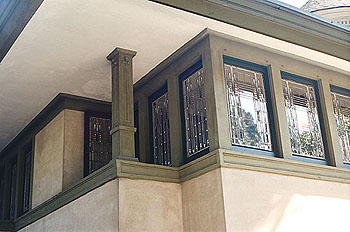
See additional photographs...
FRANK W. THOMAS RESIDENCE: THE SKETCH BOOK (1905) The Sketch Book - September 1905. Author: Morris, Alfred.
Frank Thomas Residence (1901 - S.067) "A Constant Home. Design and ornament in the home is of such vast importance, that when one comes across a worthy example - one that is consistent and sane - it would surely seem indifferent not to praise. The examples of the exterior and interior applications of design, in the photographs herewith, are ones that have not only a most harmonious consistency, but they also exhibit originality; originality not of the clever sort, but that of dignity and consistent beauty. This house in question is in Oak Park, Illinois, and was designed by that skillful architect and draughtsman, Mr. Frank Lloyd Wright... Mr. Frank Lloyd Wright is original with a reason. His sense of proportion in design is always rational and animated with beauty. His architecture is of a distinct type, harmonious and quietly elegant..." Includes five photographs (below). Read the full article...Caption: A Consistent Home. Caption: View Showing Arrangement of Porch From the Rear of the House. Caption: Fire-Place in Corner of the Library. Caption: The Library. Caption: The Dining Room.
FRANK W. THOMAS RESIDENCE: THE HOUSE BEAUTIFUL (1911) The House Beautiful - October 1911. Author: Charles E. White. Frank Thomas Residence (1901 - S.067) "Consider how much more pleasing a small-paned windows is over windows containing large sheets of glass. The idea should be to give windows a pattern or texture which will be pleasing from outside as well as inside (Plate O), making the windows do their part toward improving the architectural effect." Plate O -- Frank Lloyd Wright, Architect. Casement Windows with Pattern of Metal Bar.
FRANK W. THOMAS RESIDENCE 2002.
TEXT: ALFRED MORRIS, 1905Frank Wright Thomas Residence 2002 (1901 - S.067). Designed in 1901 by Frank Lloyd Wright. The Frank Thomas Residence is considered to be Wright's first fully developed prairie styled house in Oak Park. It is also the first house in Oak Park to be completely designed in Stucco. Upon entering the archway, stairs lead up to the Terrace and main living quarters on the second level. The Living Room is to the left, Dining Room on the right. The Kitchen is strait ahead. A back stairway leads to the bedrooms on the third floor. The ground floor was for the house staff. Some of the design features included beaded molding and exquisite leaded glass windows. Photographs from the 1940s show that the stucco surface is covered in shingles. But during the 1975 restoration by Mr. and Mrs. Robert Coleman, the stucco surface was restored. Photographed by Douglas M. Steiner in September, 2002. Set of 13 - 35mm color negatives and 14 x 9" high res color digital image.
The following text is a reprint of the article from The Sketch Book, September 1905, "A Constant Home," Alfred Morris.1) Frank Wright Thomas Residence 2002 (1901 - S.067). Thomas Residence viewed from the street. "The general lines of the building are very similar to may other examples of the work of this architect. The entrance appears to be on a level with the street, but after passing the villa-like walk you are lead by winding stairs up to the 'front door' and underneath the wide roof, that is always a positive feature of Mr. Wright's architecture. The porch, that extends to the extreme left in the photograph, has no connection with the entrance: this insures privacy and comfort." The Sketch Book, September 1905, "A Constant Home," Alfred Morris. Photographed by Douglas M. Steiner in September 2002. 35mm color negatives and 14 x 9" high res color digital image. (ST#2002.116-1) 2) Frank Wright Thomas Residence 2002 (1901 - S.067). View of the covered Porch and Terrace. "On the main floor is a large library and living-room, a dining room and kitchen; upstairs there are three bed-rooms and a bath; to the 'basement' which is on a level with the ground, are consigned the servants' rooms, etc. By this arrangement, also, it will be noted that the uniqueness of design is not out done by the uniqueness of plan." The Sketch Book, September 1905, "A Constant Home," Alfred Morris. Photographed by Douglas M. Steiner in September 2002. 35mm color negatives and 14 x 9" high res color digital image. (ST#2002.116-2) 3) Frank Wright Thomas Residence 2002 (1901 - S.067). Thomas Residence viewed from the street. "As in all of Mr. Wright's homes, the design and ornament is characteristically his. In this special house, though the design is universal, it is not so complex and engrossing that the individuality of the owners is not allowed to assert itself. This is a most important feature in any home -- this individuality." The Sketch Book, September 1905, "A Constant Home," Alfred Morris. Photographed by Douglas M. Steiner in September 2002. 35mm color negatives and 14 x 9" high res color digital image. (ST#2002.116-3) 4) Frank Wright Thomas Residence 2002 (1901 - S.067). Thomas Residence viewed from the street. "The circular band of wood decoration that arches the main entrance and extends around the porch railings and even at the ends of the wide roof, is carried out in detail on all the wood work inside of the house. This decoration consists of a beading indented in a panel, and an angular cornice... The library, hallway and dining-room have this treatment more ornately than any other parts of the interior. With the
immense amount of wood used on the first floor, this design works itself into every 'nook and cranny." The Sketch Book, September 1905, "A Constant Home," Alfred Morris. Photographed by Douglas M. Steiner in September 2002. 35mm color negatives and 14 x 9" high res color digital image. (ST#2002.116-4)5) Frank Wright Thomas Residence 2002 (1901 - S.067). Thomas Residence viewed from the street. "The doors and bric-a-hrac shelves, the panels and foot-boards all fall under this handling. The effect is one of completeness and harmony. The scheme is so beautiful and dignified that it never becomes tire some. The impression given is one of repose, especially with the pleasing brown stain of the wood and golden browns of the walls. Mr. Wright's color schemes are always masterly. He has that exquisite sense of tone value that is always appealing." The Sketch Book, September 1905, "A Constant Home," Alfred Morris. Photographed by Douglas M. Steiner in September 2002. 35mm color negatives and 14 x 9" high res color digital image. (ST#2002.116-5) 6) Frank Wright Thomas Residence 2002 (1901 - S.067). View of Thomas entrance on the second level. "The leaded glass windows that run nearly the full length of the two sides of the library are as excellent in design as the details just mentioned. This design. that coincides so delightfully with the whole modeling of the house, is carried out in all the doors and windows of the first floor." The Sketch Book, September 1905, "A Constant Home," Alfred Morris. Photographed by Douglas M. Steiner in September 2002. 35mm color negatives and 14 x 9" high res color digital image. (ST#2002.116-6) 7) Frank Wright Thomas Residence 2002 (1901 - S.067). View of Thomas entrance on the second level. "With all the minuteness of detail in ornament that Mr. Wright has enveloped in this residence the character of the home. as stated before. is still retained. There is plenty of leaway given the owners to assert their own ideas. Strange to say, one feels that the whole matter was planned. in general. by the occupants. The dignity and restfulness is there. Not the dignity that presages coldness. but one that indicates a strength of poise. And restfulness is imparted on account of unity: the convicting elements are eliminated." The Sketch Book, September 1905, "A Constant Home," Alfred Morris. Photographed by Douglas M. Steiner in September 2002. 35mm color negatives and 14 x 9" high res color digital image. (ST#2002.116-7) 7A) Detail of the top of the entrance stairway newel which runs from the ground floor to the main level on the second floor. Leaded glass windows are in the background. 7B) Detail of the leaded glass windows and the beaded trim. Beaded trim continues throughout the interior and exterior of the house. 7C) Detail of the arched entryway and the beaded trim. 8) Frank Wright Thomas Residence 2002 (1901 - S.067). View of Thomas entrance on the second level. "This house is not one of Mr. Wright's latest constructions. nor is it one that stands for his best work. It was erected some three or four years ago, and in this length of time an artist's methods and ideas may change entirely. We take it. however, that the stamp of a genius' work is always noticeable, what, ever deviation may occur in his handling." The Sketch Book, September 1905, "A Constant Home," Alfred Morris. Photographed by Douglas M. Steiner in September 2002. 35mm color negatives and 14 x 9" high res color digital image. (ST#2002.116-8) 9) Frank Wright Thomas Residence 2002 (1901 - S.067). View of Thomas entrance on the second level. "This home illustrates an ideal. It holds within it a constant interest and beauty. It defies custom and points out individuality. Its refinement is inherent and it discourages the common and vulgar forms. As to the cost of its construction it comes within an appropriation that any ordinarily successful merchant, or professional man could easily meet." The Sketch Book, September 1905, "A Constant Home," Alfred Morris. Photographed by Douglas M. Steiner in September 2002. 35mm color negatives and 14 x 9" high res color digital image. (ST#2002.116-9) 9A) Detail of the Thomas Residence leaded glass windows. 10) Frank Wright Thomas Residence 2002 (1901 - S.067). View of Thomas entrance on the second level. "With the average 'front-foot' of ground allotted to the great percentage of our city homes of to-day, the majority of architects afford too little thought to the arrangement and privacy of that necessary, life-producing adjunct, the 'porch.' I mention this, because the arrangement shown here is an excellent example of what a porch should really be. Most of us labor under the idea that a porch is a place where one can look and be looked upon. A porch, in reality, should serve almost the same purpose as a room and embody all the privacy possible. Otherwise it were better no porch be considered at all; it would appear much more sensible to press the yard into service." The Sketch Book, September 1905, "A Constant Home," Alfred Morris. Photographed by Douglas M. Steiner in September 2002. 35mm color negatives and 14 x 9" high res color digital image. (ST#2002.116-10) 11) Frank Wright Thomas Residence 2002 (1901 - S.067). View of Thomas entrance on the second level. "Originality, by its very fearlessness, is engaging. Where originality vibrates with reason it is fascinating. Mr. Frank Lloyd Wright is original with a reason. His sense of proportion in design is always rational and animated with beauty. His architecture is of a distinct type, harmonious and quietly elegant." The Sketch Book, September 1905, "A Constant Home," Alfred Morris. Photographed by Douglas M. Steiner in September 2002. 35mm color negatives and 14 x 9" high res color digital image. (ST#2002.116-11) 11A) Detail of the leaded glass windows and the beaded trim. Beaded trim continues throughout the interior and exterior of the house. 12) Frank Wright Thomas Residence 2002 (1901 - S.067). View of Thomas entrance on the second level. "In our home life it is well not to strain too much for effect. Simplicity is always charming. Our surroundings in a way, mirror our natures and aims. Complex and mixed arrangements designate a scattered thought-power and a discontent emanating from a lack of purpose. Money can mar or make." The Sketch Book, September 1905, "A Constant Home," Alfred Morris. Photographed by Douglas M. Steiner in September 2002. 35mm color negatives and 14 x 9" high res color digital image. (ST#2002.116-12) 13) Frank Wright Thomas Residence 2002 (1901 - S.067). View of Thomas entrance on the second level. "There are hundreds of examples of costly homes that stand for absolutely nothing artistically, and numerous ones that moderate expenditures construct that stand for positive beauty. This argues for neither class of home particularly, but for art solely. Character and art are the things we want in our home life: the existence of these, or the lack of them define our attitudes." The Sketch Book, September 1905, "A Constant Home," Alfred Morris. Photographed by Douglas M. Steiner in September 2002. 35mm color negatives and 14 x 9" high res color digital image. (ST#2002.116-13)
WILLIAM H. WINSLOW RESIDENCE & STABLE (1894 - S.024 & S.025)
The William H. Winslow Residence (1894 - S.024) was Frank Lloyd Wright's first independent commission after leaving Sullivan's office. Winslow was raised in Brooklyn, New York, and in 1883 at 26 became partner of the Hecla Iron Works. In 1885,when an opportunity arose, he moved to Chicago and with E. T. Harris, formed Harris and Winslow, manufacturing ornamental iron. Harris retired and with his brother Francis formed Winslow Bros. Ornamental Ironworks which he became president of, eventually opening offices in eight other major cities across the country.
Wright first met Winslow while working in Sullivan's office. "W.H. Winslow... had often been to Adler and Sullivan's to consult with me about the work of that office. W. H. now turned up to give me my first job... He had become my friend..."Winslow acquired the property on Auvergne Place from Edward C. Waller, who lived across the street and later became one of Wright's important clients (S.030, 031, 047, 065, 066, 166). Waller's son commissioned Wright to design Midway Gardens (1913 - S.180). Also in 1894 Wright designed four rowhouses for Robert W. Roloson (1894 - S.026), Waller's son-in-law.
In 1895 Wright design an office building for the American Luxfer Prism Company, one of the companies Winslow and Waller formed with three other partners. Winslow invented a process of joining glass pieces together. The project was never built, but in 1897 Wright, Robert C. Spencer, Waller and Winslow created designs related to Prism glass blocks. Wright (41), Winslow (11), Waller (2) filed patents. Continued...Date: 1903
Title: The Brickbuilder - September 1903 (Published monthly by Rogers & Manson Boston)
Author: Spencer, Robert C. Jr.
Description: "Brick Architecture in and about Chicago." An article that includes the work of Frank Lloyd Wright. It includes extensive descriptions, and images of the The Winslow Stable (1894 - S.025); Francis Apartments (1895 - S.032); Heller (2) (1896 - S.038); Husser (1899 - S.046); Charnley (1891 - S.009); Francisco Terrace (1895 - S.030); Winslow (1894 - S.024); Moore I (1895 - S.034). Very helpful in dating photographs of Wright's early. Excerpts:
Frank Lloyd Wright's houses are all original and interesting. The house at River Forest (Winslow) is the architect's work best known and, on the whole, the most successful. The richly ornamented frieze and simple, widespreading roof are in perfect harmony with the site, the chief feature of which is a grand twin elm. In coloring, the house is very rich, the bricks are Roman of an almost orange tan in the mass, and are full of variety in shading and texture. The roof is of shingle tile especially burned to a rare, dull salmon pink.
The little stable and workshop (Winslow) is classic in composition and terminates the vista through the porte-cochere.(Digital edition.) (Sweeney 54)
Size: 10 x 13
Pages: Pp 178-187
S#: 0054.00.0119
The Winslow Stable.
Winslow Residence.Date: 1894 Title: William H. Winslow House, River Forest, IL, Reception Hall 1894 (1894 - S.024).
Description: Designed in 1894, this was Frank Lloyd Wright's first major commission after leaving Sullivan's office. Photographed in 1894, printed in 1959. Chicago Architectural Photographing Company, Chicago. This is the actual print that was used for producing the image on page 117 in the June 1959 "Architectural Record". Original gelatin silver photograph printed from the original negative. Printed in 1959 by Henry Fuermann and Sons. The original image was published in June 1900 "The Architectural Review" page 62. Also published in "In The Nature of Materials" 1942 Henry-Russell Hitchcock plate 27; "Frank Lloyd Wright to 1910" 1958 Grant Carpenter Manson page 66; "Frank Lloyd Wright: A study in Architectural Content" 1966 Norris Kelly Smith page 70; "Frank Lloyd Wright and Le Corbusier" 1994 Richard A. Etlin page 42; "Frank Lloyd Wright: Architect" 1994 Terence Riley page 115; "Frank Lloyd Wright and The Meaning of Materials", 1994 Patterson page 34; "The Decorative Designs of Frank Lloyd Wright, 1979, Hanks, pp 12. Original silver gelatin 8 x 10 B&W photograph, Clarence Fuermann
Size: 8 x 10 B&W photograph
S#: 1275.07.0706
Date: 1894
Title: William H. Winslow House, River Forest, IL, Reception Hall 1894 (1894 - S.024).
Description: Designed in 1894, this was Frank Lloyd Wright's first major commission after leaving Sullivan's office. A friend of Winslow's, Wright worked with Winslow and another client Chauncey Williams producing The Eve of St, Agnes in 1896. Wright and Winslow produced The House Beautiful in 1898. Published in June 1900 "The Architectural Review" page 62. Also published in "In The Nature of Materials" 1942 Henry-Russell Hitchcock plate 27; "Frank Lloyd Wright to 1910" 1958 Grant Carpenter Manson page 66; "Frank Lloyd Wright: A study in Architectural Content" 1966 Norris Kelly Smith page 70; "Frank Lloyd Wright and Le Corbusier" 1994 Richard A. Etlin page 42; "Frank Lloyd Wright: Architect" 1994 Terence Riley page 115; "Frank Lloyd Wright and The Meaning of Materials", 1994 Patterson page 34; "The Decorative Designs of Frank Lloyd Wright", 1979, Hanks, pp 12. Mounted to gray board. Label pasted to board: "W 20 US Arch. Wright, Frank L:loyd. River Forest, Illinois. Winslow House, 1893. Interior. Photo: Chicago Architectural Photo Co." Photographed by Clarence Fuermann, Chicago Architectural Photographing Company, Chicago. Acquired from the archives of the University of Minnesota.
Size: Original 9.5 x 7.75 B&W photograph.
S#: 0016.04.0420Date: Circa 1935-1945
Title: 1) William H. Winslow House, River Forest, IL, Circa 1935-1945 (1894 - S.024 & .025).
Description: Set of three photographs of the Winslow House, held in the collection of the Oak Park Public Library. View of the West elevation from the street. Designed by Frank Lloyd Wright in 1894. These photographs were produced in the late 1970s. Hand written on verso: "Winslow 1 A." Photographed by Gilman Lane.
Size: Original 5 x 3.5 B&W photograph.
S#: 0397.71.0920 -1Date: Circa 1935-1945
Title: 2) William H. Winslow House, River Forest, IL, Circa 1935-1945 (1894 - S.024 & .025).
Description: Set of three photographs of the Winslow House, held in the collection of the Oak Park Public Library. View of the Winslow Residence from the Northwest. Designed by Frank Lloyd Wright in 1894. These photographs were produced in the late 1970s. Hand written on verso: "Winslow 1 B." Photographed by Gilman Lane.
Size: Original 5 x 3.5 B&W photograph.
S#: 0397.71.0920 -2Date: Circa 1935-1945
Title: 3) William H. Winslow House, River Forest, IL, Circa 1935-1945 (1894 - S.024 & .025).
Description: Set of three photographs of the Winslow House, held in the collection of the Oak Park Public Library. View of the back of the Winslow Residence from the East. Designed by Frank Lloyd Wright in 1894. These photographs were produced in the late 1970s. Hand written on verso: "Winslow 1 C." Published in In The Nature of Materials, Hitchcock, 1942, Plate 28. Photographed by Gilman Lane.
Size: Original 5 x 3.5 B&W photograph.
S#: 0397.71.0920 -3Date: 1974
Title: 1) William H. Winslow Residence, River Forest, IL, 1974 (1894 - S.024 & .025).
Description: Set of 7 original 35mm color slides of the exterior of the Winslow Residence. Designed in 1894, this was Frank Lloyd Wright's first major commission after leaving Sullivan's office. A friend of Winslow's, Wright worked with Winslow and another client Chauncey Williams producing The Eve of St, Agnes in 1896. Wright and Winslow produced The House Beautiful in 1898. Wright first met Winslow while working in Sullivan's office. "W.H. Winslow... had often been to Adler and Sullivan's to consult with me about the work of that office. W. H. now turned up to give me my first job... He had become my friend..." An Autobiography, Wright, 1932, pages 123. Hand written on sleeves: "Winslow House, Wright." Stamped on sleeves, numbers: "6 - 12." Stamped on sleeve: "Mar 74." Printed on slide verso: Agfachrome. Processed By Agfa-Gevaert." Photographer unknown.
Size: Seven original 35mm Color slides.
S#: 1963.46.0623-1
2) William H. Winslow Residence, River Forest, IL, 1974 (1894 - S.024 & .025).
(S#1963.46.0623-2)
3) William H. Winslow Residence, River Forest, IL, 1974 (1894 - S.024 & .025).
(S#1963.46.0623-3)
4) William H. Winslow Residence, River Forest, IL, 1974 (1894 - S.024 & .025).
(S#1963.46.0623-4)
5) William H. Winslow Residence, River Forest, IL, 1974 (1894 - S.024 & .025).
(S#1963.46.0623-5)
6) William H. Winslow Residence, River Forest, IL, 1974 (1894 - S.024 & .025).
(S#1963.46.0623-6)
7) William H. Winslow Residence, River Forest, IL, 1974 (1894 - S.024 & .025).
(S#1963.46.0623-7)Date: 1977 Title: William H. Winslow House (1894 - S.024) Exterior front door 1977.
Description: Stamped on verso: "Chicago Daily News, May 12, 77. Ray Burley". Caption pasted on verso: "An oak tree is carved into this massive front door of the Winslow home. (Daily News Photo / Ray Burley)." Acquired from the archives of the Chicago Daily News.
Size: Original 8 x 10 B&W photograph.
S#: 2033.08.0612
Date: 1977
Title: William H. Winslow House, River Forest, Illinois 1977 (1894 - S.024).
Description: View of the Dining Room fireplace and hand-painted mural. The Winslow Residence was Frank Lloyd Wright's first independent commission after leaving Sullivan's office. The "Mantel" is actually seen just beneath the mural. Caption pasted to verso: "Horseless carriages now pass under the arch of the porte cochere to the garage that once was a stable (left). Inside, this inglenook in the reception hall (below left) is a mark of Frank Lloyd Wright. Hand-painted murals the estate crest in the hall, the Auvergne Mountains above the fireplace in the dining room (below) are used throughout the first floor." Stamped on verso: "Chicago Daily News, May 12, 77. Ray Burley". Photographed by Ray Burley. Acquired from the archives of the Chicago Daily News.
Size: Original 8 x 10 B&W photograph.
S#: 2033.28.0619Date: Circa 1978
Title: William H. Winslow House, River Forest, Illinois Circa 1978 (Not Dated) (1894 - S.024).
Description: View of the rear of the house. Designed by Frank Lloyd Wright in 1894. Sitting in the drive is a 1976 Chevrolet Vega hatchback. Text on sleeve: “A-20-Wr-41-25, Winslow House. Ext: Rear view.” Acquired from the archives of the University of Virginia.
Size: Original 35mm Color slide, sandwiched between glass, plastic mount.
ST#: 1978.70.1223Date: 1981 Title: William H. Winslow House (1894 - S.024) Exterior view from the Northwest 1981.
Description: Stamped on verso: "1981 Wright Home & Studio Foundation". Caption pasted on verso: "The William H. Winslow House in River Forest, designed by Wright in 1893, will be featured on the River Forest Walk on May 17 and 27 and on June 10 and 24." Acquired from the archives of the Chicago Daily News.
Size: Original 8 x 5.25. B&W photograph.
ST#: 1981.26.0612
Date: 1981 Title: William H. Winslow Armchair, River Forest, Illinois (1894 - S.024) 1981.
Description: Frank Lloyd Wright designed armchair for the William Winslow Residence, circa 1894. Kelmscott Gallery note accompanying image: "Frank Lloyd Wright armchair for the Winslow House, River Forest, Ill., 1893. (Oak). (Probably Frank Lloyd Wright's First design for furniture, possibly inspired by Henry Hobson Richardson's chair for the Glessner House, Chicago, Ill.)" Oak, upholstered back and seat, 27.25 (H) x 23.5 (W) x 26.25 (D). Acquired from Kelmscott Galleries. Wright Chairs.
Size: Four 4 x 5 Color photographs.
ST#: 1981.118.0413
Date: 1981 Title: William H. Winslow Armchair, River Forest, Illinois (1894 - S.024) 1981.
Description: Frank Lloyd Wright designed armchair for the William Winslow Residence, circa 1894. Probably Frank Lloyd Wright's first design for furniture, possibly inspired by Henry Hobson Richardson's chair for the Glessner House, Chicago, Ill. Oak, upholstered back and seat, 27.25 (H) x 23.5 (W) x 26.25 (D). Photographed by Photoworks, Leesburg, Virginia. Acquired from Kelmscott Galleries. Wright Chairs.
Size: One 5 x 7 B&W photograph.
ST#: 1981.119.0413
Date: 1983
Title: 1) William H. Winslow Residence, River Forest, Illinois, 1983 (1894 - S.024).
Description: View of the Winslow Residence from the street. Part of a set of 20 slides of Frank Lloyd Wright houses in the Chicago area dated 1983-1985. Frank Lloyd Wright designed the Winslow Residence in 1894. Stamped on the sleeve: “15. Jul 1983." Hand written on face: “Wm Winslow 1893.” Printed on sleeve verso: “Kodachrome Slide.”
Size: Original 35mm Color slide.
ST#: 1983.71.0225-1Date: 1983
Title: 2) William H. Winslow Residence, River Forest, Illinois, 1983 (1894 - S.024).
Description: Detail view of the Winslow Residence entrance. Not dated, but in a set of 20 slides of Frank Lloyd Wright houses in the Chicago area dated 1983-1985. Frank Lloyd Wright designed the Winslow Residence in 1894. Stamped on the sleeve: “11." Hand written on face: “Winslow.” Printed on sleeve verso: “Ektachrome Transparency.”
Size: Original 35mm Color slide.
ST#: 1983.71.0225-2Date: 1983
Title: 3) William H. Winslow Residence, River Forest, Illinois, 1983 (1894 - S.024).
Description: Detail view of the Winslow Residence Porte Cochere. Not dated, but in a set of 20 slides of Frank Lloyd Wright houses in the Chicago area dated 1983-1985. Frank Lloyd Wright designed the Winslow Residence in 1894. Stamped on the sleeve: “12." Hand written on face: “Winslow.” Printed on sleeve verso: “Ektachrome Transparency.”
Size: Original 35mm Color slide.
ST#: 1983.71.0225-3
HARRISON P. YOUNG RESIDENCE (1895 - S.036) Date: 1935 Title: Harrison P. Young Residence Additions and Remodel, Oak park (1895 - S.036) circa 1935.
Description: View from the street, left and front sides. Frank Lloyd Wright remodeled the home in 1895. It was originally built is the 1870s and designed by William E. Coman. Wright's modifications which were pretty extensive in 1895, included moving the house 16.5 feet further back into the lot, a new Living Room, two second floor Bedrooms, the addition of a wide porch, and reconfiguring the house's interior spaces. This would indicate the front of the house was an addition, and Wright's design. Details such as semi-circular window on top, the diamond shaped panes of leaded glass, decorative bracing above the three upper windows and the roof overhang, the upper corner plaster panels, and the cantilevered porch roof. Wright also designed the fireplaces in the living room and master bedroom. The original front stairs that Wright designed were reached at the end of the sidewalk where they paralleled the front porch. A left turn to the top of the stairs, then a right turn brought you up to the porch. The stairs were hidden behind the porch wall. The porch roof cantilevers over the drive on the North (left) end. There is a similarity to the design of the A.W. Herbert Residence remodeling, Evanston, IL (1902 - S.089). Photographed by Gilman Lane.
Size: 8 x 10 B&W photograph.
S#: 0397.36.0116
Date: 1935 Title: Harrison P. Young Residence Additions and Remodel, Oak park (1895 - S.036) circa 1935.
Description: View from the street, front and right sides. Frank Lloyd Wright remodeled the home in 1895. It was originally built is the 1870s and designed by William E. Coman. Wright's modifications which were pretty extensive in 1895, included moving the house 16.5 feet further back into the lot, a new Living Room, two second floor Bedrooms, the addition of a wide porch, and reconfiguring the house's interior spaces. This would indicate the front of the house was an addition, and Wright's design. Details such as semi-circular window on top, the diamond shaped panes of leaded glass, decorative bracing above the three upper windows and the roof overhang, the upper corner plaster panels, and the cantilevered porch roof. Wright also designed the fireplaces in the living room and master bedroom. The original front stairs that Wright designed were reached at the end of the sidewalk where they paralleled the front porch. A left turn to the top of the stairs, then a right turn brought you up to the porch. The stairs were hidden behind the porch wall. The porch roof cantilevers over the drive on the North (left) end. There is a similarity to the design of the A.W. Herbert Residence remodeling, Evanston, IL (1902 - S.089).
Size: Photographed by Gilman Lane. 8 x 10 B&W photograph.
S#: 0397.37.0116
Date: Circa 1940
Title: Harrison P. Young Residence Additions and Remodel, Oak Park (1895 - S.036) Circa 1940-1950.
Description: View of the hall outside the Reception Room, viewed from the Living Room. The Oak Park Public Library attributes this photograph to Grant Manson. Manson took photographs of Wright buildings between 1937 and 1941 while researching for his doctoral dissertation titled "Frank Lloyd Wright's Work Before 1910". Photographed by Grant Manson. Courtesy of the Oak Park Public Library.
Size: 5 x 8 B&W photograph.
S#: 0531.59.0916Date: Circa 1940
Title: Harrison P. Young Residence Additions and Remodel, Oak Park (1895 - S.036) Circa 1940-1950.
Description: View of the hall and the Reception Room, viewed from the Living Room. The Oak Park Public Library attributes this photograph to Grant Manson. Manson took photographs of Wright buildings between 1937 and 1941 while researching for his doctoral dissertation titled "Frank Lloyd Wright's Work Before 1910". Photographed by Grant Manson. Courtesy of the Oak Park Public Library.
Size: 5 x 8 B&W photograph.
S#: 0531.60.0916Date: Circa 1940
Title: Harrison P. Young Residence Additions and Remodel, Oak Park (1895 - S.036) Circa 1940-1950.
Description: View of the Living Room Fireplace. The Oak Park Public Library attributes this photograph to Grant Manson. Manson took photographs of Wright buildings between 1937 and 1941 while researching for his doctoral dissertation titled "Frank Lloyd Wright's Work Before 1910". Photographed by Grant Manson. Courtesy of the Oak Park Public Library.
Size: 5 x 8 x 5 B&W photograph.
S#: 0531.61.0916Date: 1959 Title: Harrison P. Young Residence Additions and Remodel, Oak park (1895 - S.036) 1959.
Description: 1) Stamped on verso: "Sep 2, 1959". Clipping on verso: "This living room fireplace is original with the house. Built in 1894 and the famed architect designed the motto, the cushioned seat railing and even the andirons. (Stamped) Sep 11, 1959." Acquired from the archives of the Chicago Sun Times.
2) Frank Lloyd Wright remodeled the home in 1895. It was originally built is the 1870s and designed by William E. Coman. Wright's modifications which were pretty extensive in 1895, included moving the house back 16.5 feet further back into the lot, a new Living Room, two second floor Bedrooms, the addition of a wide porch, and reconfiguring the house's interior spaces. This would indicate the the front of the house was an addition, and Wright's design. Details such as semi-circular window on top, the diamond shaped panes of leaded glass, decorative bracing above the three upper windows and the roof overhang, the upper corner plaster panels, and the cantilevered porch roof. Wright also designed the fireplaces in the living room and master bedroom. The original front stairs that Wright designed were reached at the end of the sidewalk where they paralleled the front porch. A left turn to the top of the stairs, then a right turn brought you up to the porch. The stairs were hidden behind the porch wall. The porch roof cantilevers over the drive on the North end. There is a similarity to the design of the A.W. Herbert Residence remodeling, Evanston, IL (1902 - S.089). Sheet accompanying negative: "25 Aug '59. Gekler. Home Interior, Oak Park. Exterior and interior of early Frank Lloyd Wright home at 334 N. Kenilworth Ave, Oak Park. Home is occupied by the Hubert Kampp family." Photographed by Charles Gekler.Size: 1) Original 10 x 8 B&W Print. 2) One 4x5 B&W negatives and one 36 x 45" B&W digital photograph. Acquired from the archives of the Chicago Sun Times.
S#: 1) 1377.38.0310 2) 1377.78.0915
Date: 1959
Title: Harrison P. Young Residence Additions and Remodel, Oak park (1895 - S.036) 1959.
Description: View of the Reception Room Hallway from the Reception Room. Columns have been painted. The oak five paneled door to the left of the stairs has been replaced with a flush door, and has been decorated with circular designs. The stairs have been covered with carpet. The floor has been covered with vinyl squares. The Living Room is to the left, the hall leading to the Dining room and Kitchen is to the right. Sheet accompanying negative: "25 Aug '59. Gekler. Home Interior, Oak Park. Exterior and interior of early Frank Lloyd Wright home at 334 N. Kenilworth Ave, Oak Park. Home is occupied by the Hubert Kampp family." Photographed by Charles Gekler. Acquired from the archives of the Chicago Sun Times.
Size: One 4x5 B&W negatives and one 36 x 45" B&W digital photograph.
S#: 1377.79.0915Date: 1959
Title: Harrison P. Young Residence Additions and Remodel, Oak park (1895 - S.036) 1959.
Description: View of the Den (left), Dining room (center) and Reception Room on the right. Columns have been painted. The floor has been covered with vinyl squares. Cabinets cover the wall of the Reception Room. Sheet accompanying negative: "25 Aug '59. Gekler. Home Interior, Oak Park. Exterior and interior of early Frank Lloyd Wright home at 334 N. Kenilworth Ave, Oak Park. Home is occupied by the Hubert Kampp family." Photographed by Charles Gekler. Acquired from the archives of the Chicago Sun Times.
Size: One 4x5 B&W negatives and one 36 x 45" B&W digital photograph.
S#: 1377.80.0915Date: Circa 1980
Title: Harrison P. Young Residence Additions and Remodel, Oak park (1895 - S.036) Circa 1980.
Description: View of the Reception Room from the hallway. Wood floors have been restored, as have the columns. Vertical spindled screens have been added to either side. Without the luxury of original plans FLW produced in 1895, we can only speculate that the vertical spindled screens have either been restored, or reproduced in a style consistent with Wright's designs in 1895. The cabinetry in the Reception Room has also been removed. Photographed by William Storrer. Not dated. Courtesy of the Oak Park Public Library.
Size: 8 x 5.5 B&W photograph.
ST#: 1980.36.1016Date: 1974
Title: Harrison P. Young Residence Additions and Remodel, Oak park 1974 (1895 - S.036).
Description: Viewed from the West. A group of Wright enthusiasts gather in front of the Young Residence. Frank Lloyd Wright's extensive remodeled of the home in 1895 included moving the house further back into the lot, a new Living Room, two second floor Bedrooms, the addition of a wide porch, and reconfiguring the house's interior spaces. The dramatic slope of the roof line is similar in slope of the Moore Residence, also 1895. Stamped on verso: "74 May 15." Hand written on verso: "(Frank Lloyd Wright - Oak Park, Ill."
Size: Original 9 x 7 B&W photograph.
S#: 1963.36.0719Date: 2002
Title: Harrison P. Young Residence Additions and Remodel, Oak park September, 2002 (1895 - S.036).
Description: View from the street. Frank Lloyd Wright's extensive remodeled of the home in 1895 included moving the house further back into the lot, a new Living Room, two second floor Bedrooms, the addition of a wide porch, and reconfiguring the house's interior spaces. The dramatic slope of the roof line is similar in slope of the Moore Residence, also 1895. The original front stairs that Wright designed have been restored and are reached at the end of the sidewalk where they paralleled the front porch. A left turn to the top of the stairs, then a right turn brought you up to the porch. The stairs were hidden behind the porch wall. The porch roof cantilevers over the drive on the North (left) end. Photographed by Douglas M. Steiner in September 2002.
Size: 35mm slide and 14" x 9" high res digital image.
ST#: 2002.114.1016Date: 2018
Title: Harrison P. Young Residence Additions and Remodel, Oak park, 2018 (1895 - S.036).
Description: Set of 100 exterior photographs of the Young Residence. Frank Lloyd Wright remodeled the home in 1895. It was originally built is the 1870s and designed by William E. Coman. Wright's modifications which were pretty extensive in 1895, included moving the house 16.5 feet further back into the lot, a new Living Room, two second floor bedrooms, the addition of a wide porch, and reconfiguring the house's interior spaces. This would indicate the front of the house was an addition, and Wright's design, such as semi-circular window on top, the diamond shaped panes of leaded glass, decorative bracing above the three upper windows and the roof overhang, the upper corner plaster panels, and the cantilevered porch roof. Wright also designed the fireplaces in the living room and master bedroom. The original front stairs that Wright designed were reached at the end of the sidewalk where they paralleled the front porch. A left turn to the top of the stairs, then a right turn brought you up to the porch. The stairs were hidden behind the porch wall. The porch roof cantilevers over the drive on the North (left) end. Set of 100 exterior photographs of the Young Residence photographed by Douglas M. Steiner on October 8, 2018. (More photographs to come.)
Size: Original 23 X 15 high res digital images.
ST#: 2018.49.0523
HOME ARTIFACTS AUDIO BOOKS PERIODICALS PHOTOS POSTCARDS POSTERS STAMPS STUDIES ASSISTING ABOUT SLIDE SHOW To donate or pass on information, comments or questions:
steinerag@msn.com
©Copyright Douglas M. Steiner, 2001, 2026
